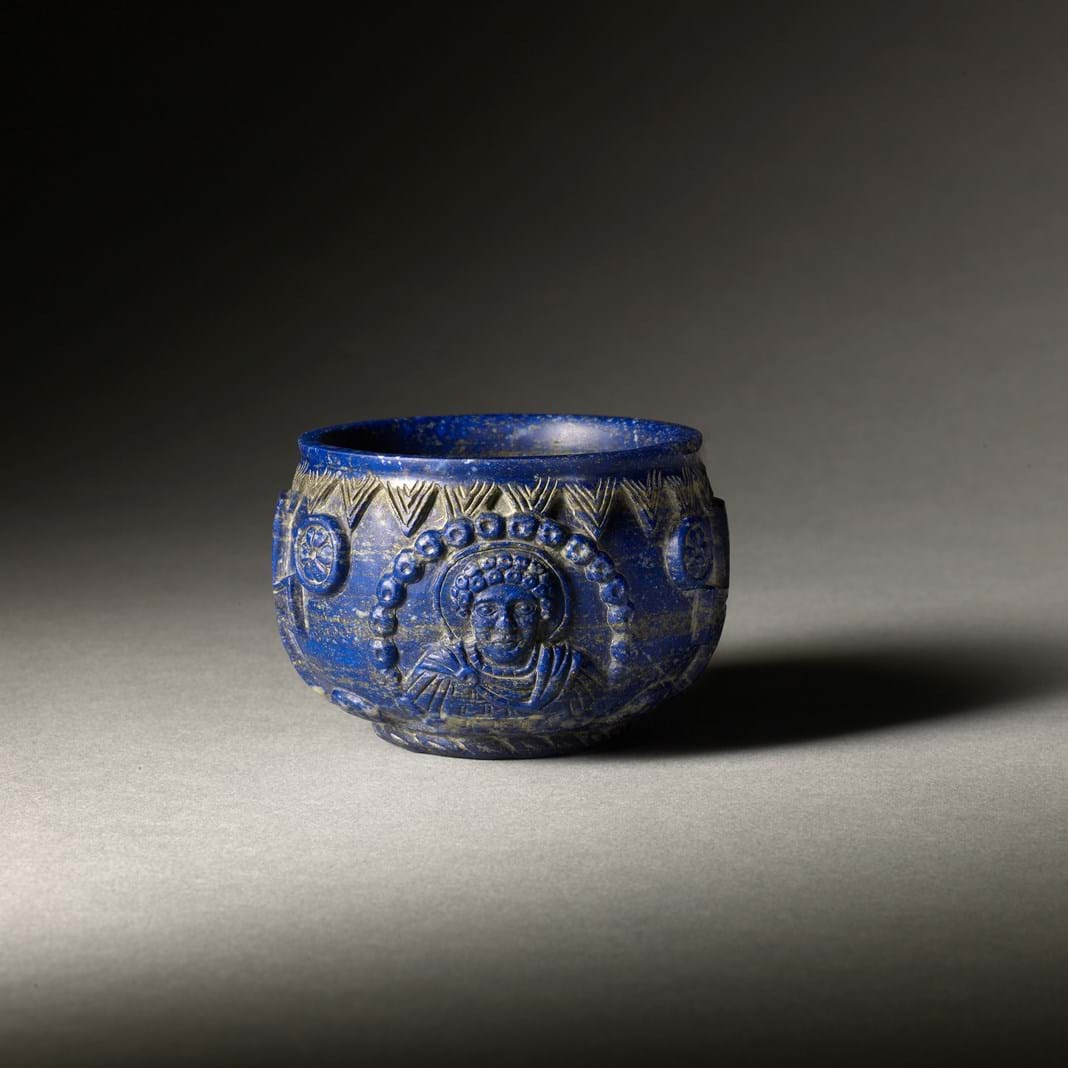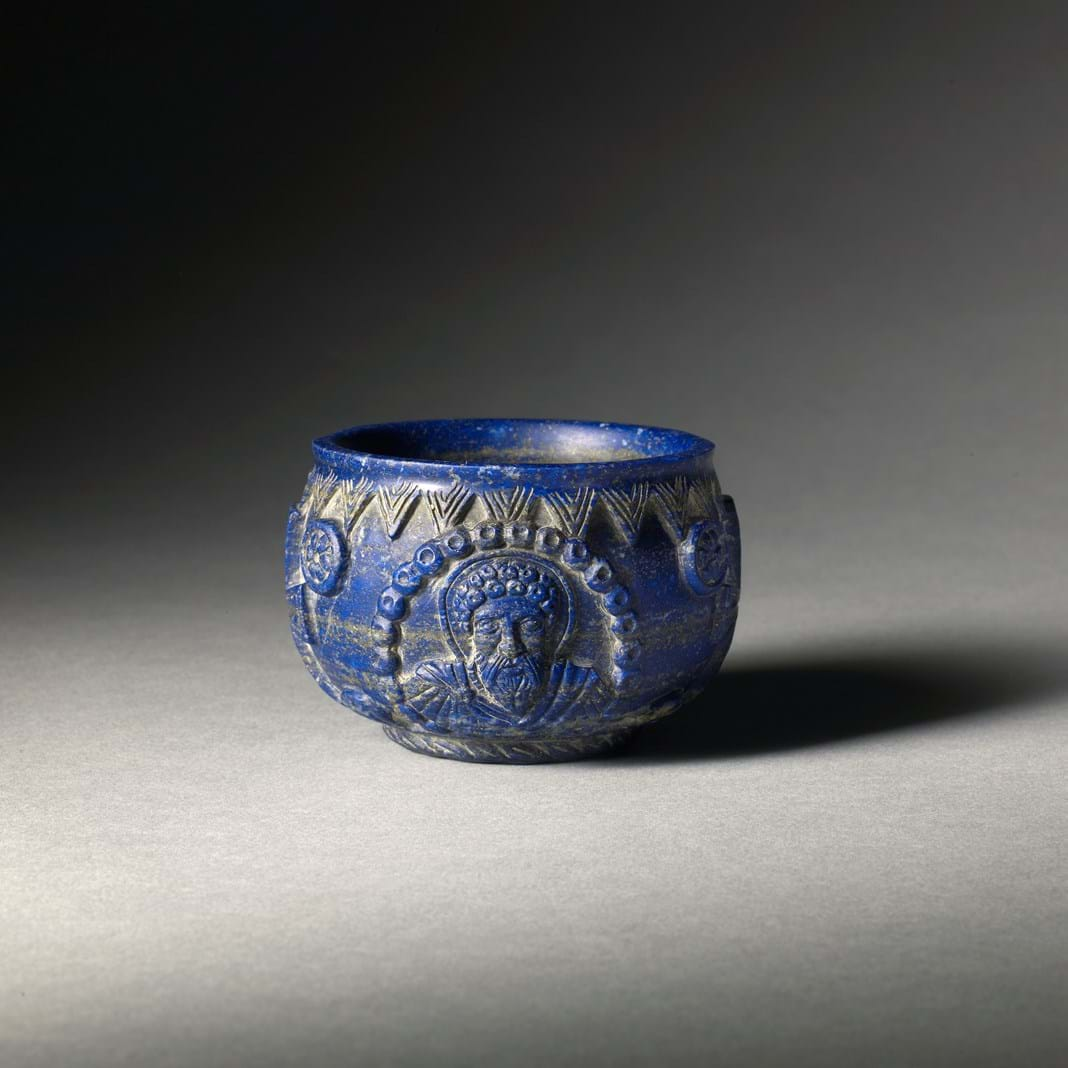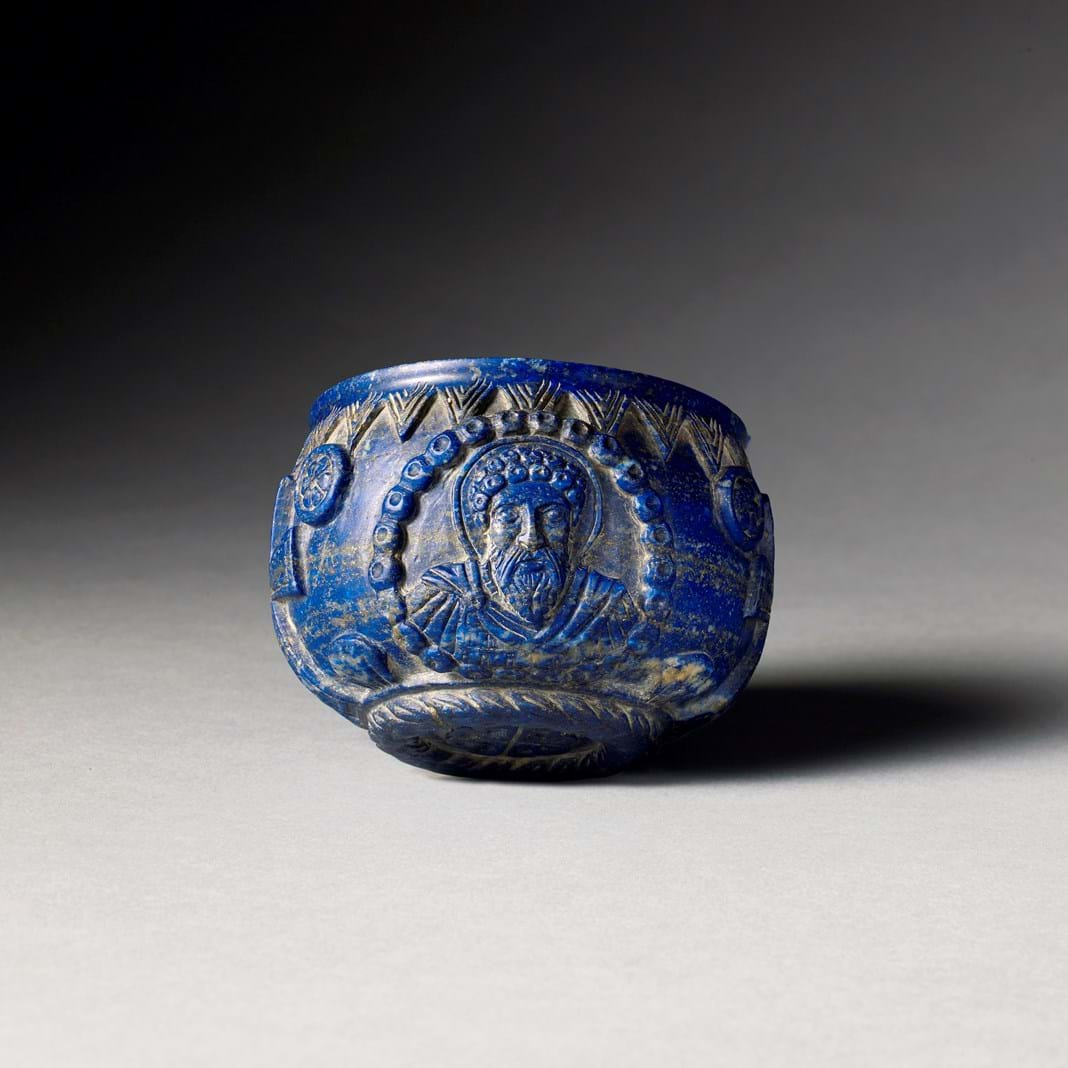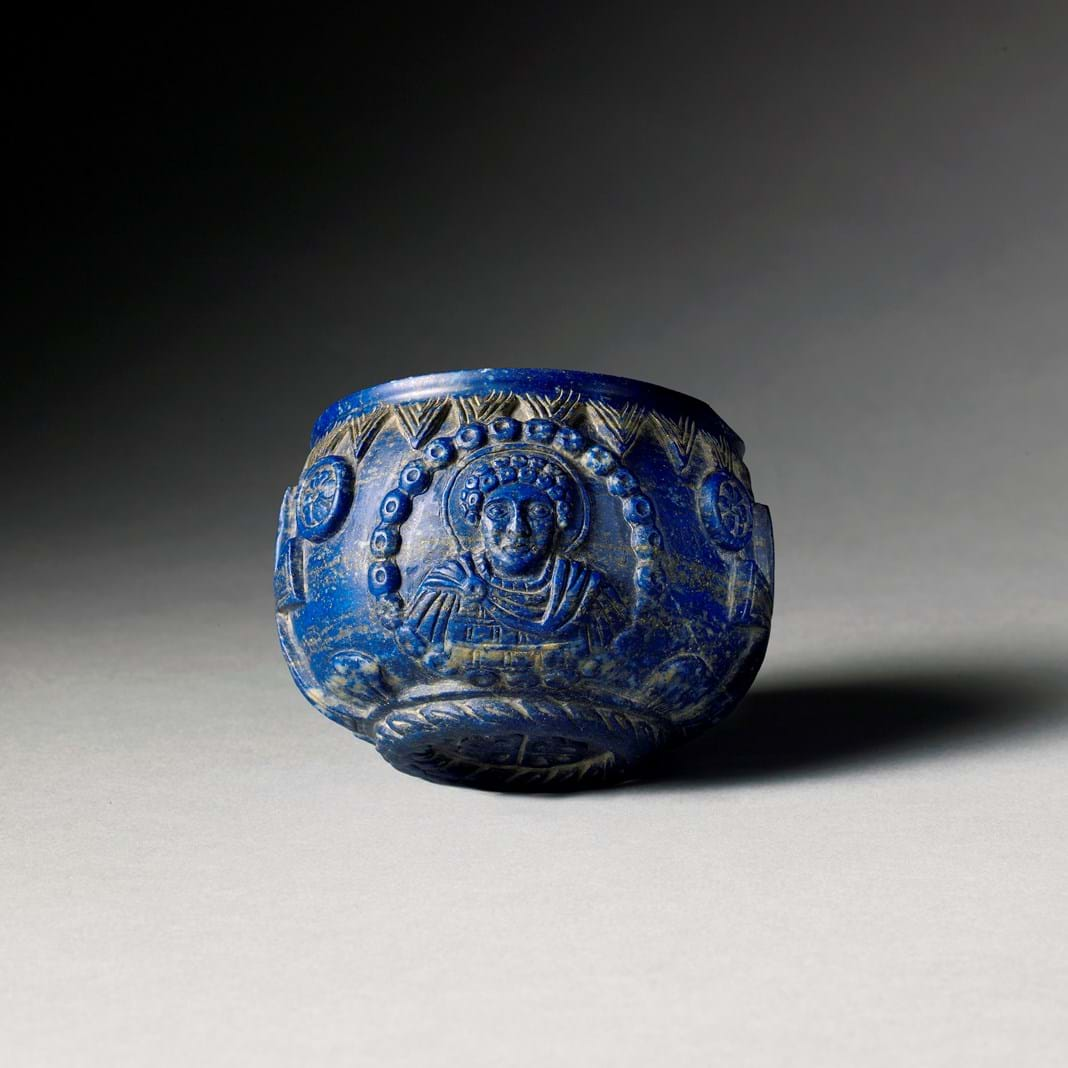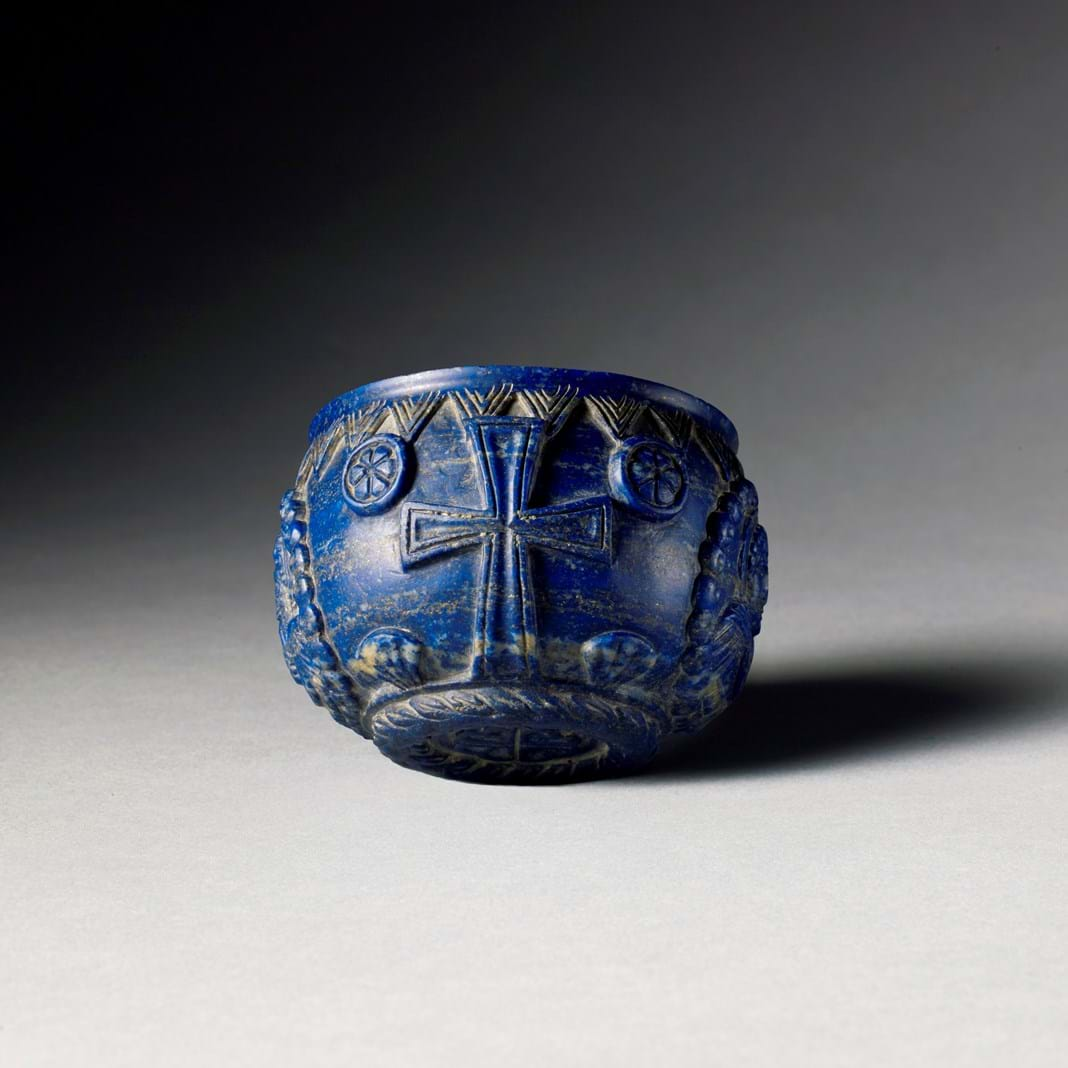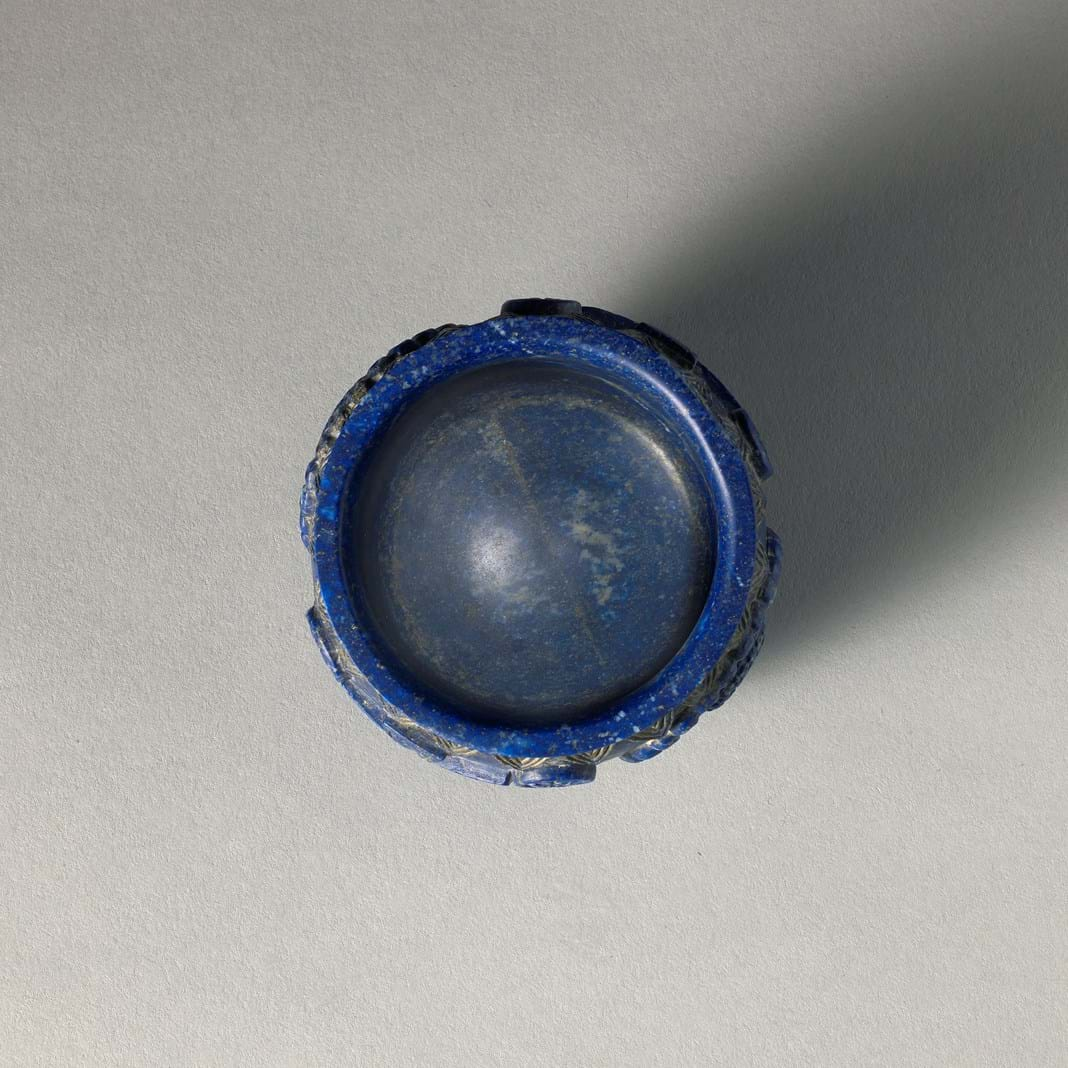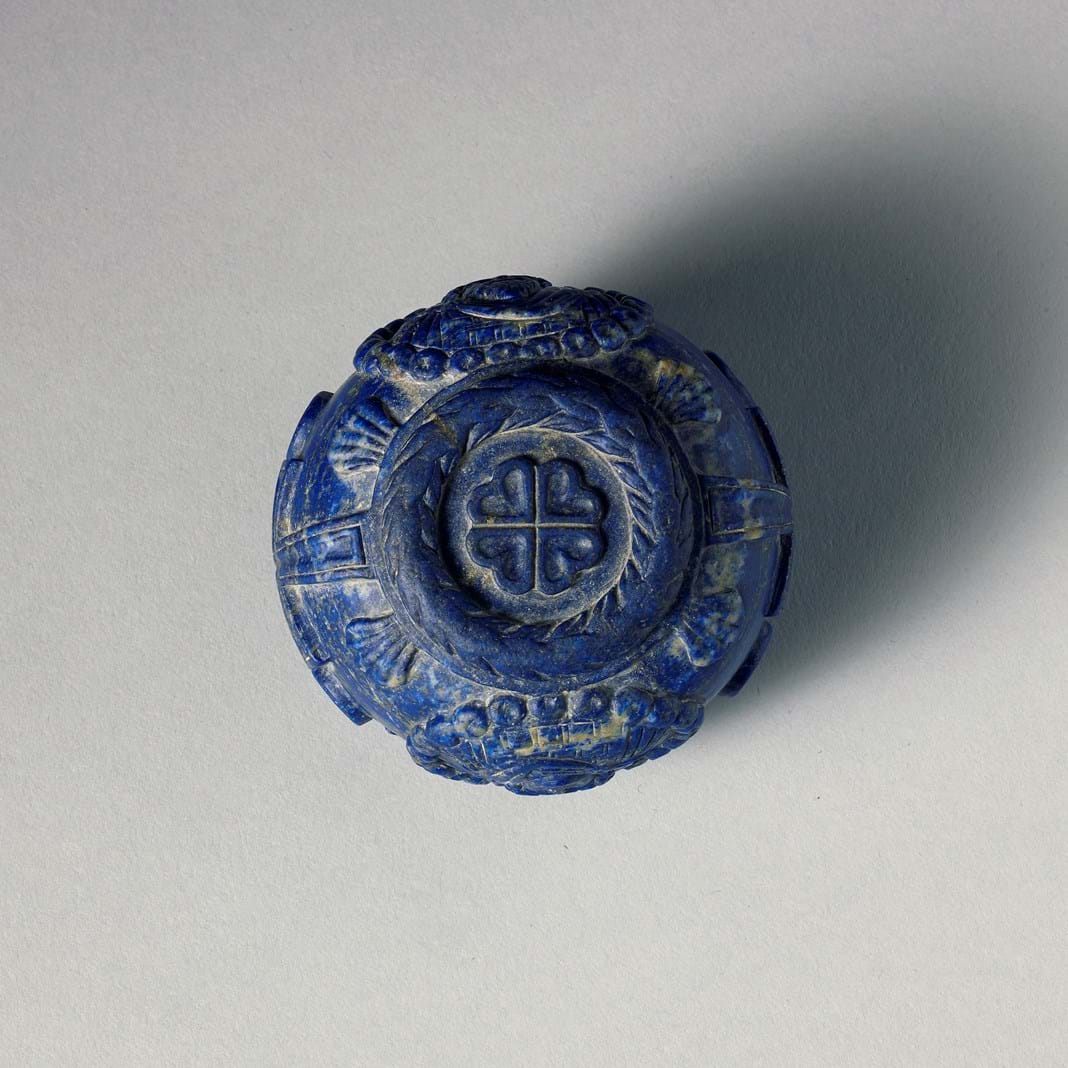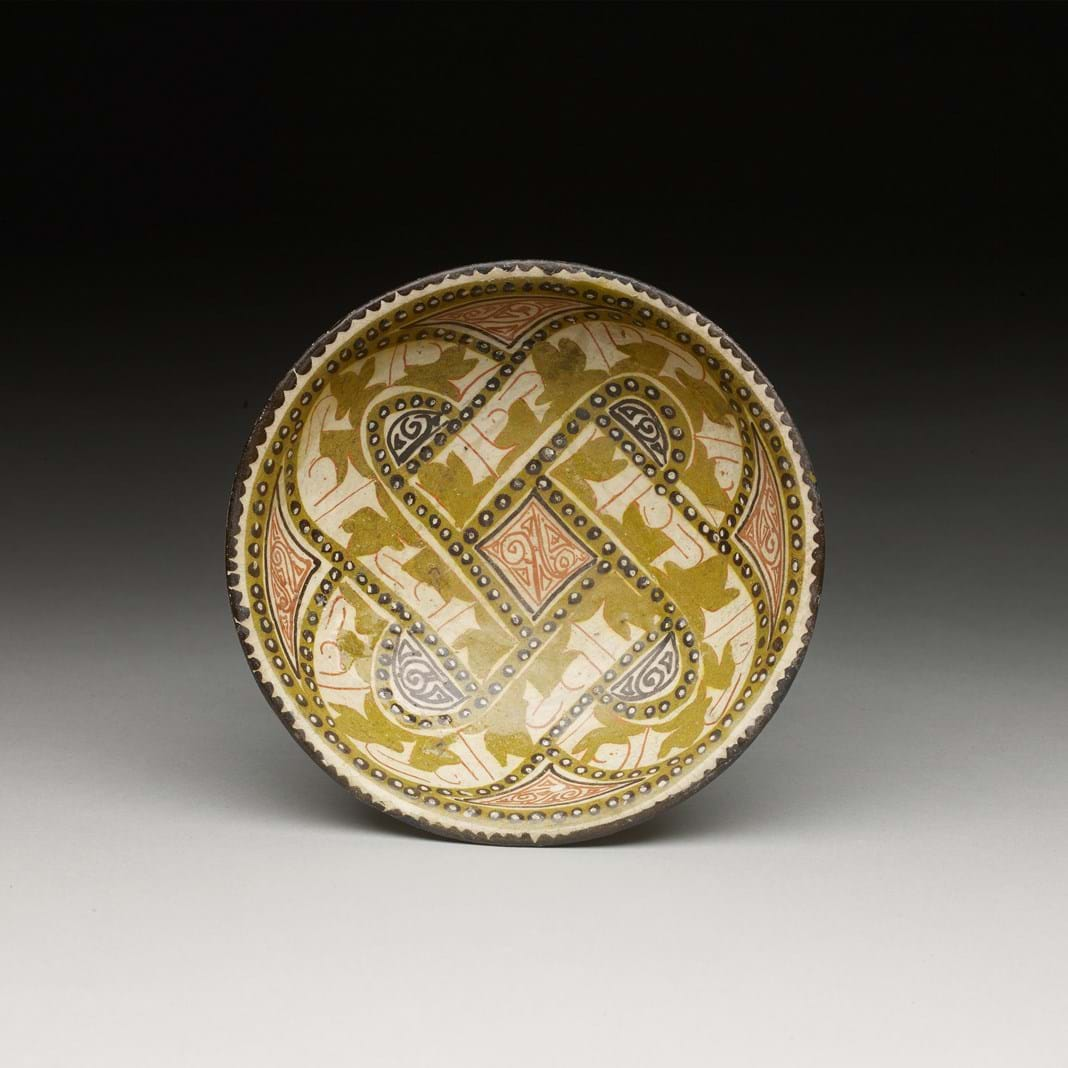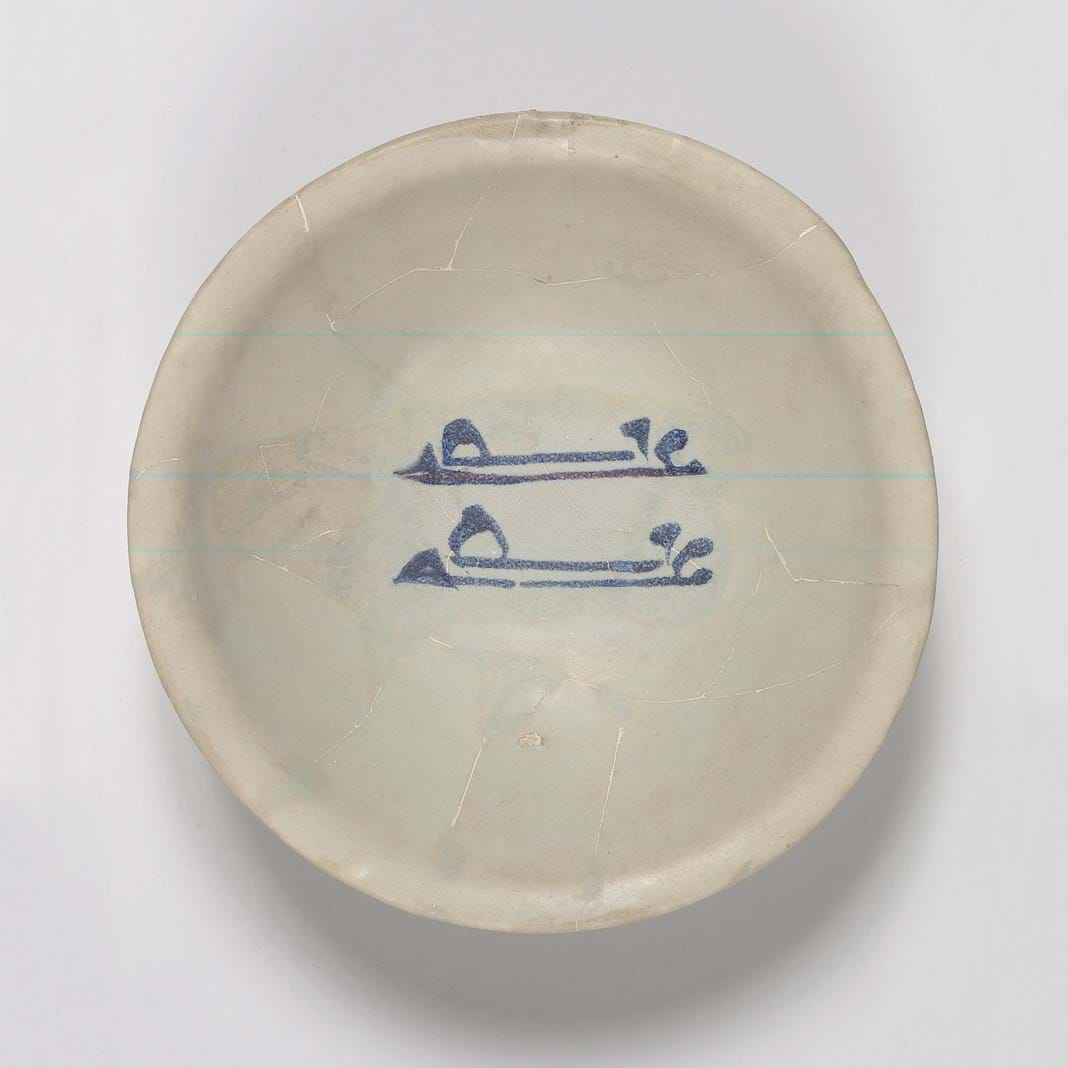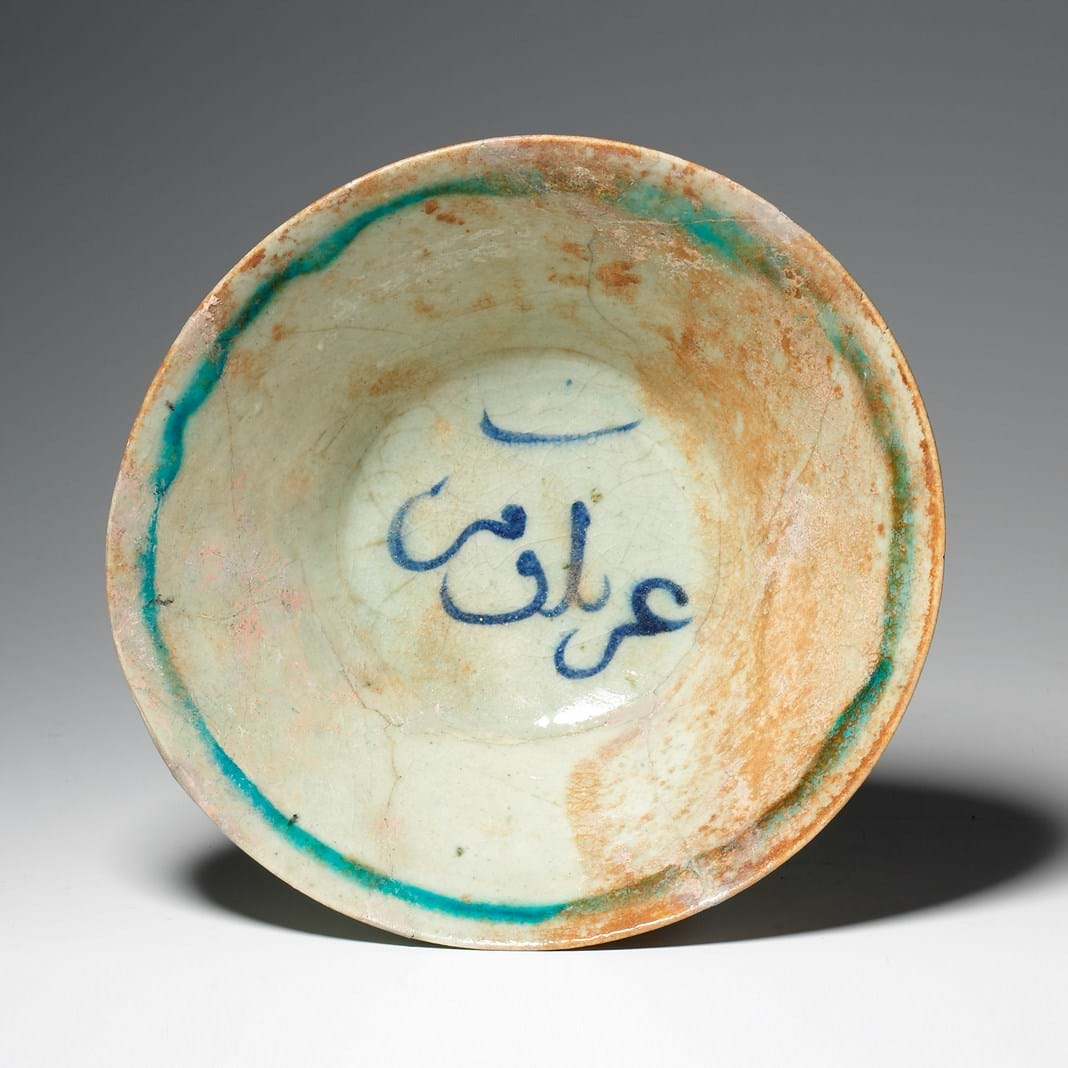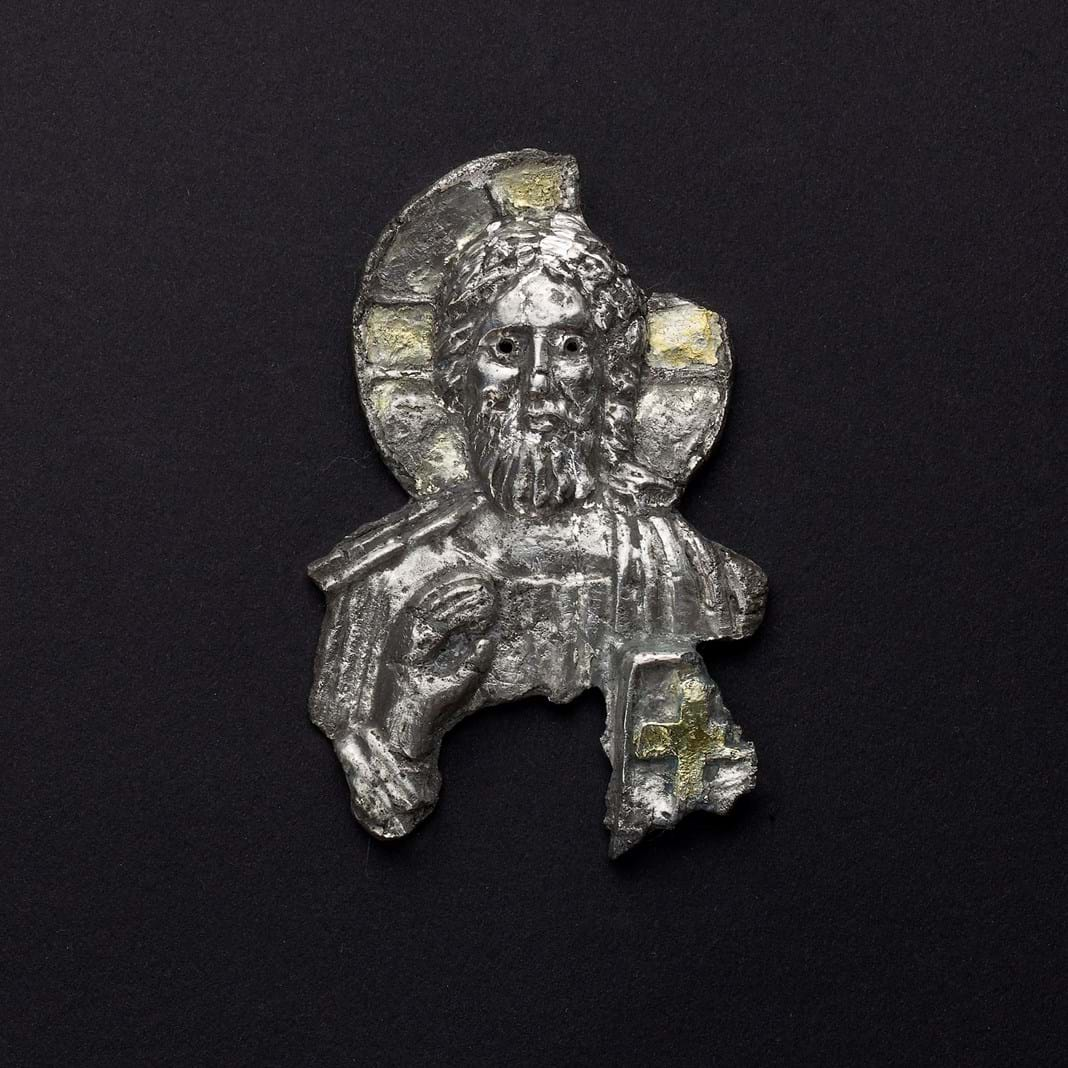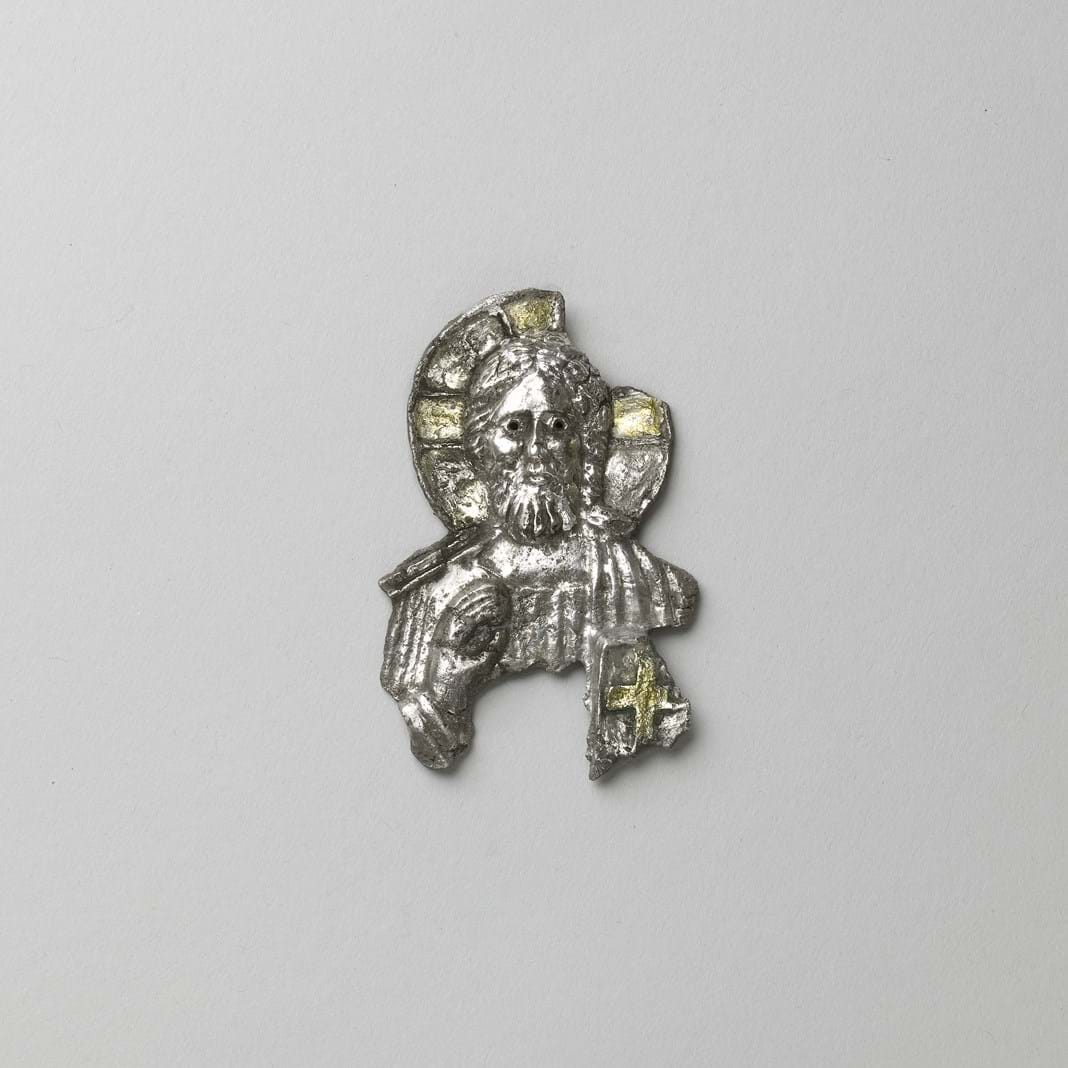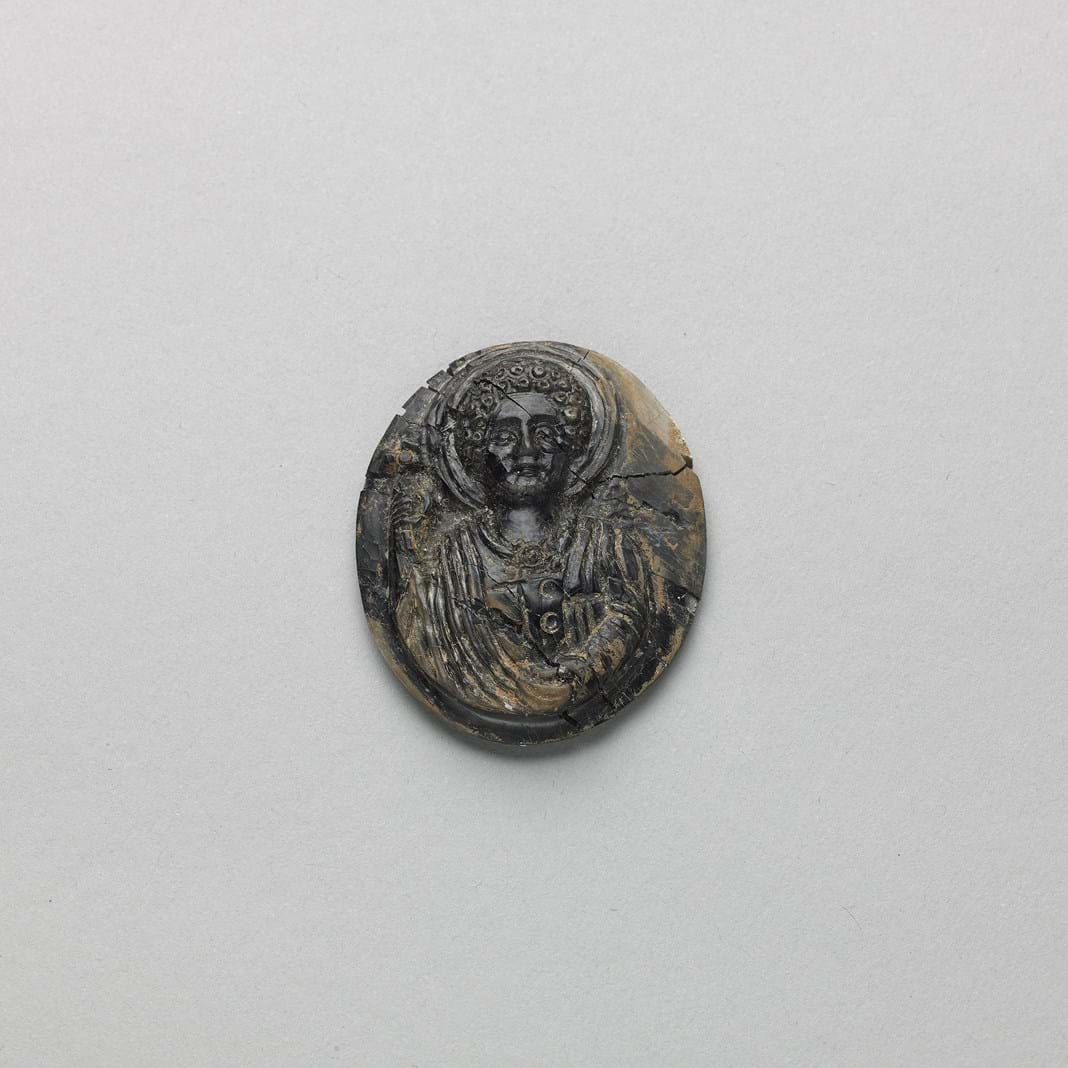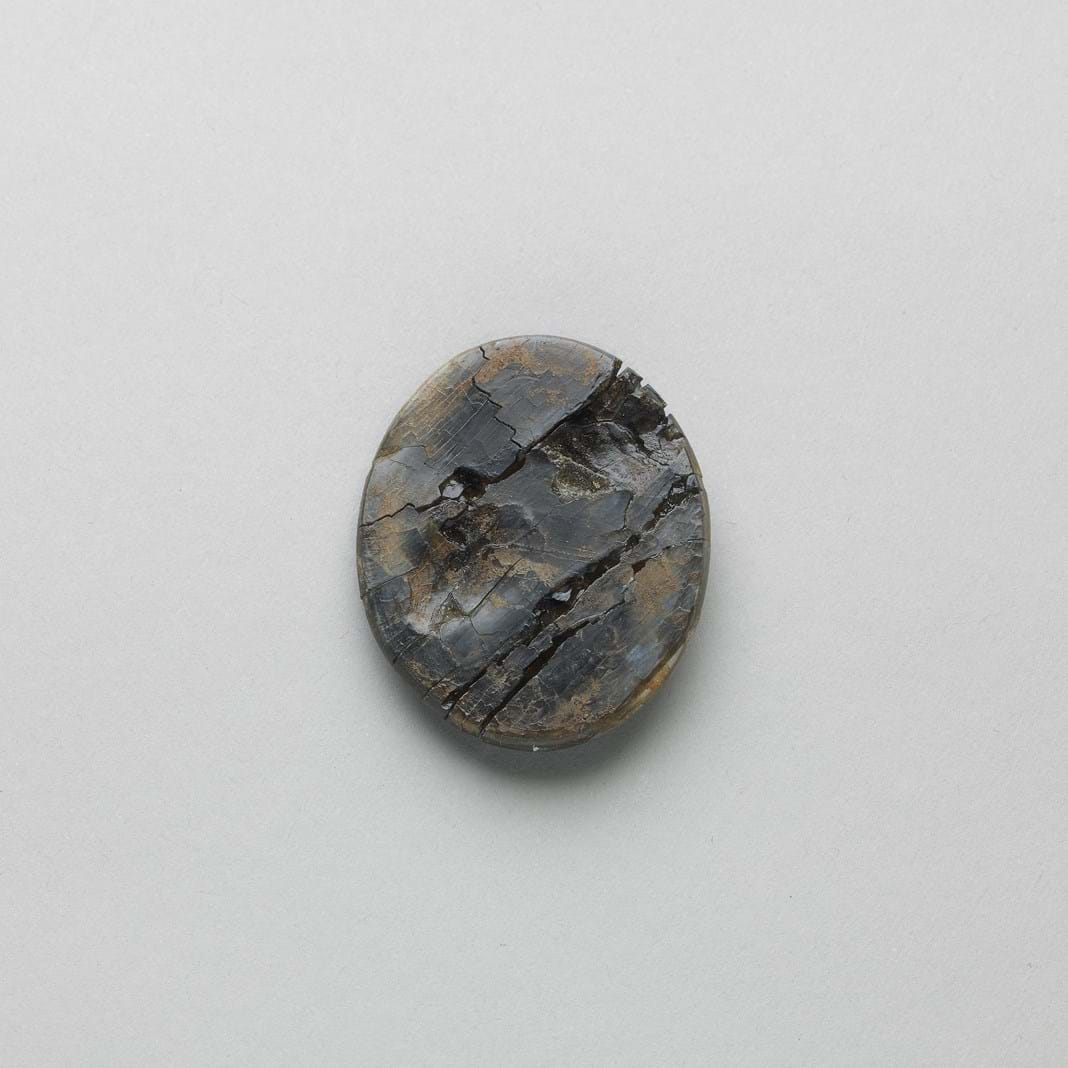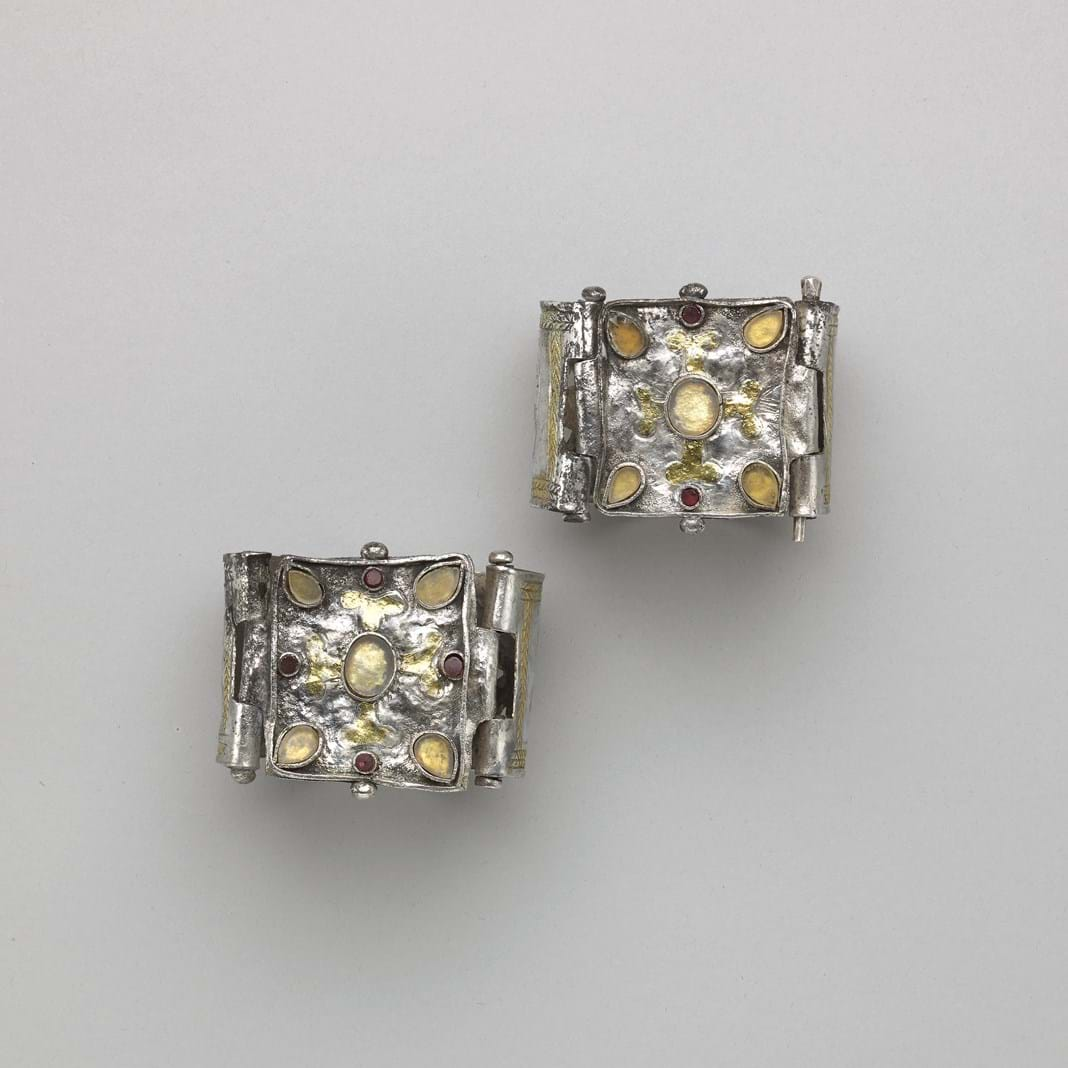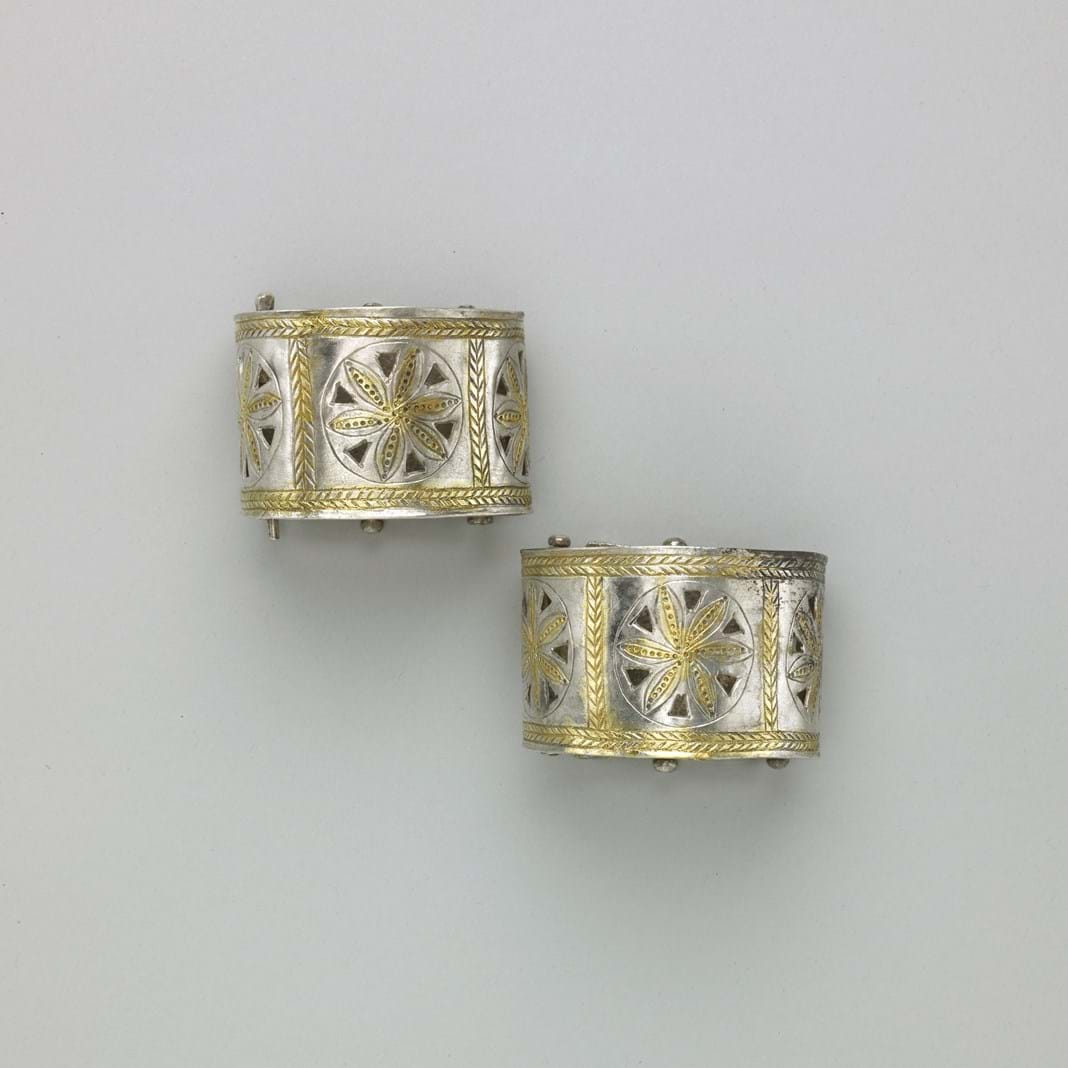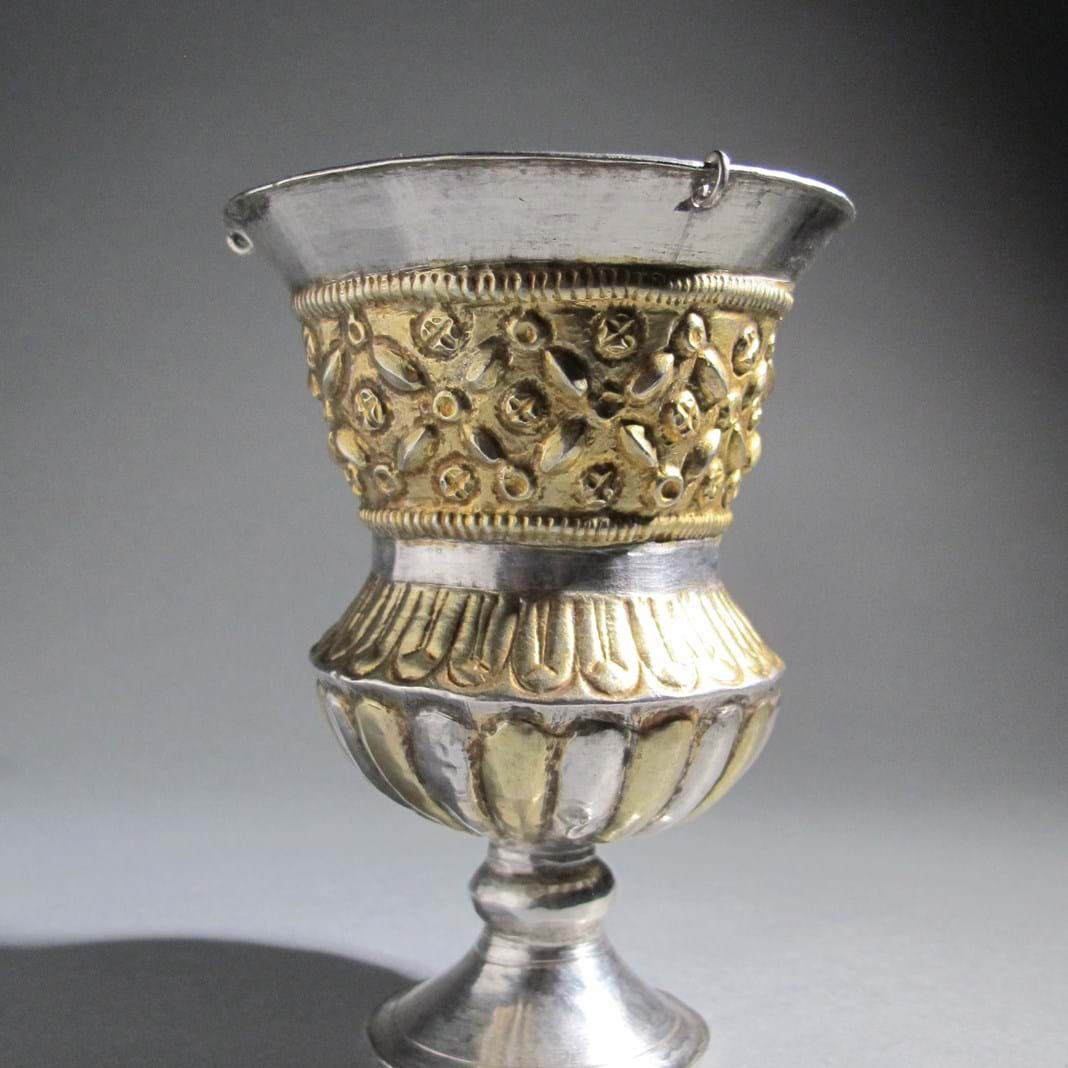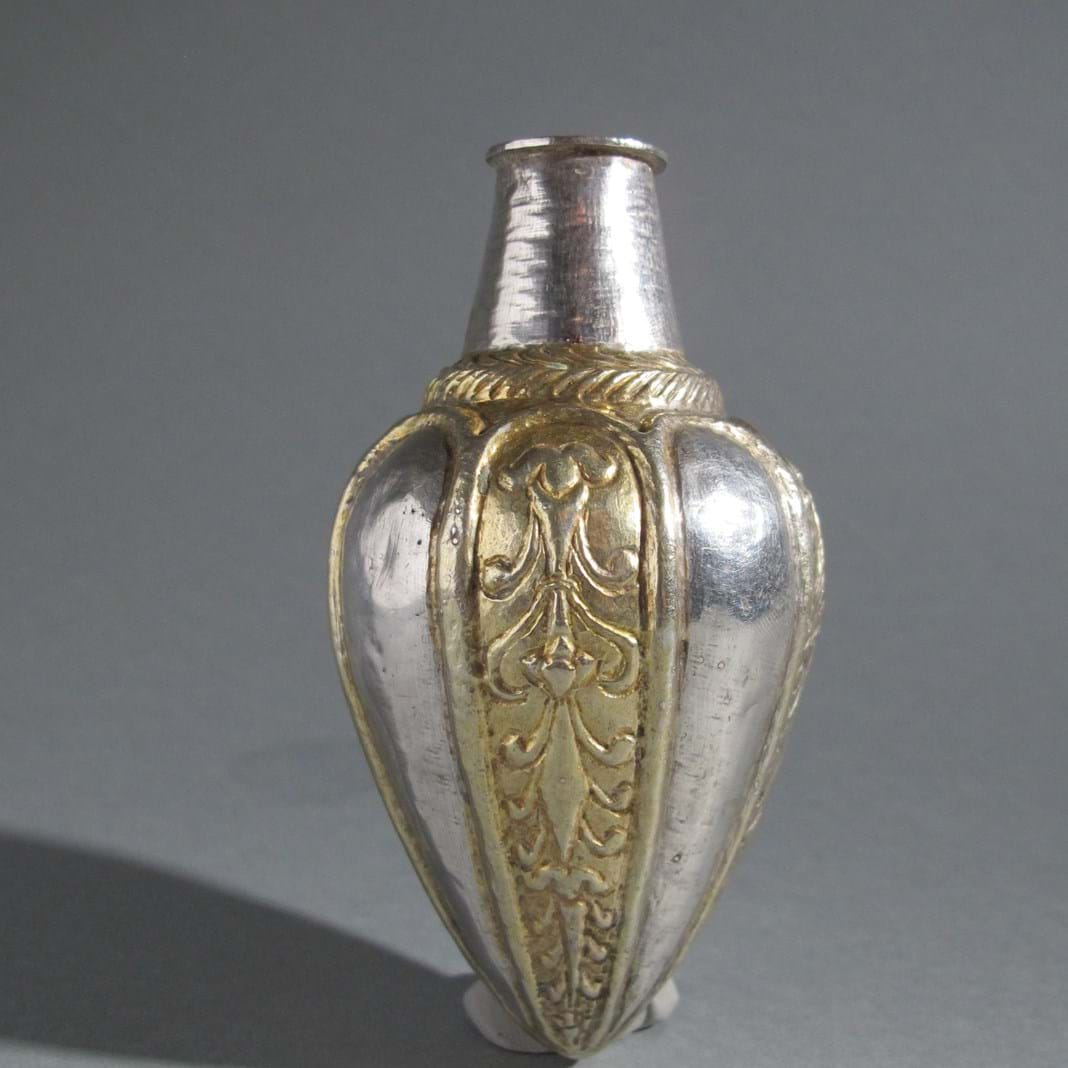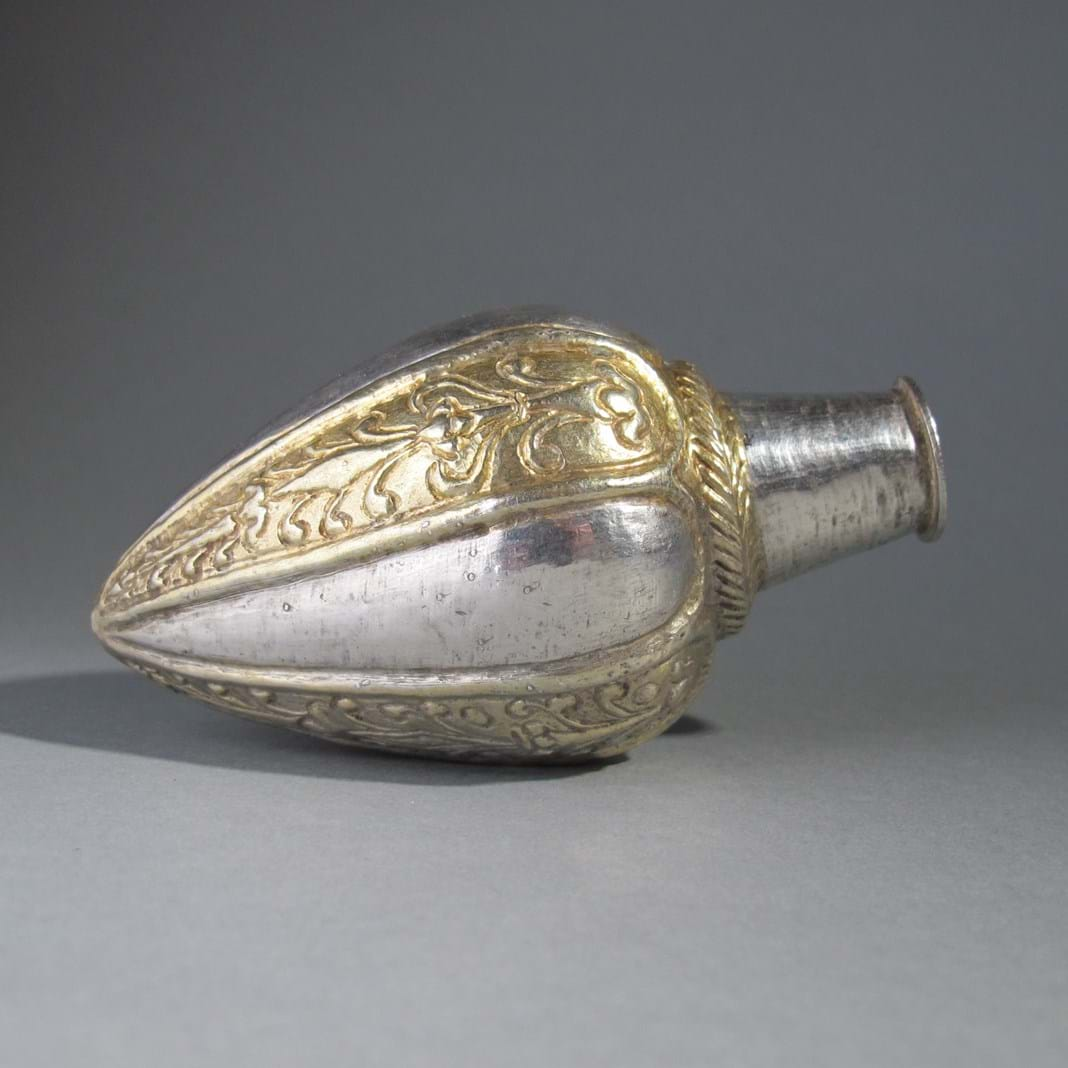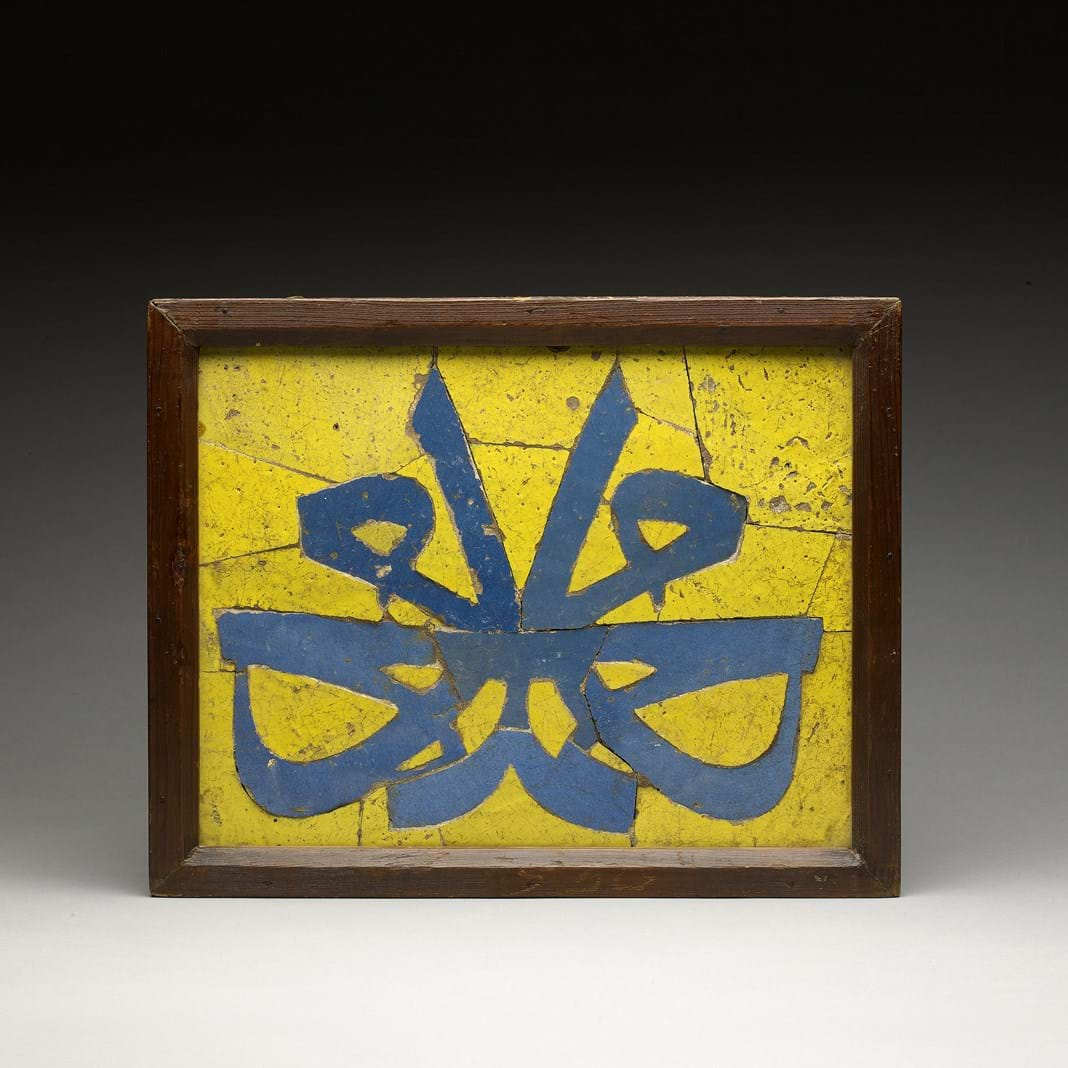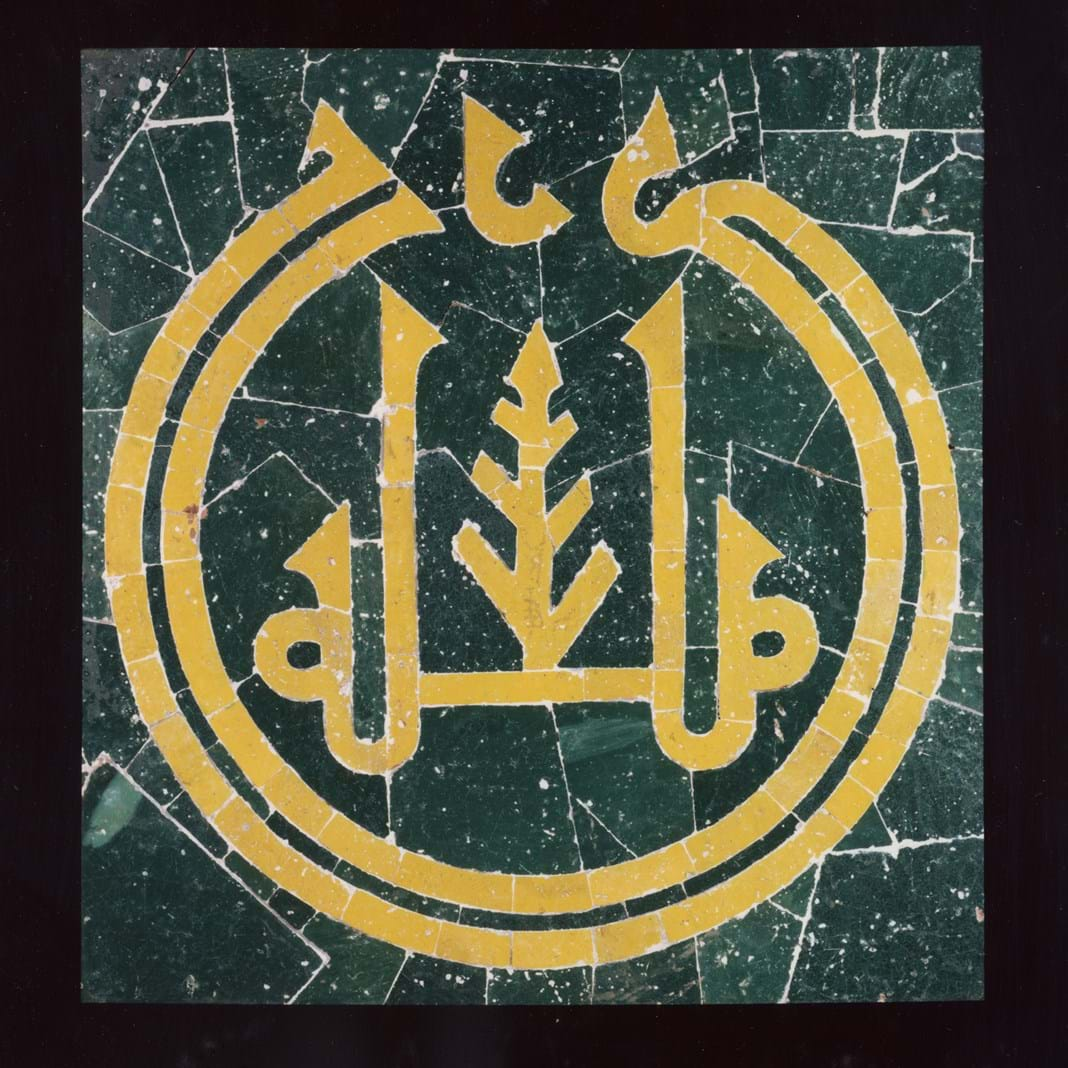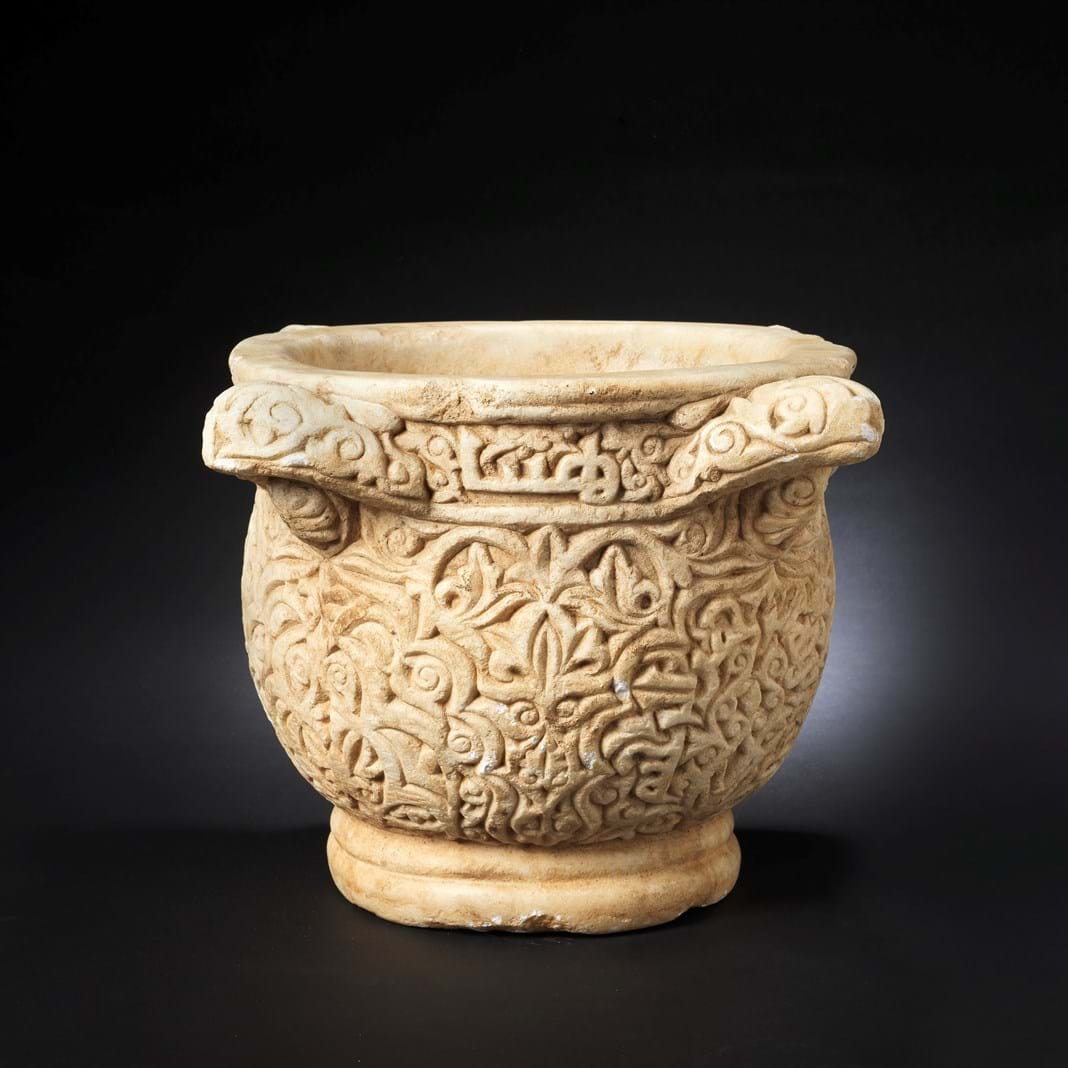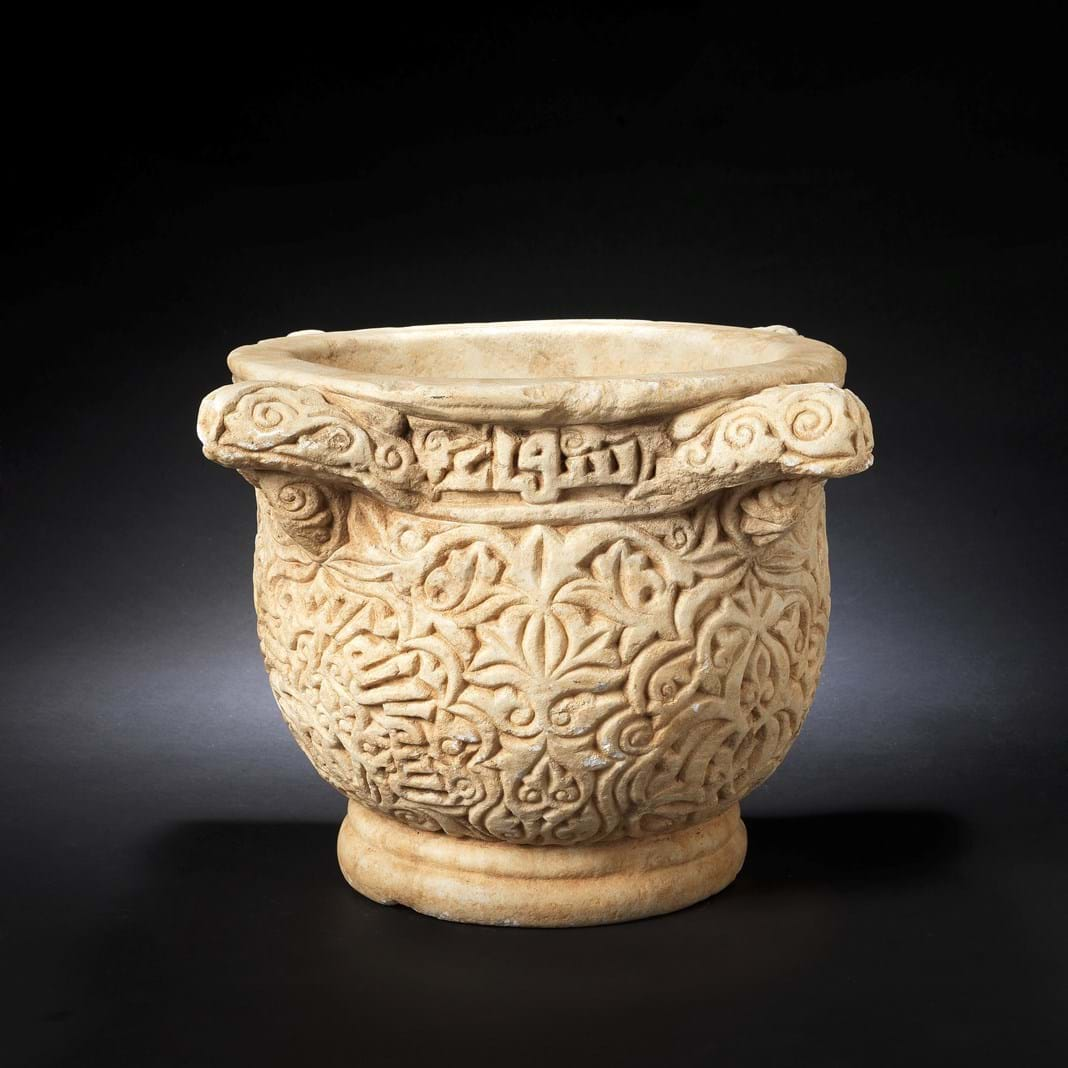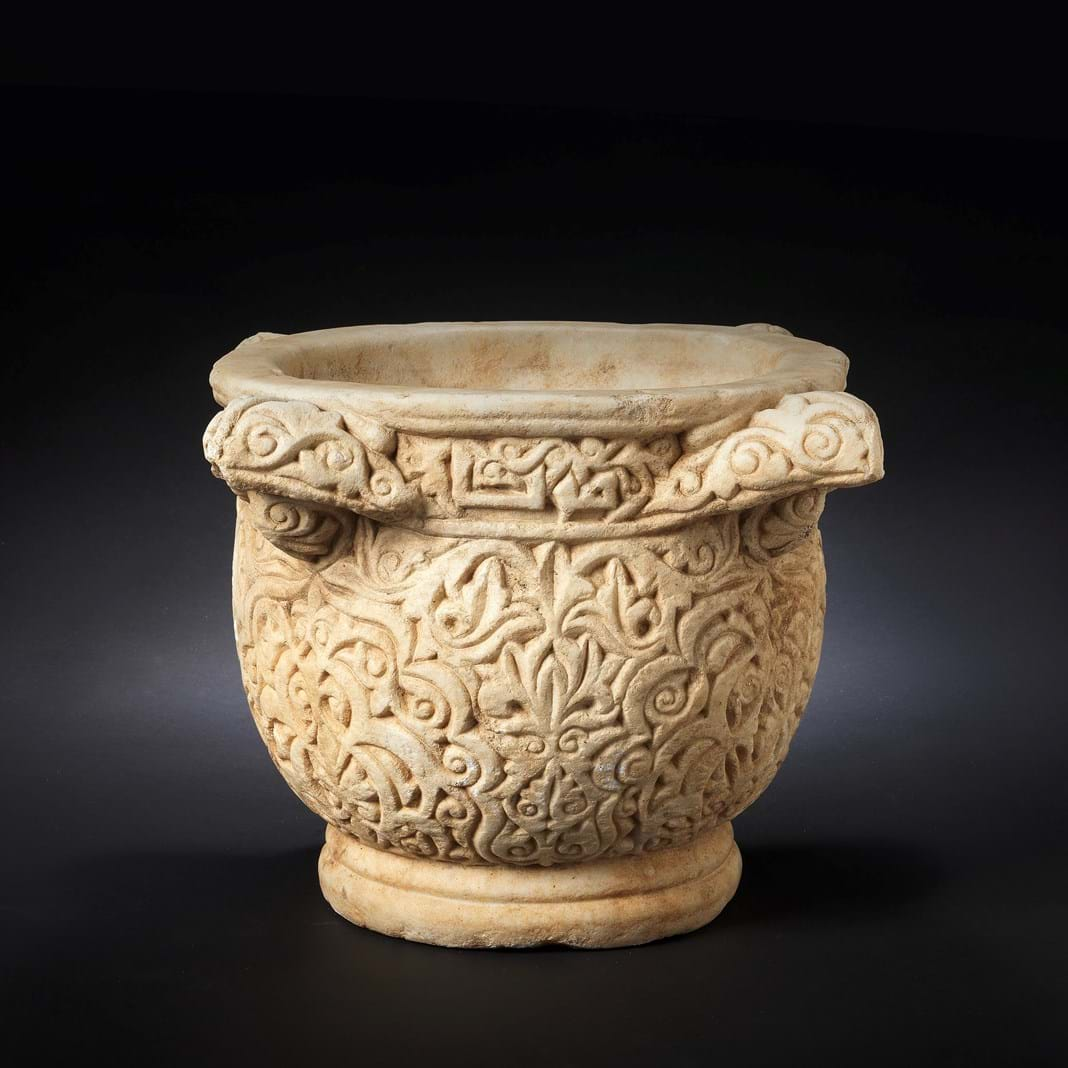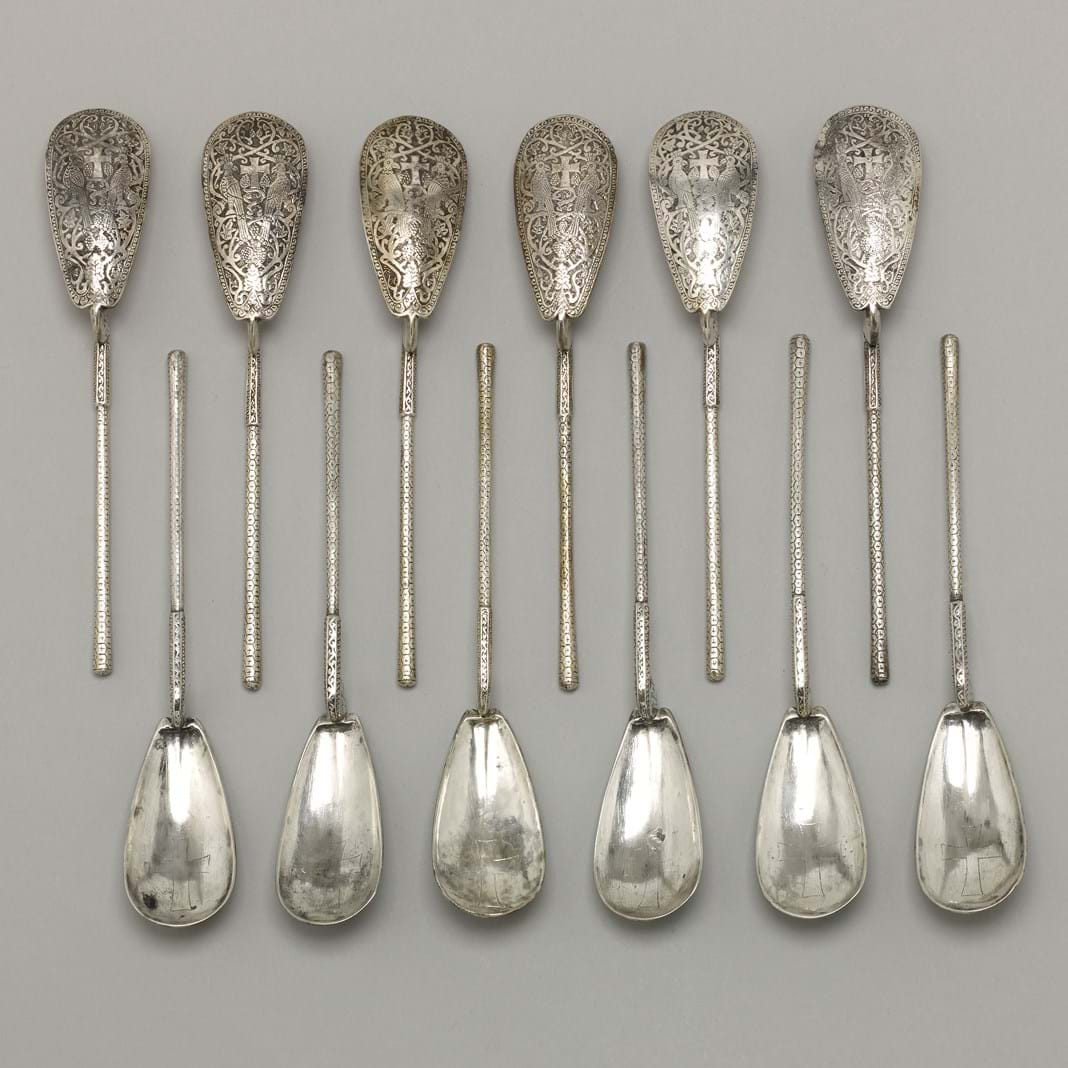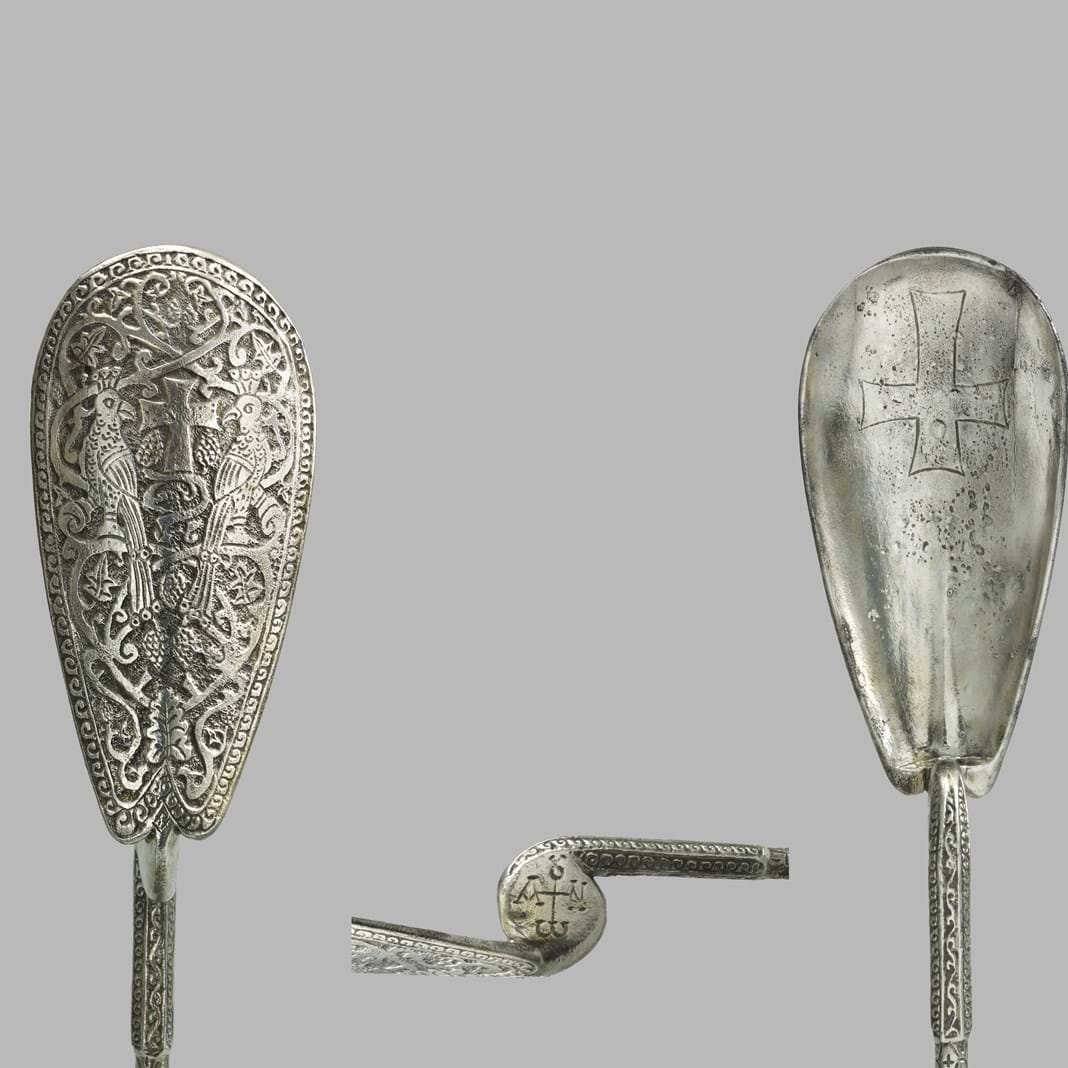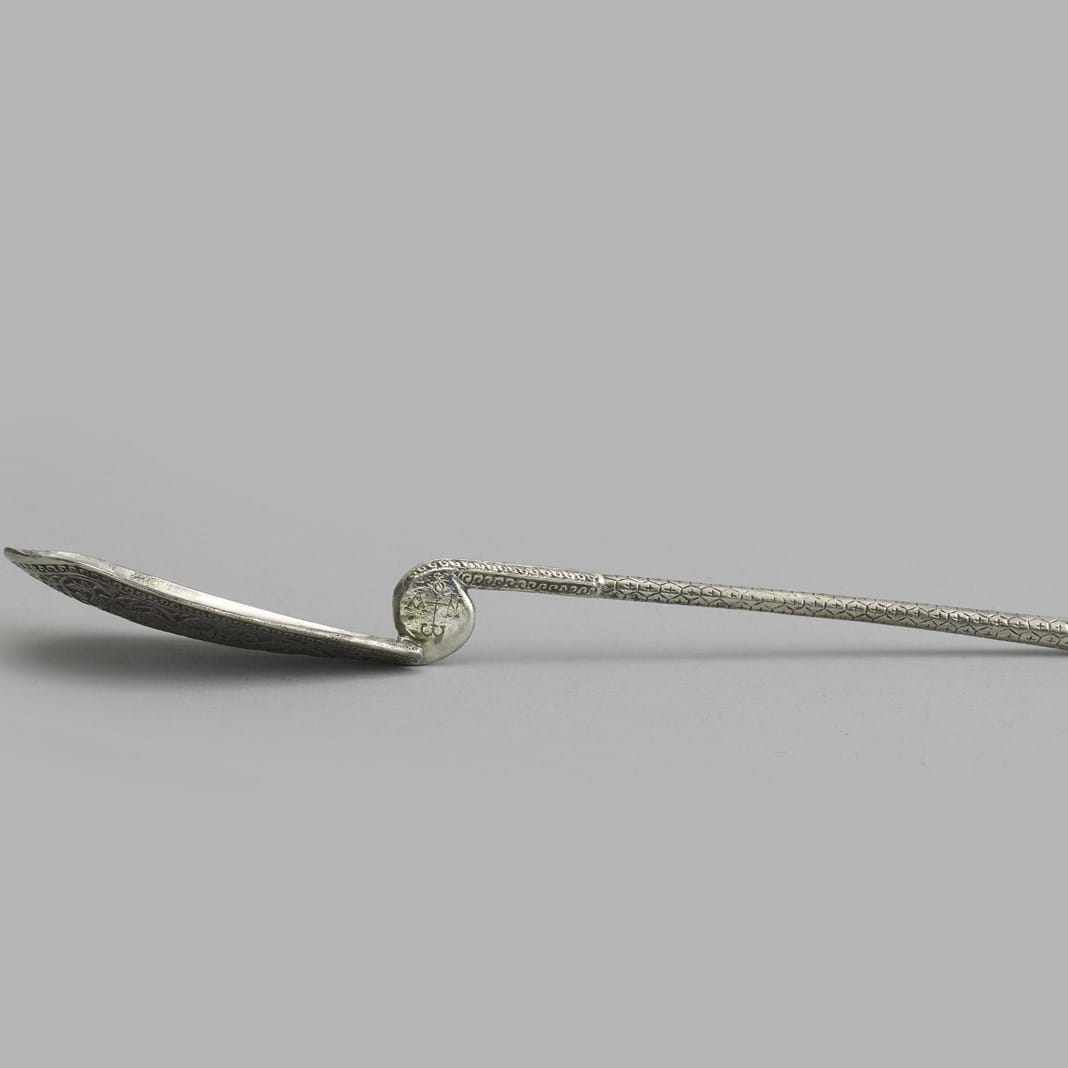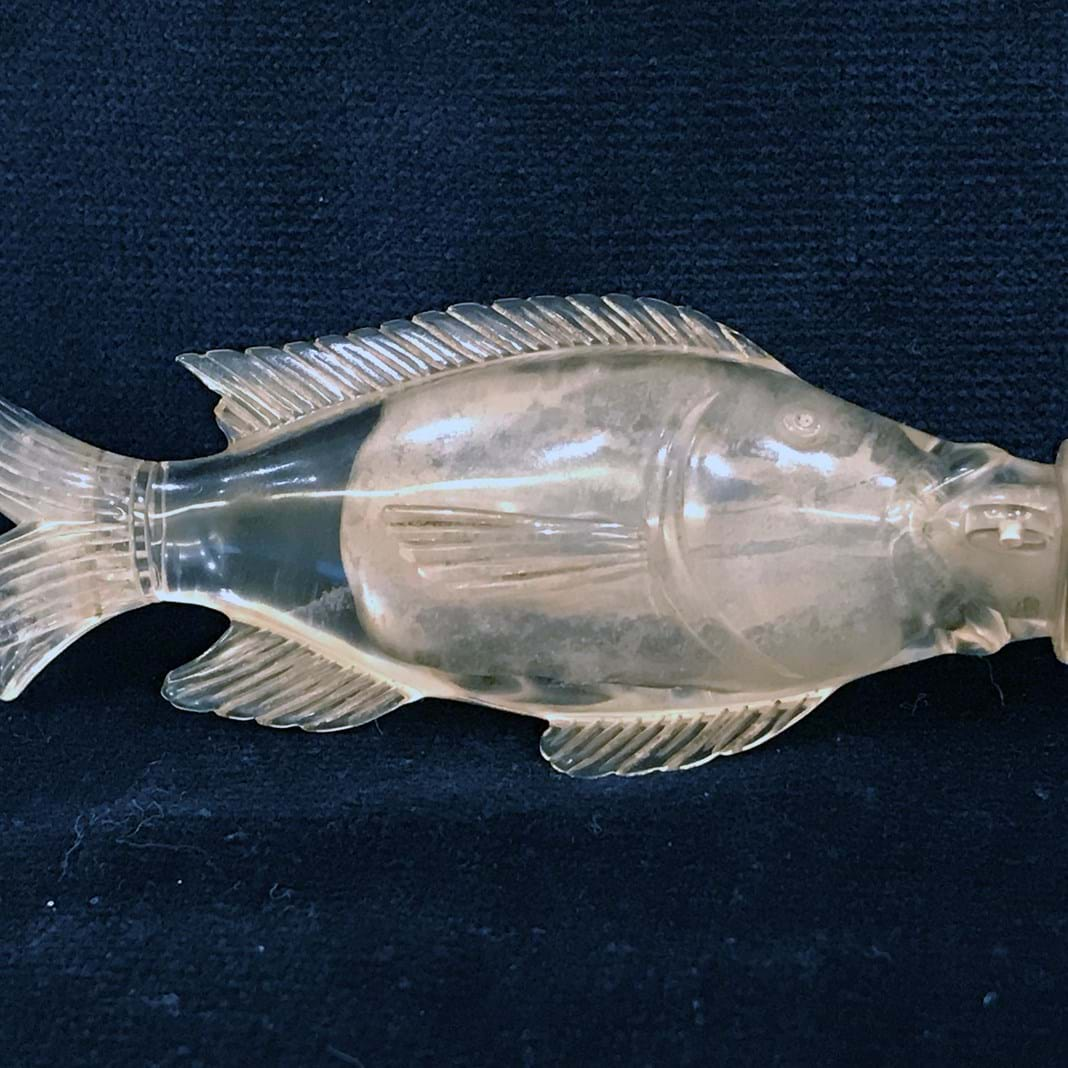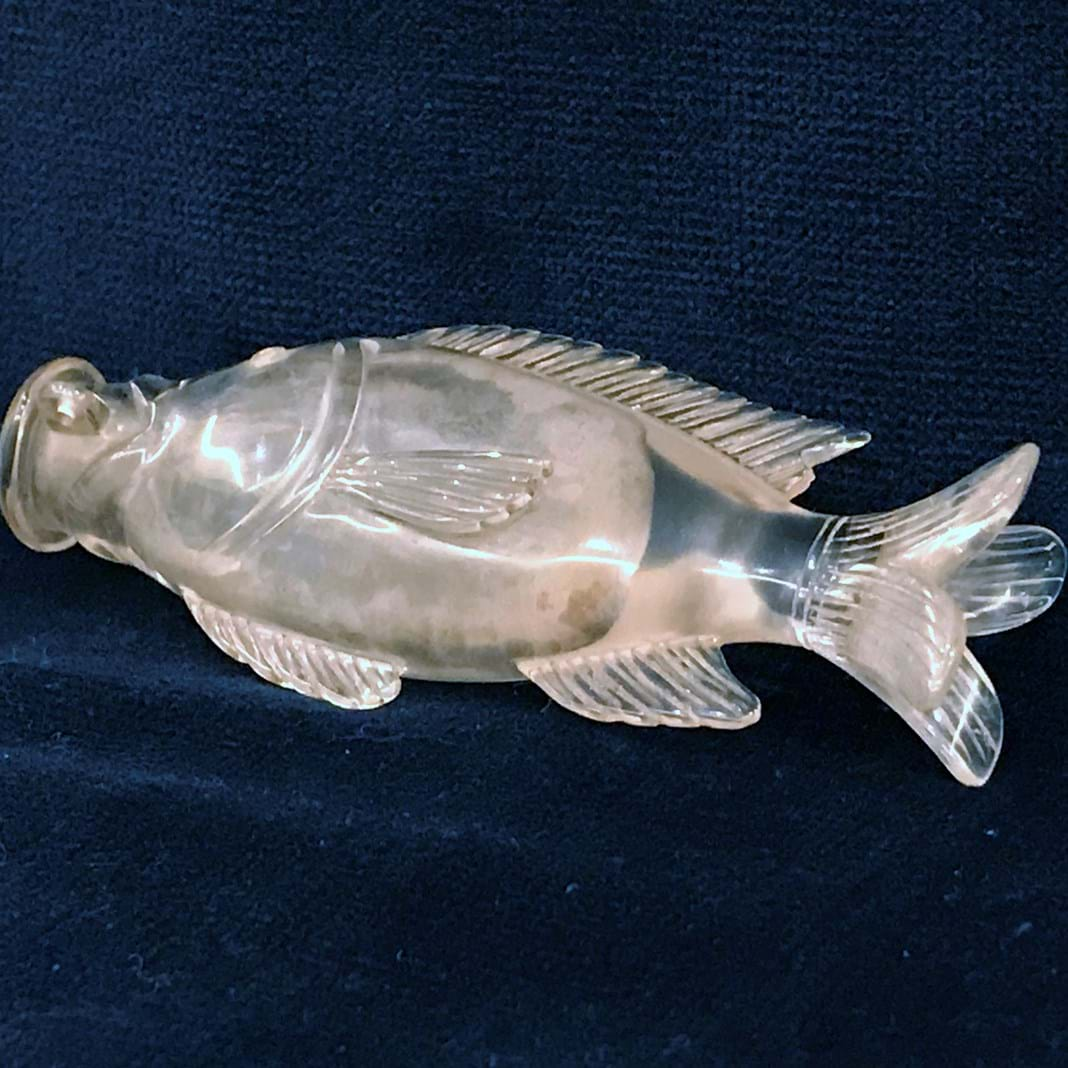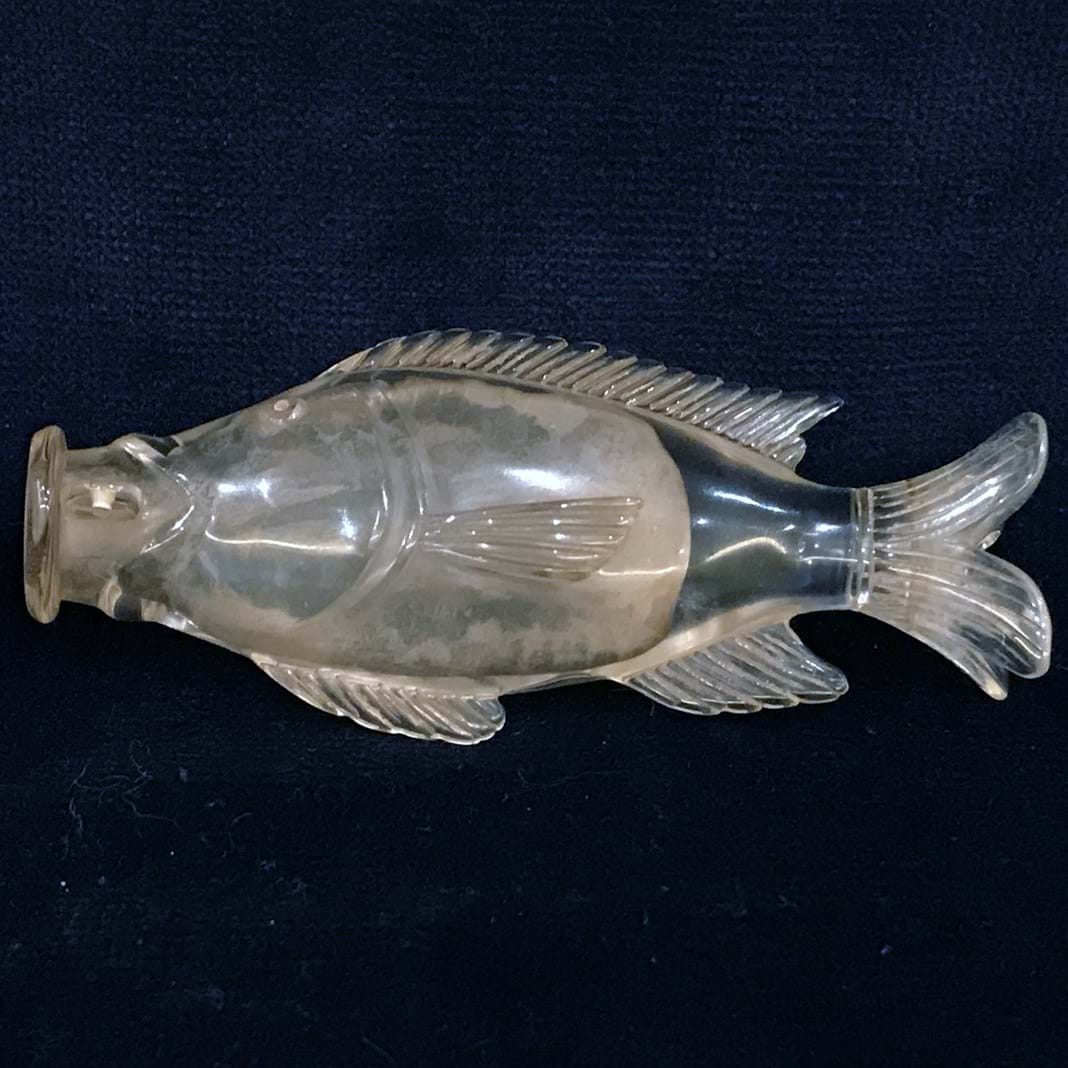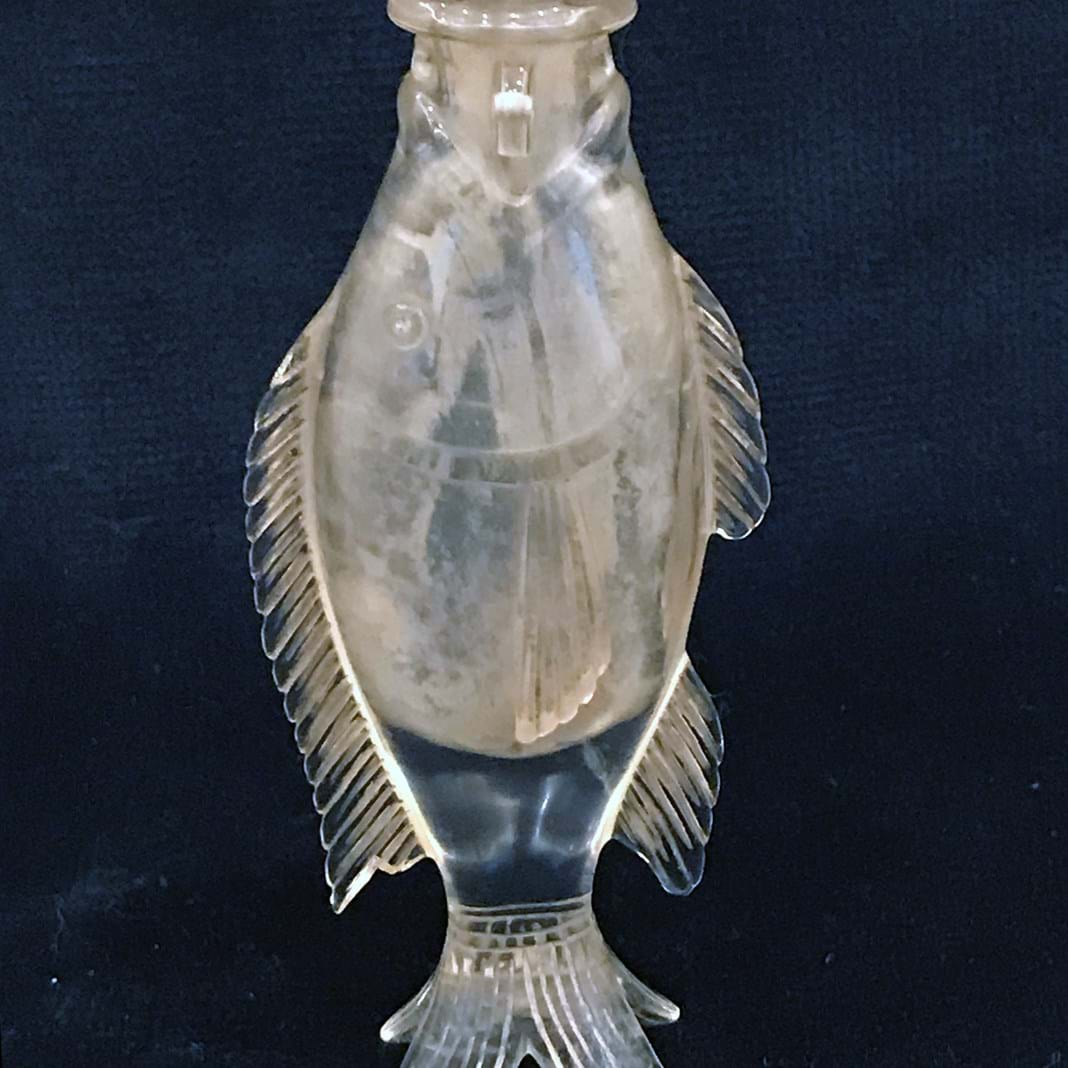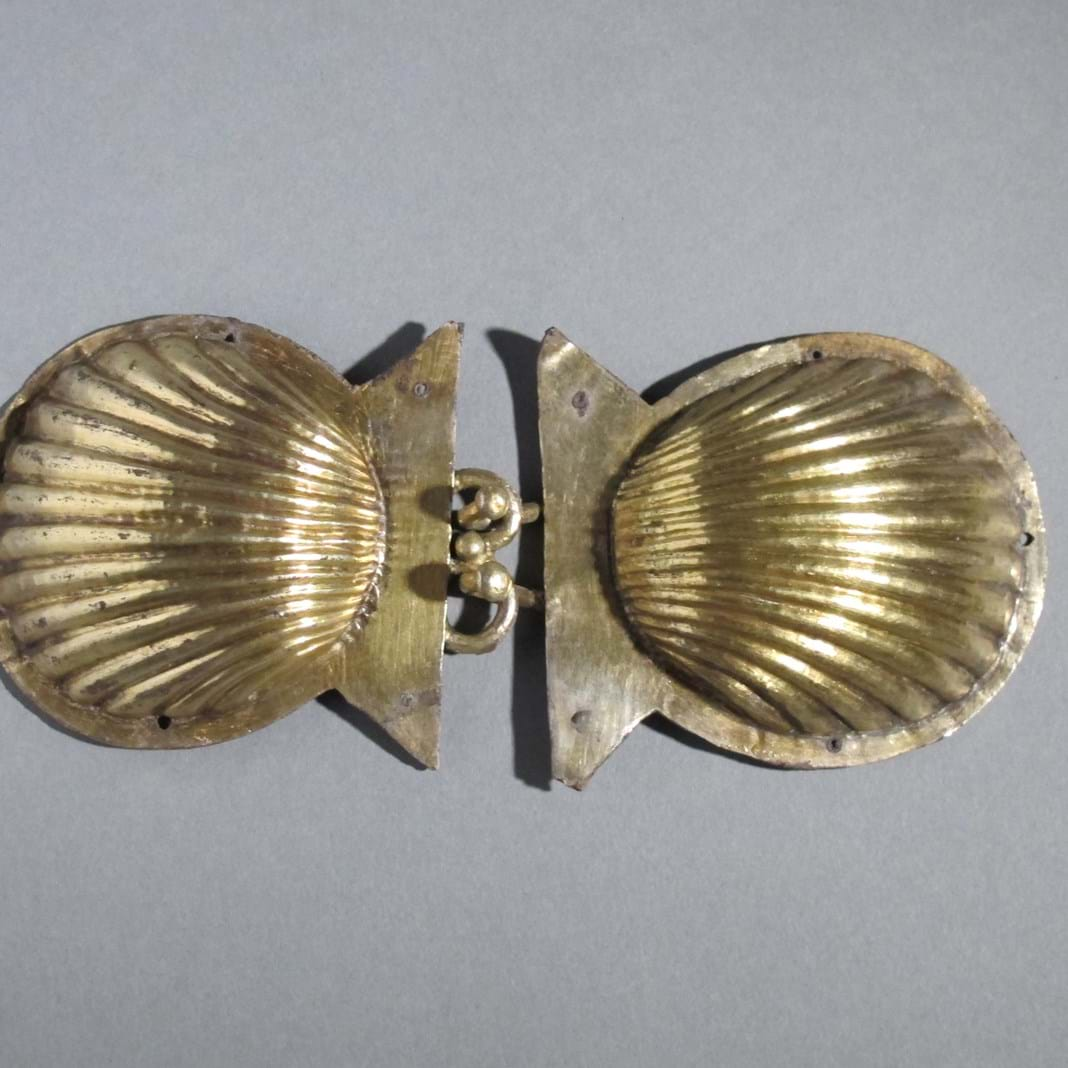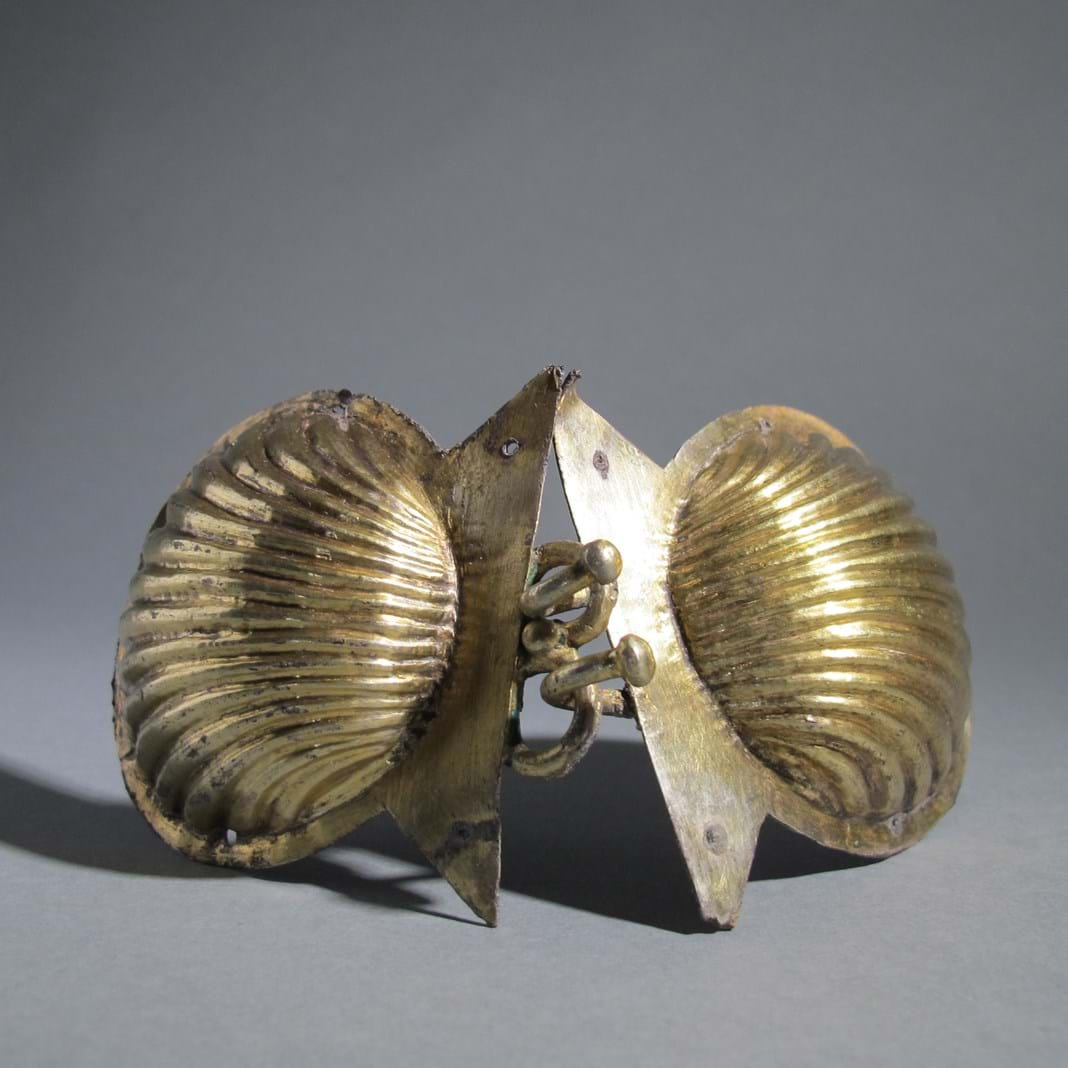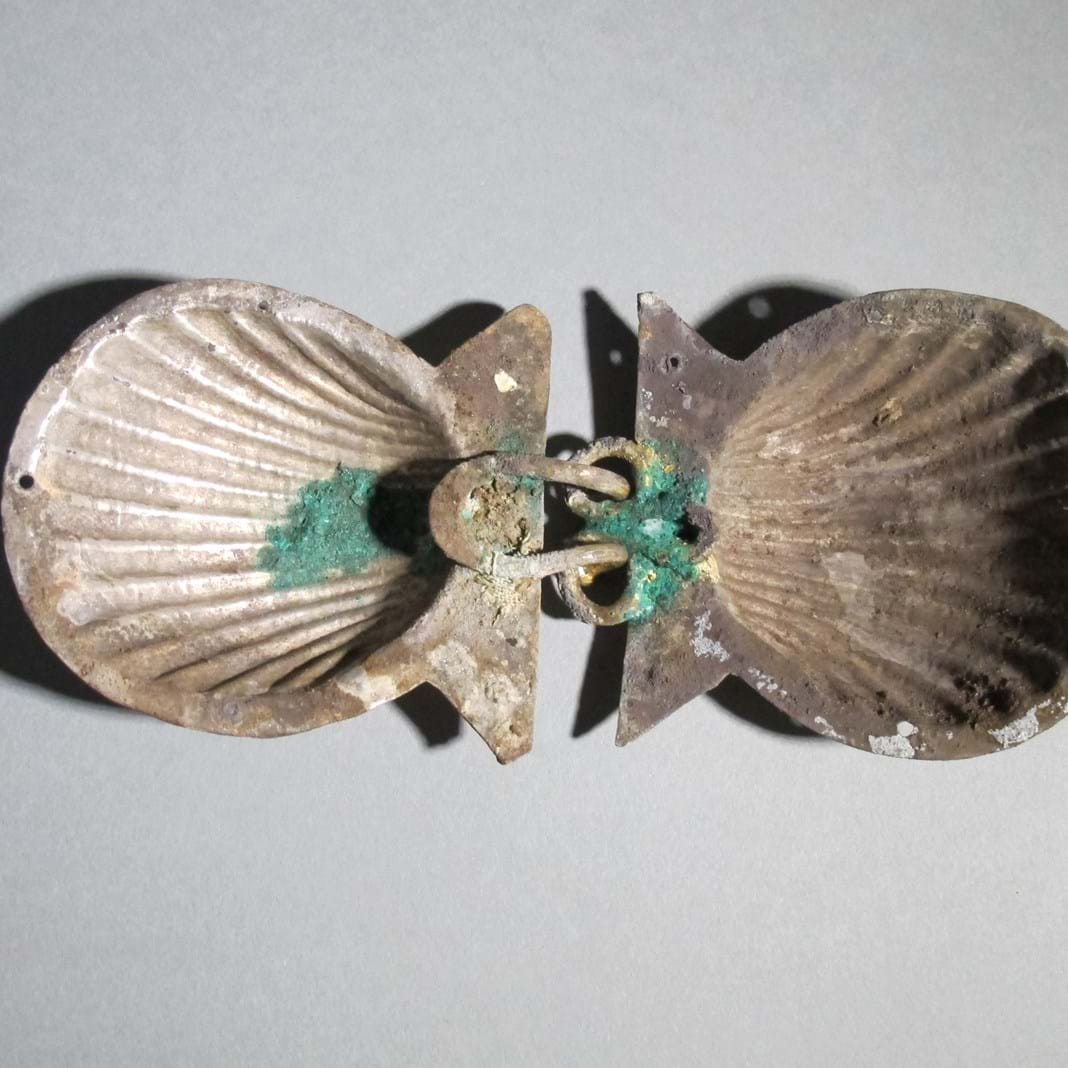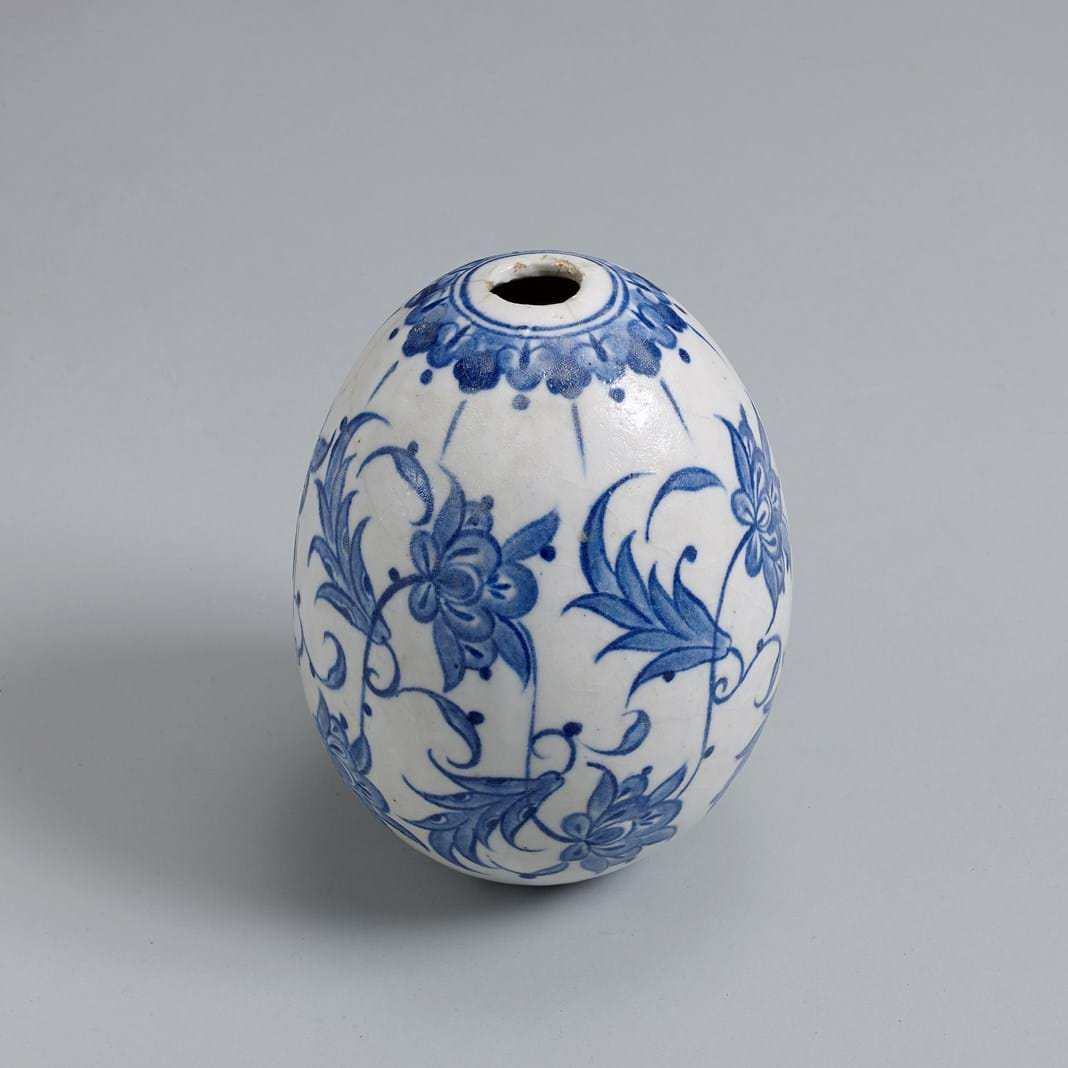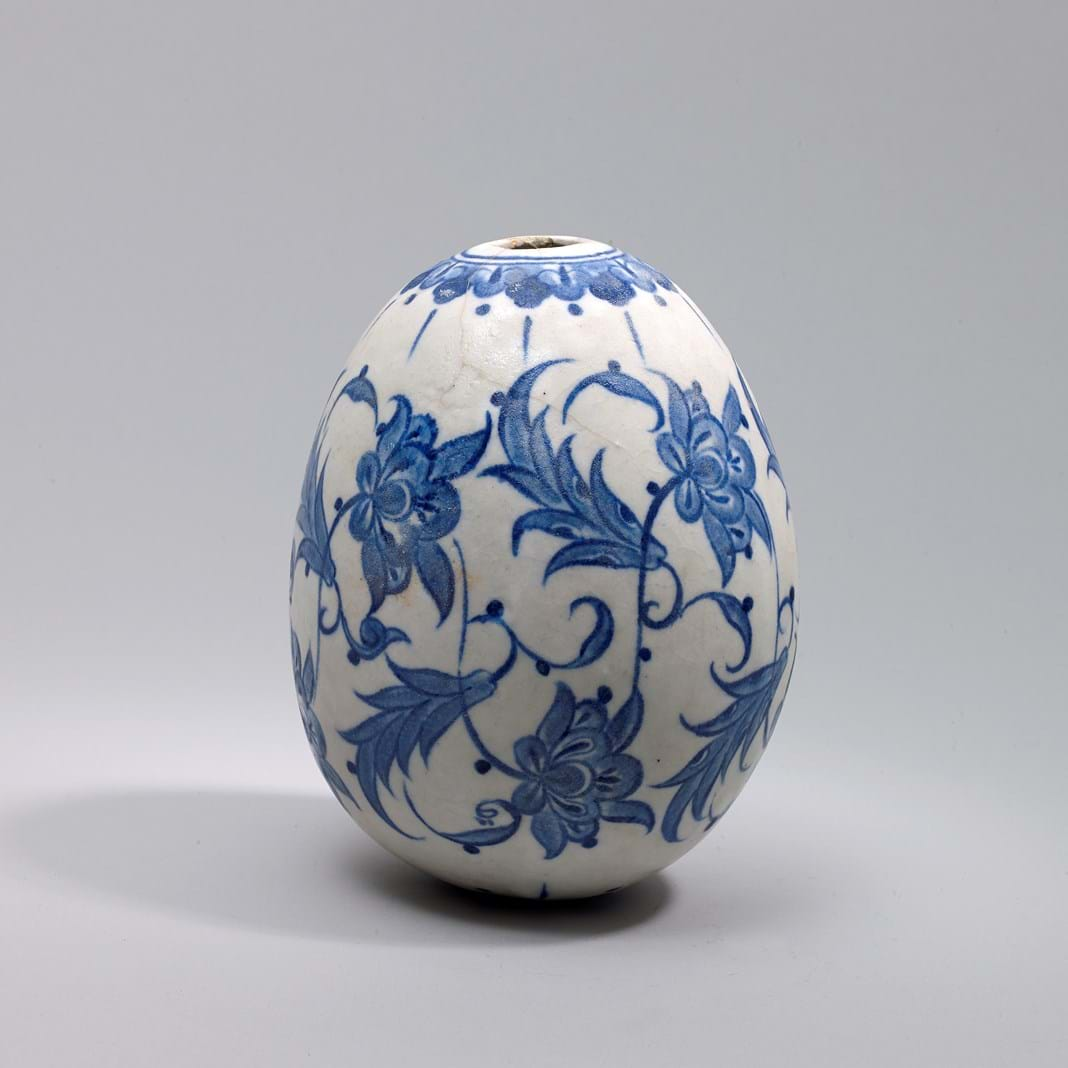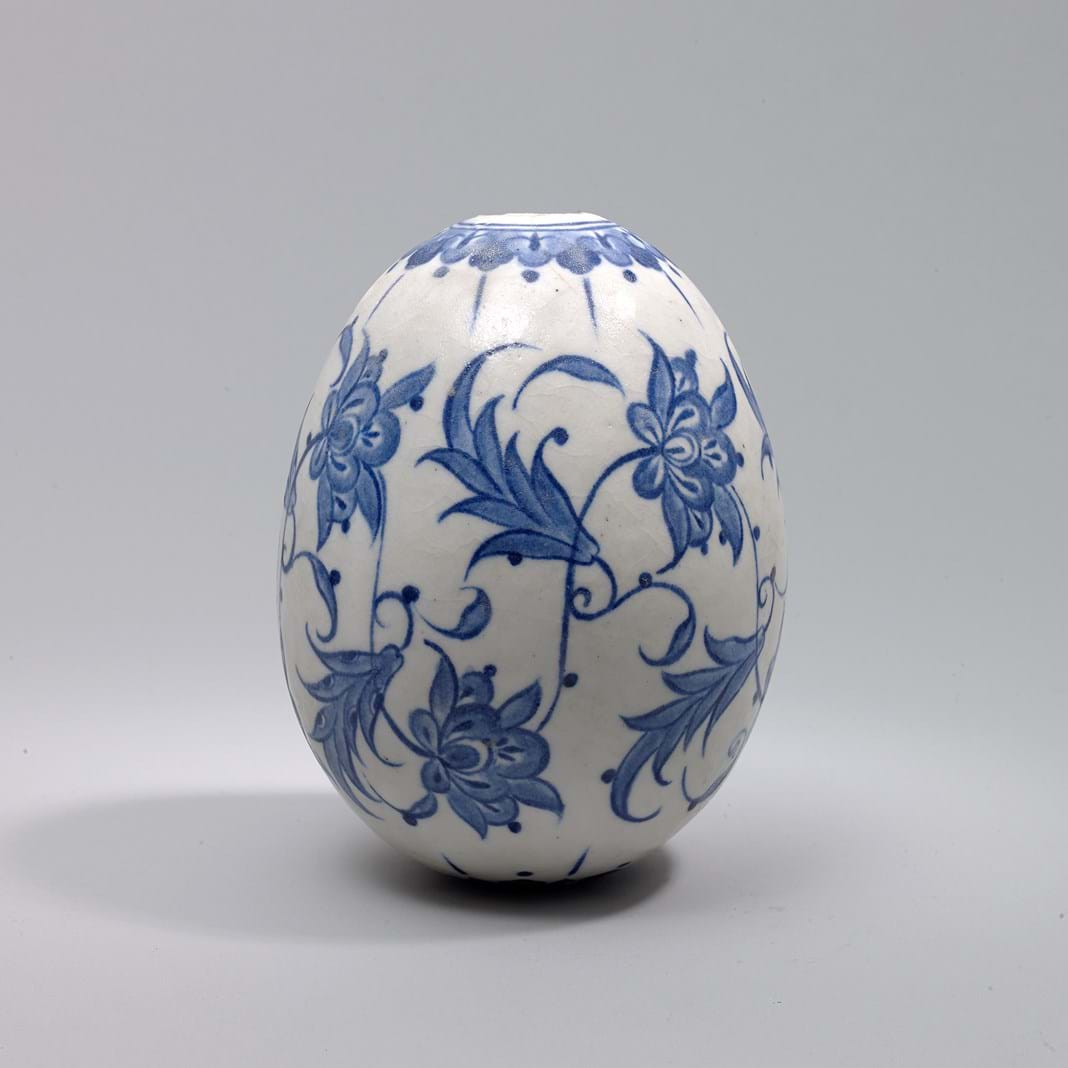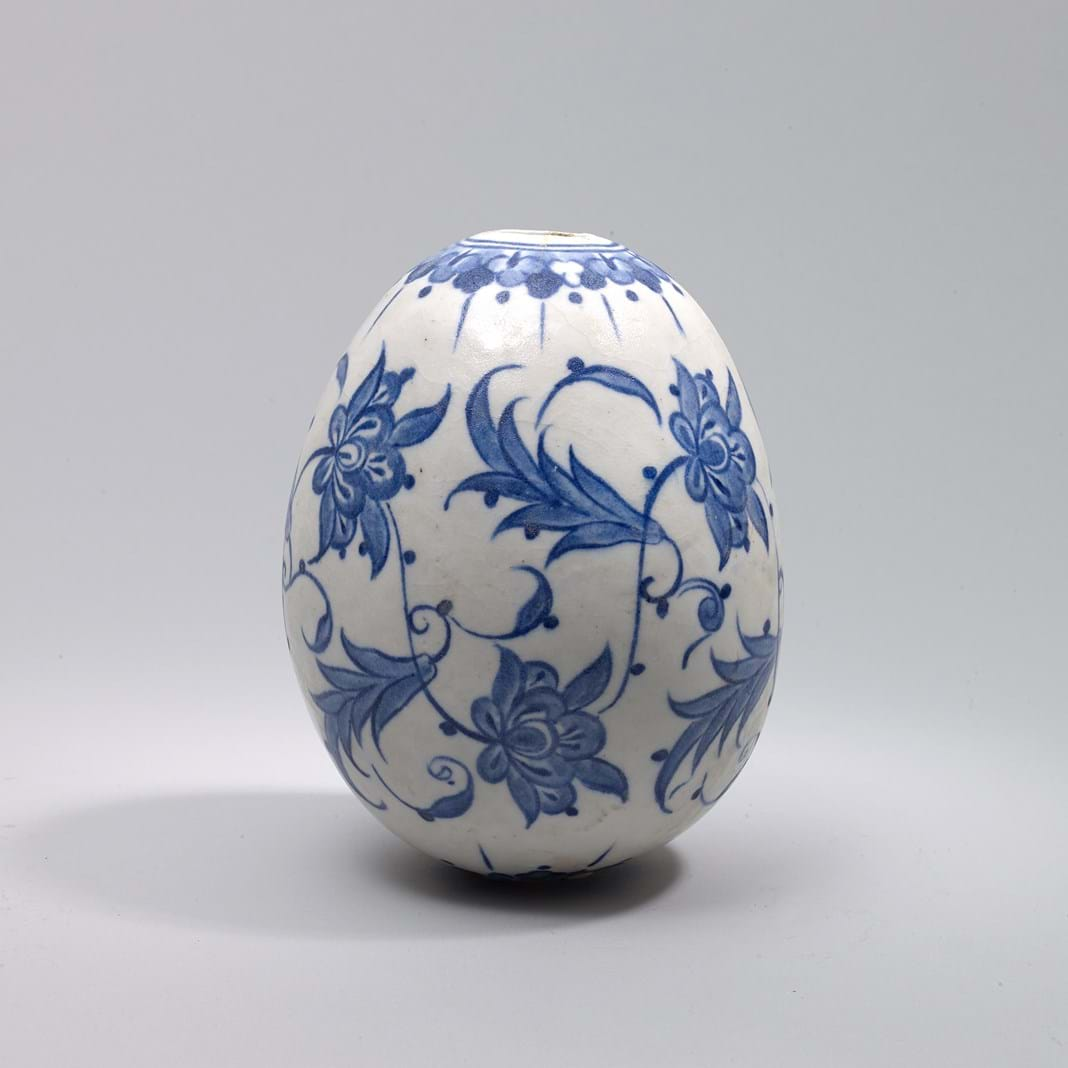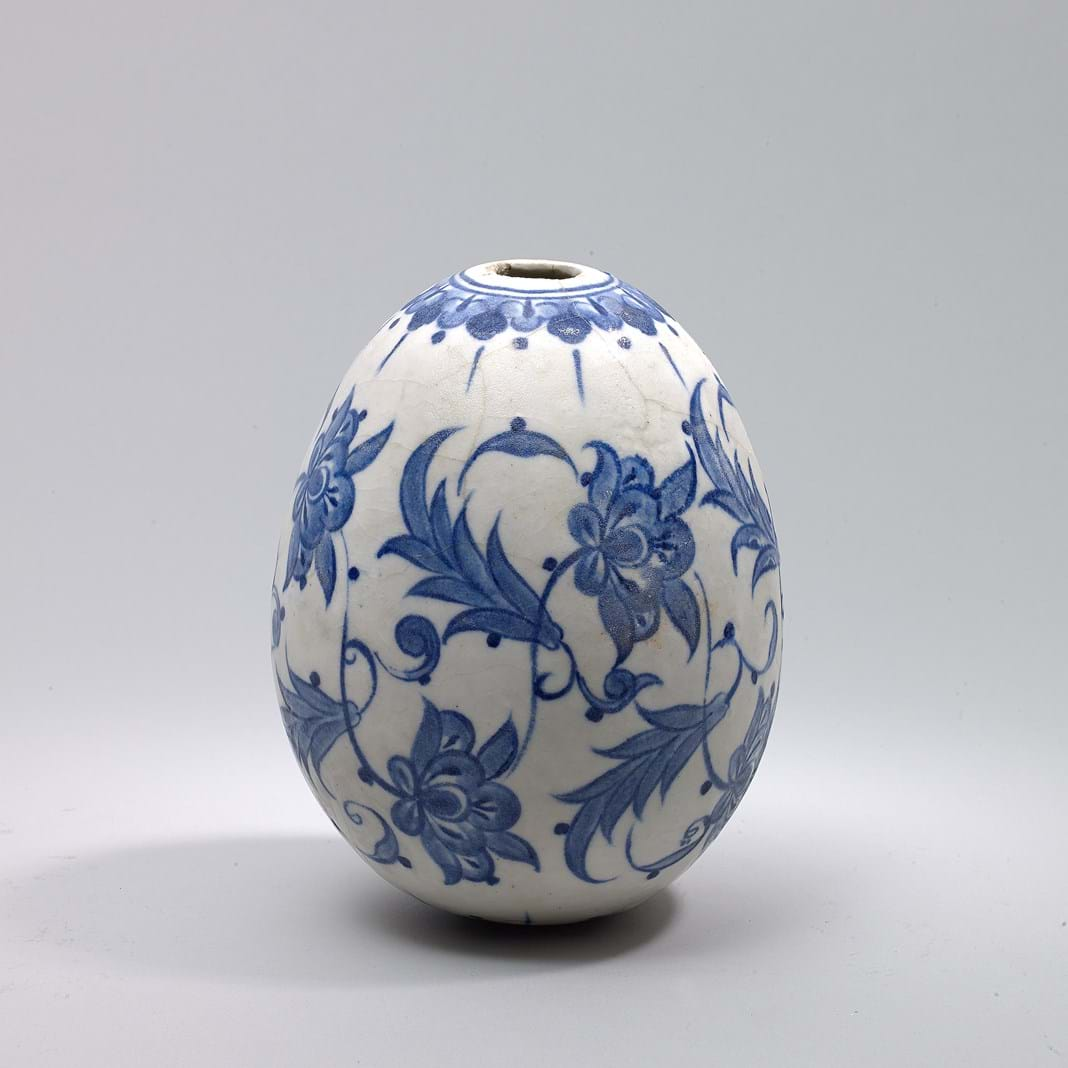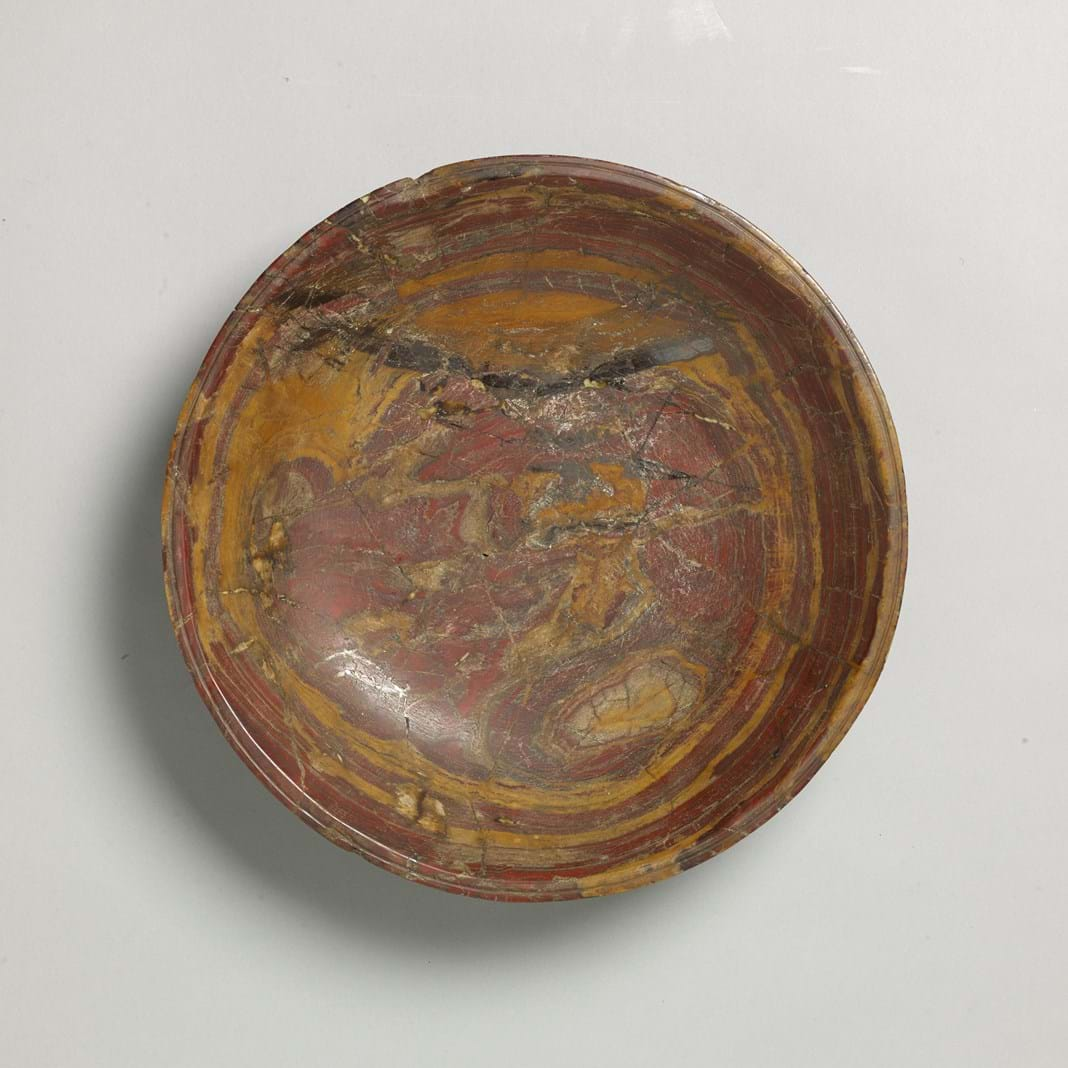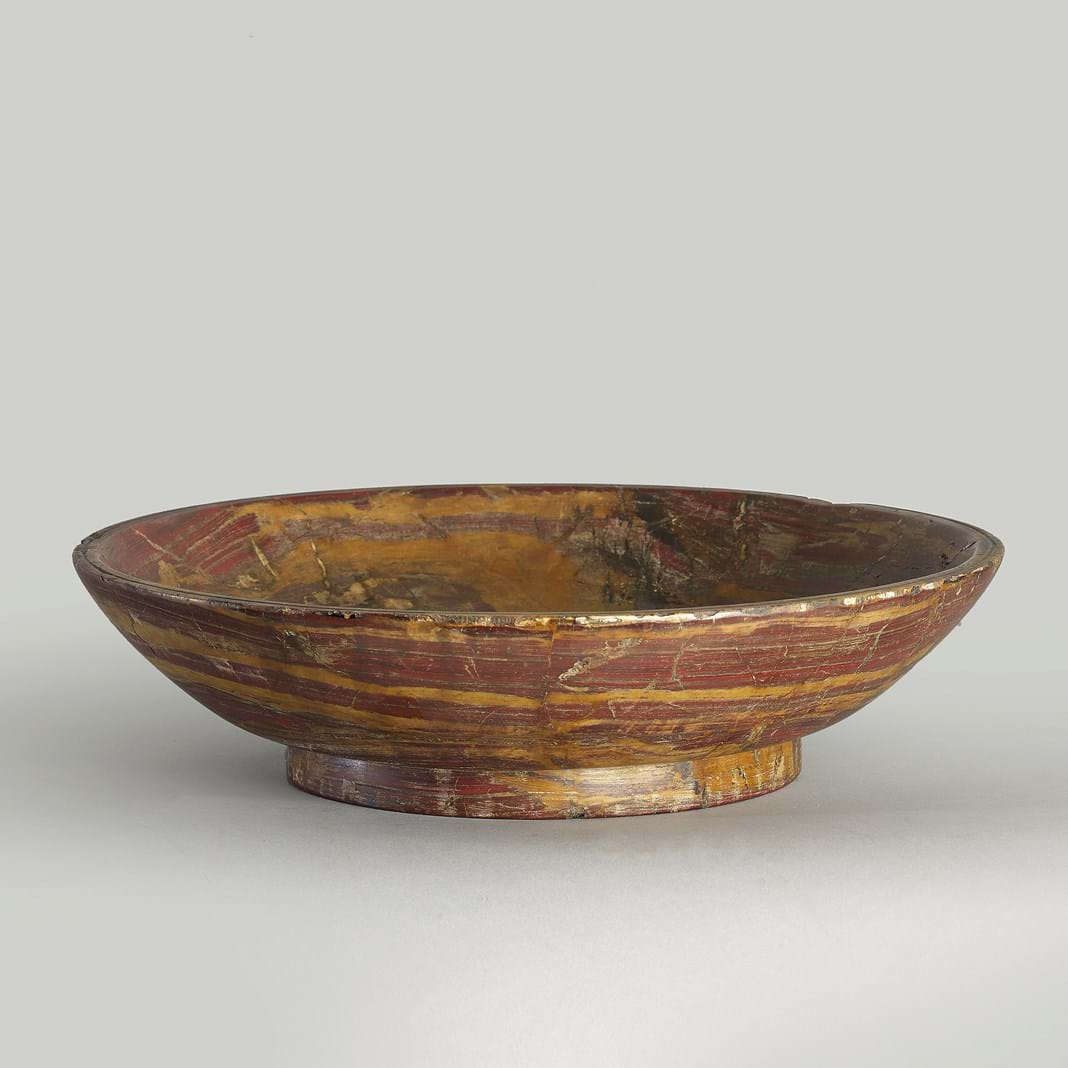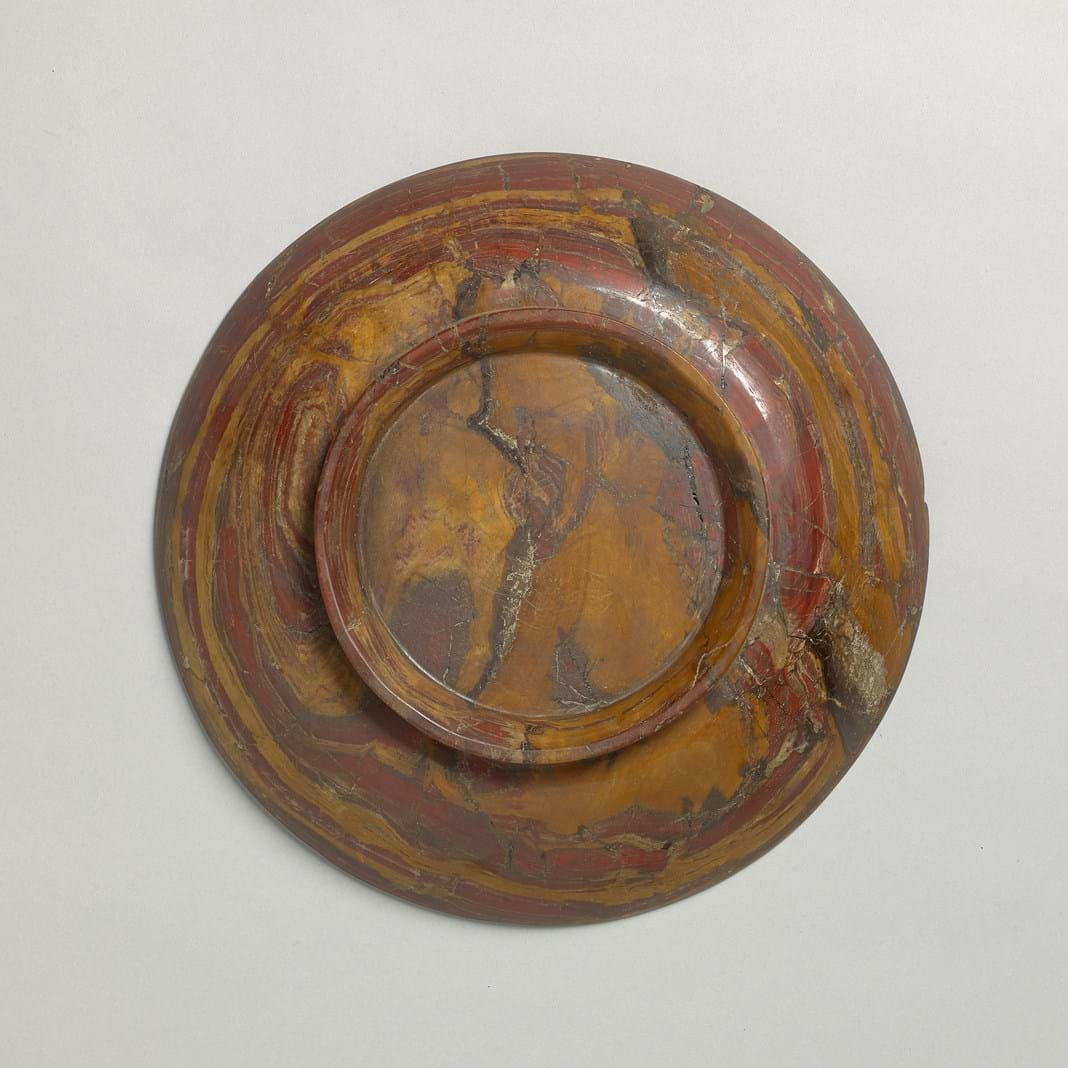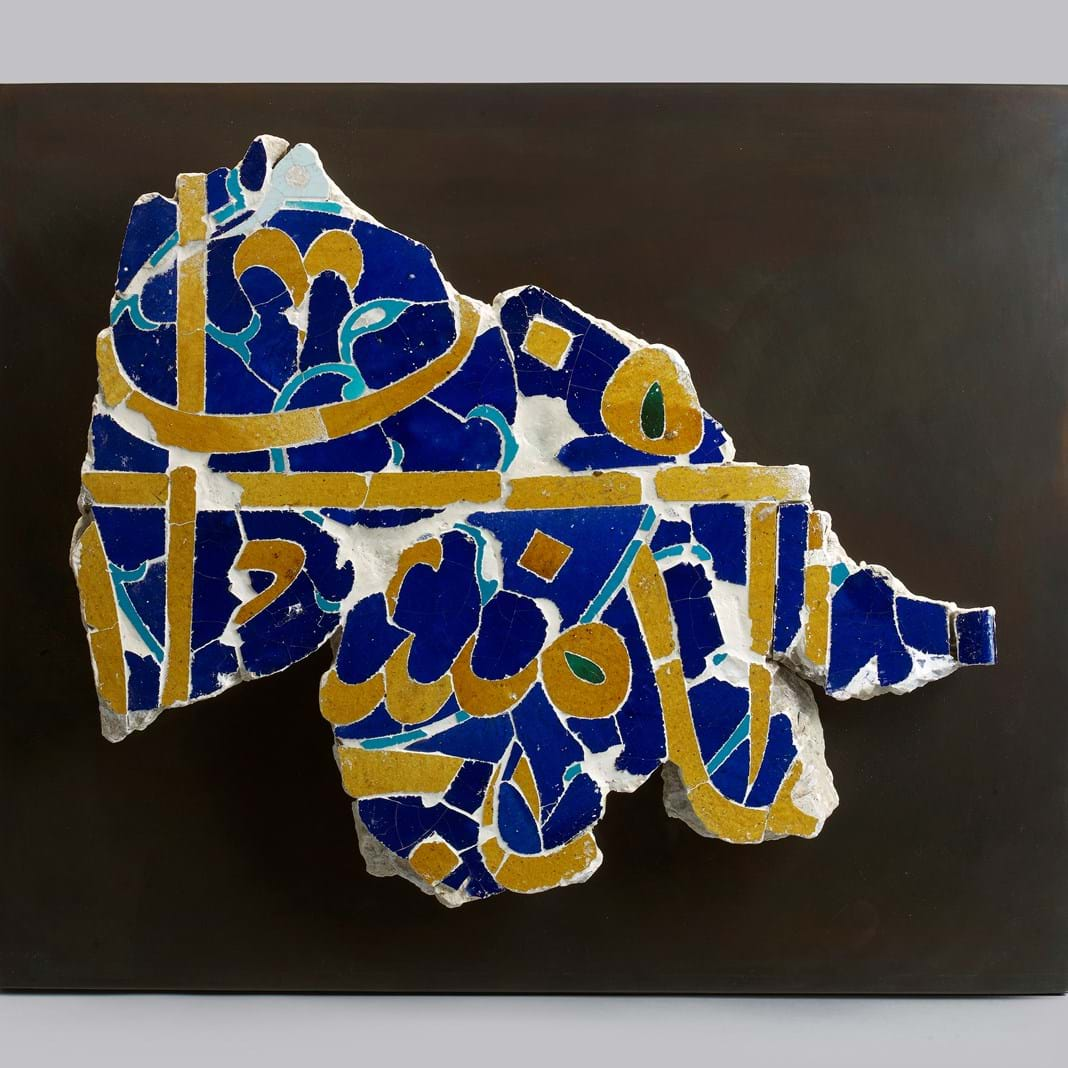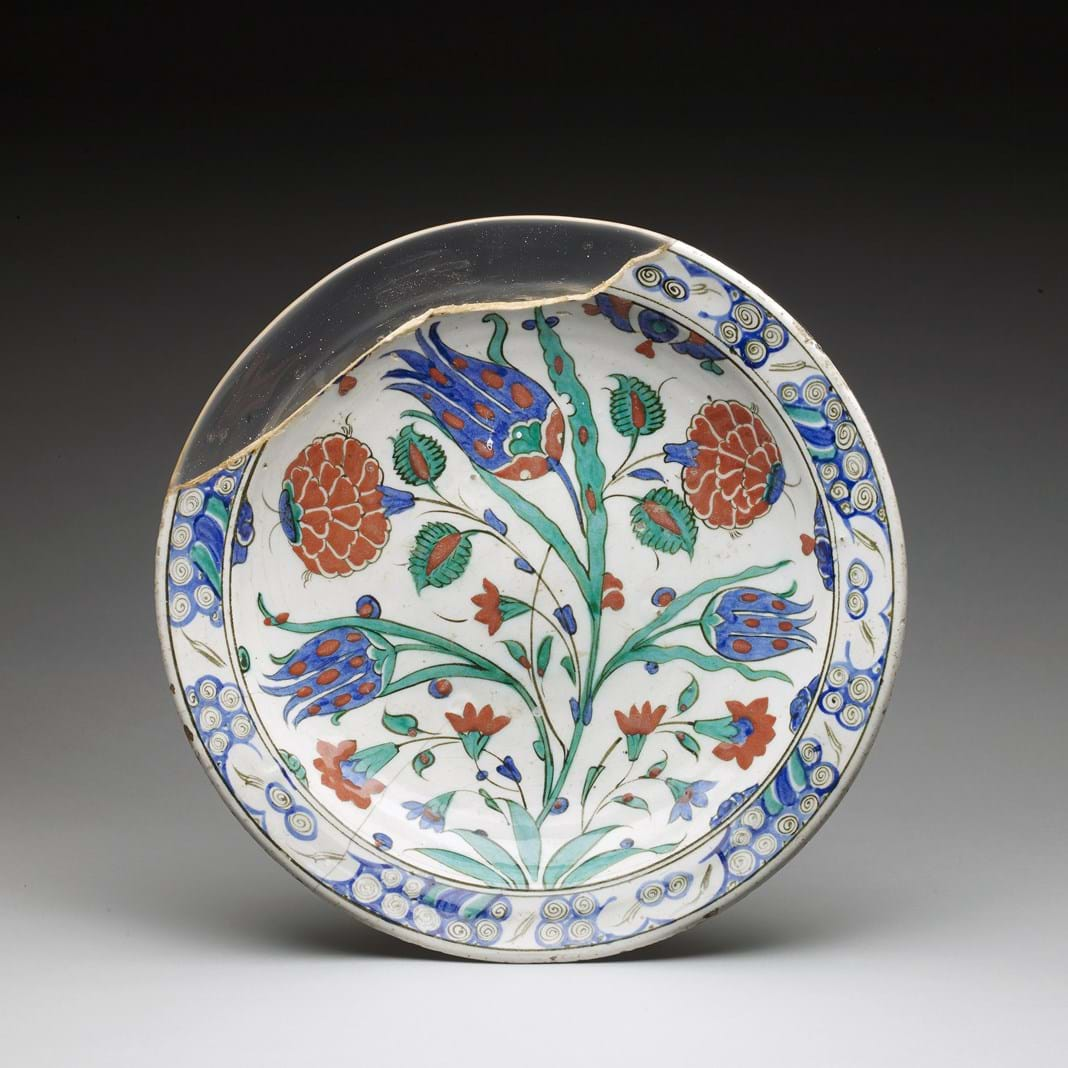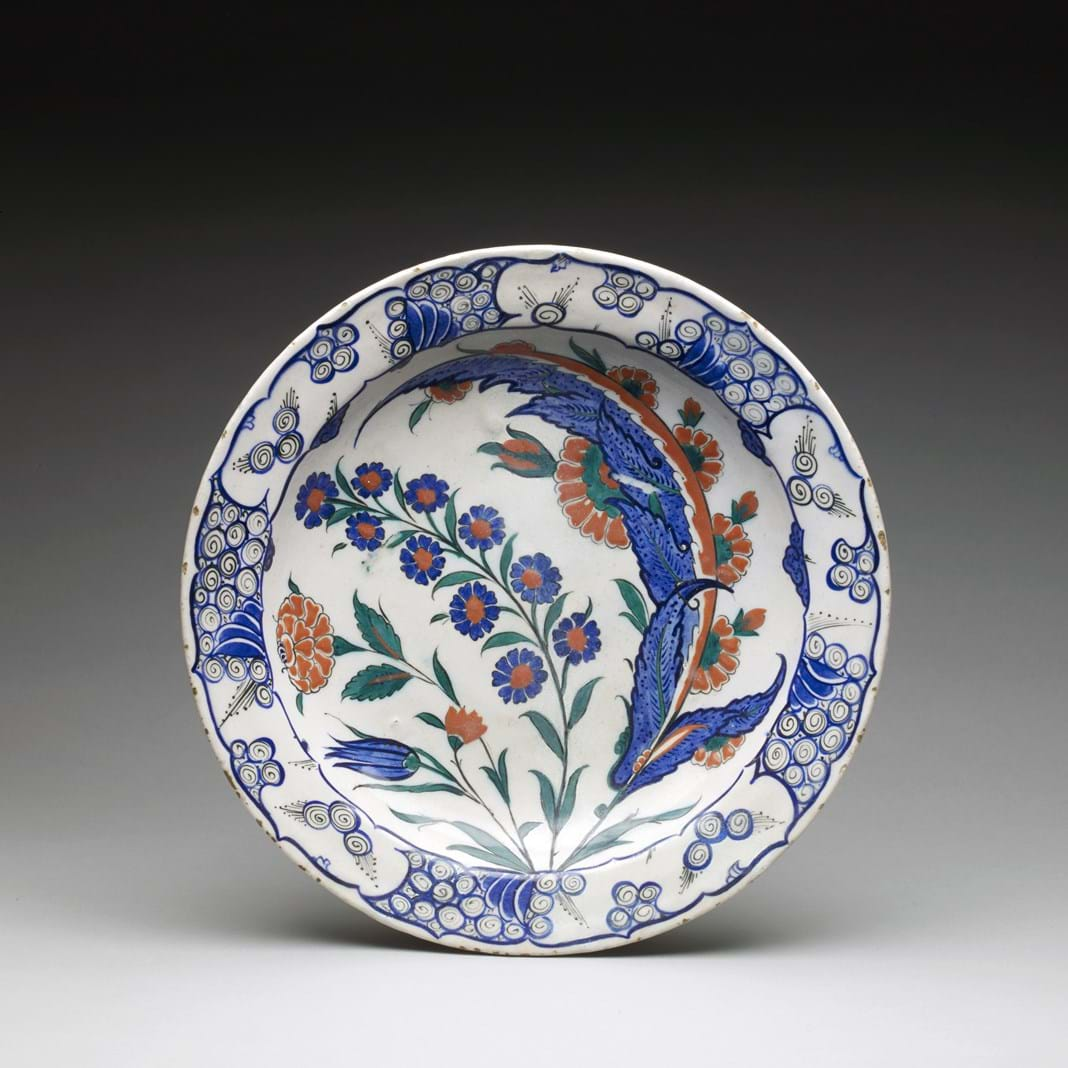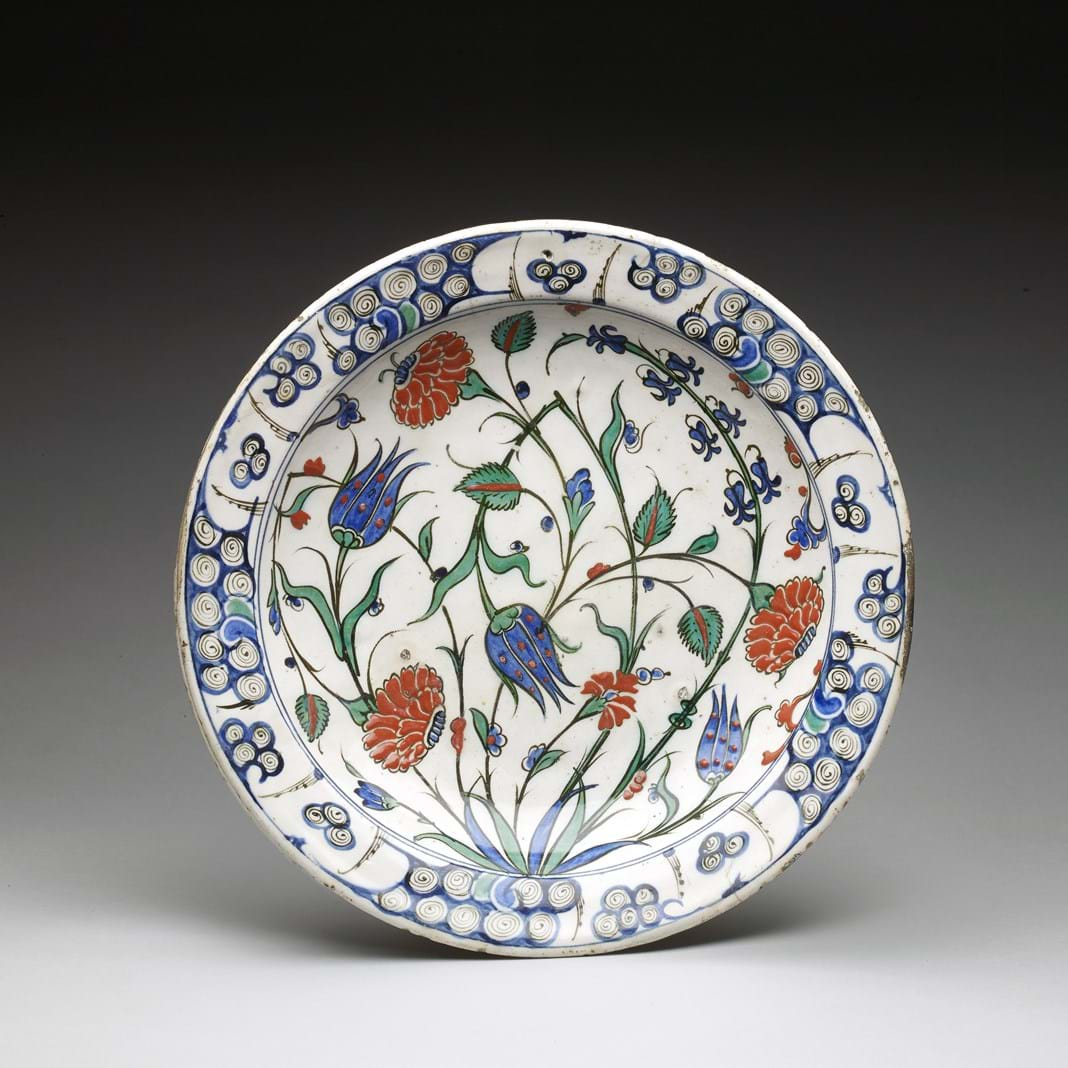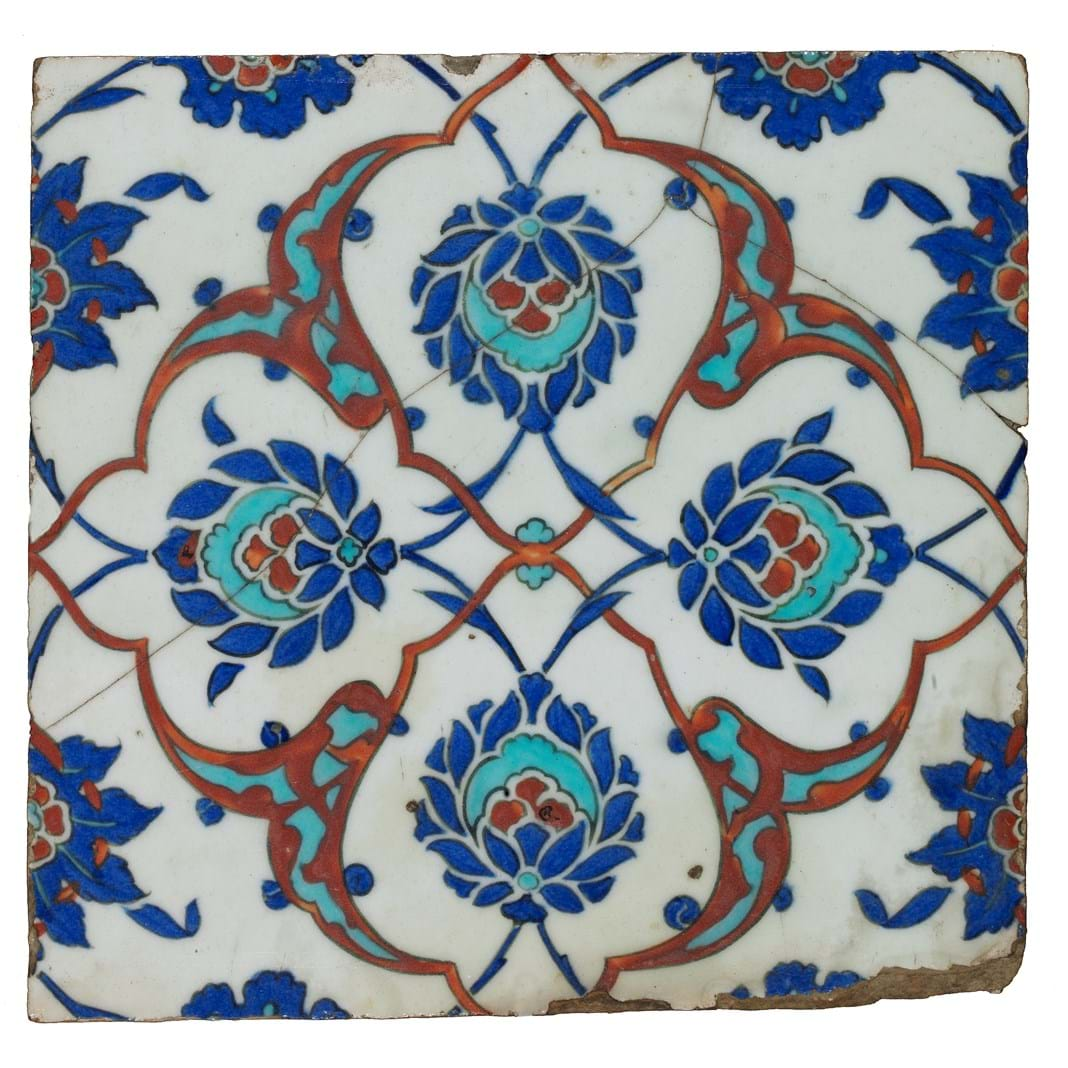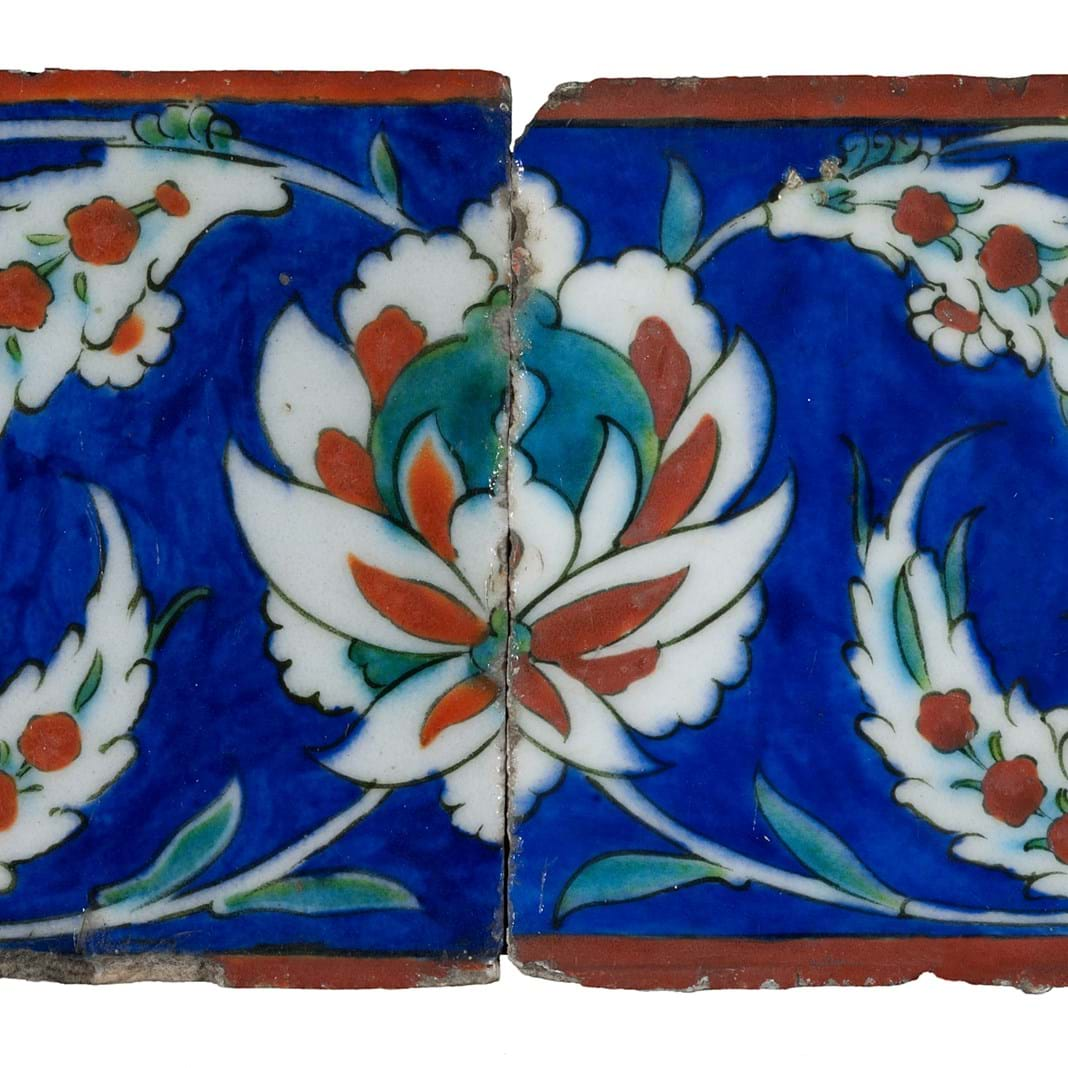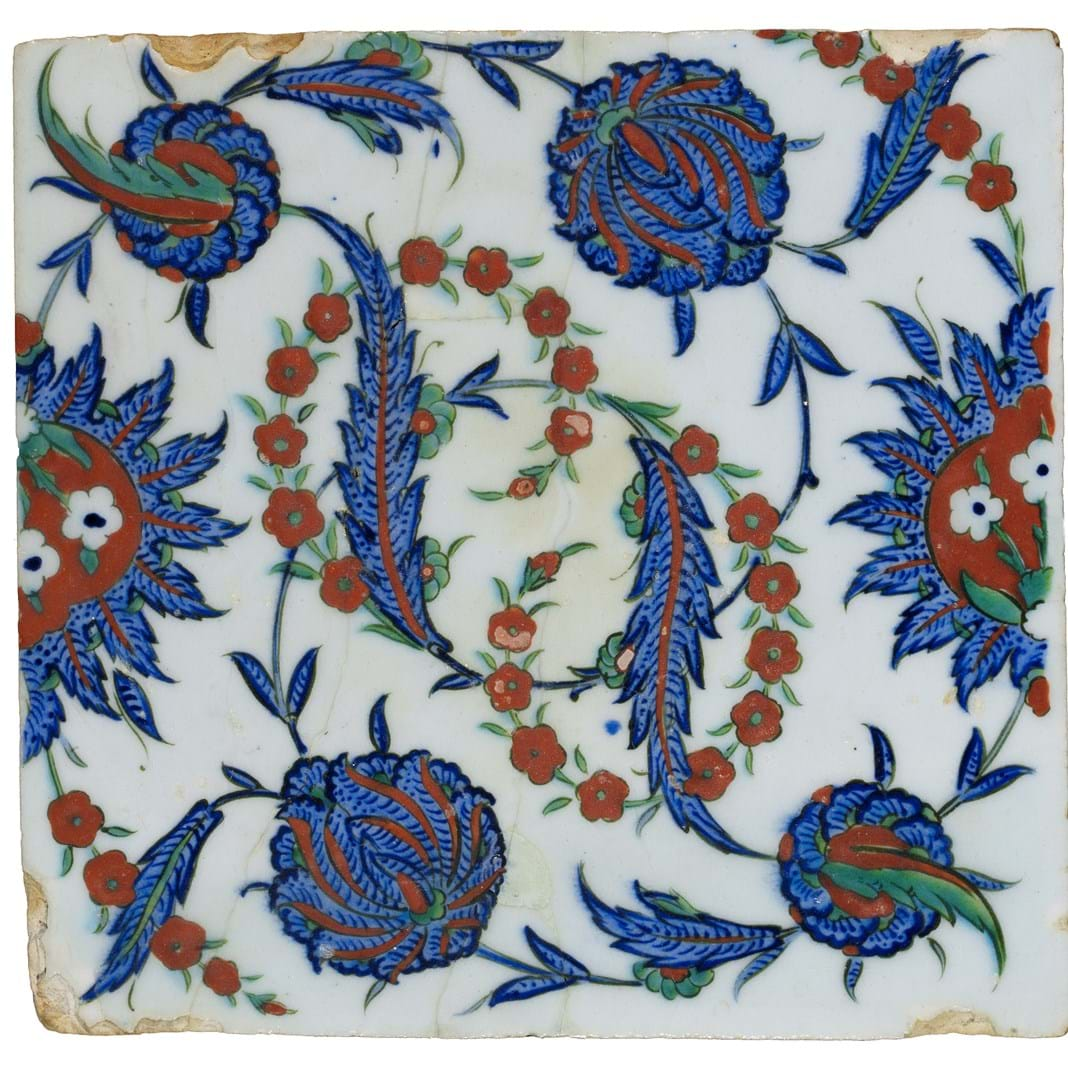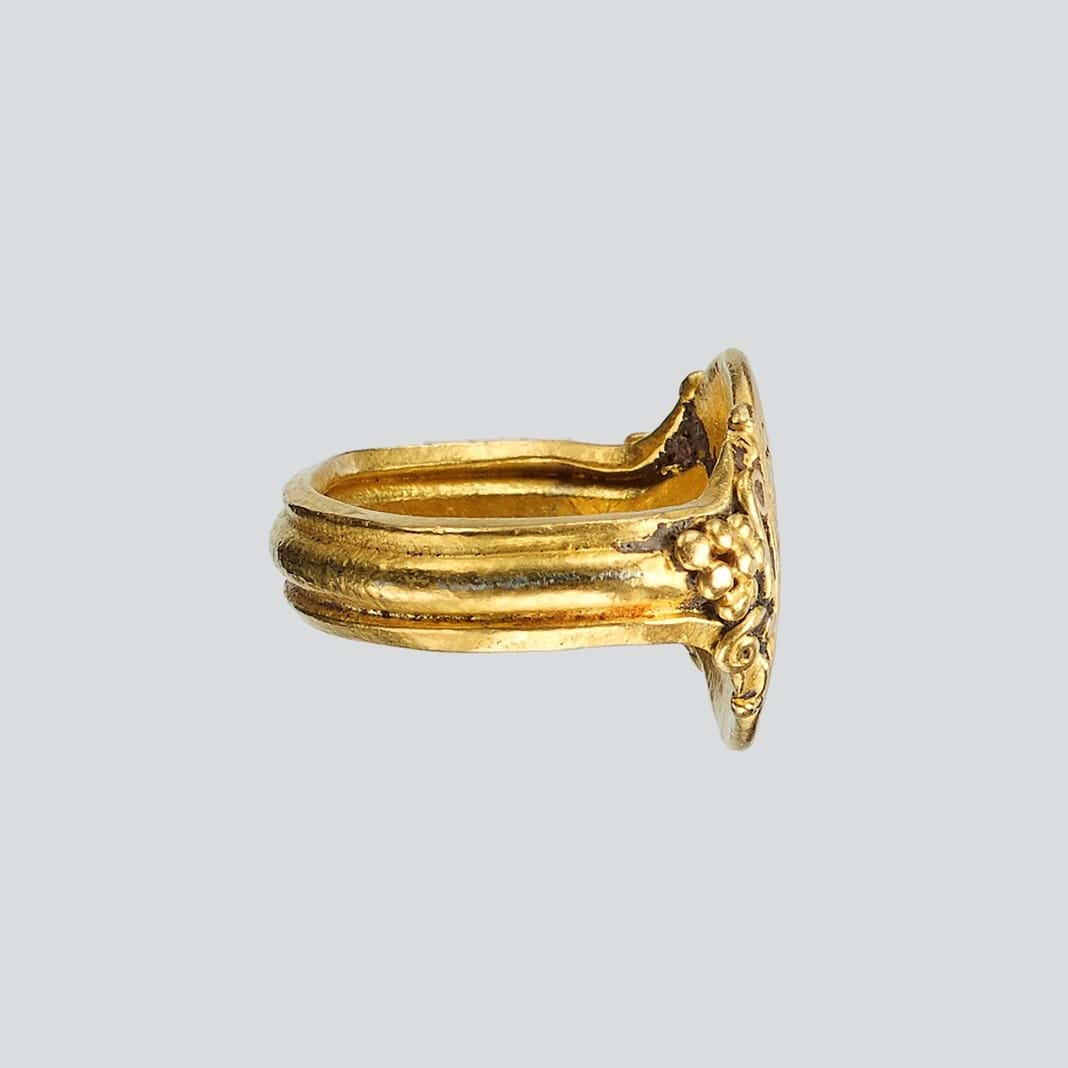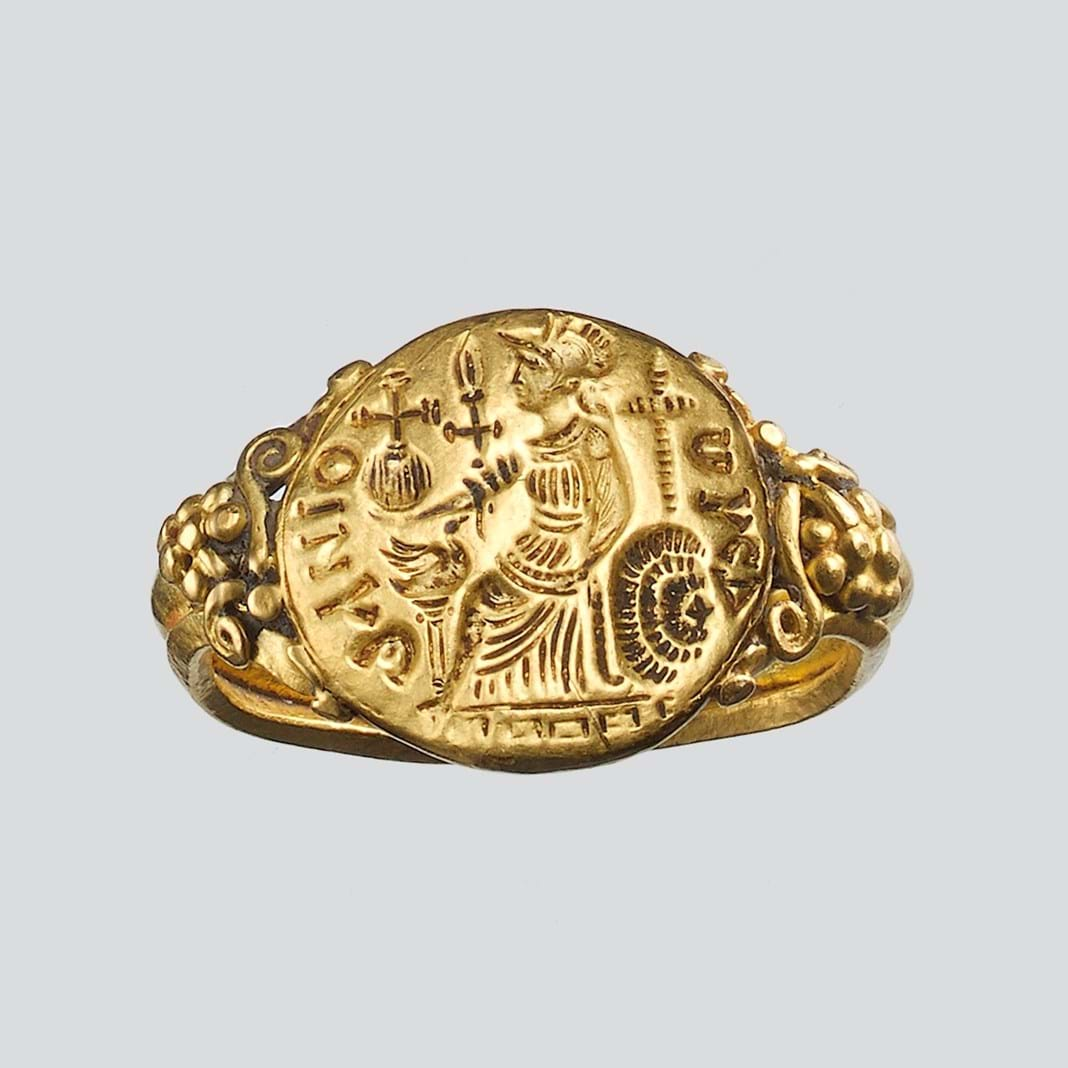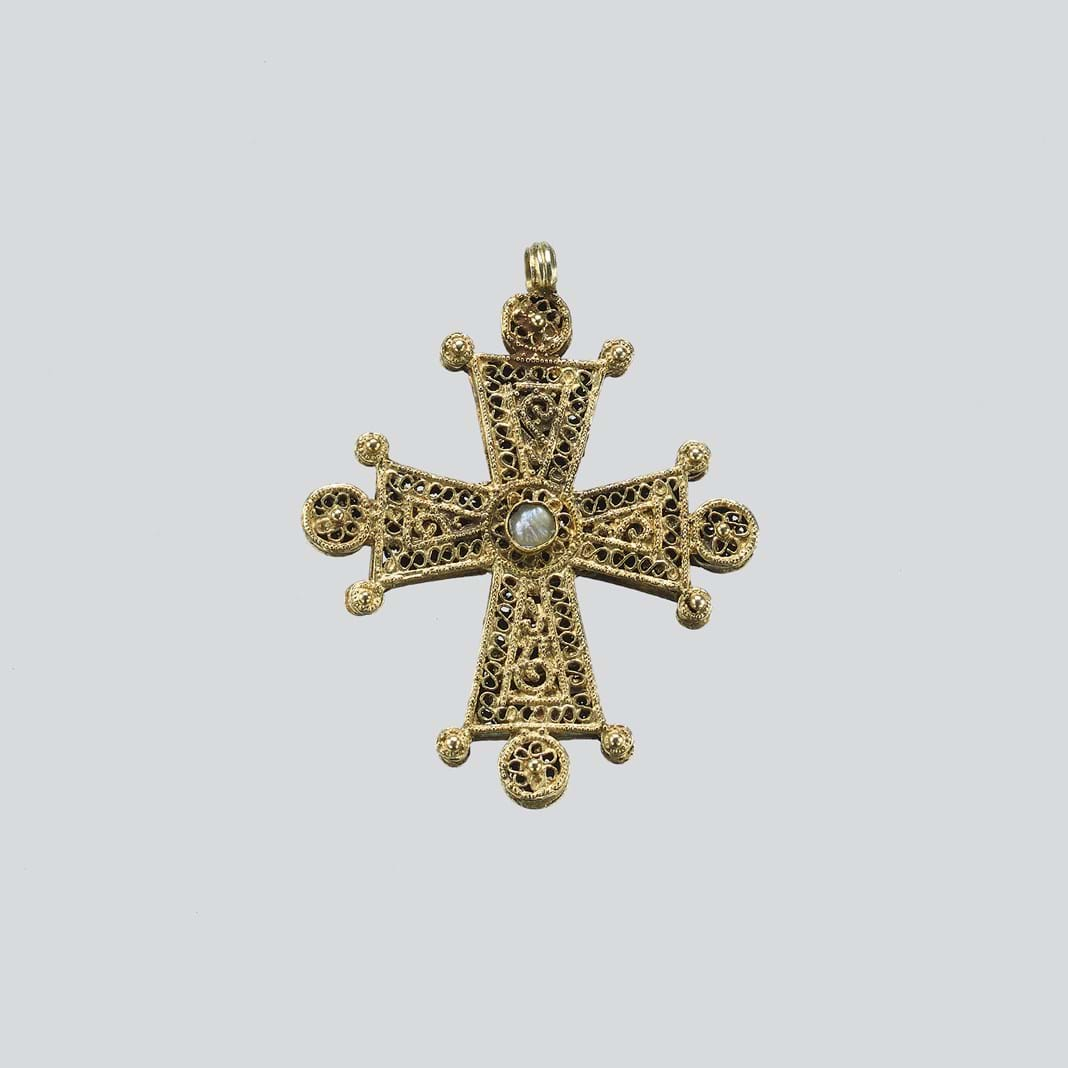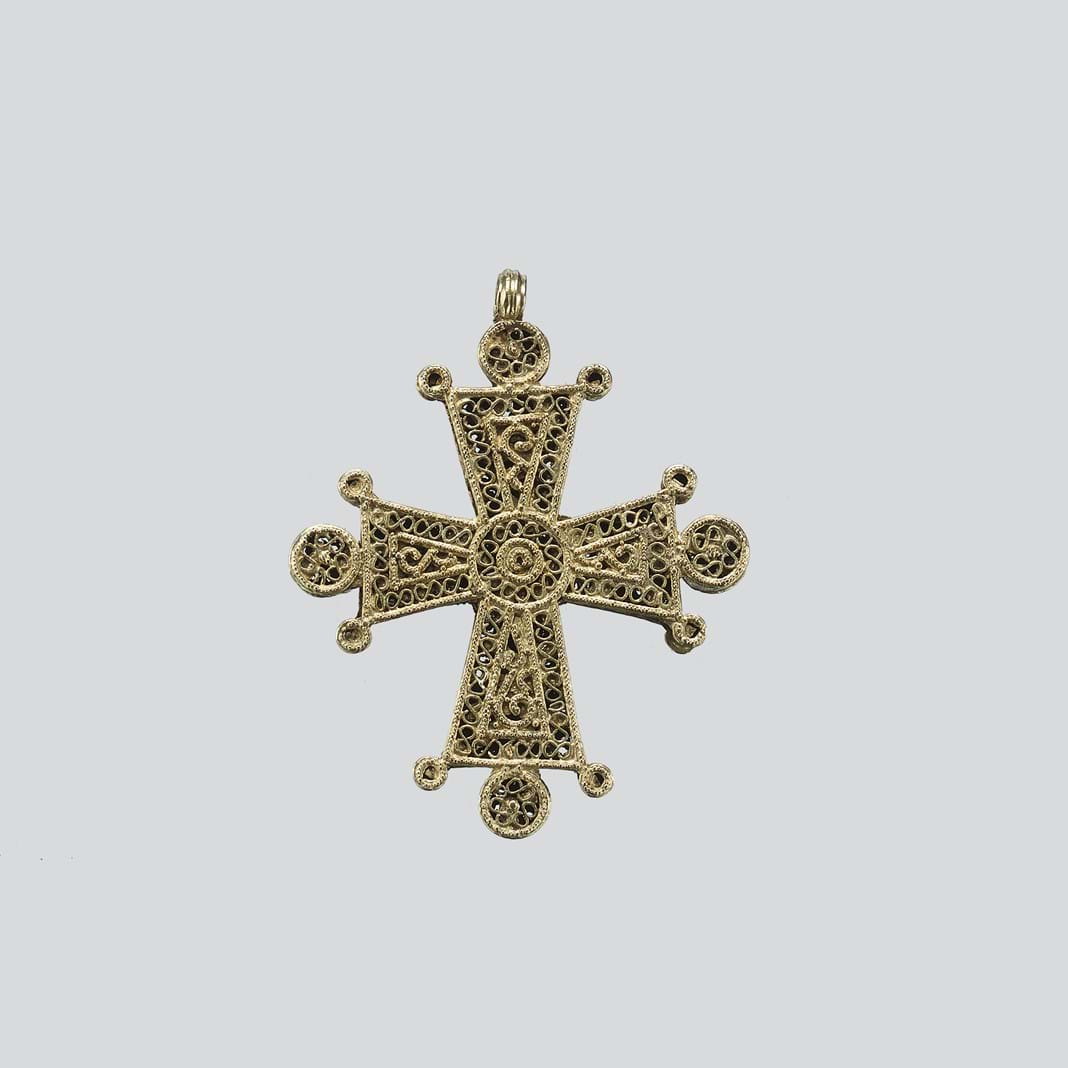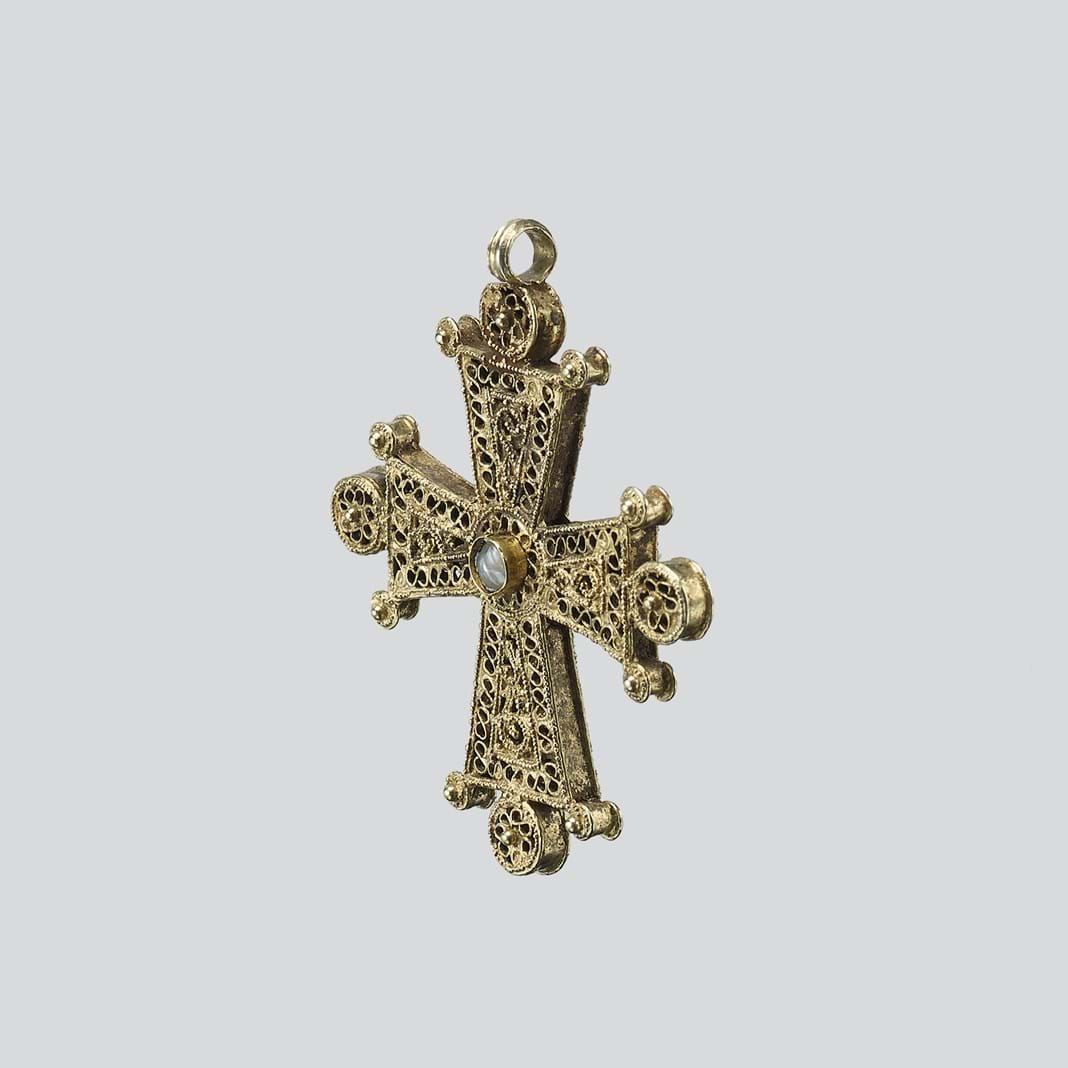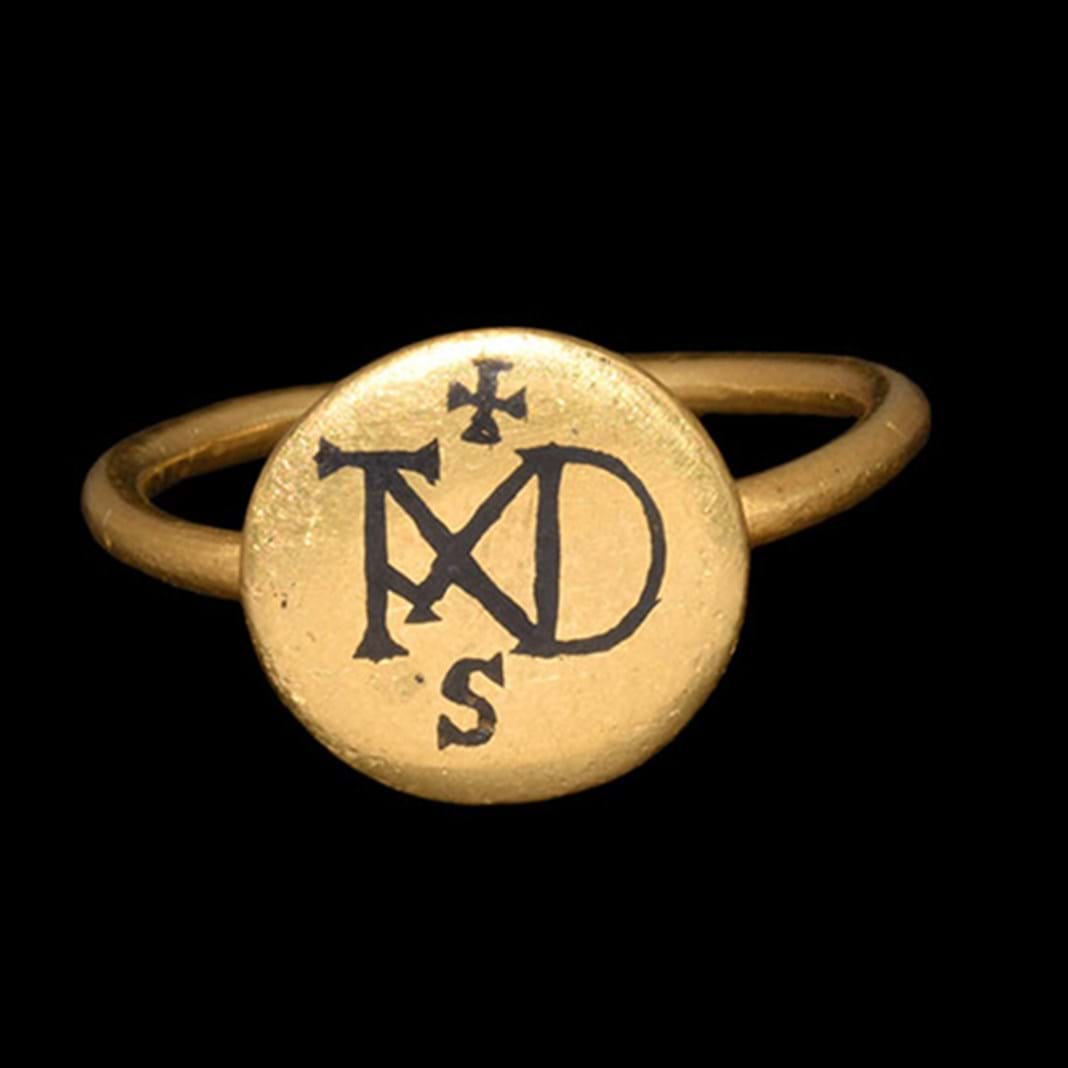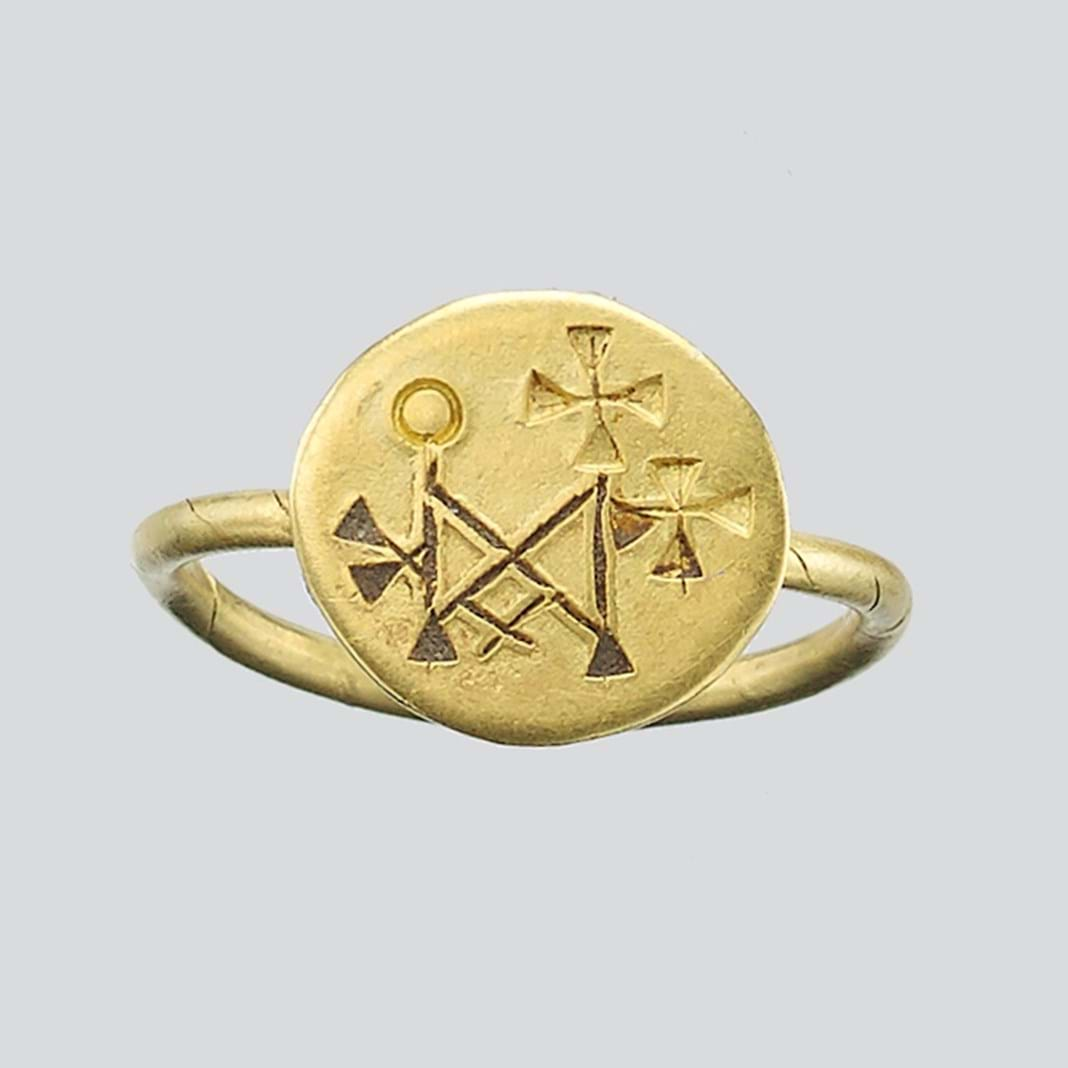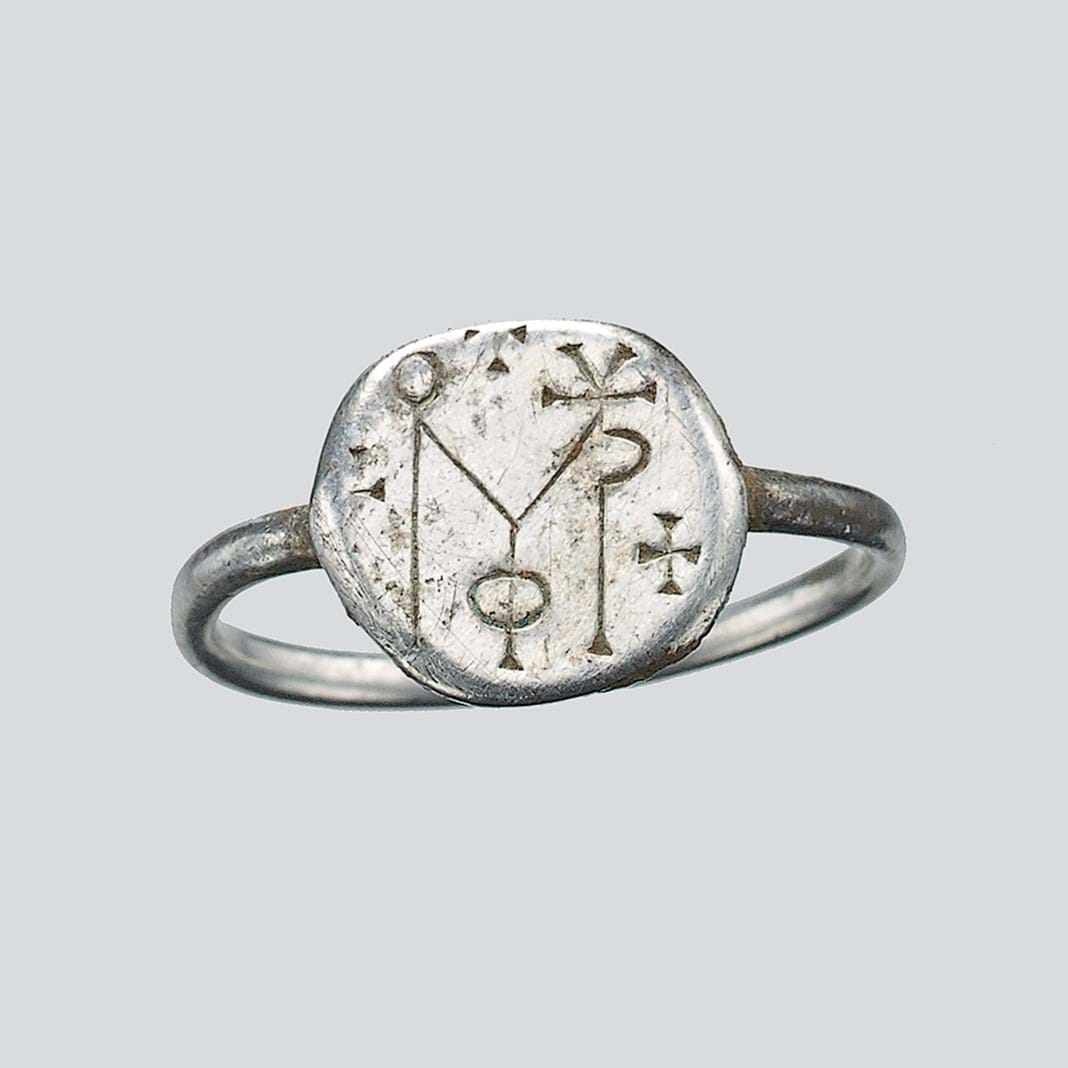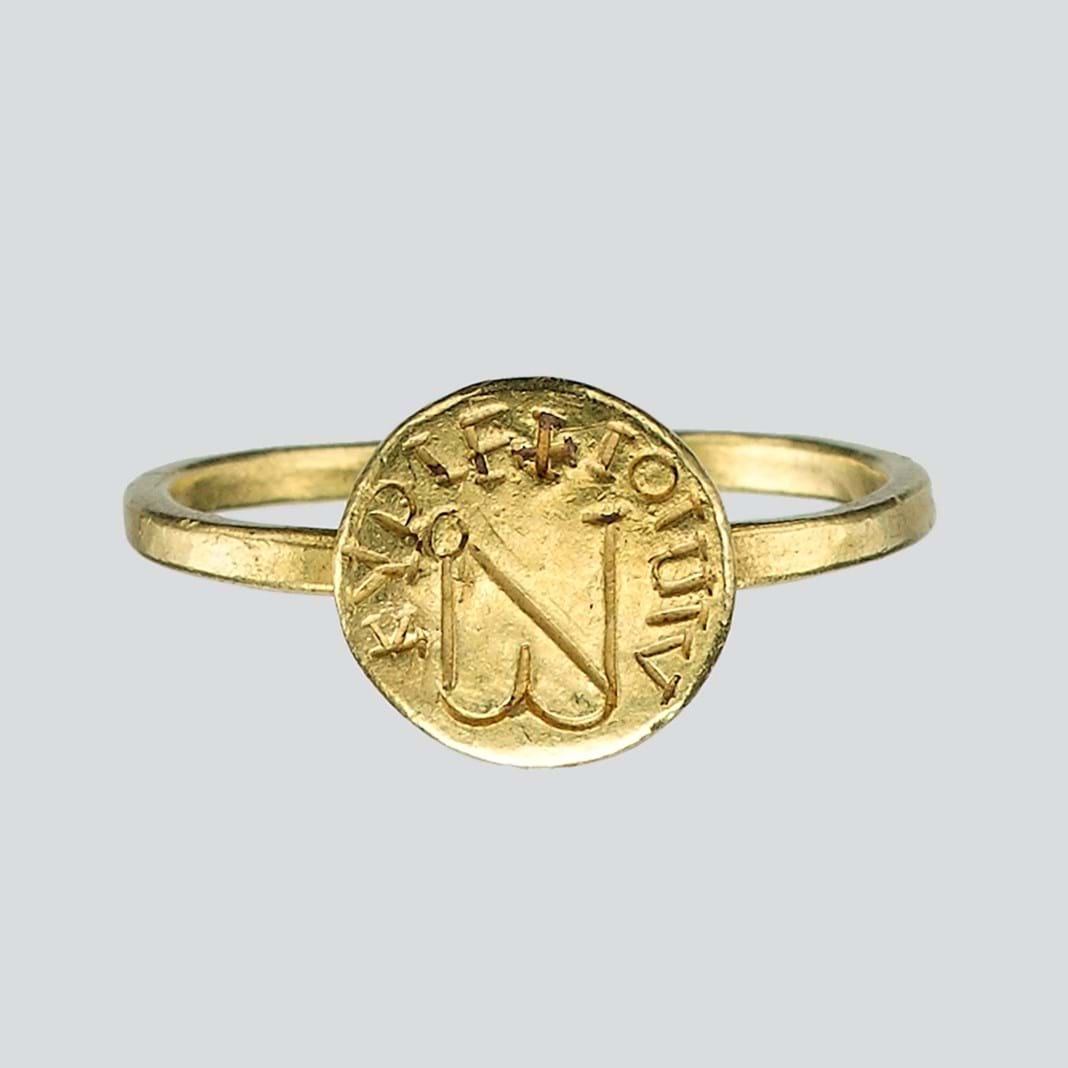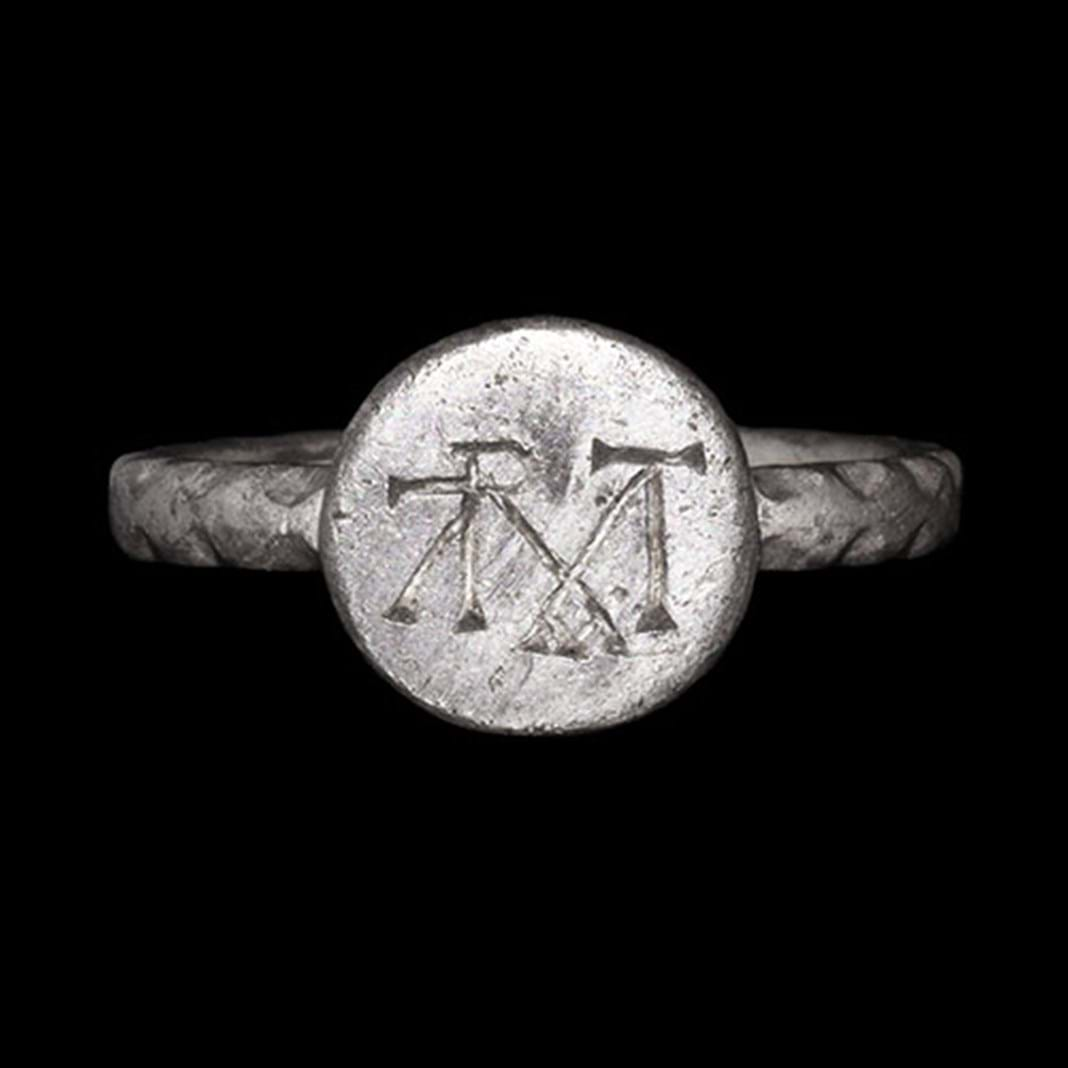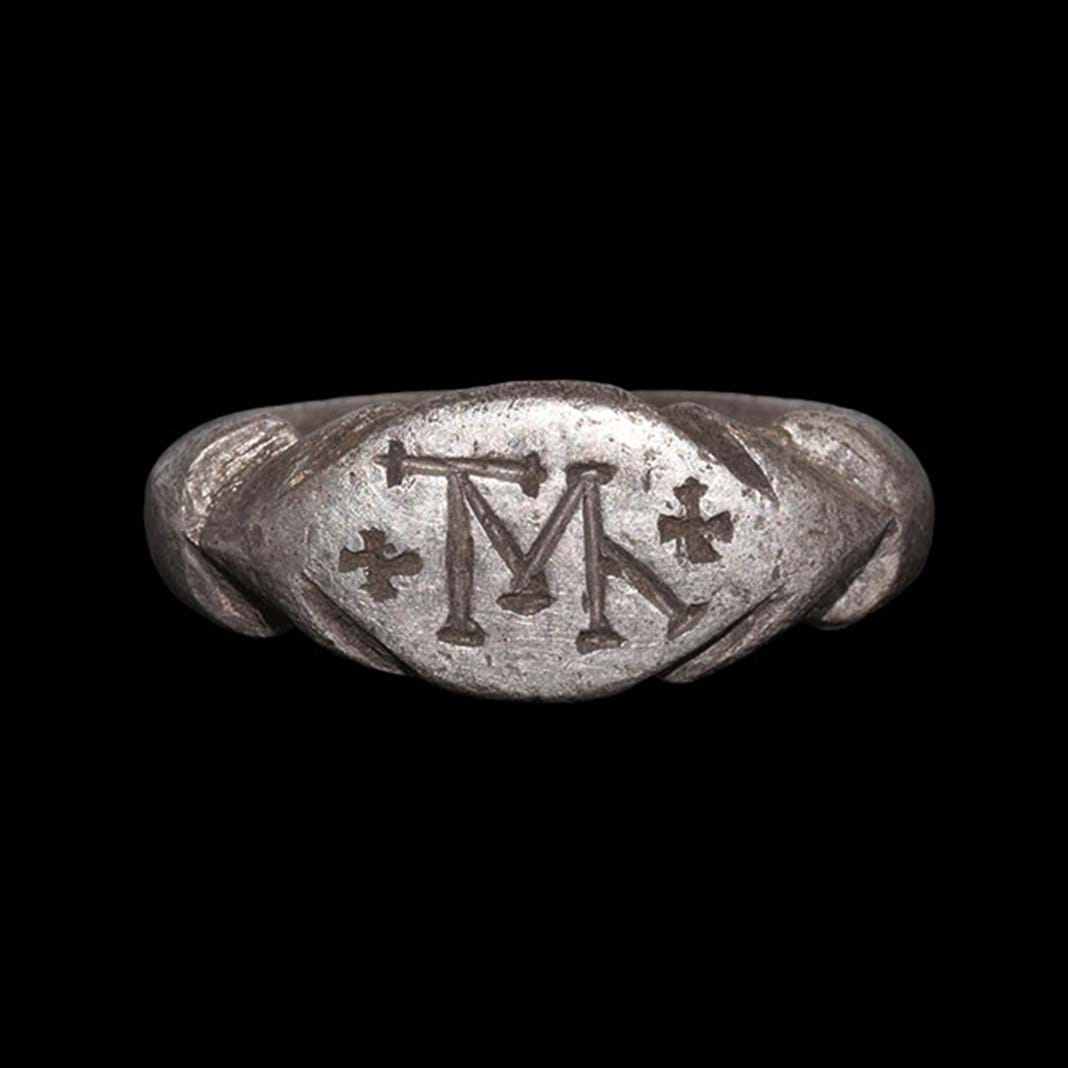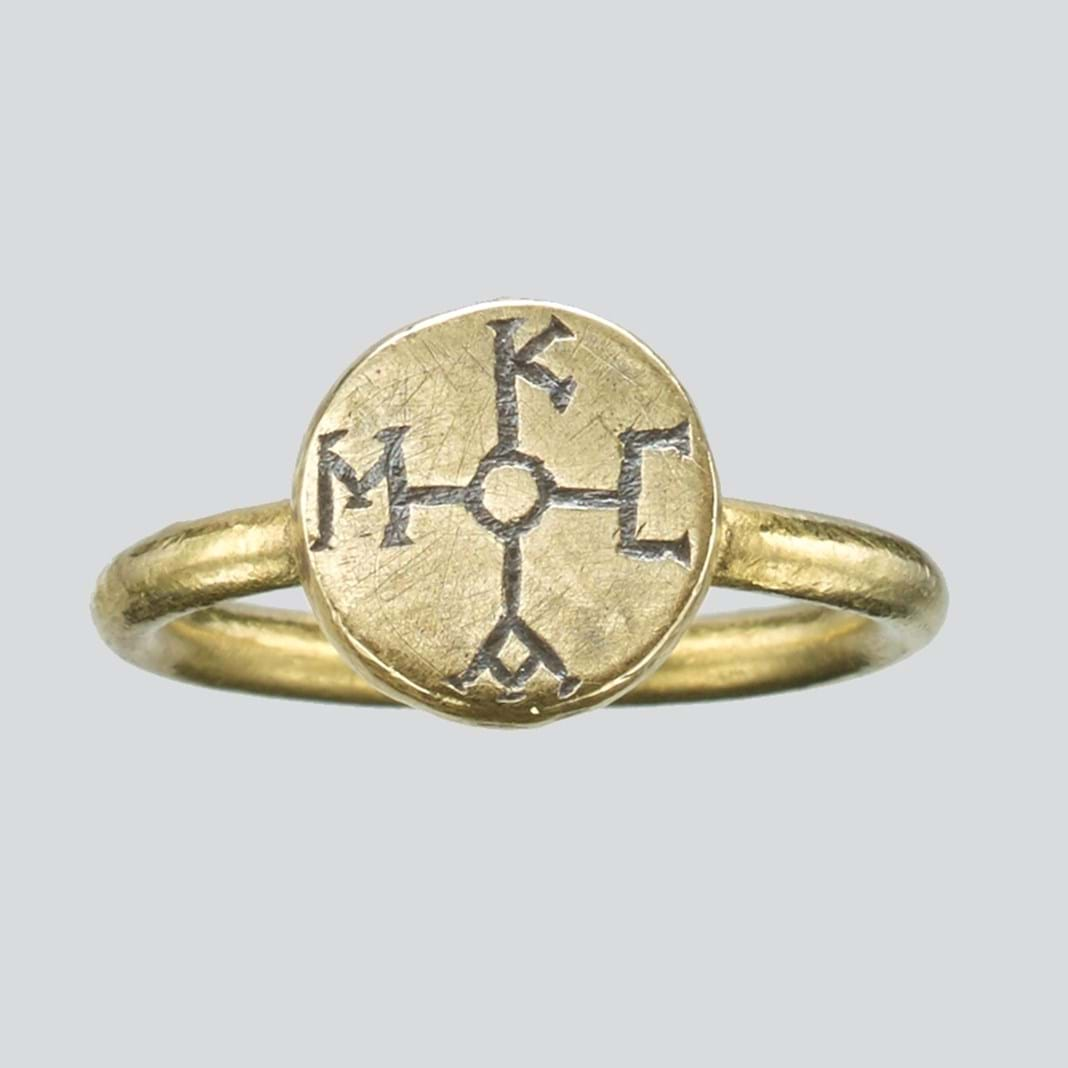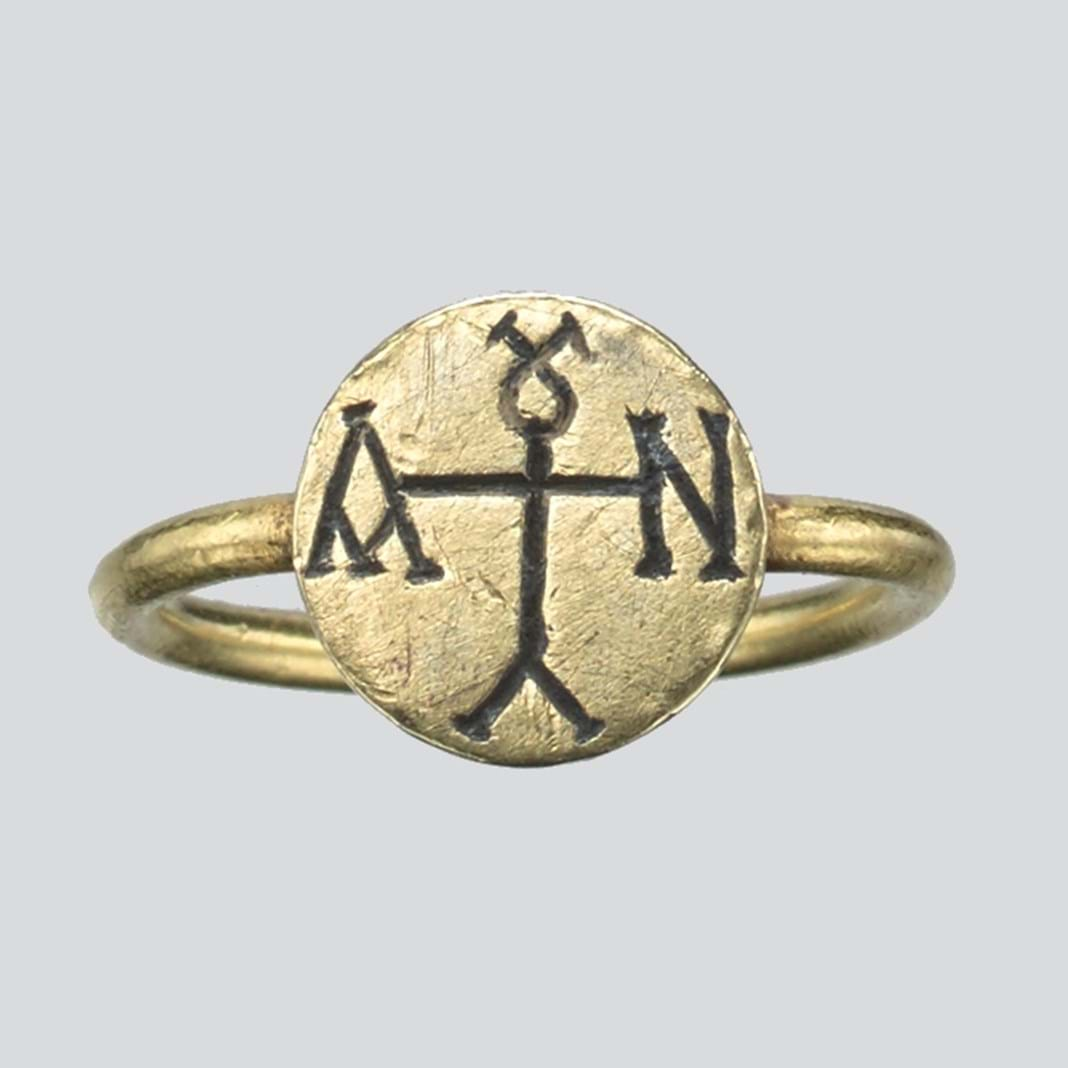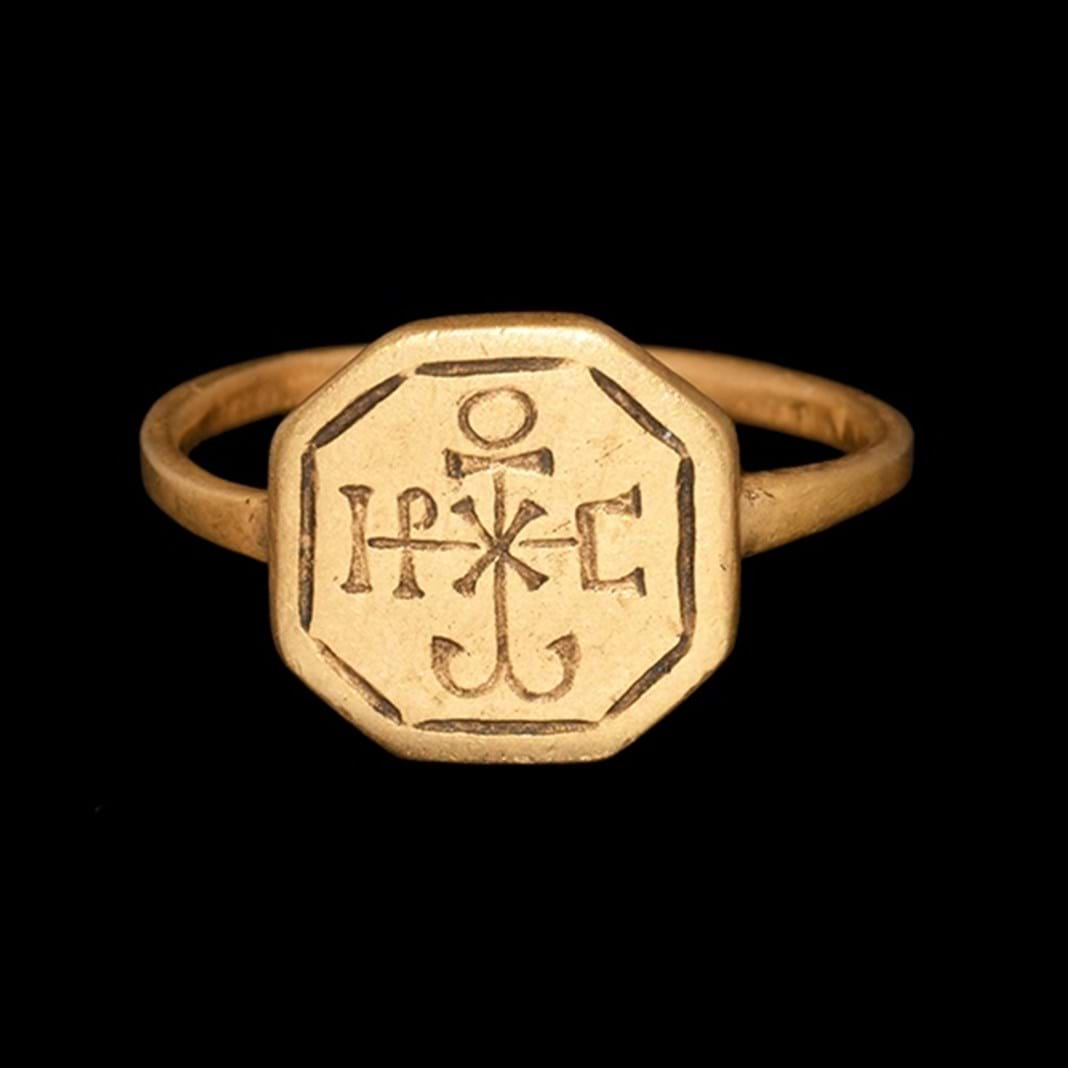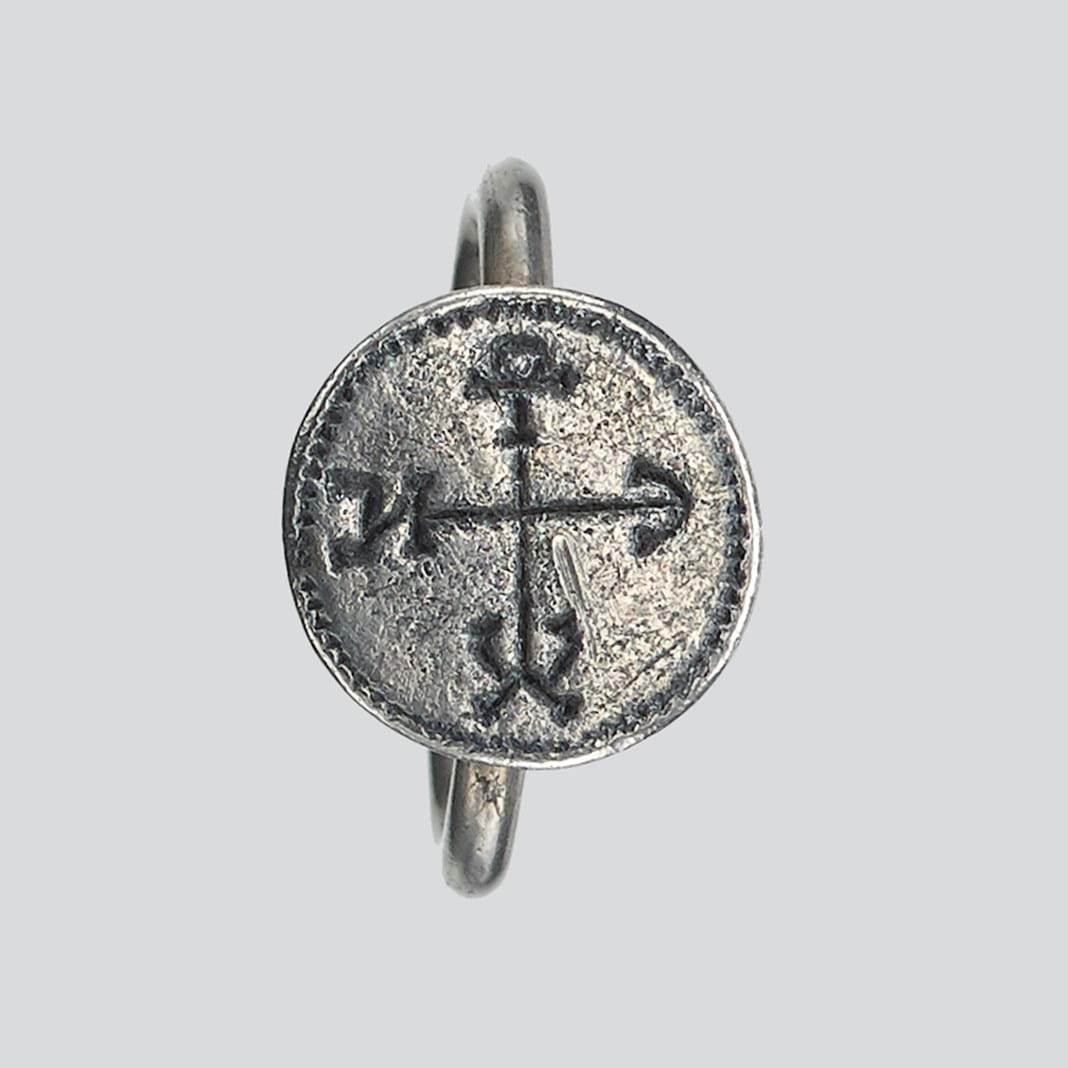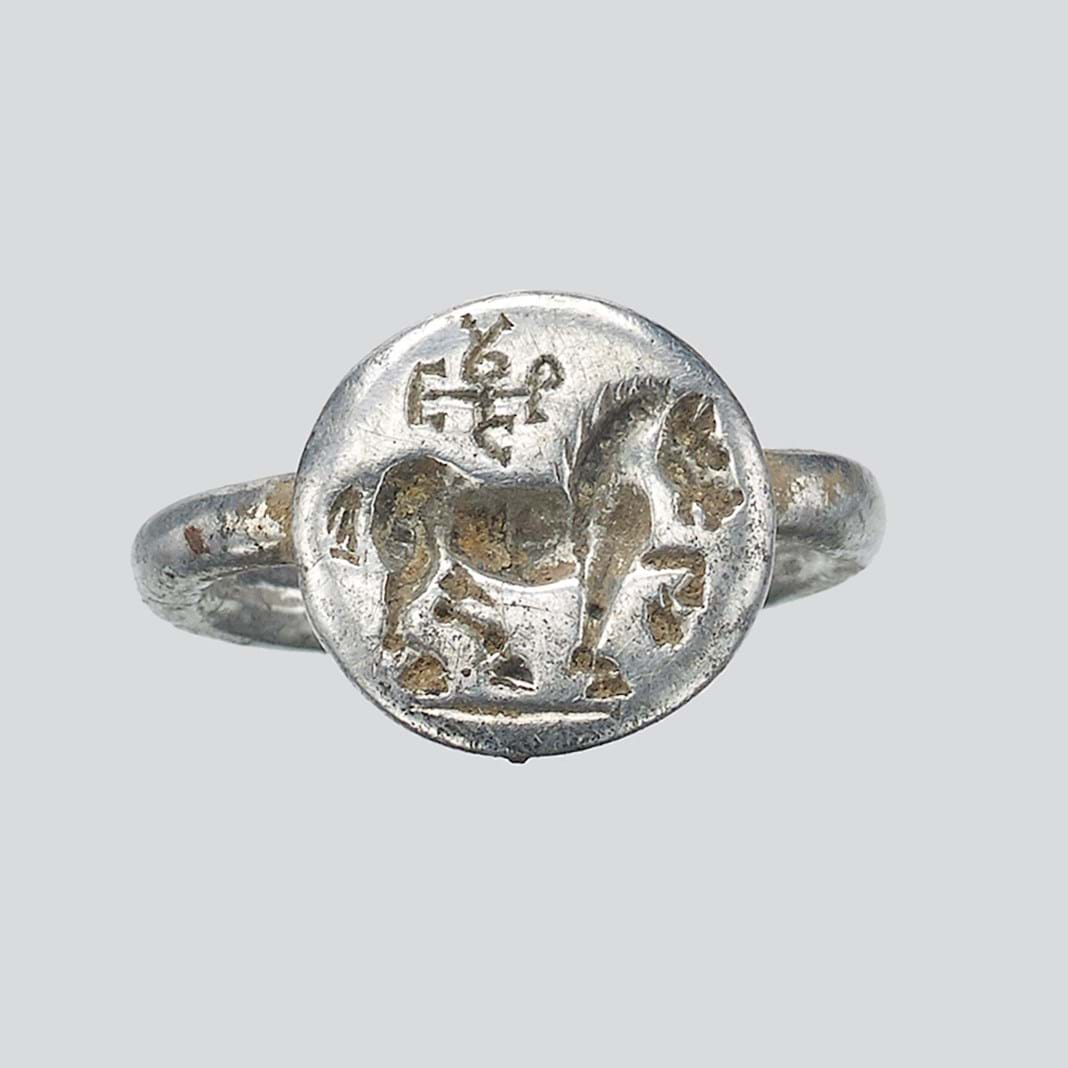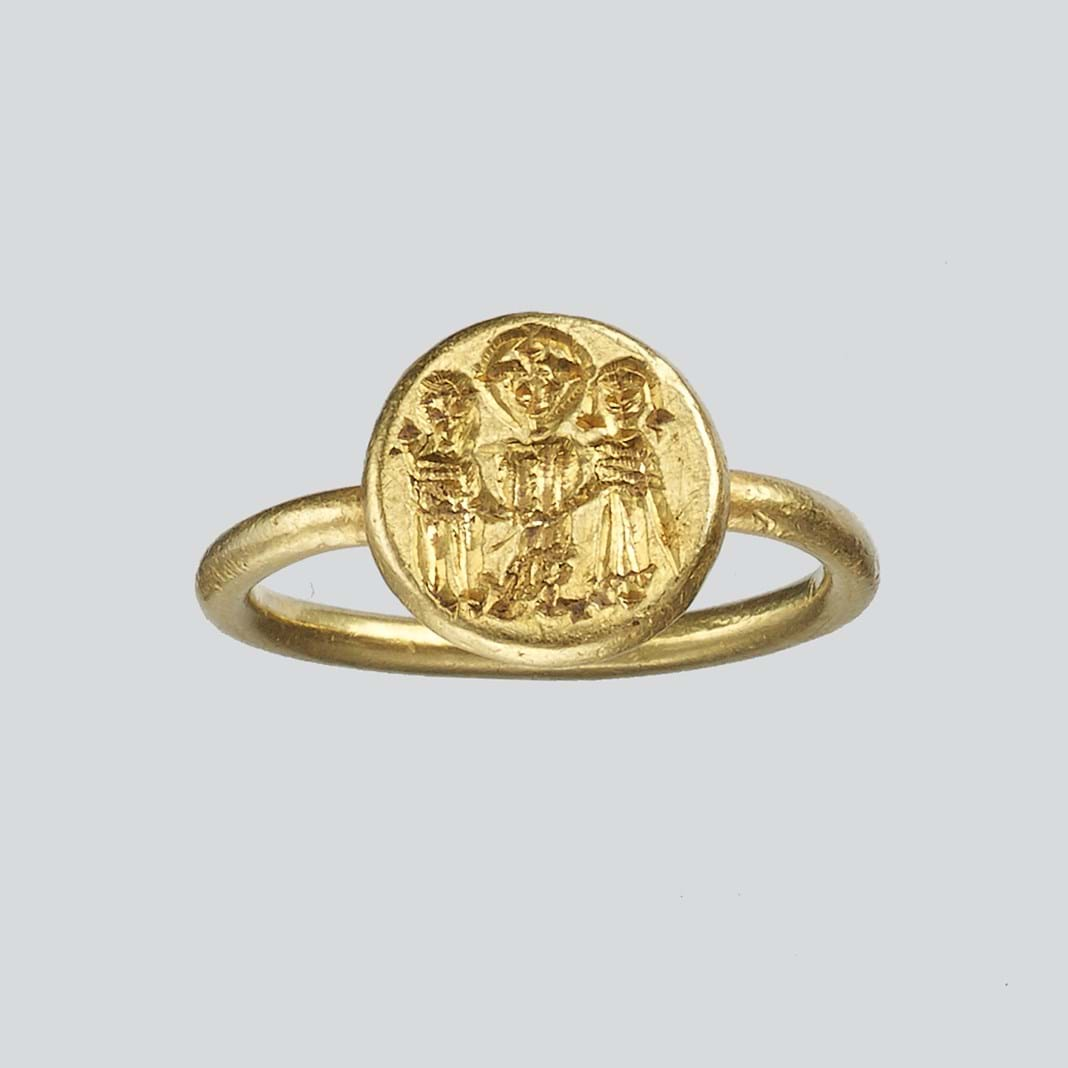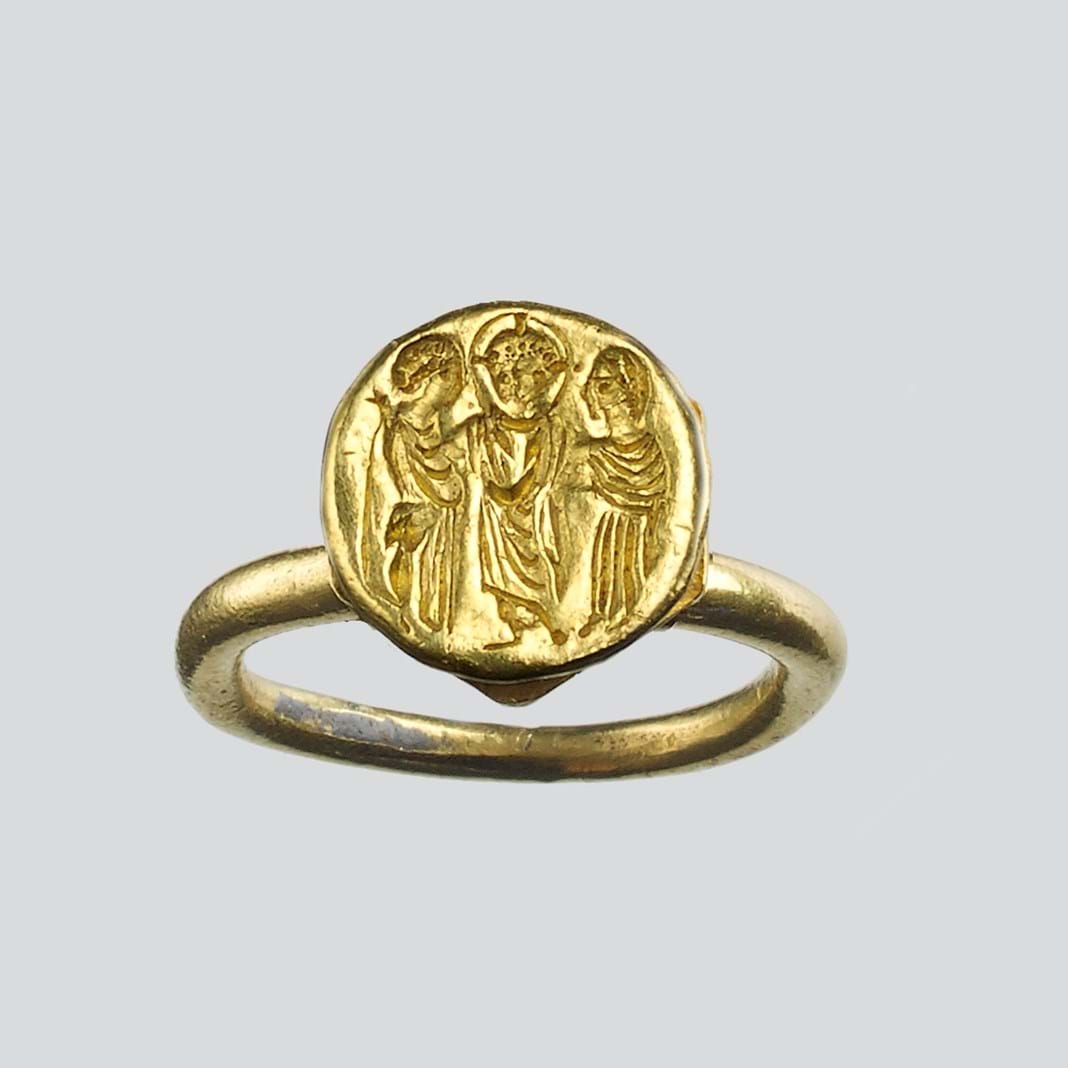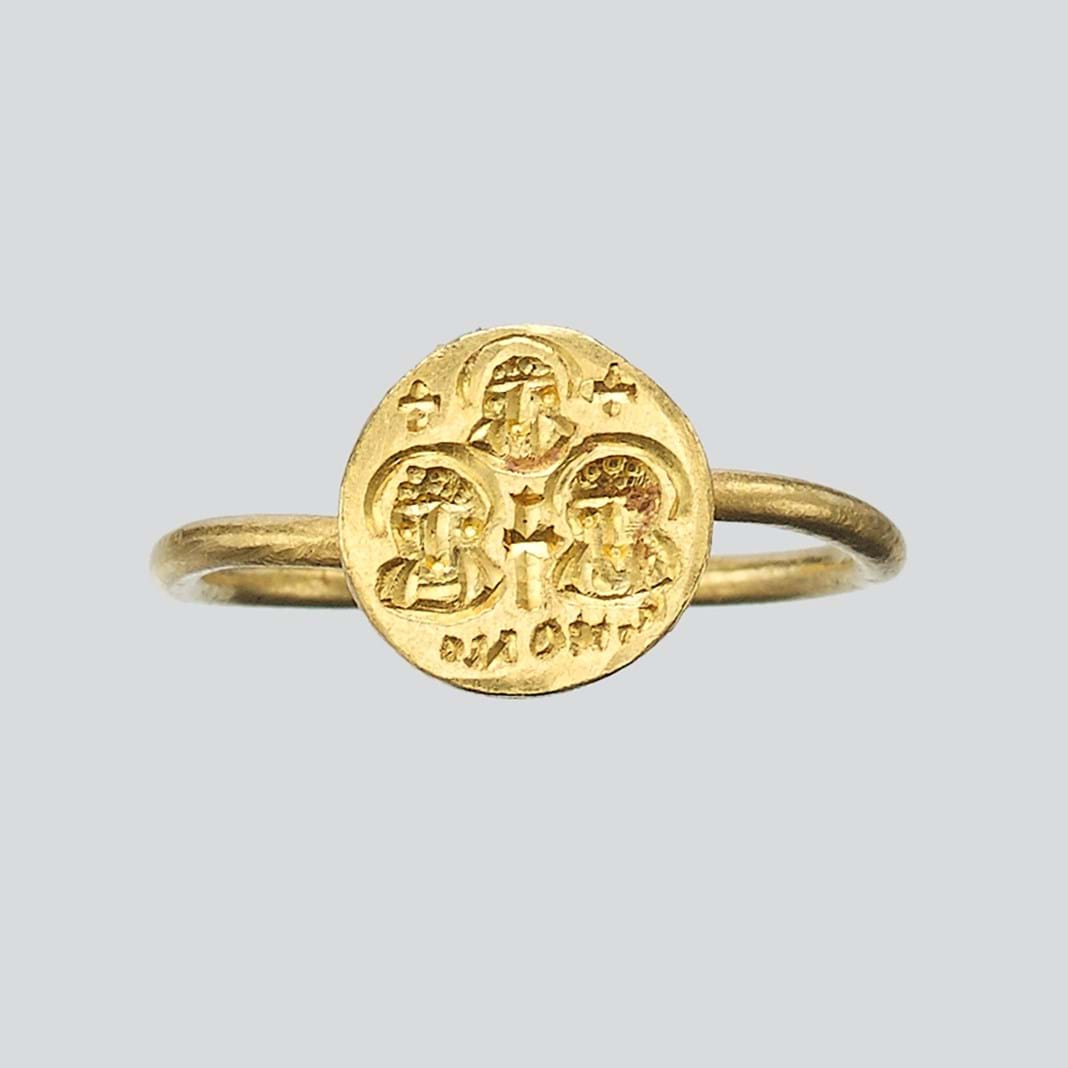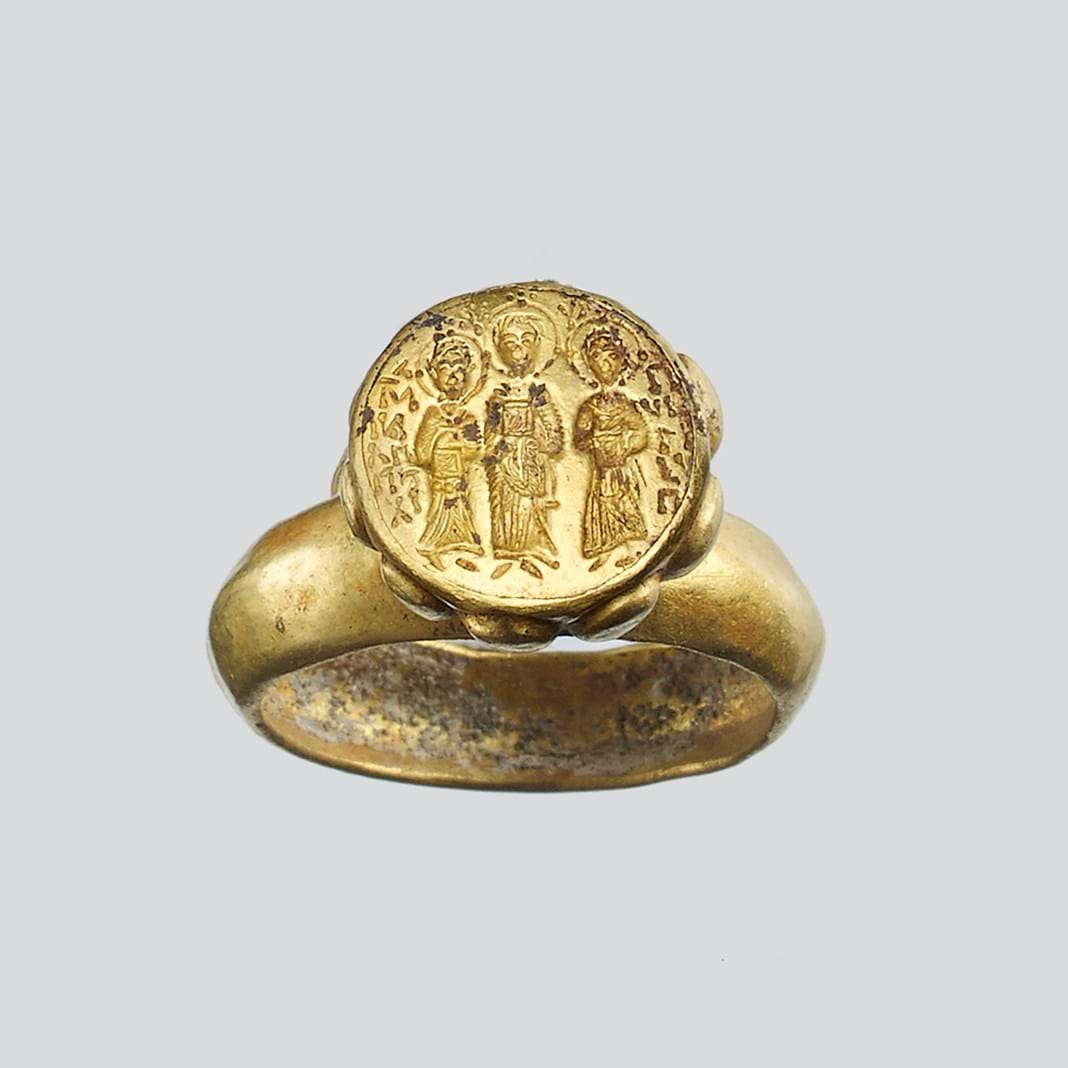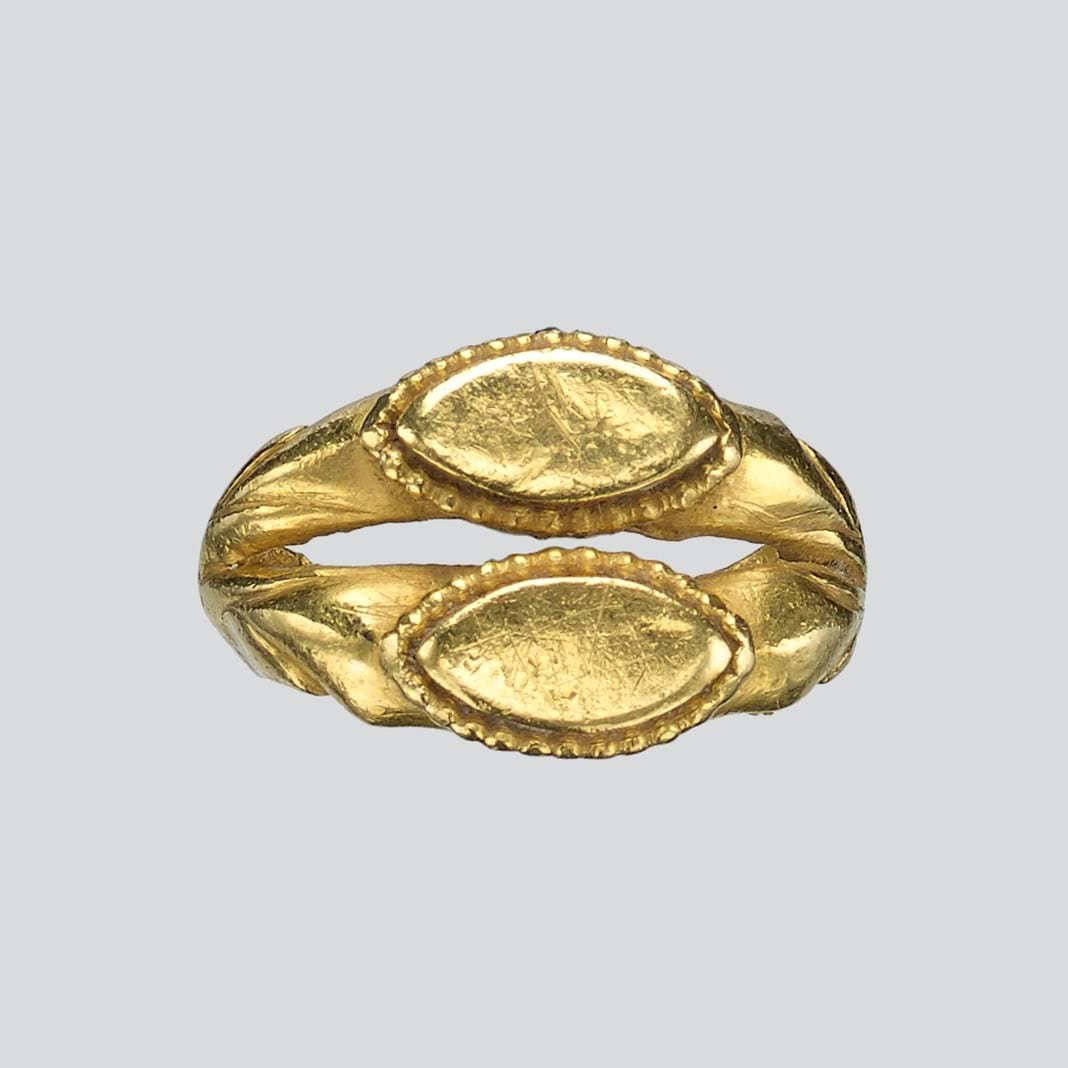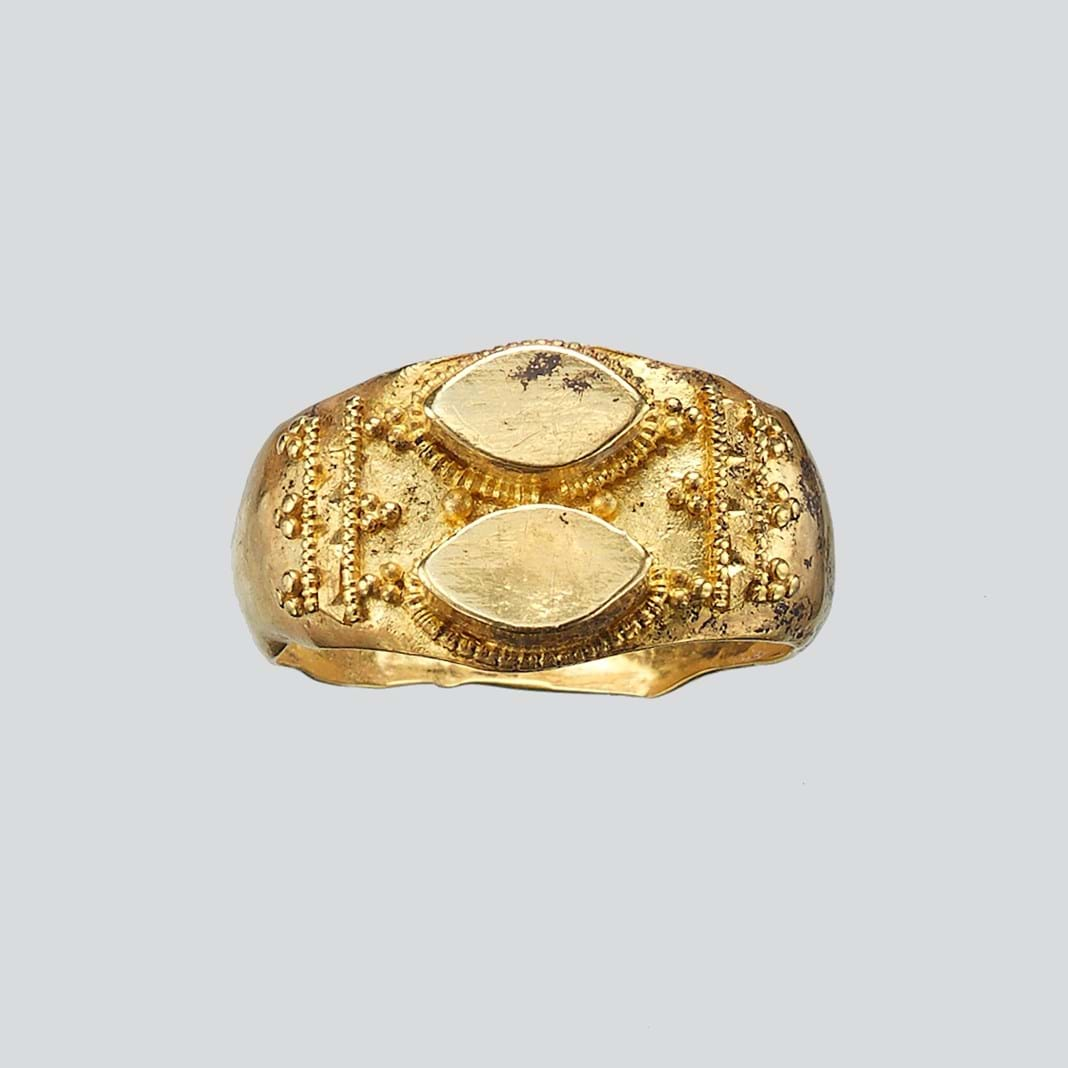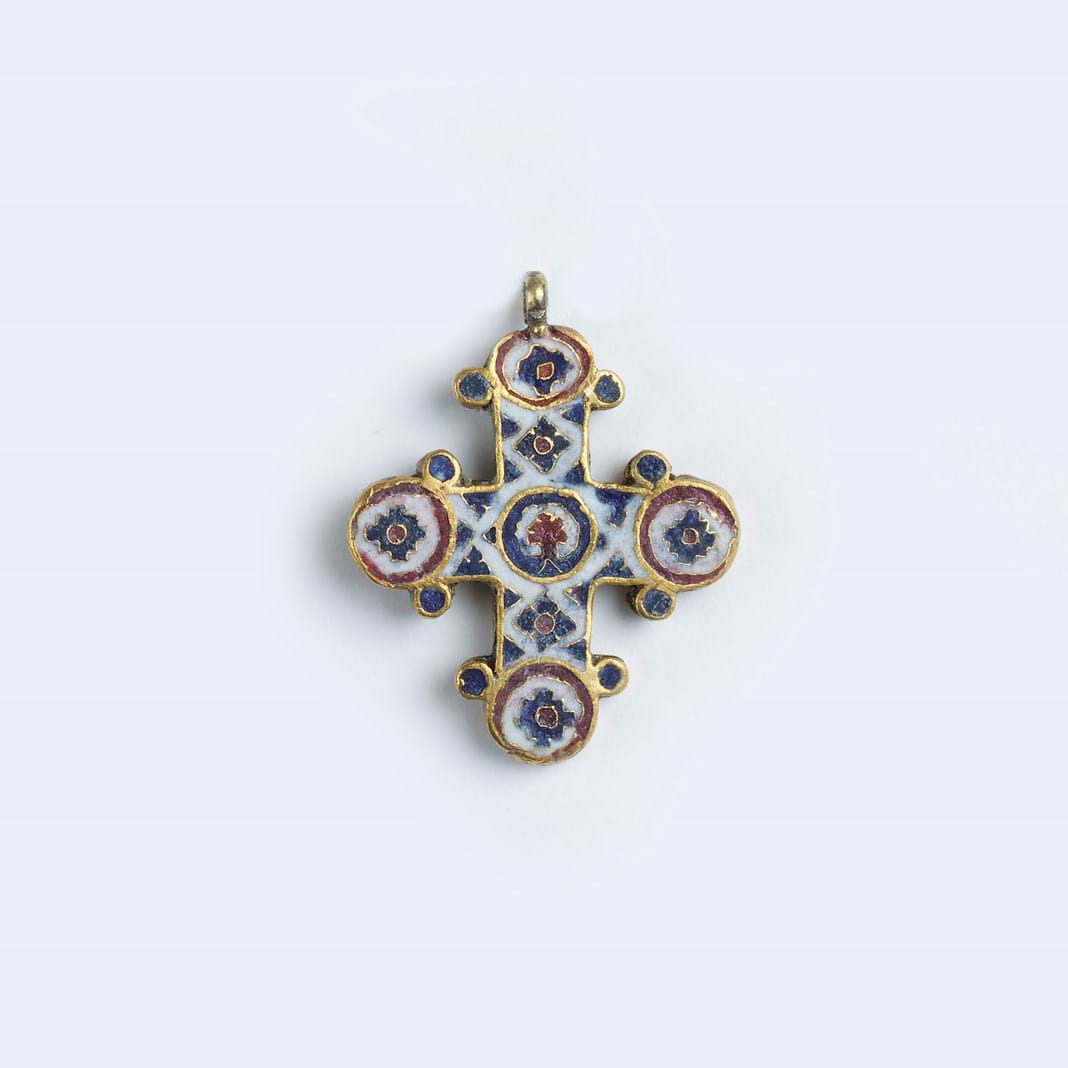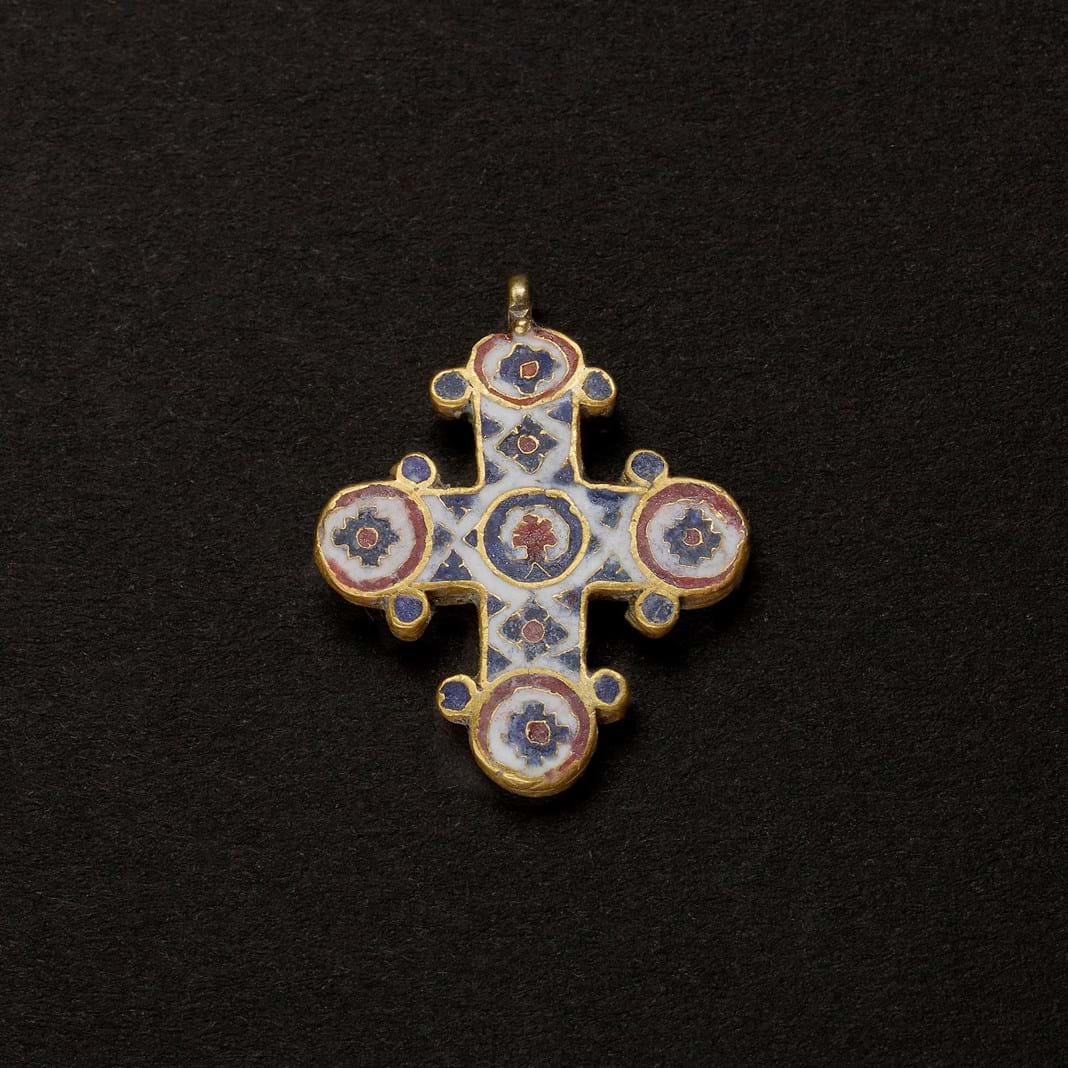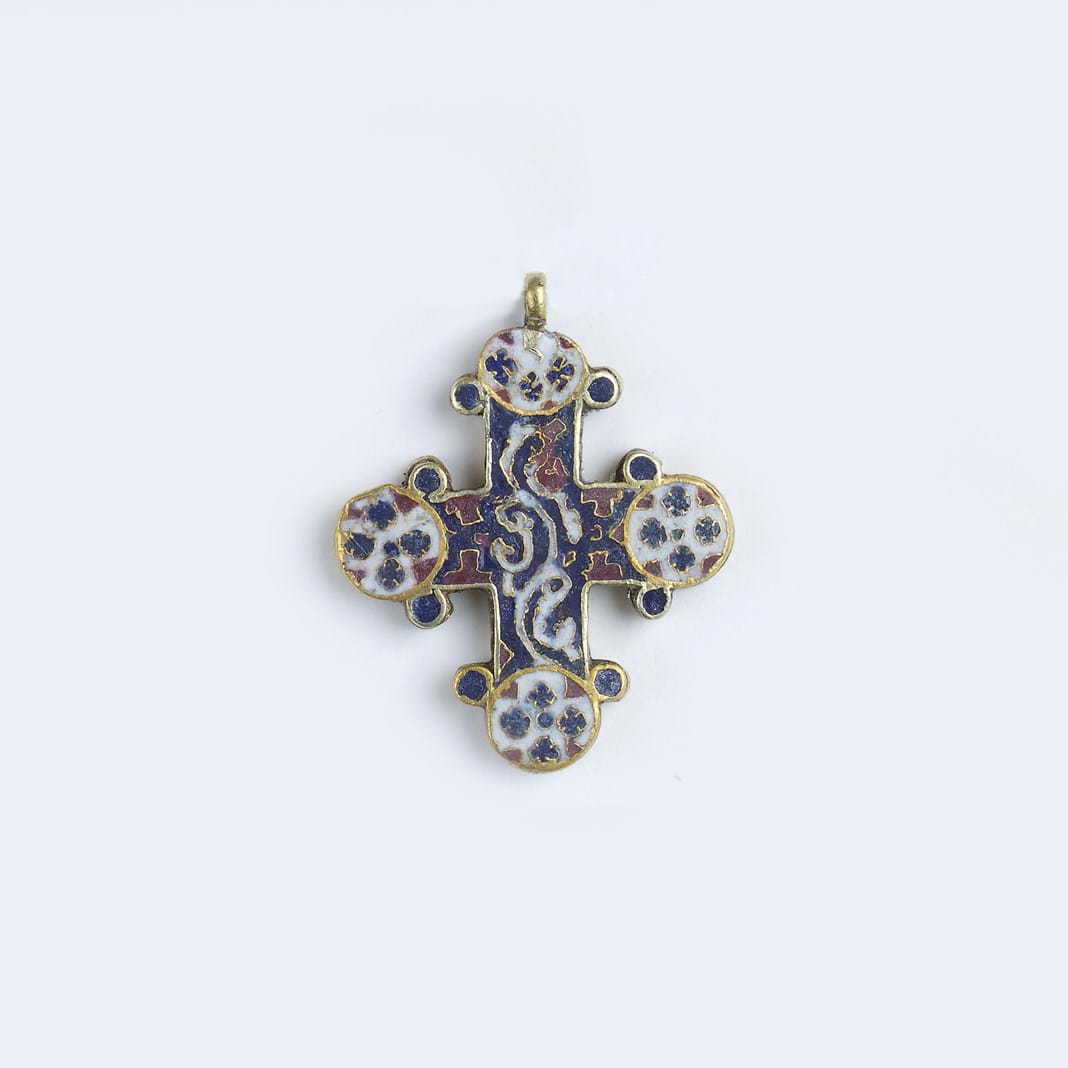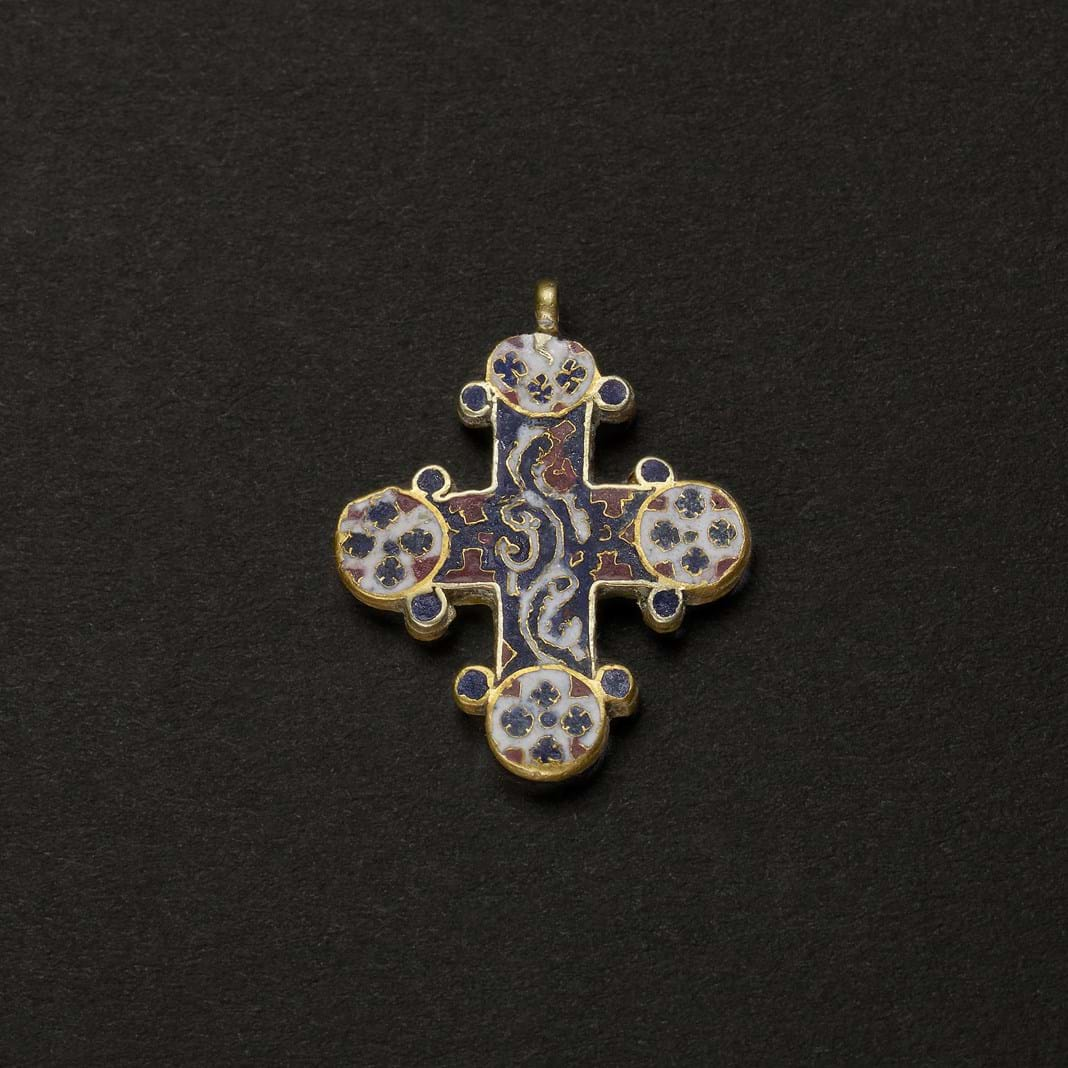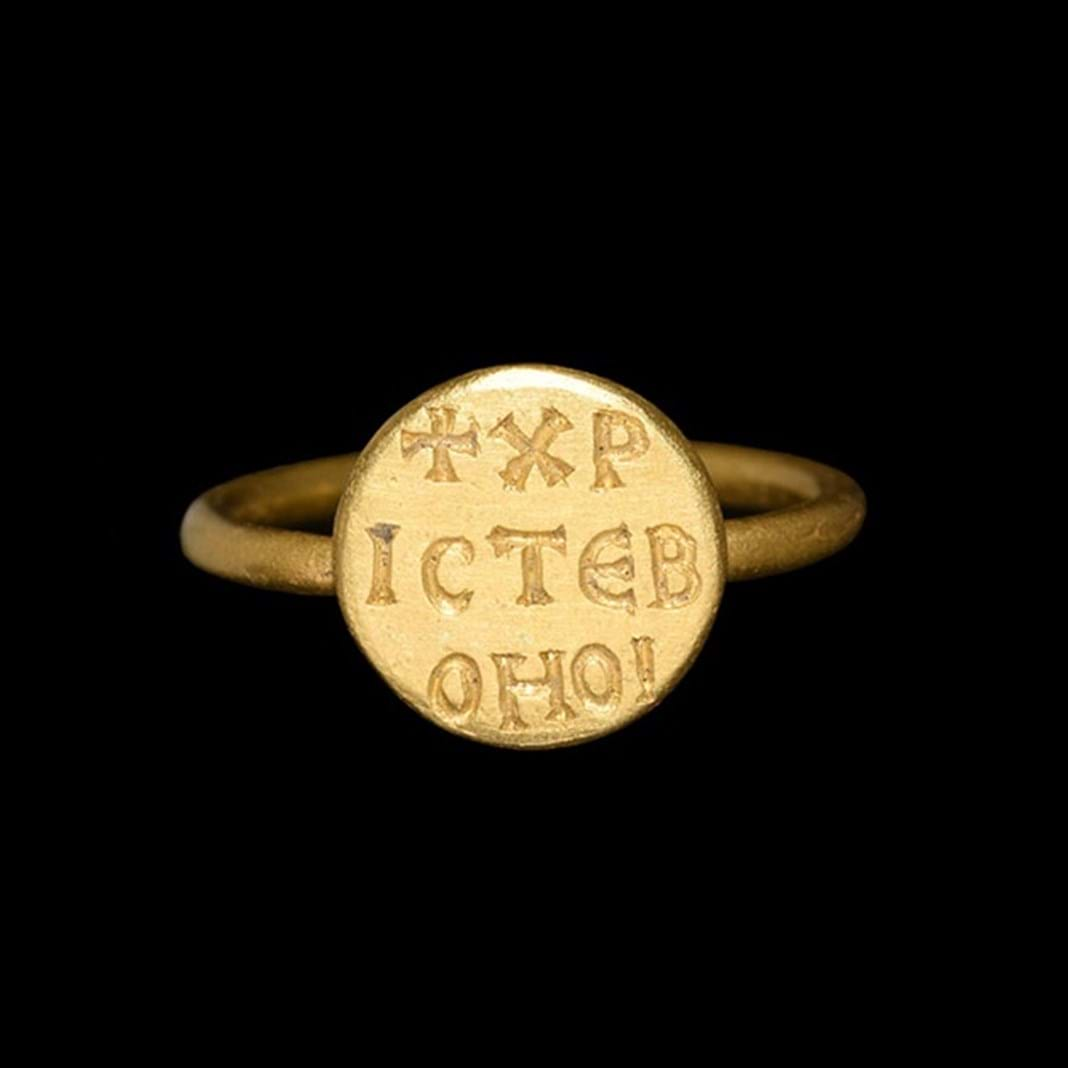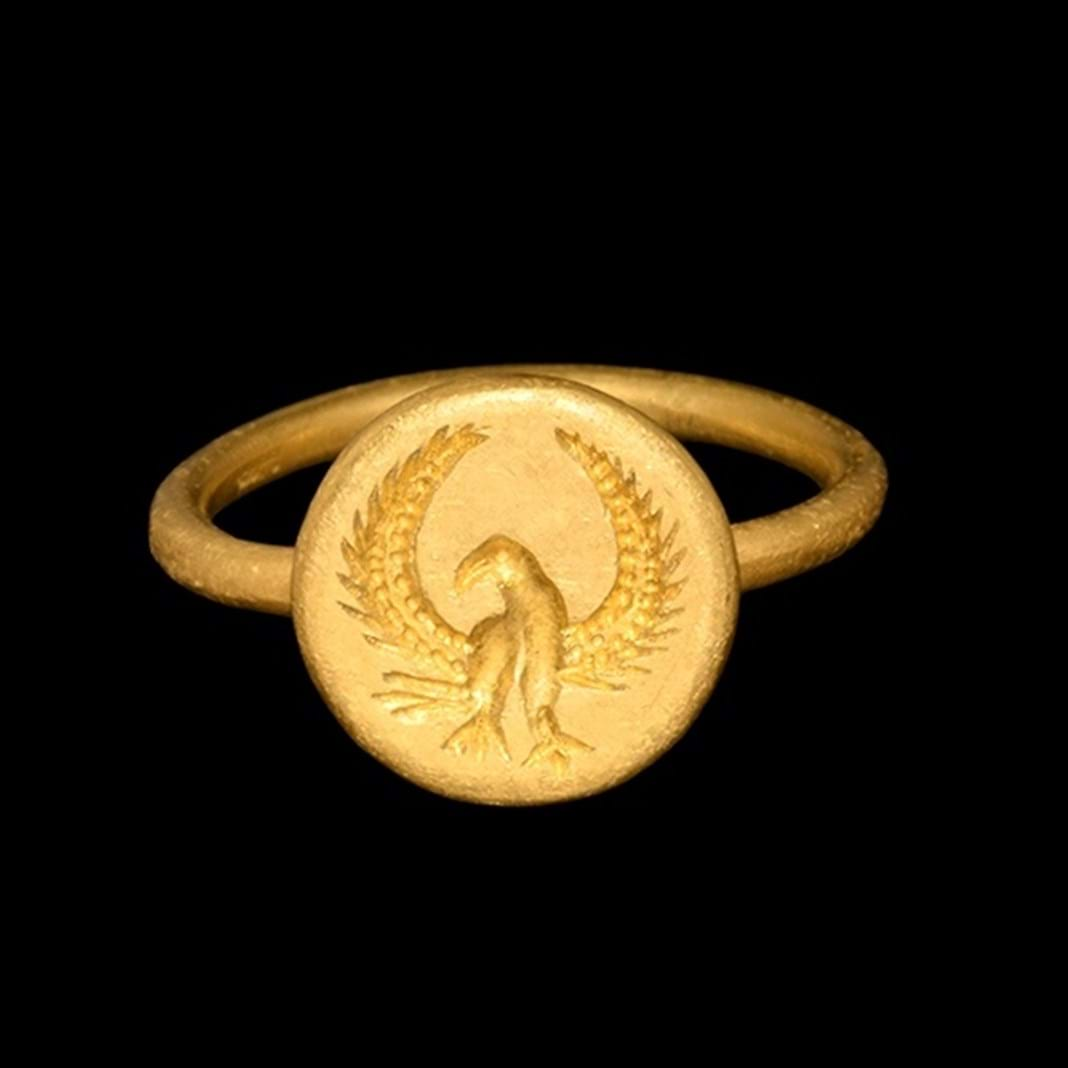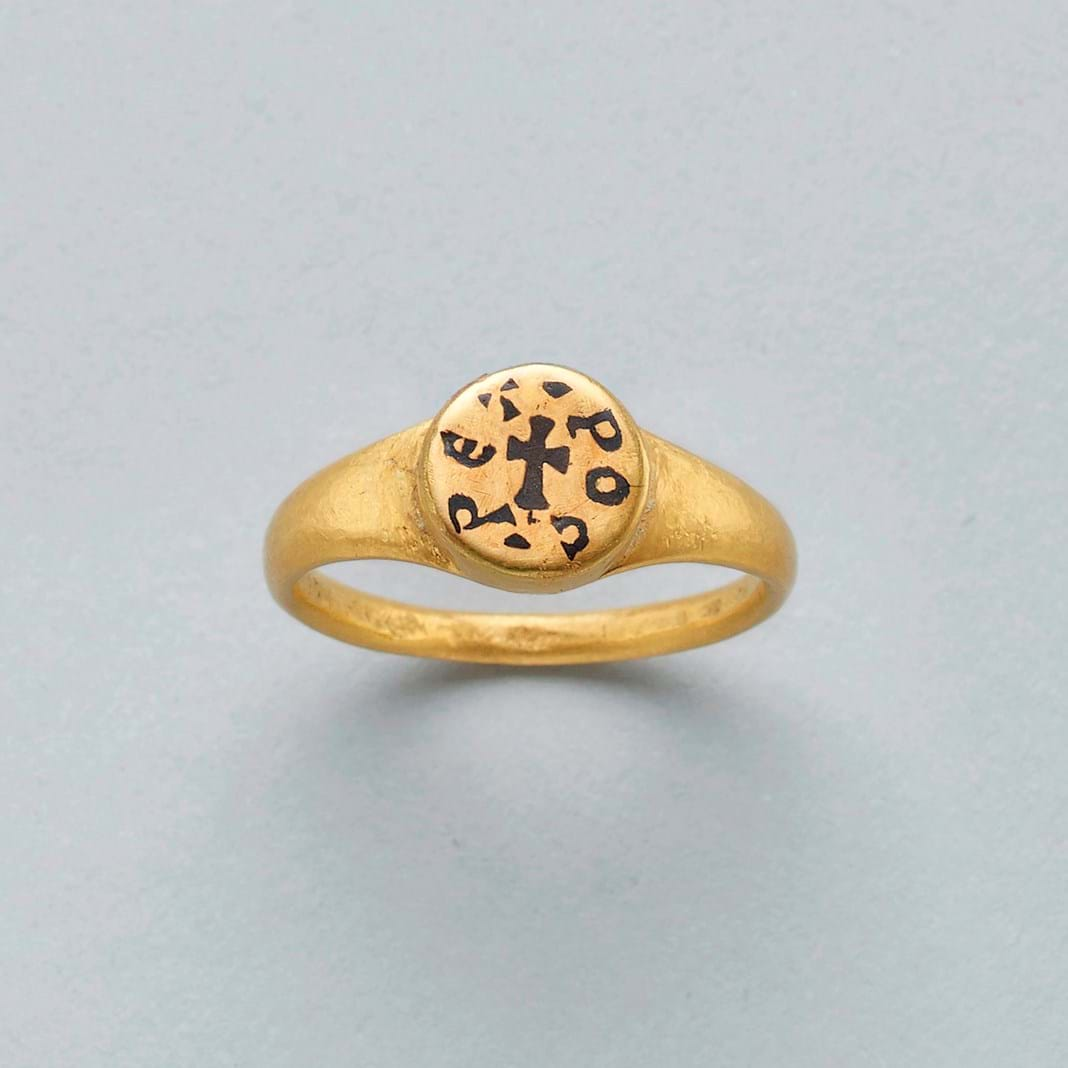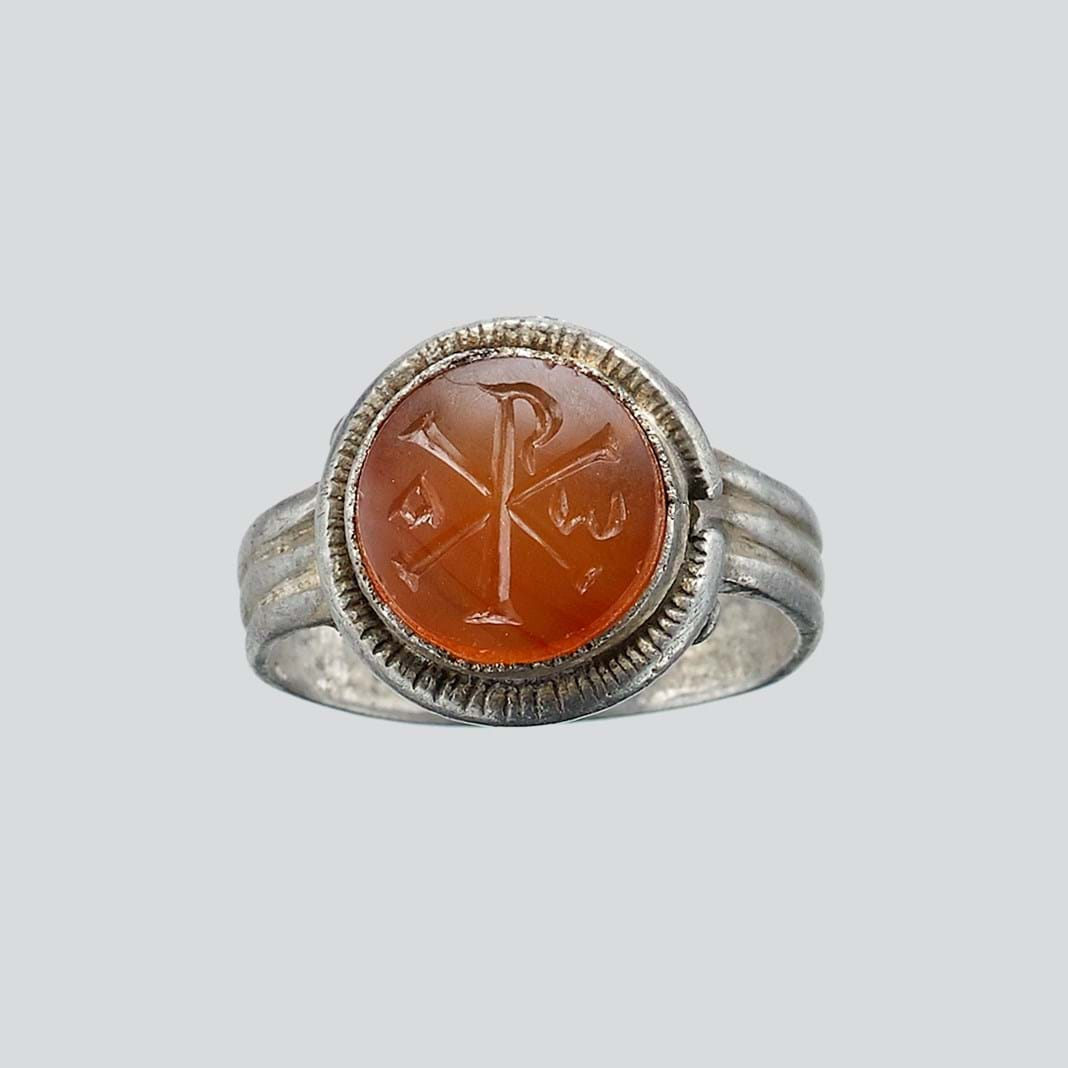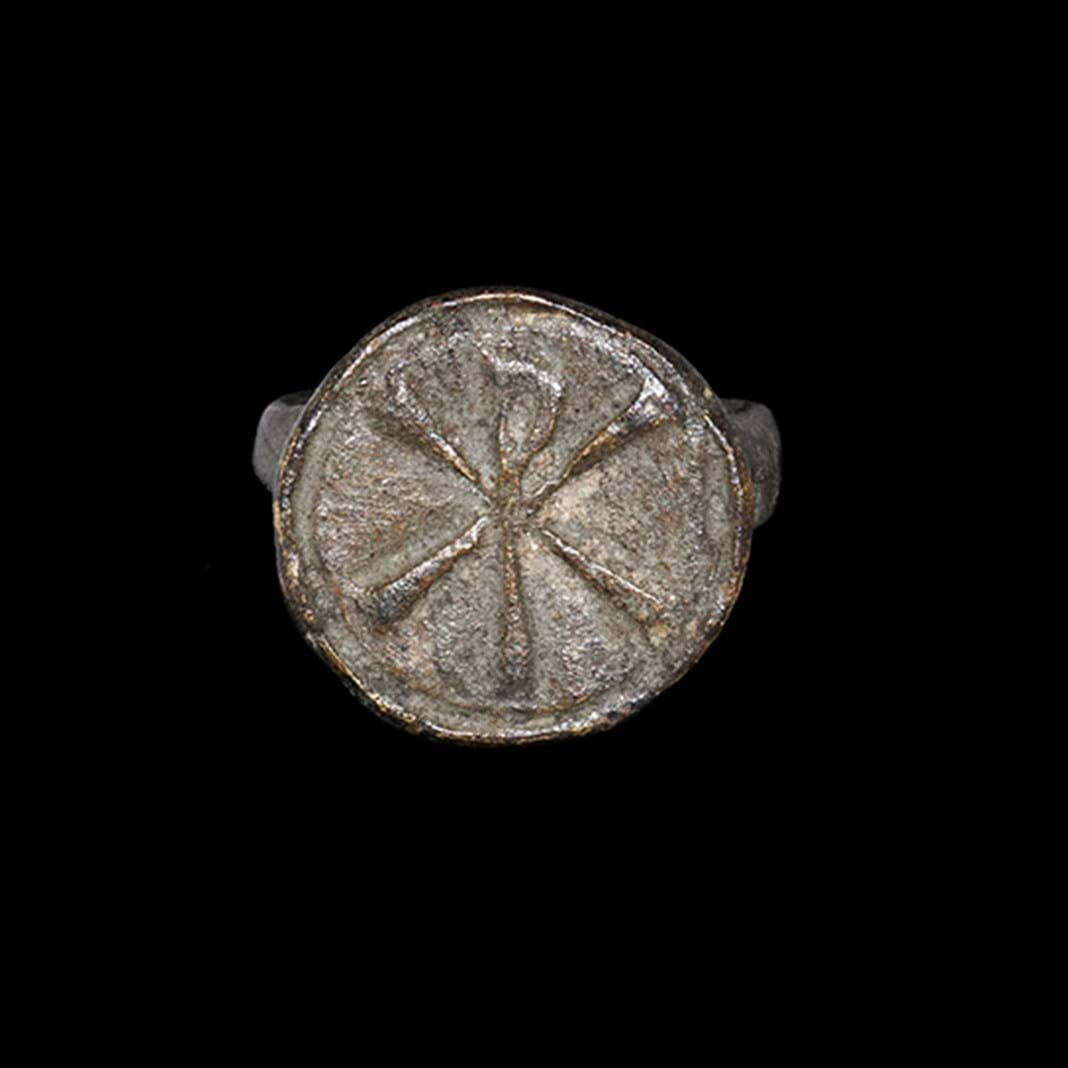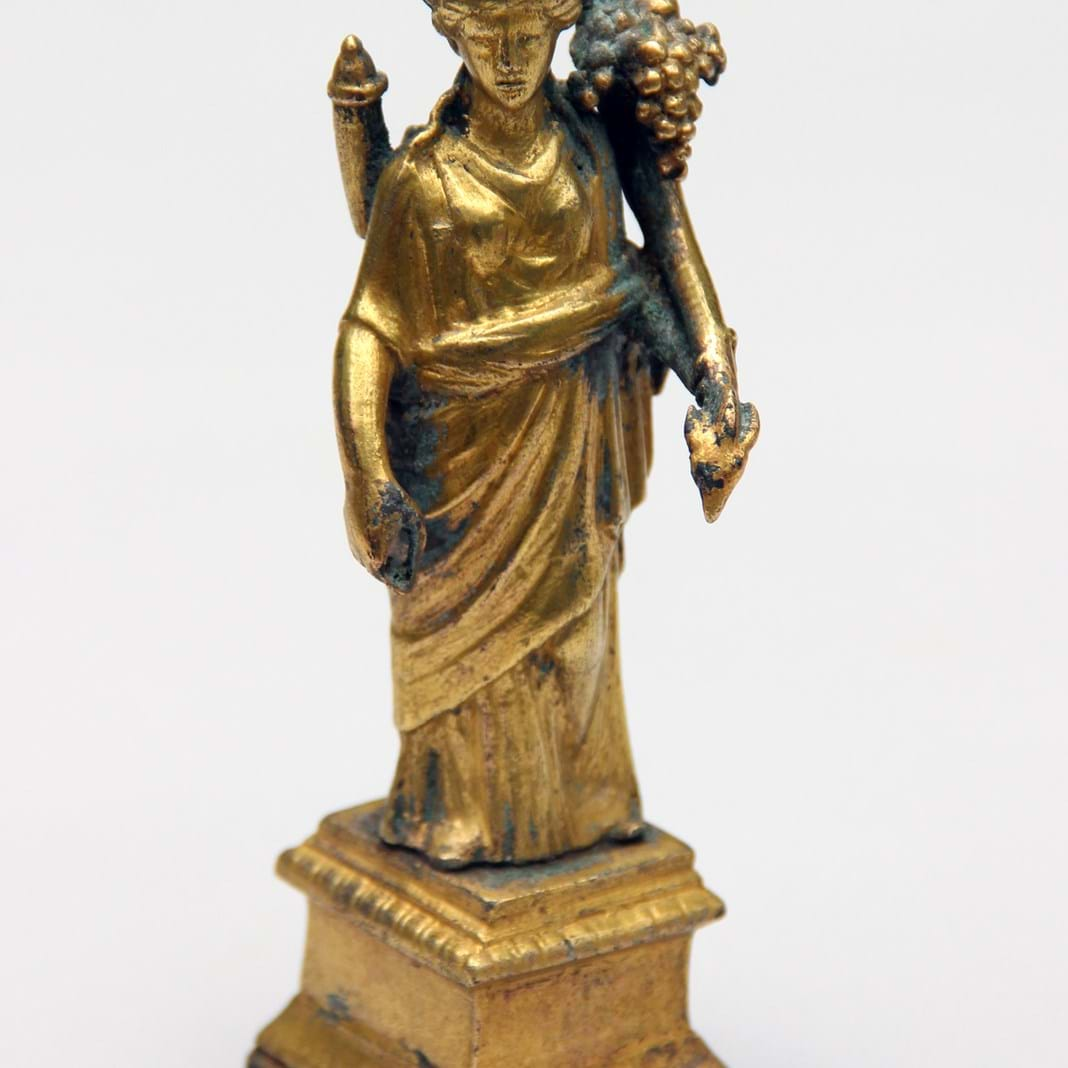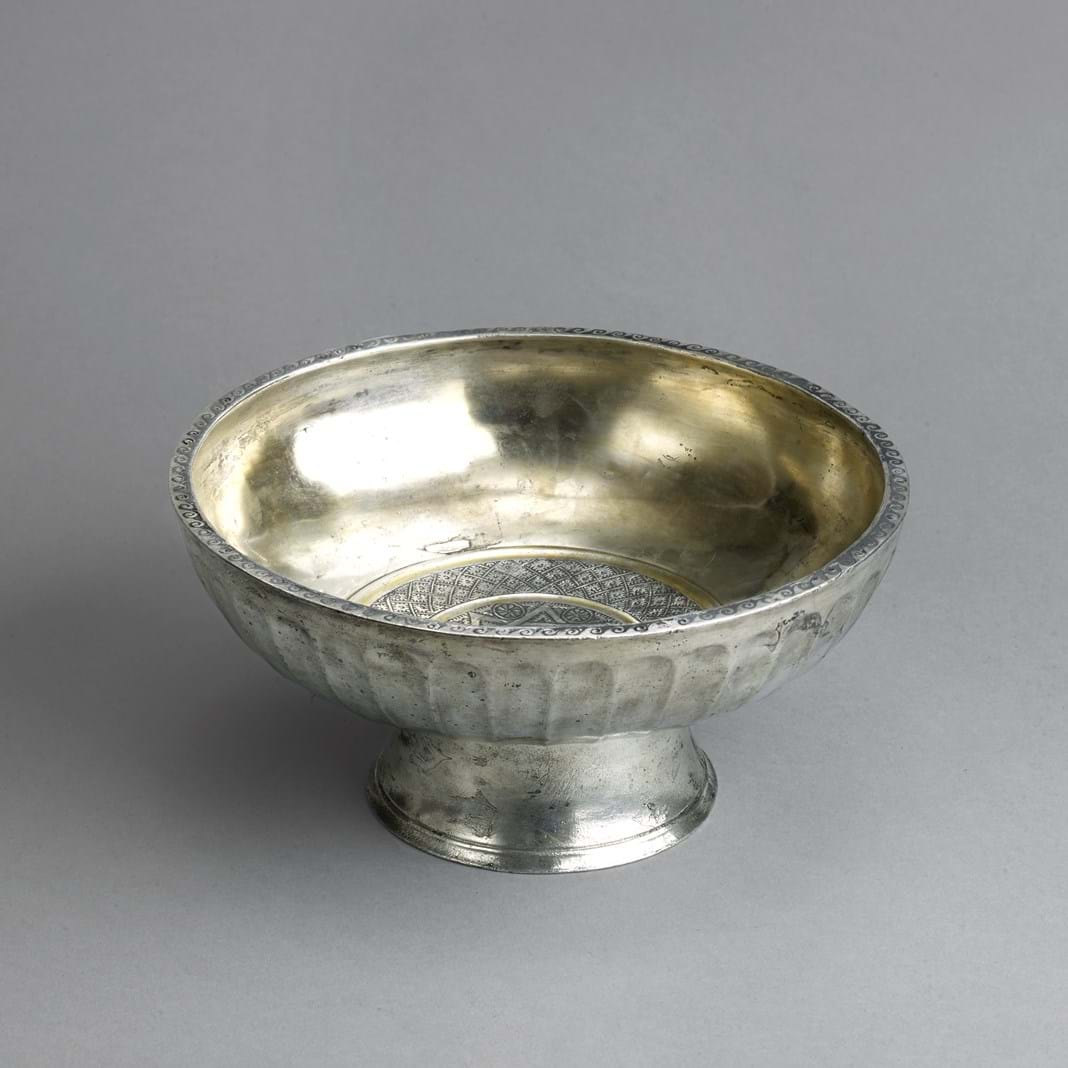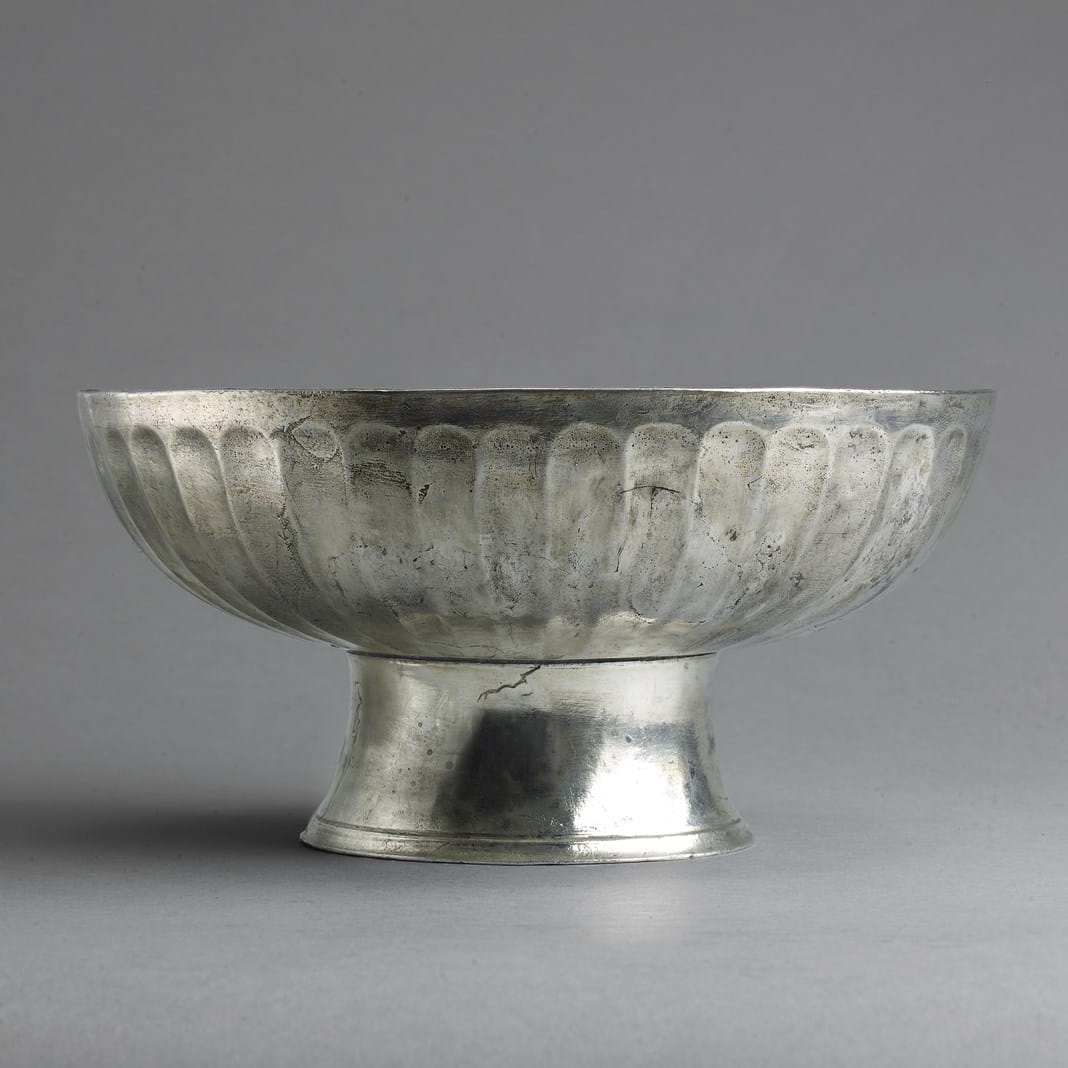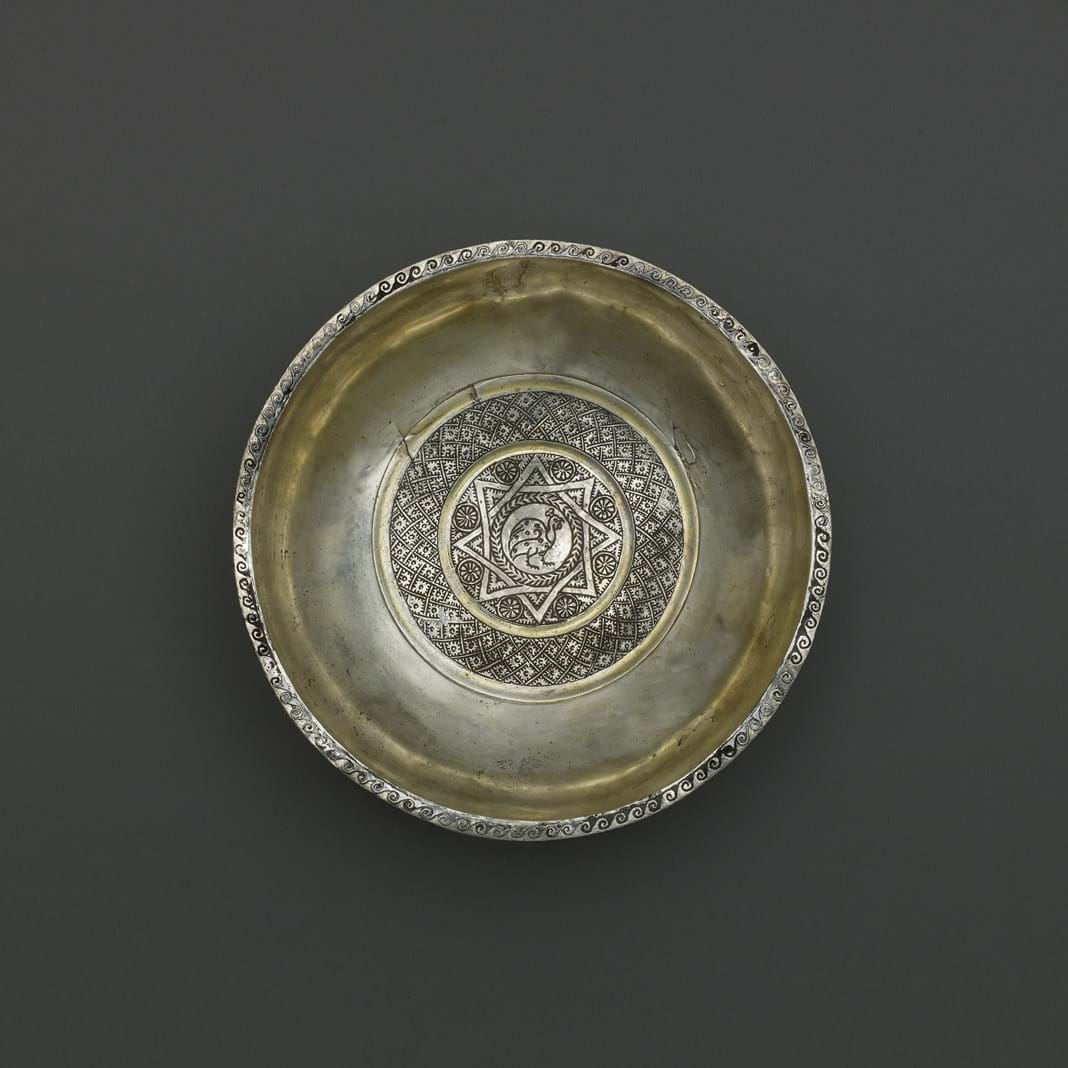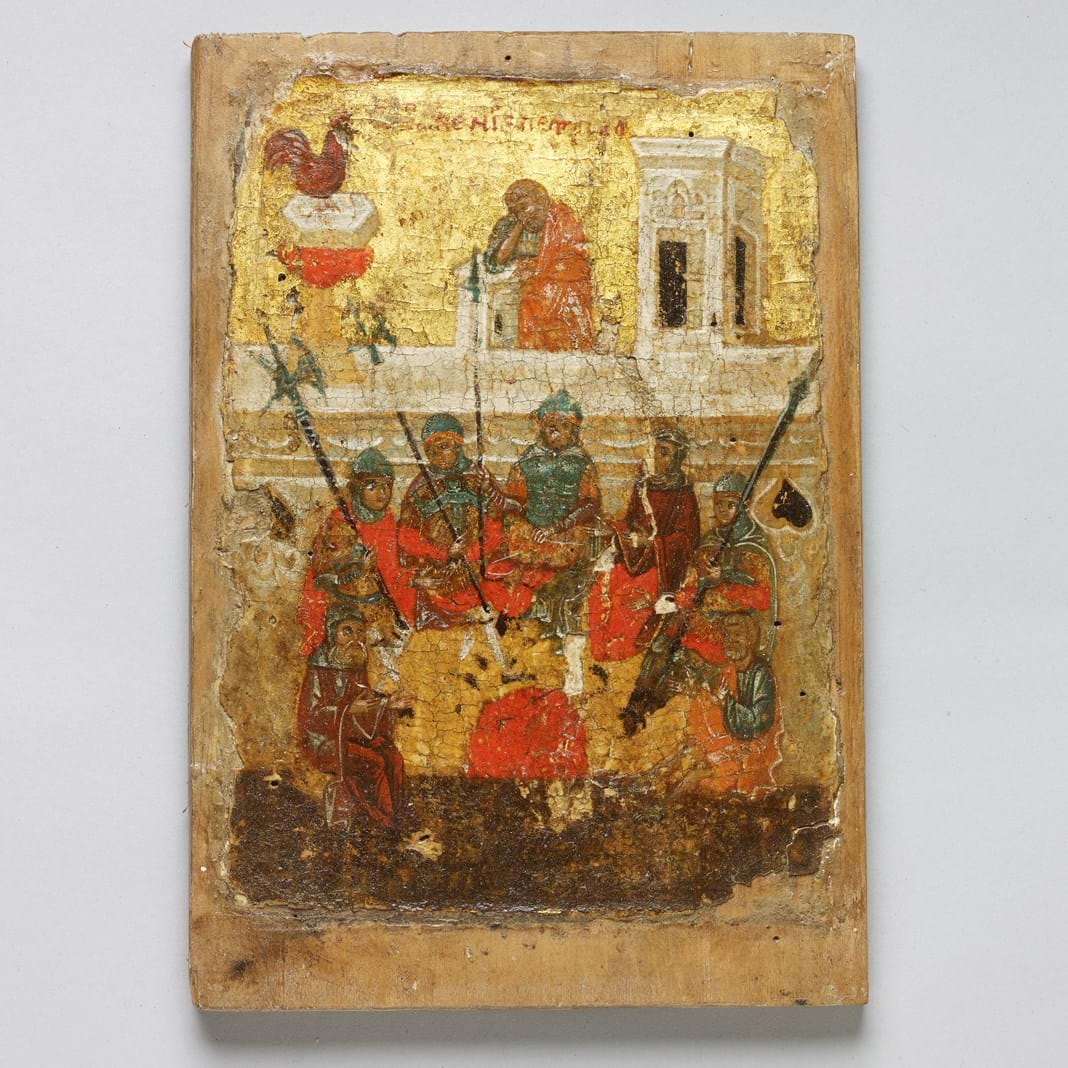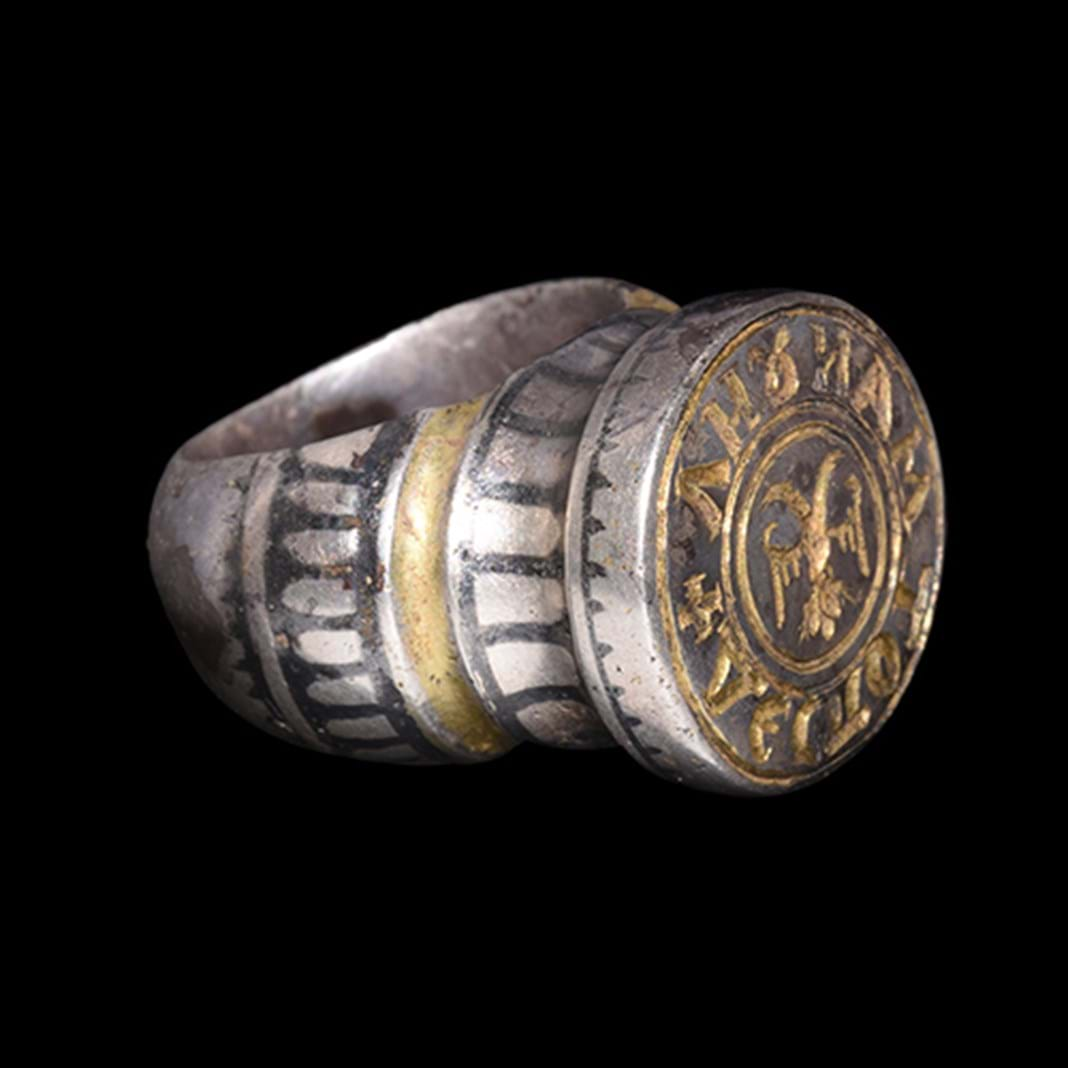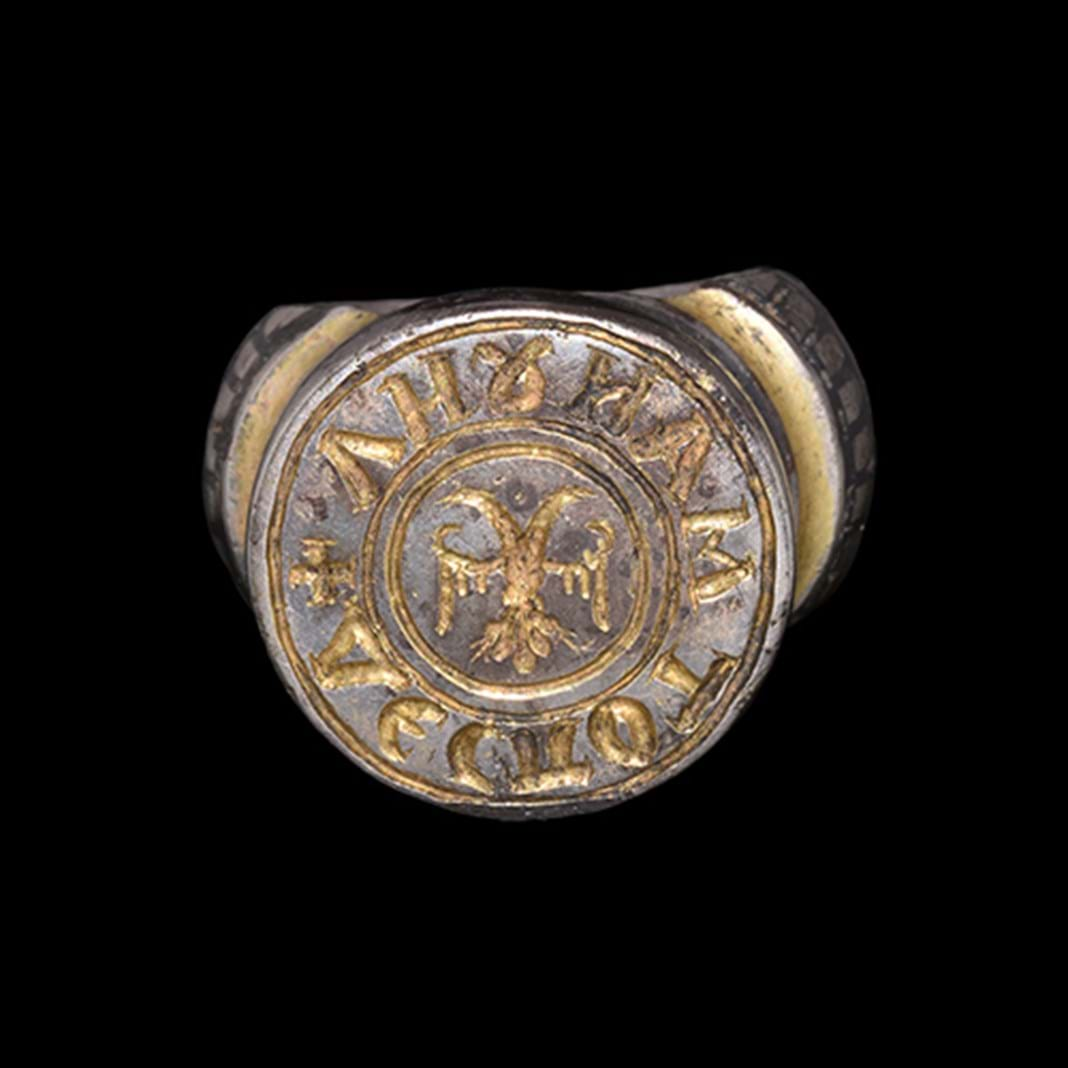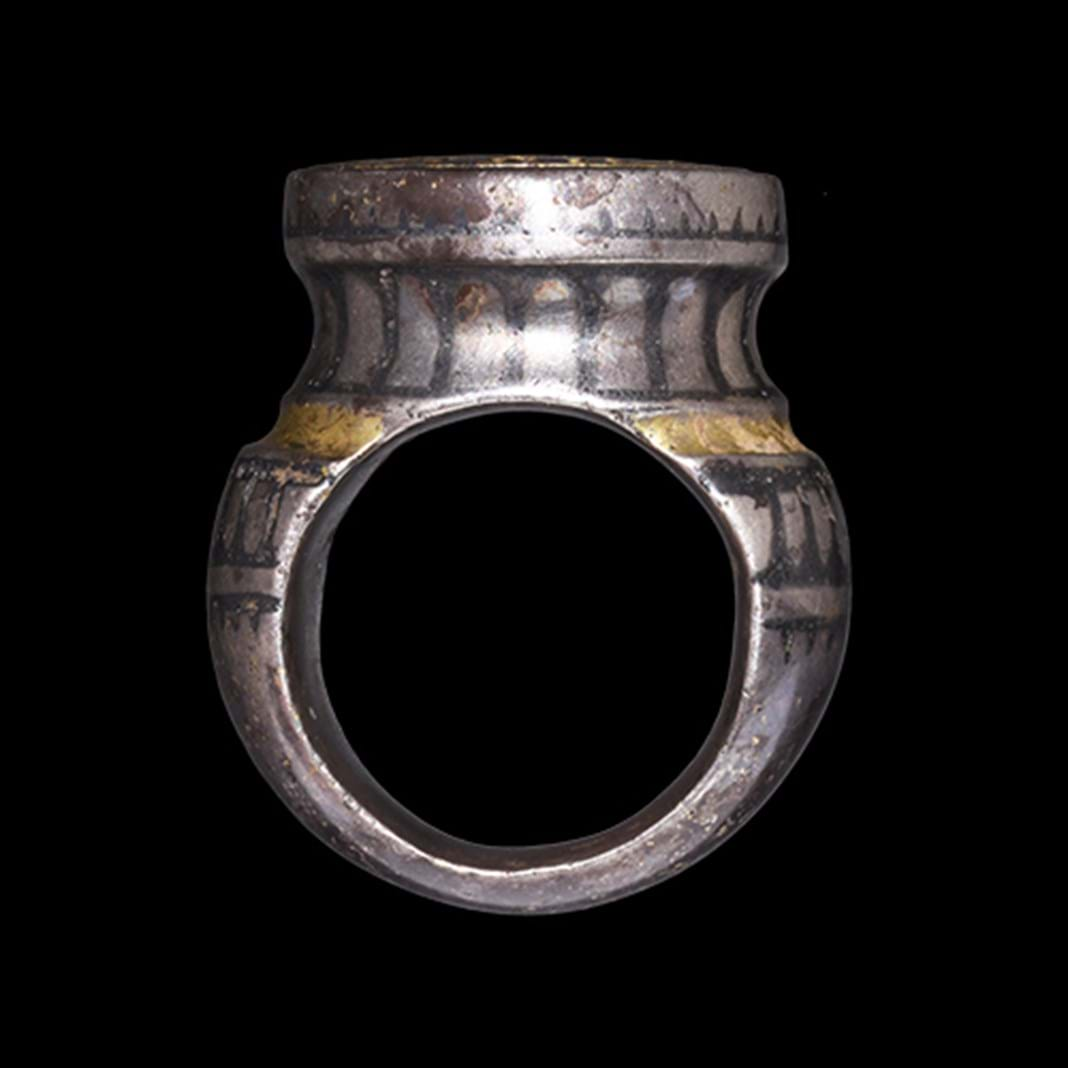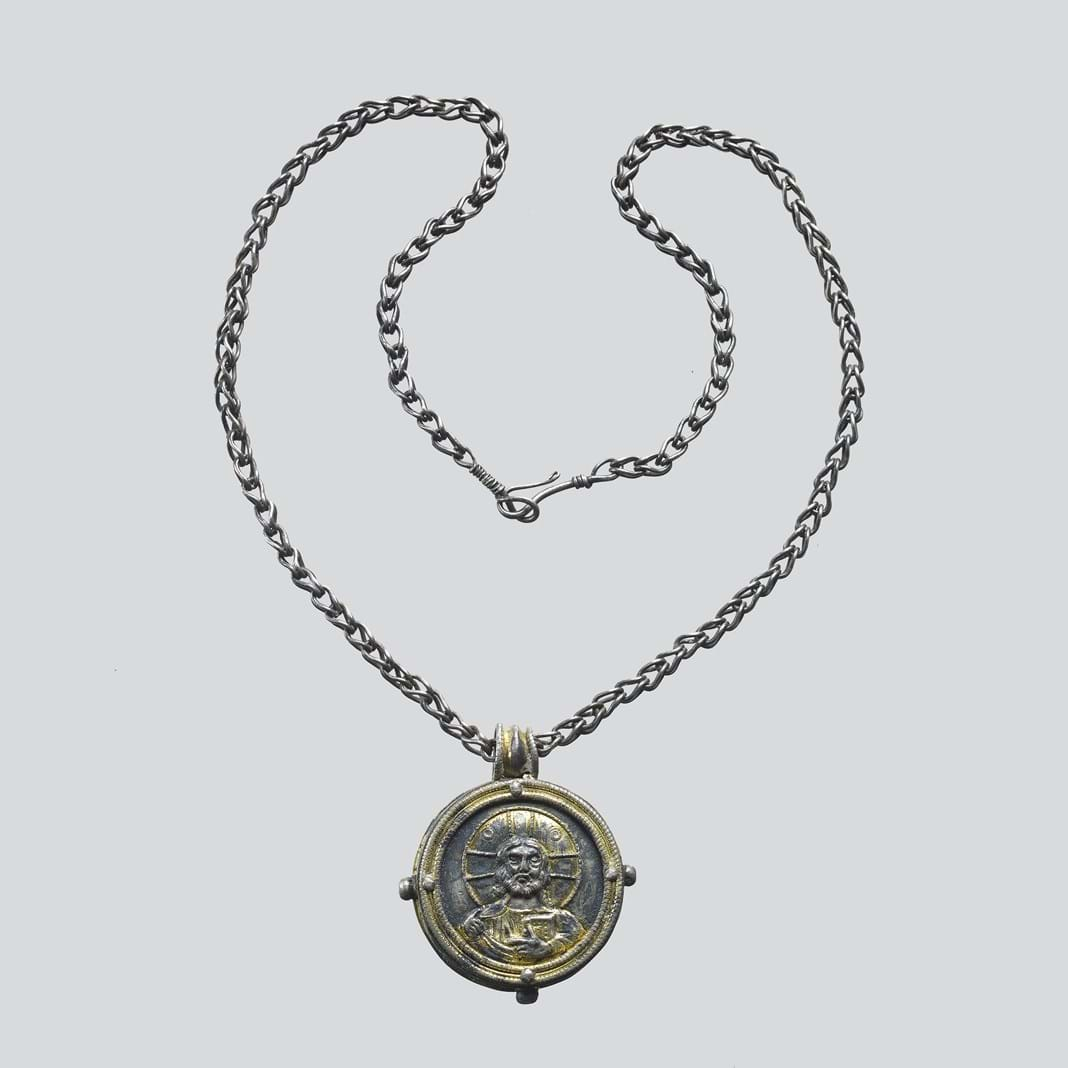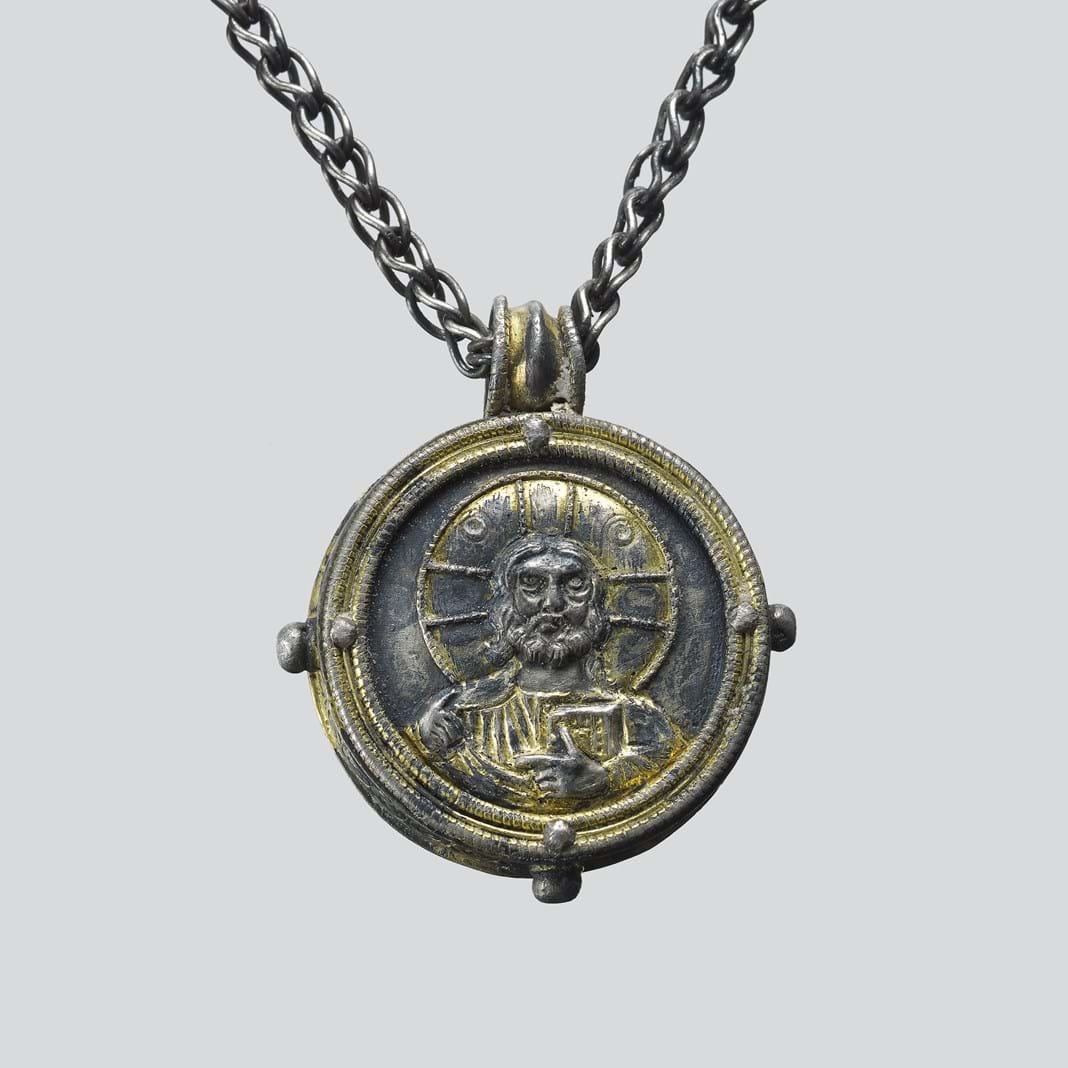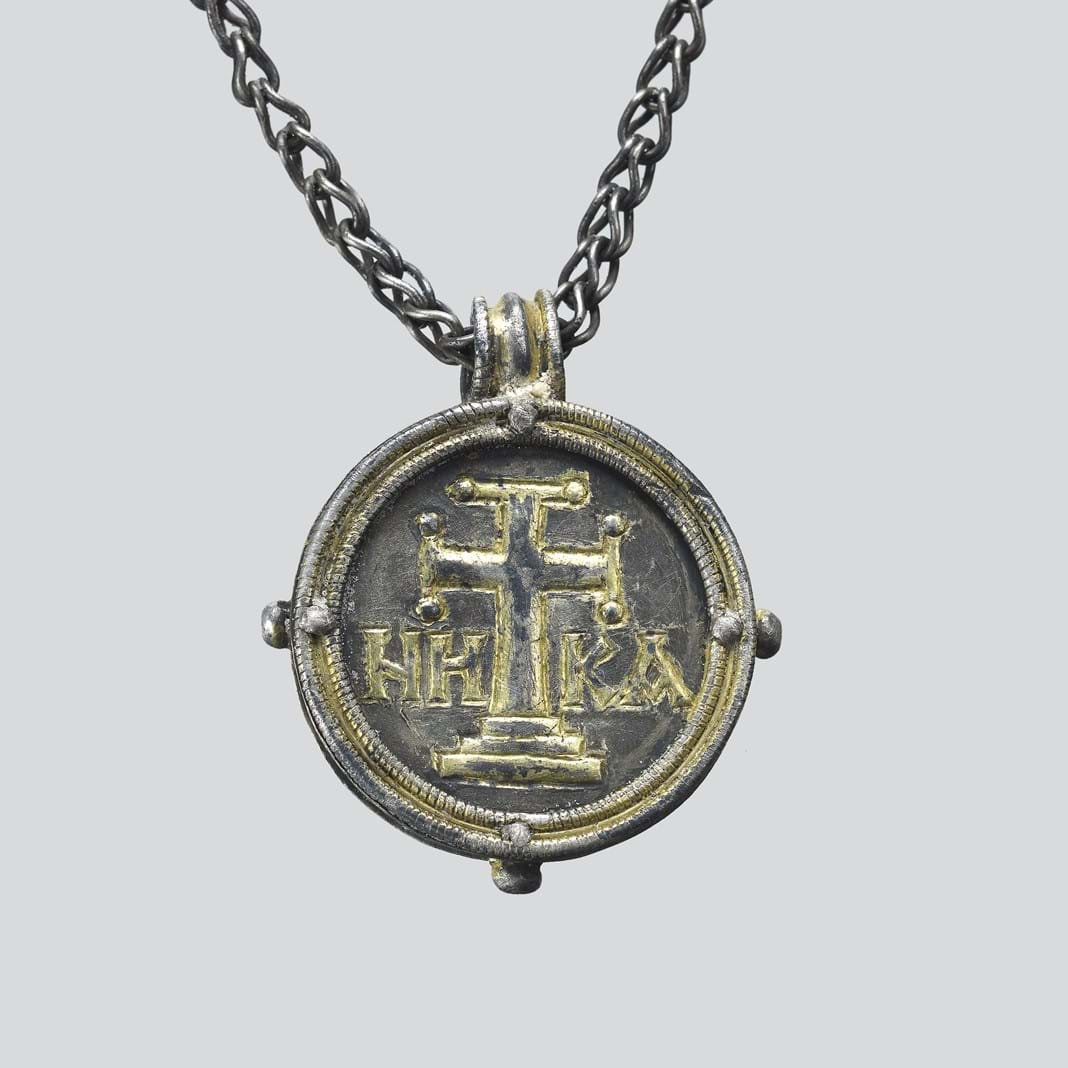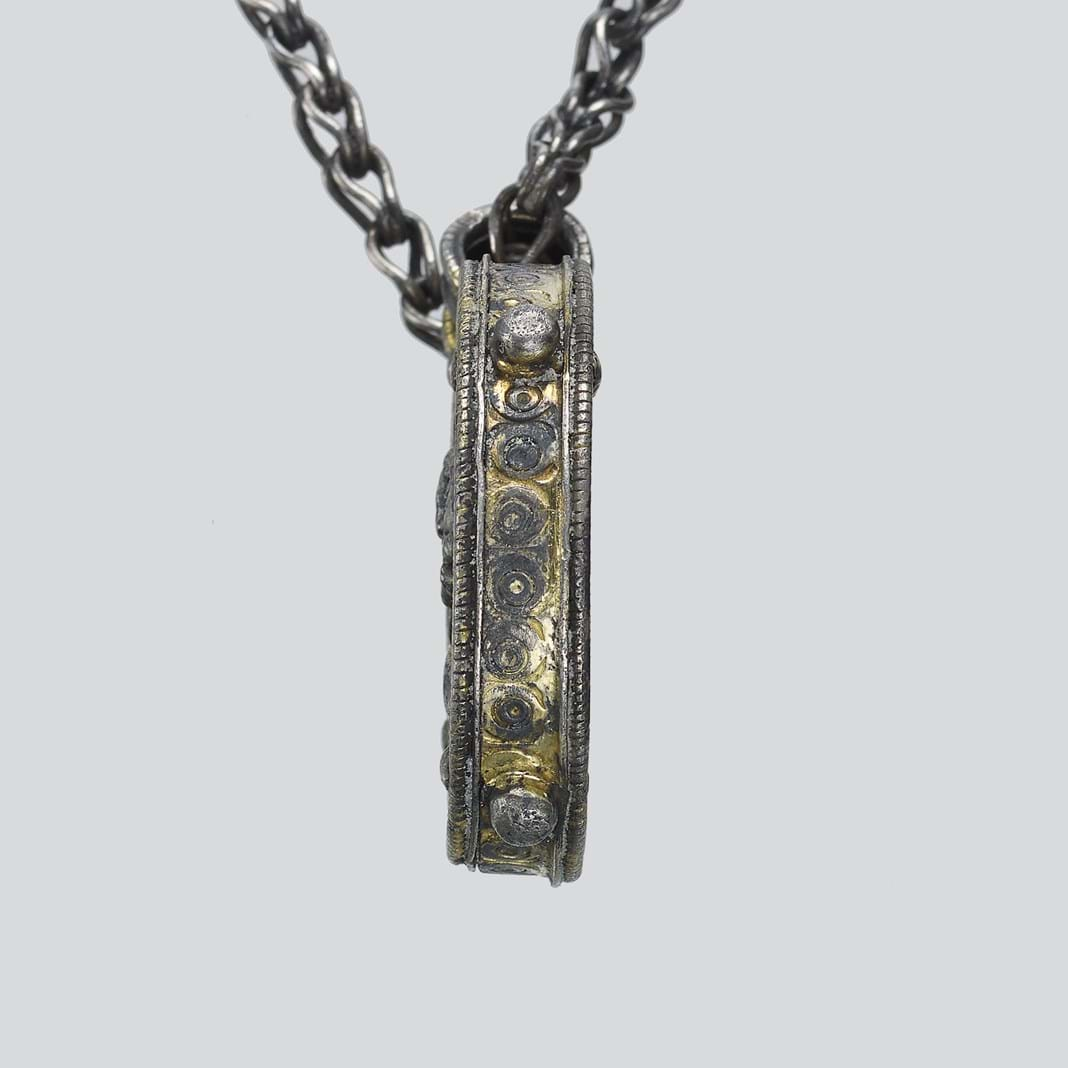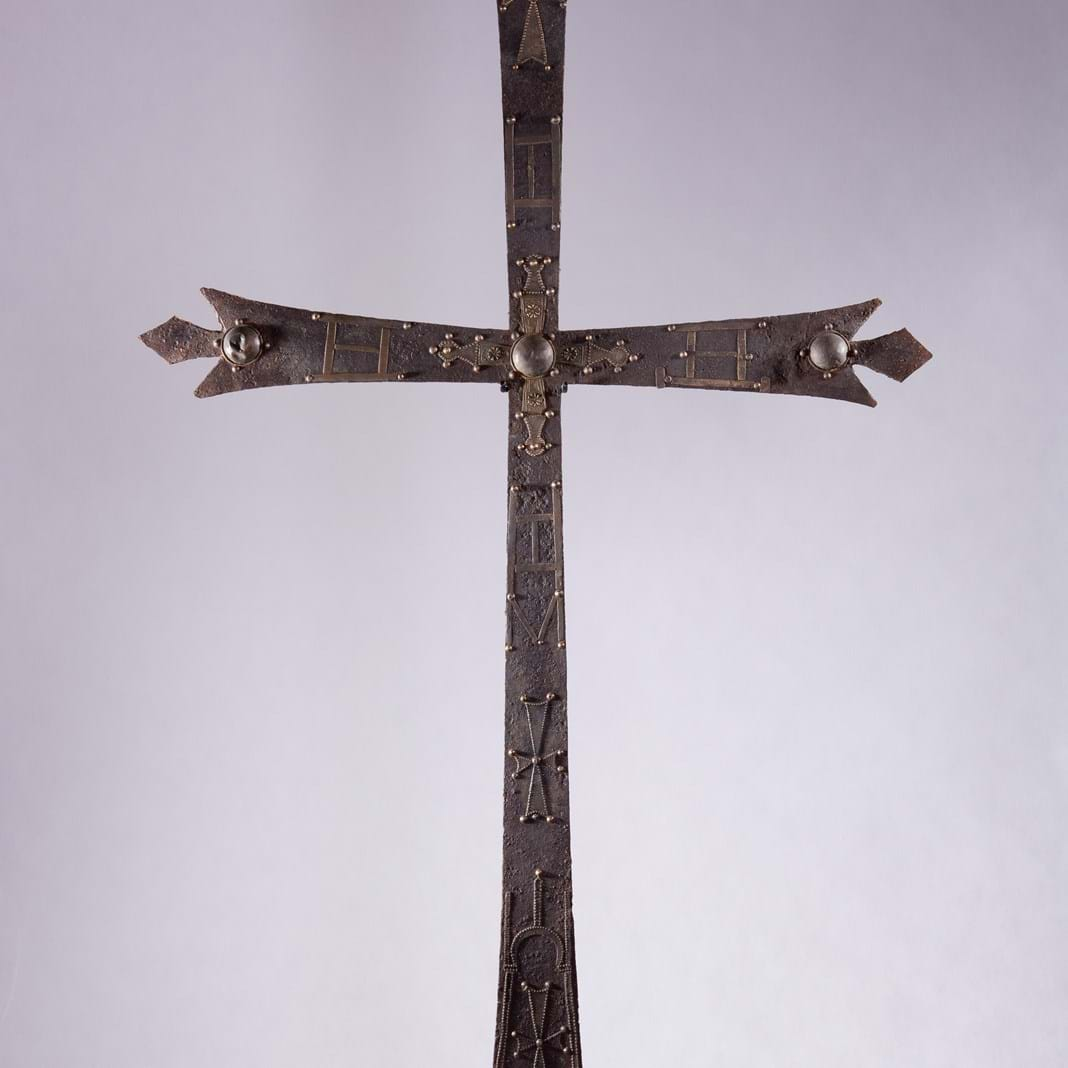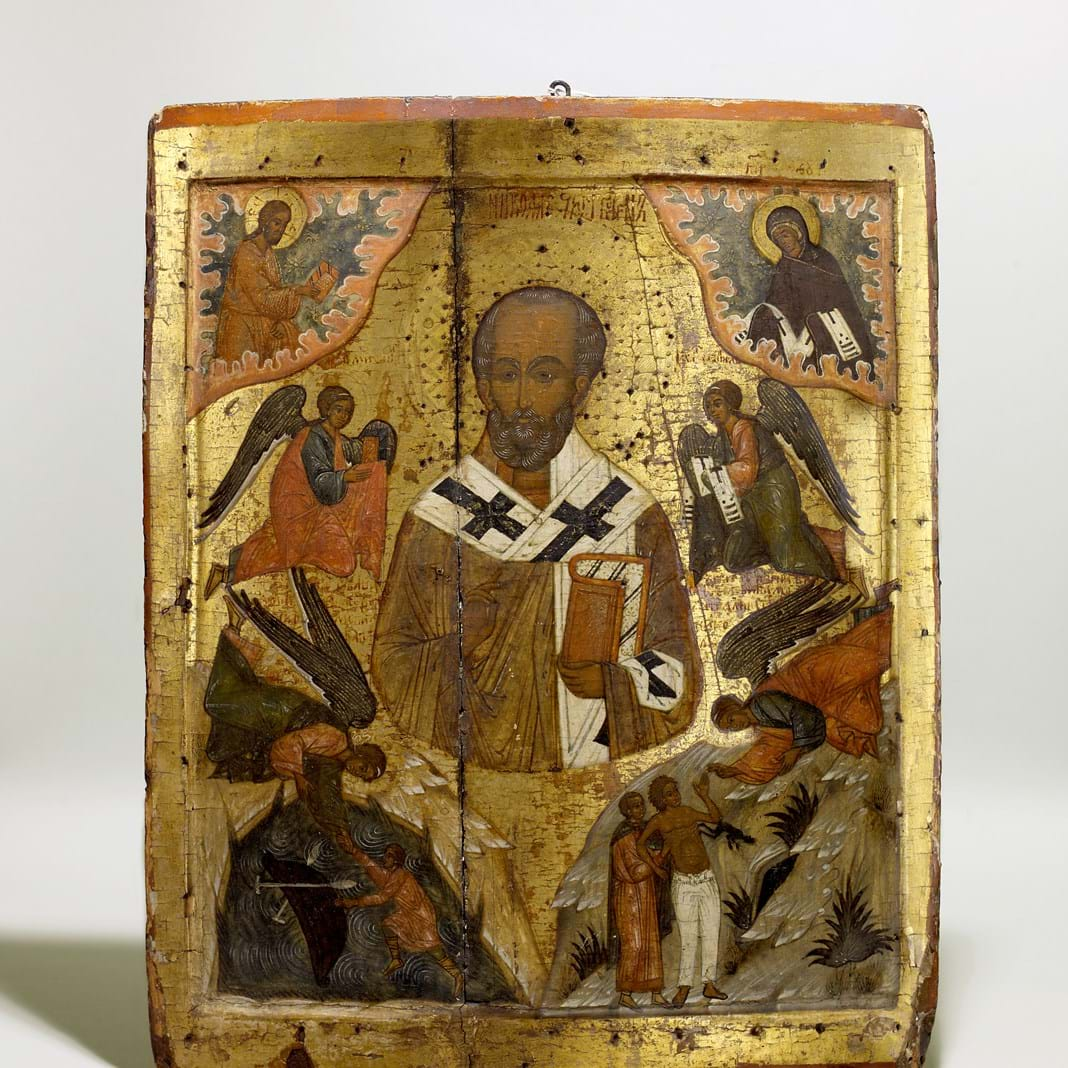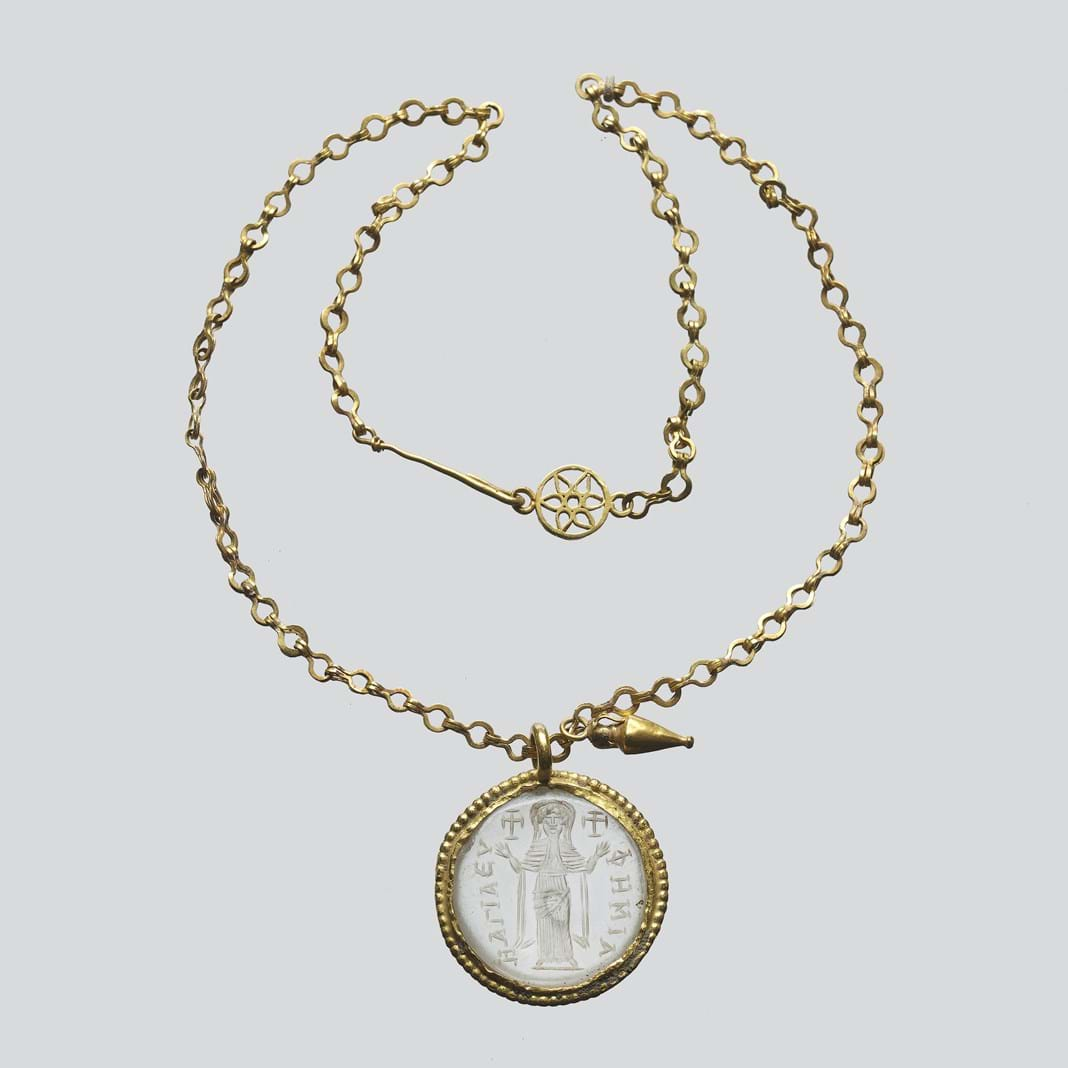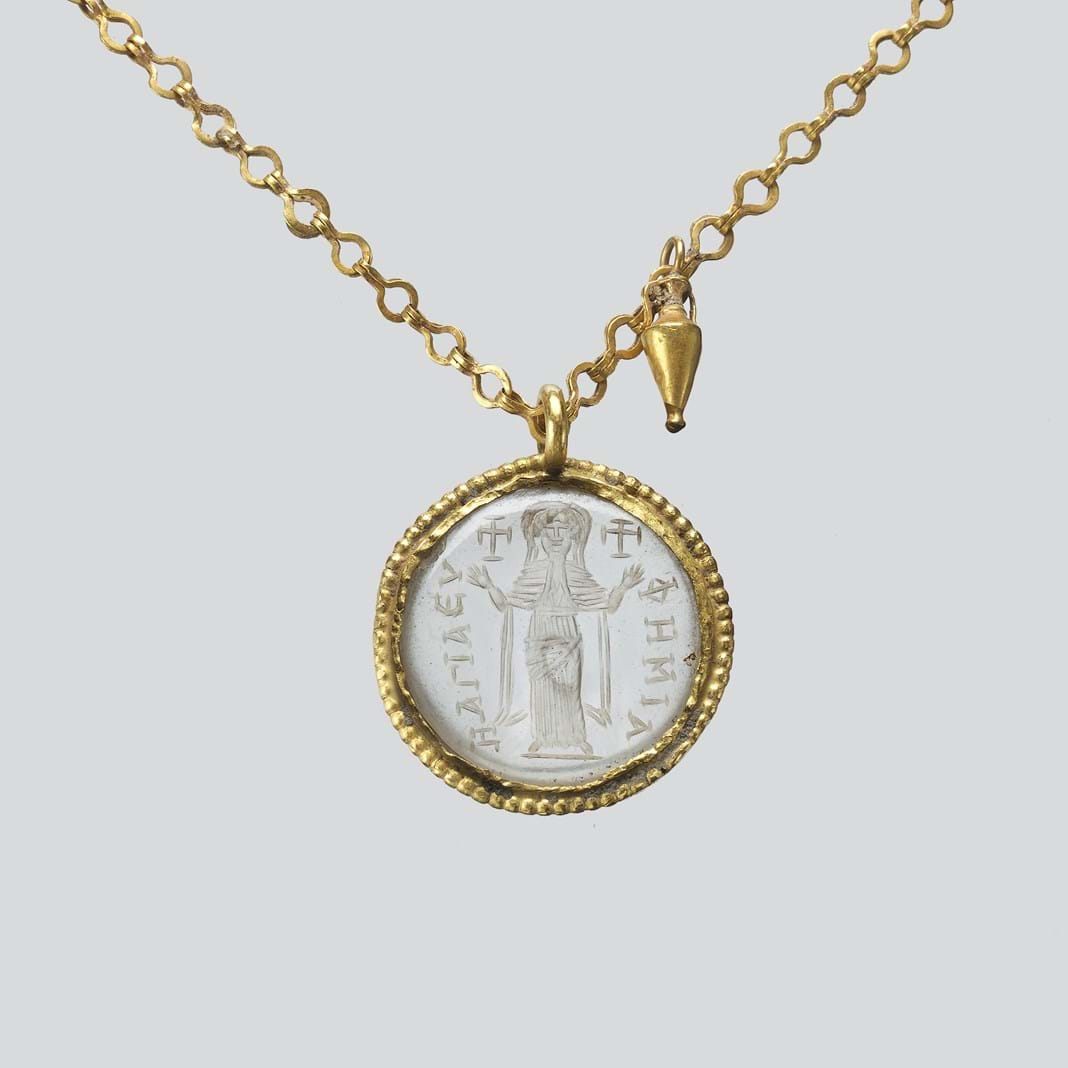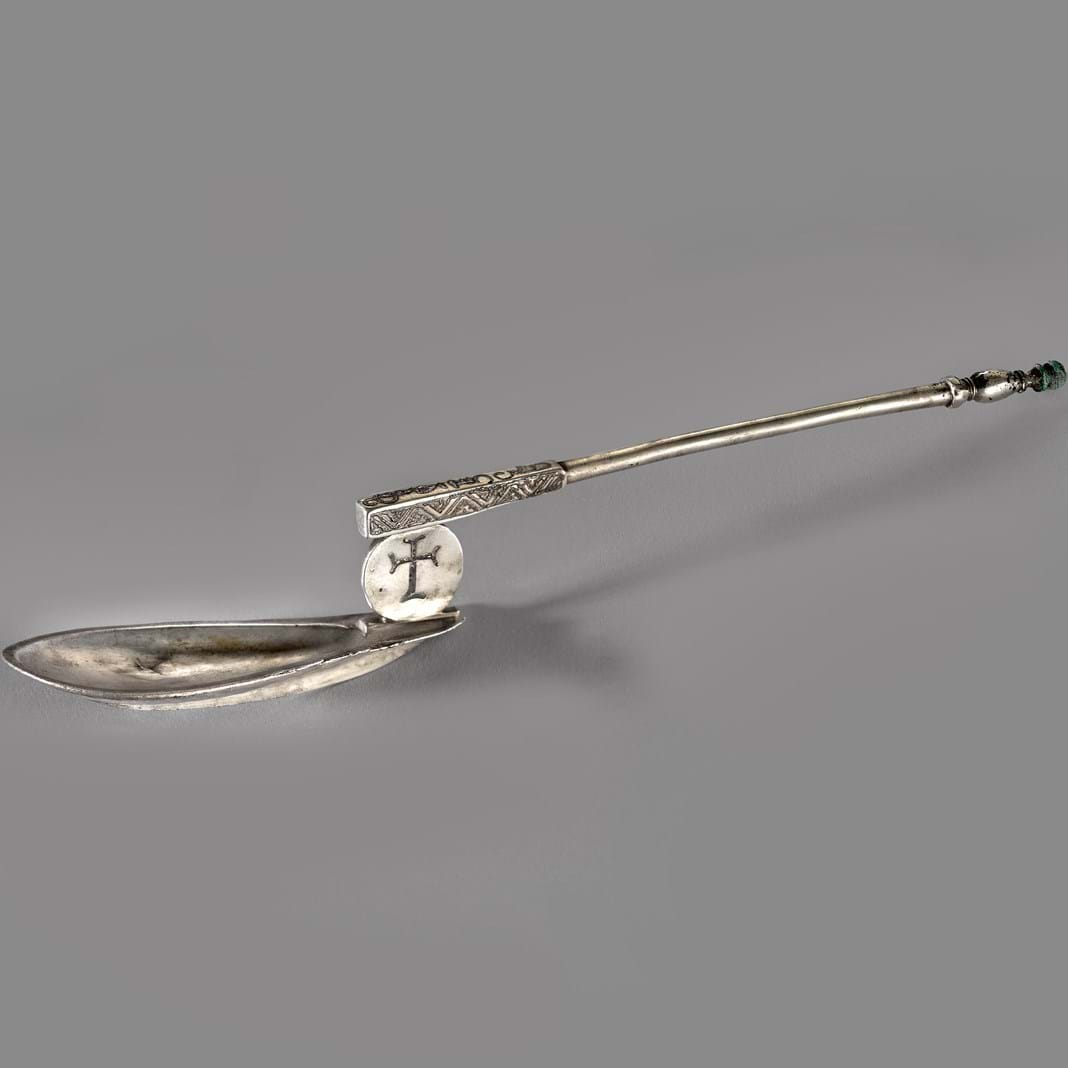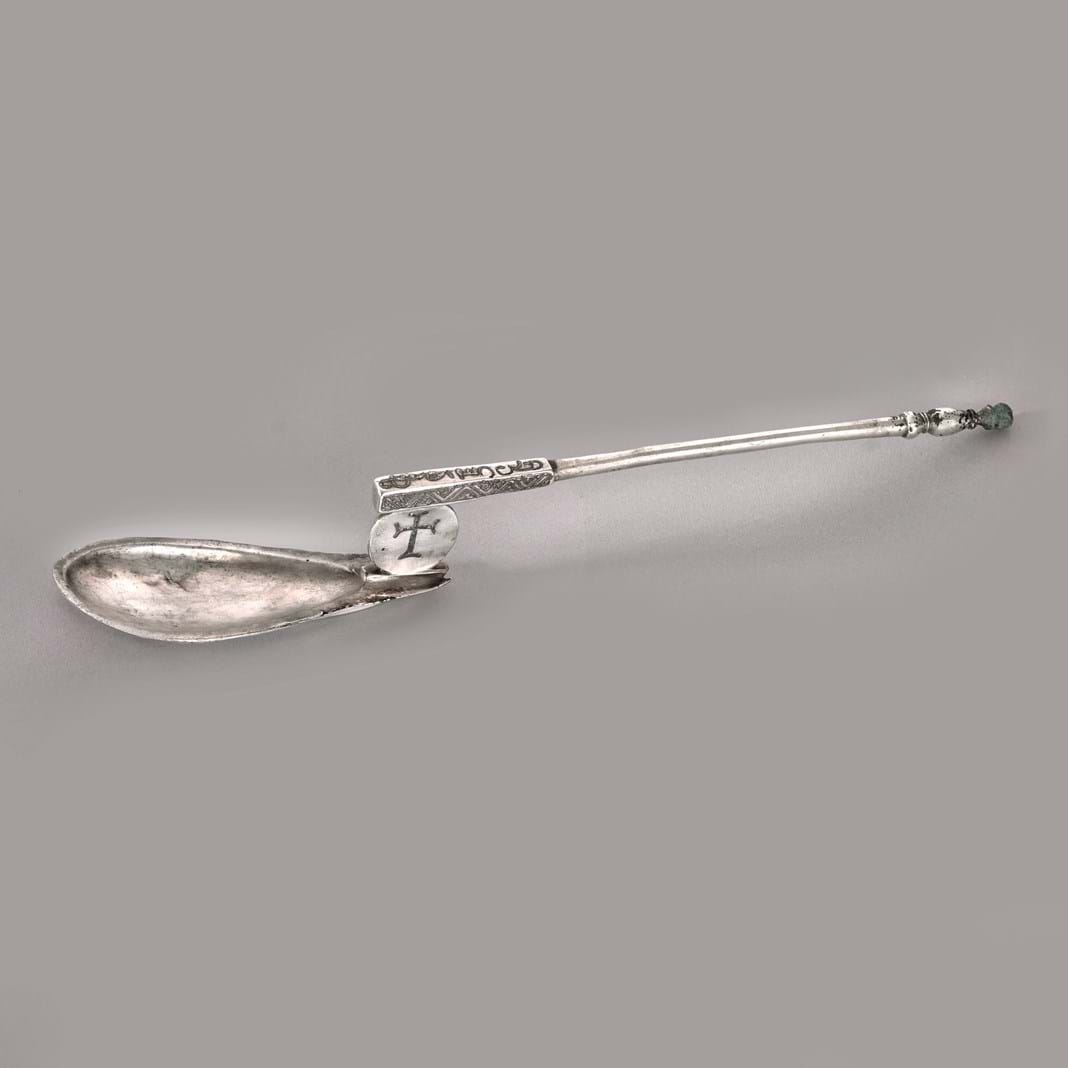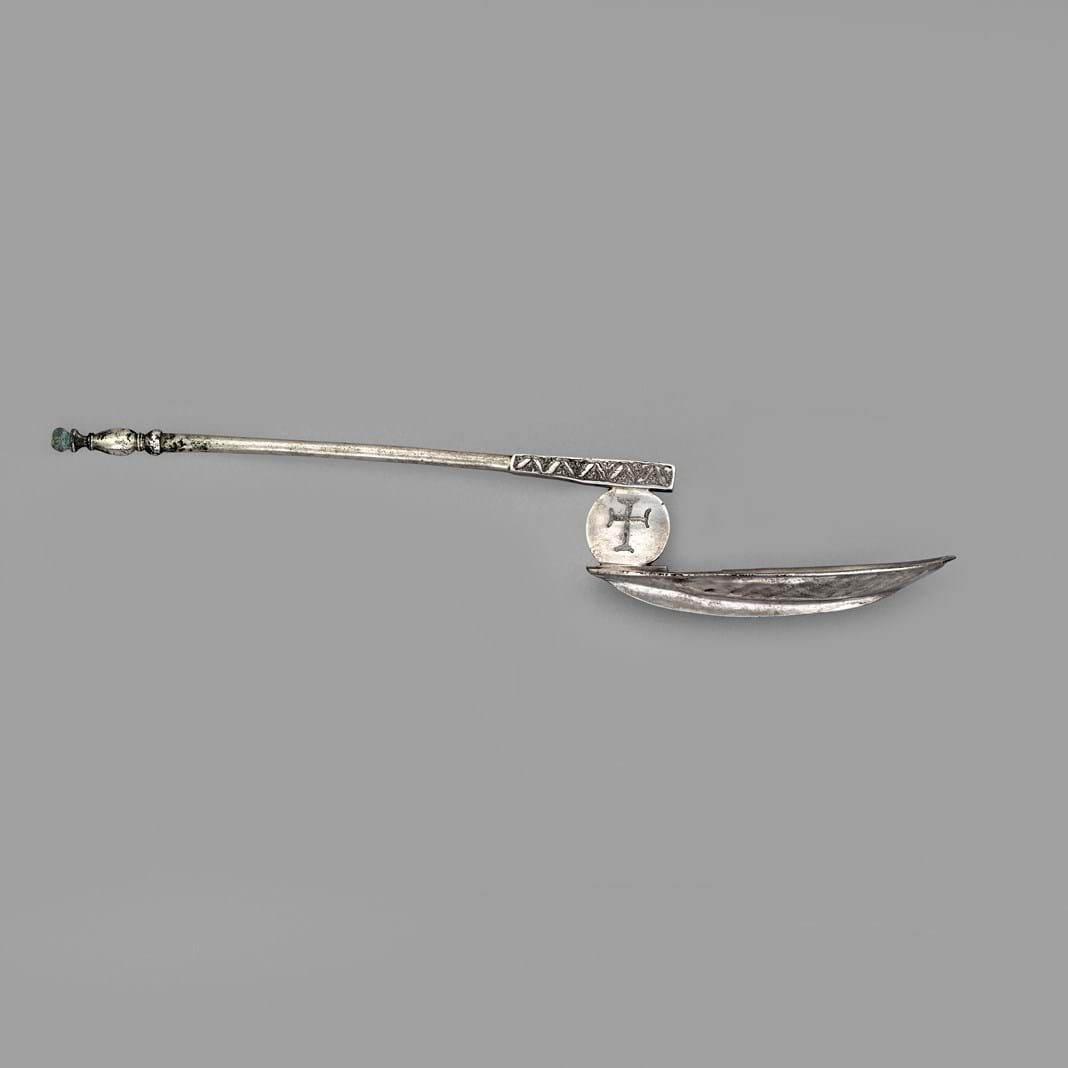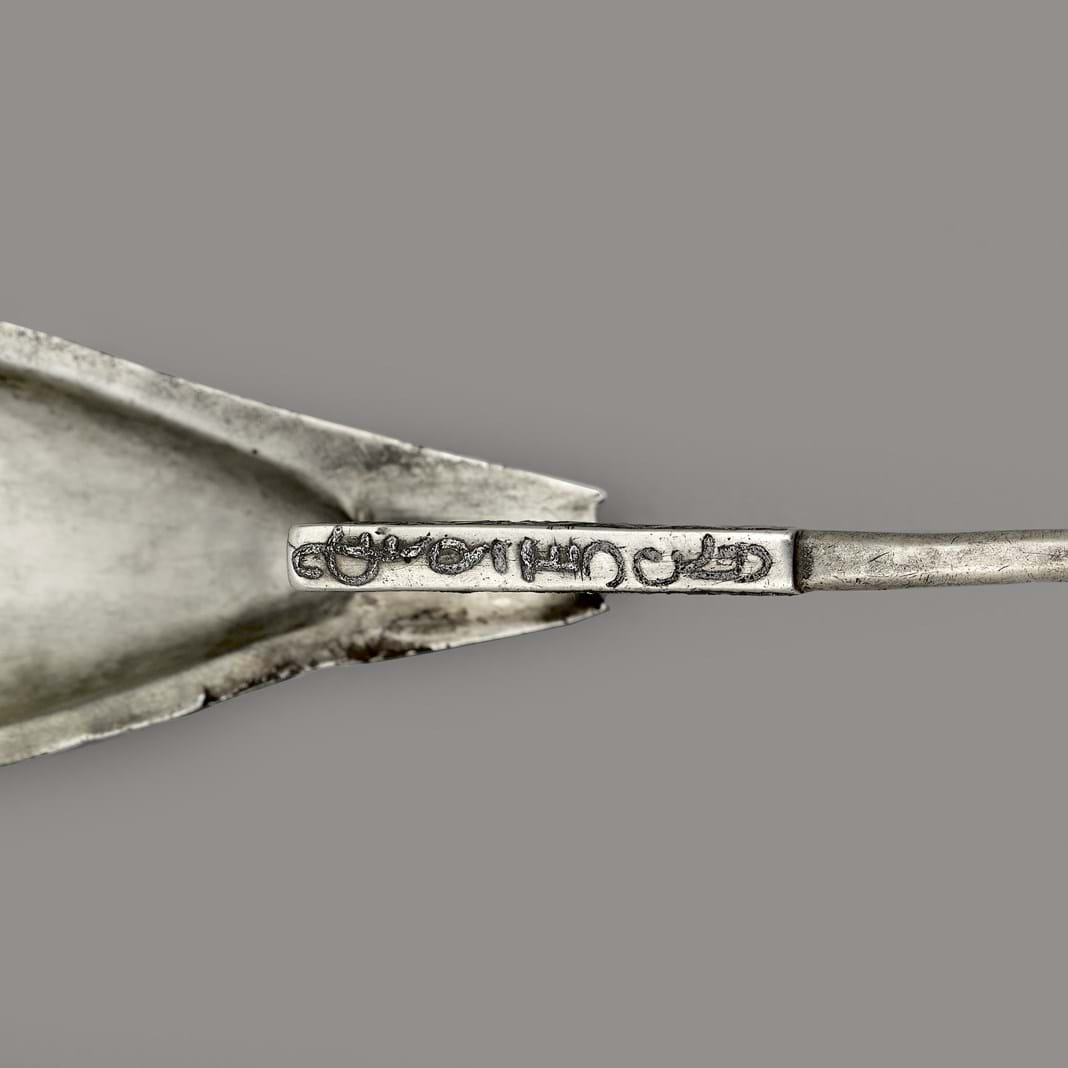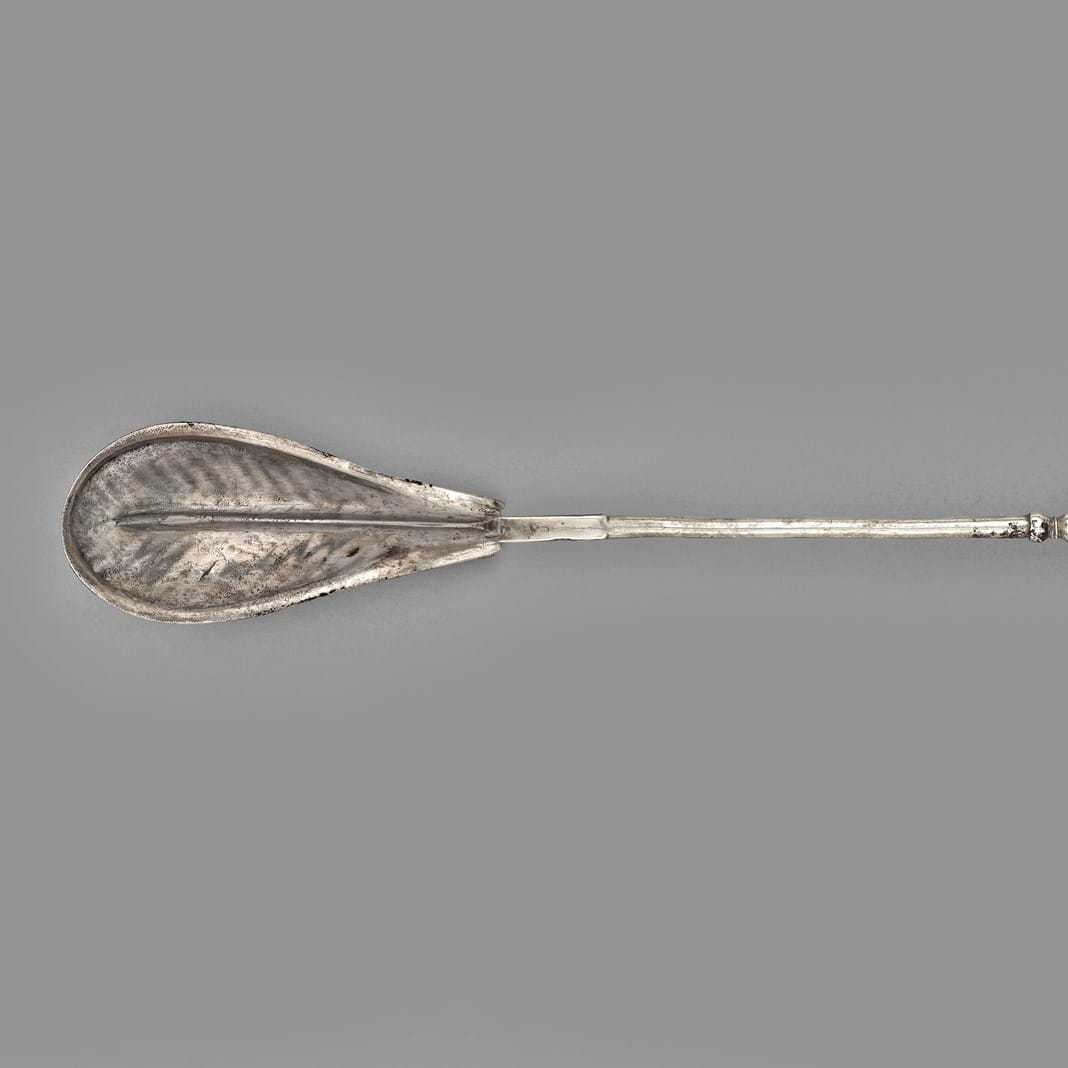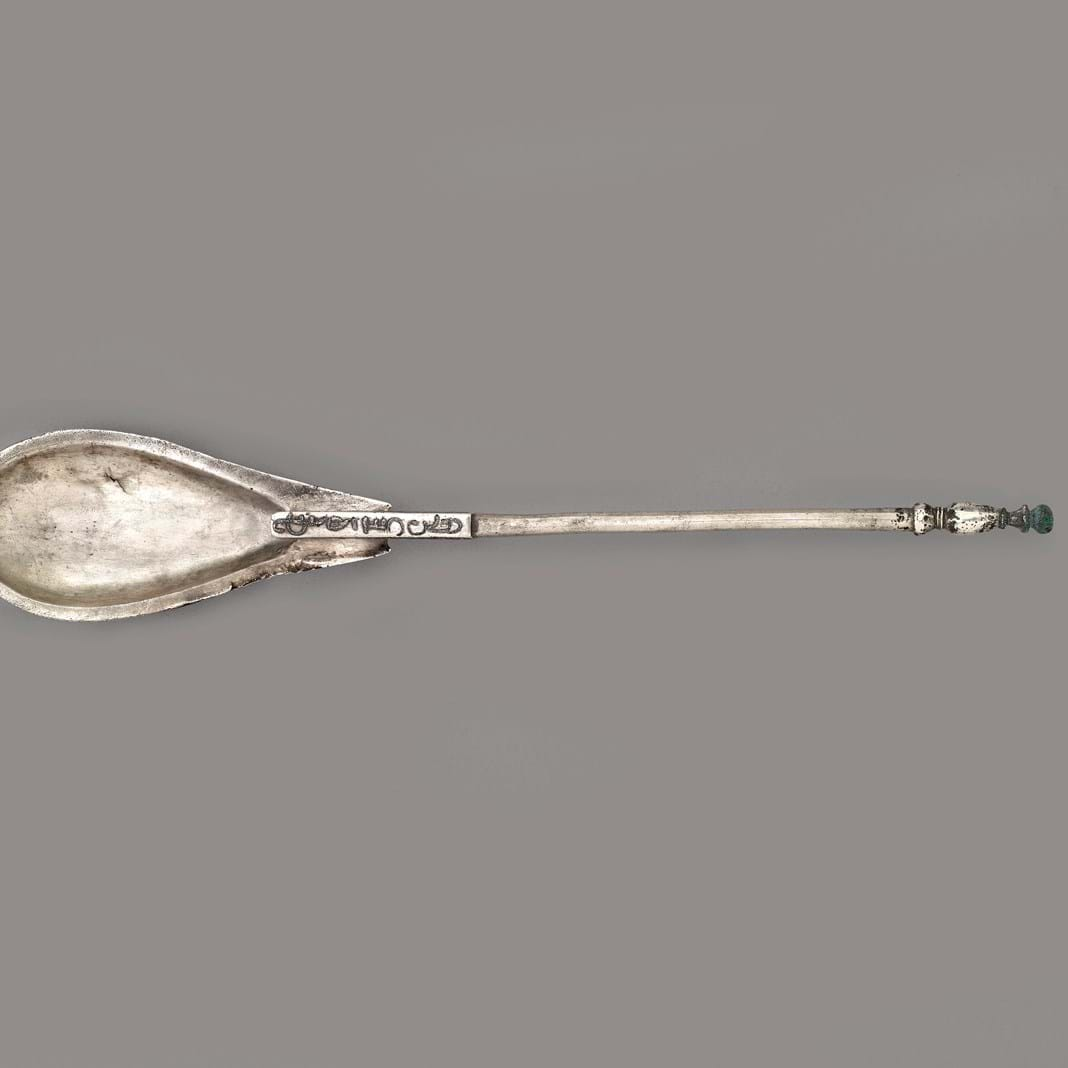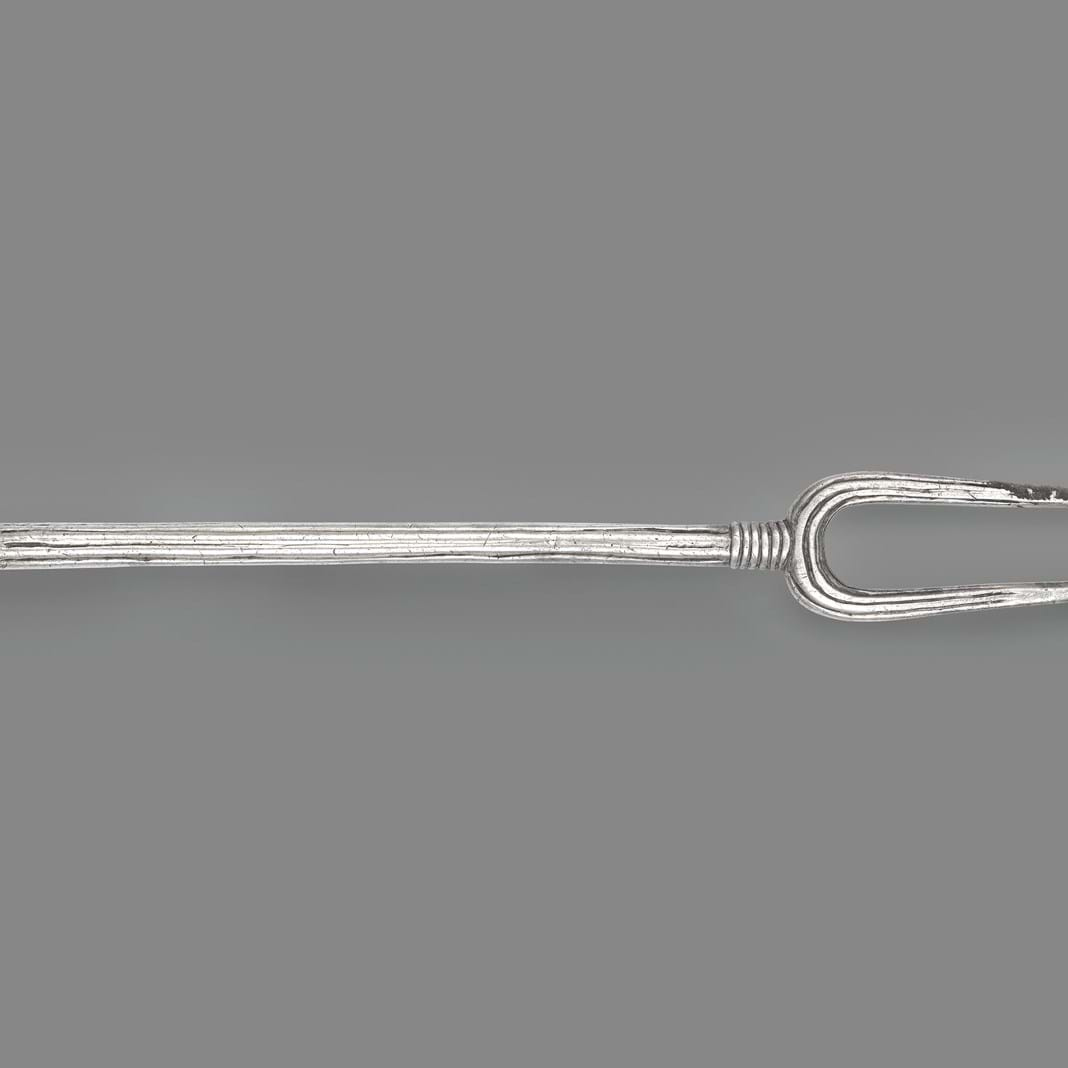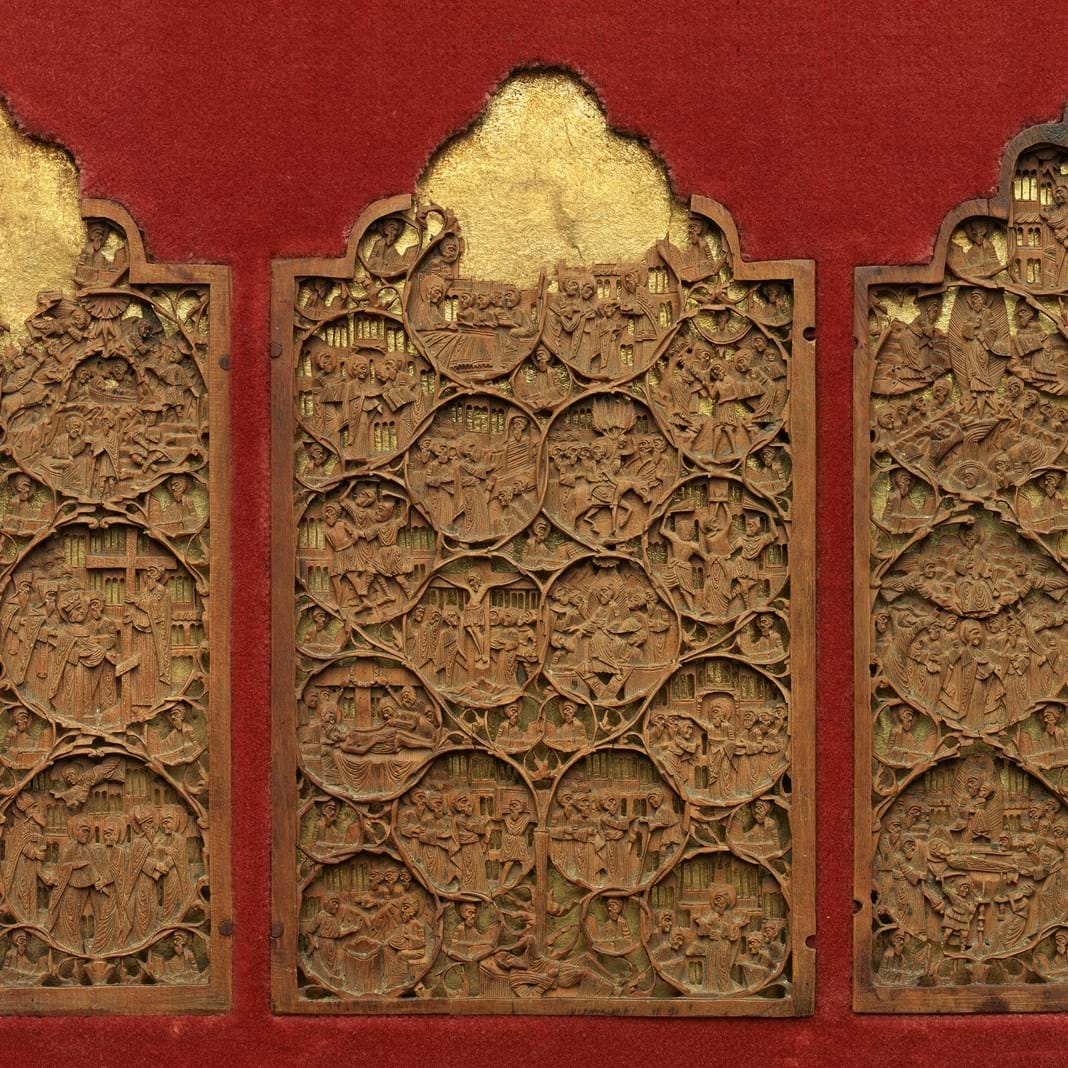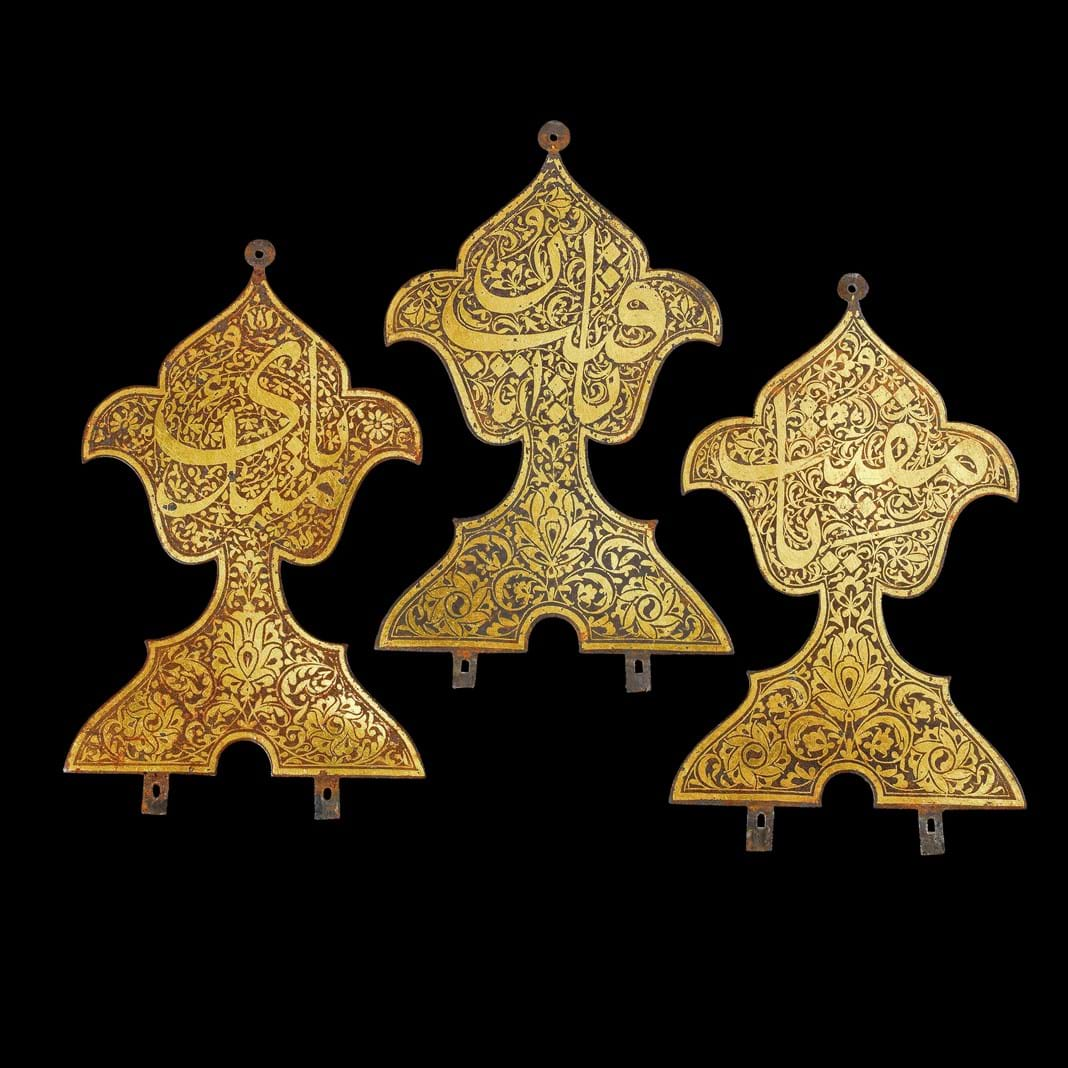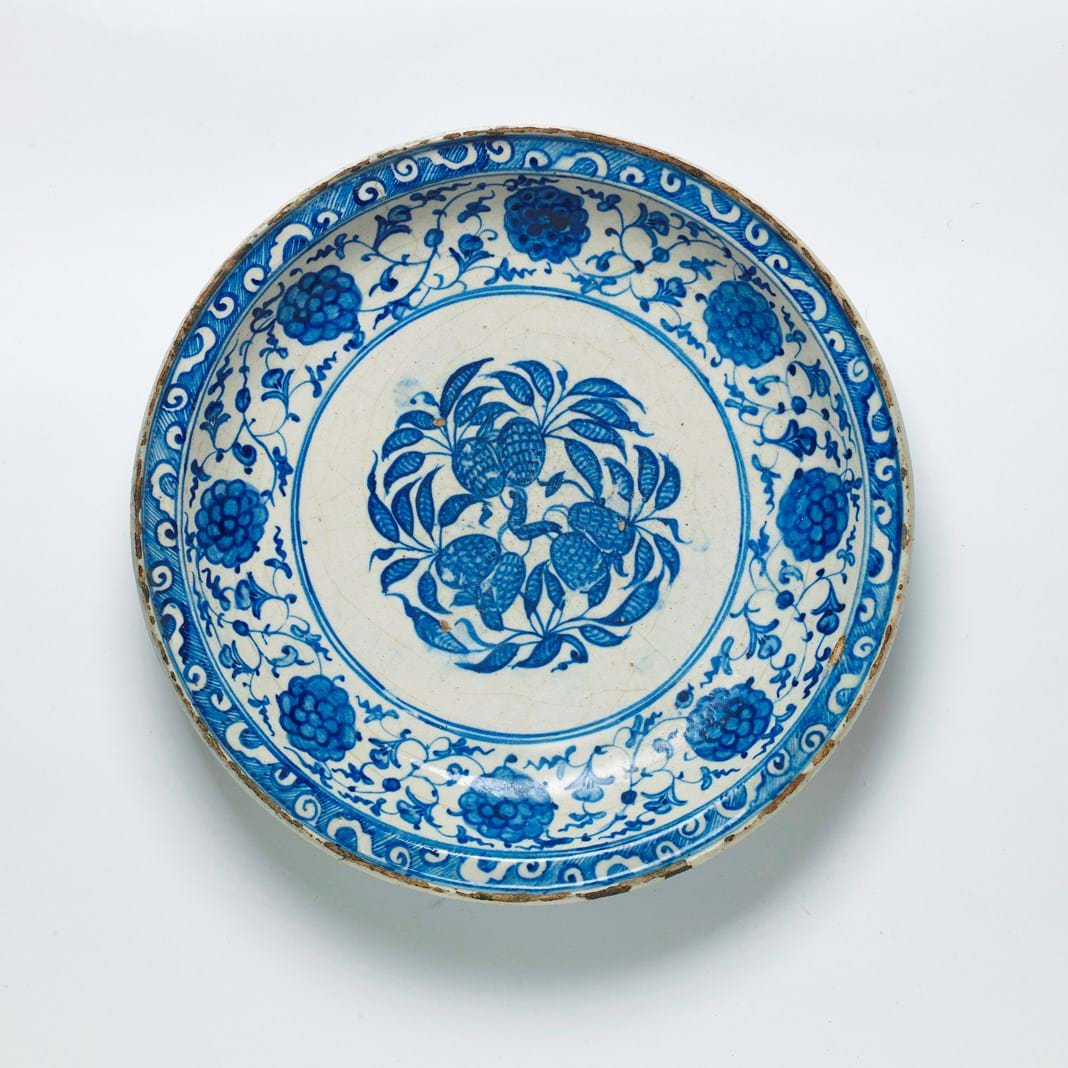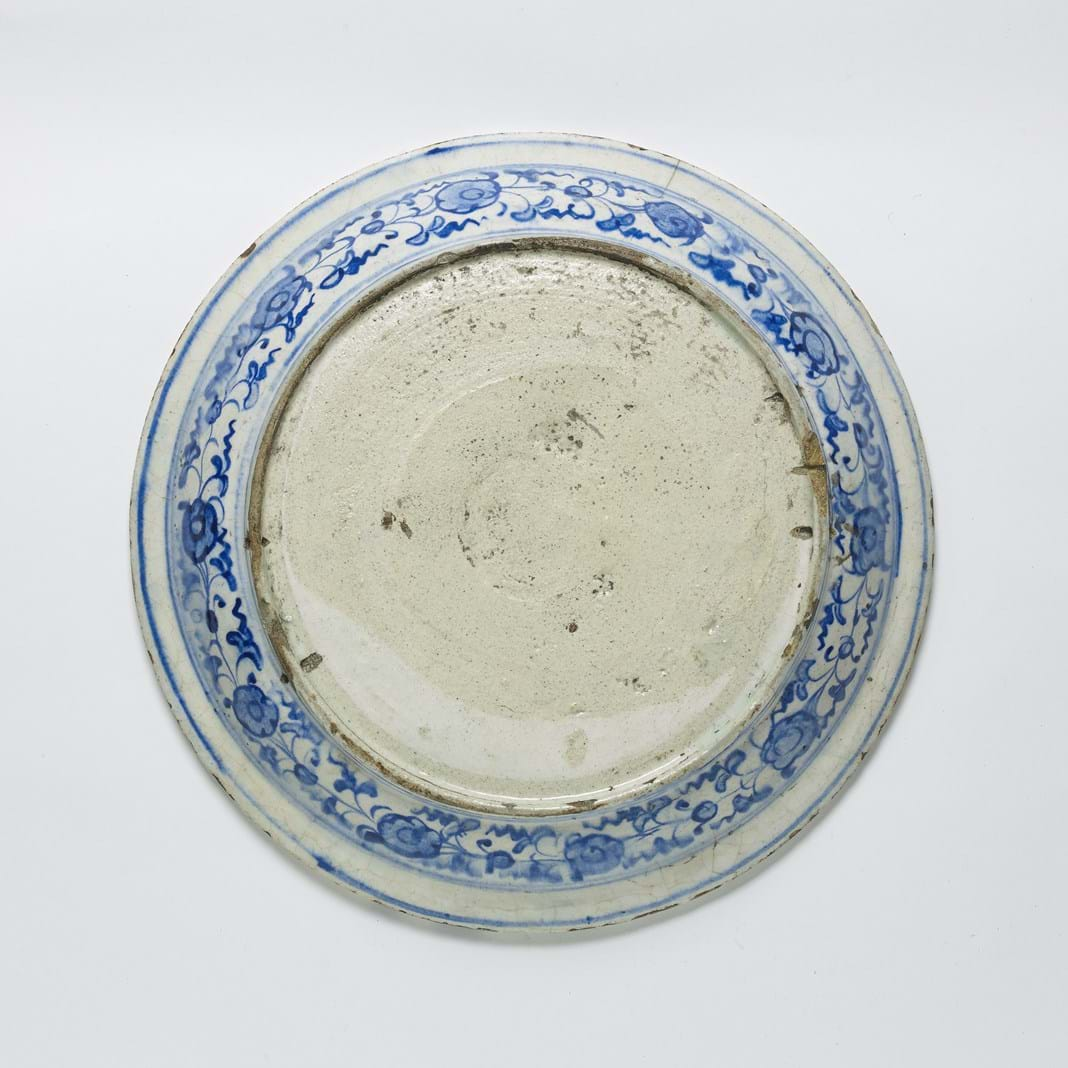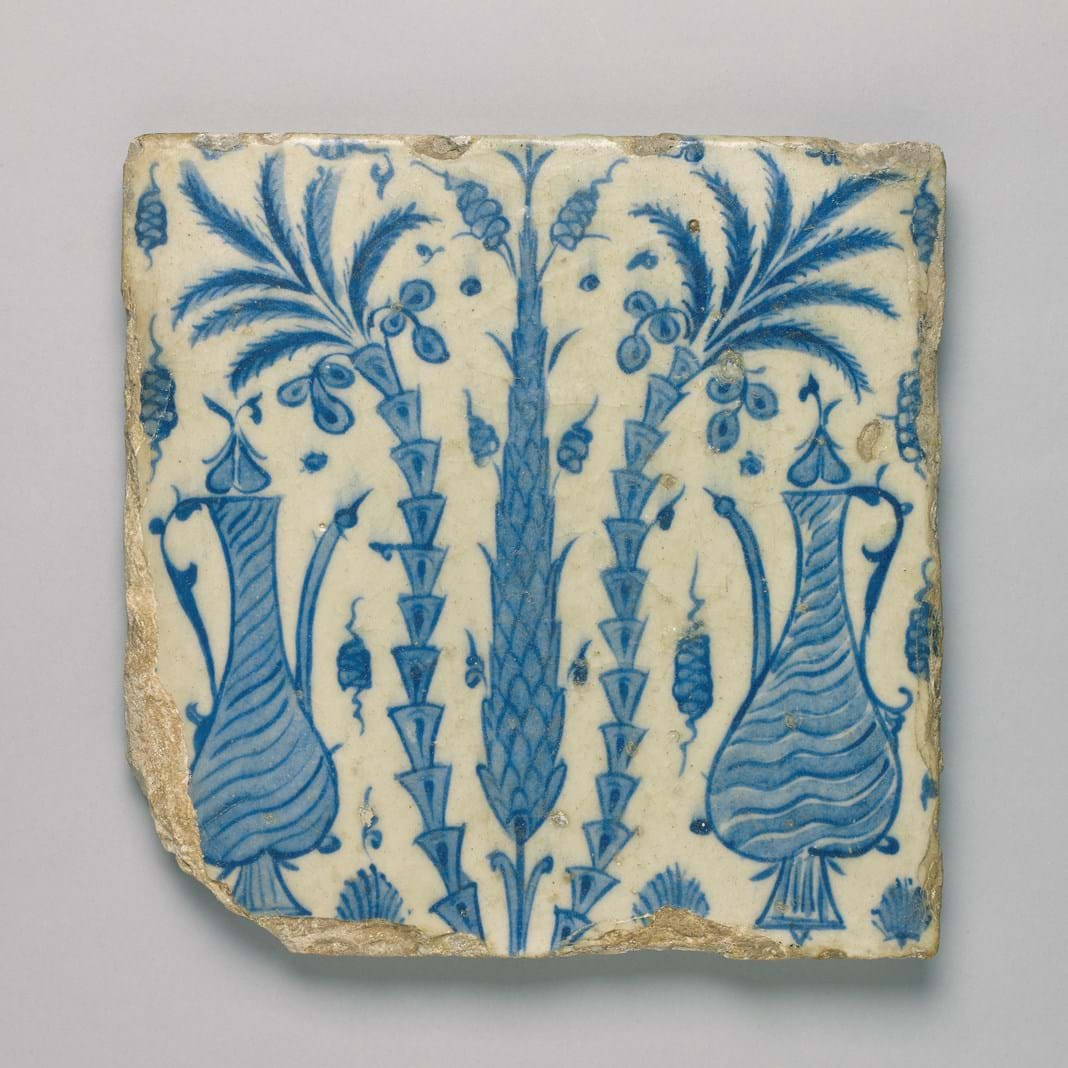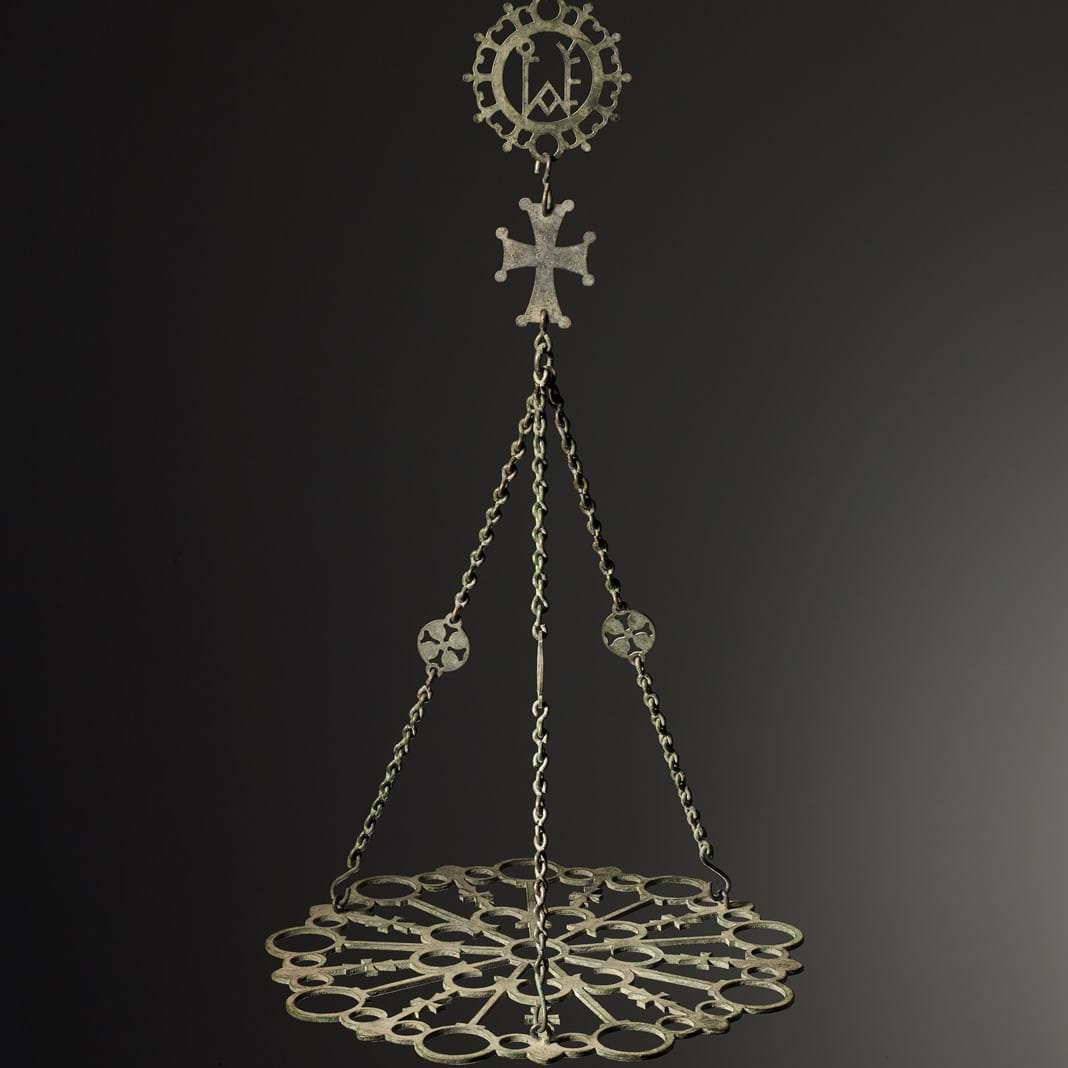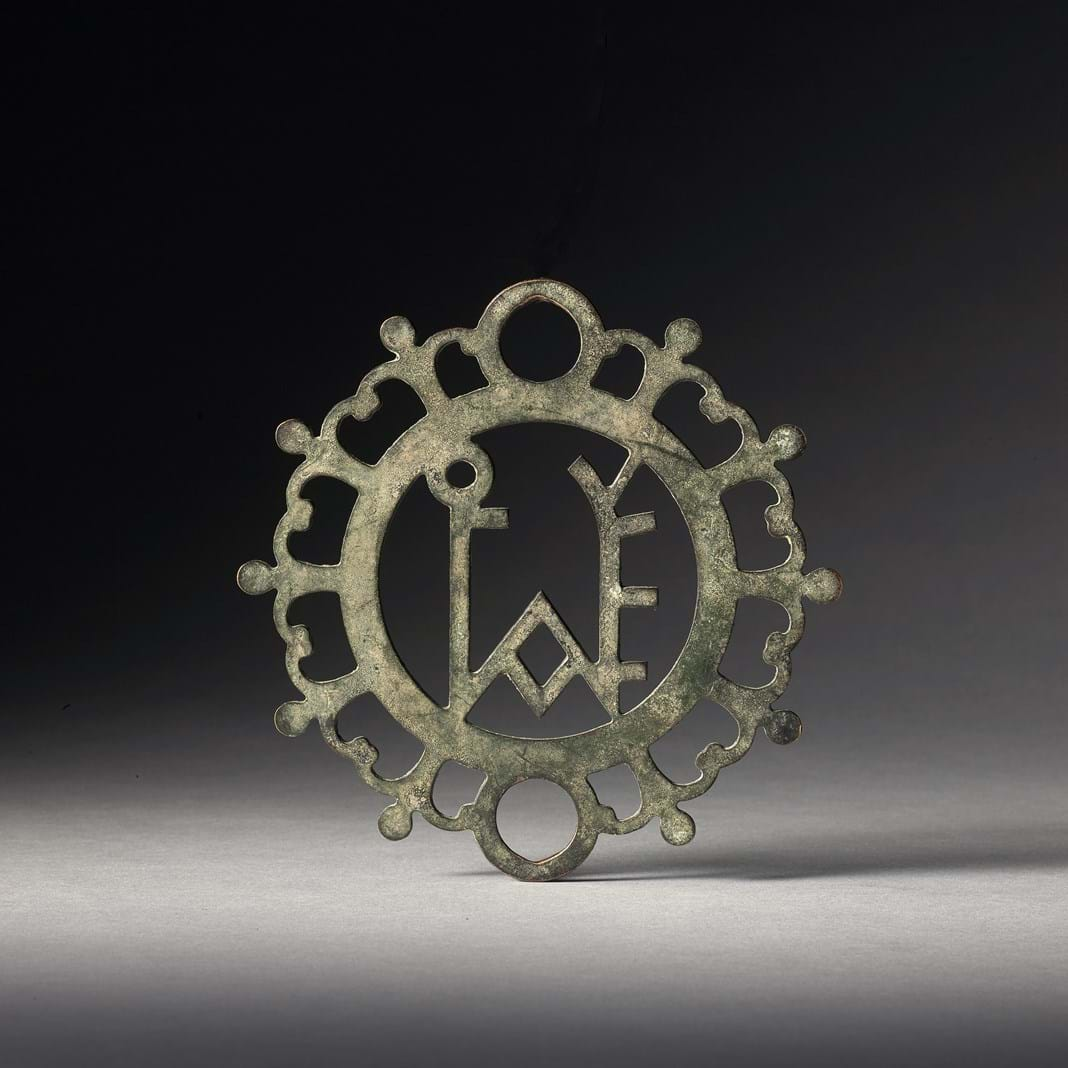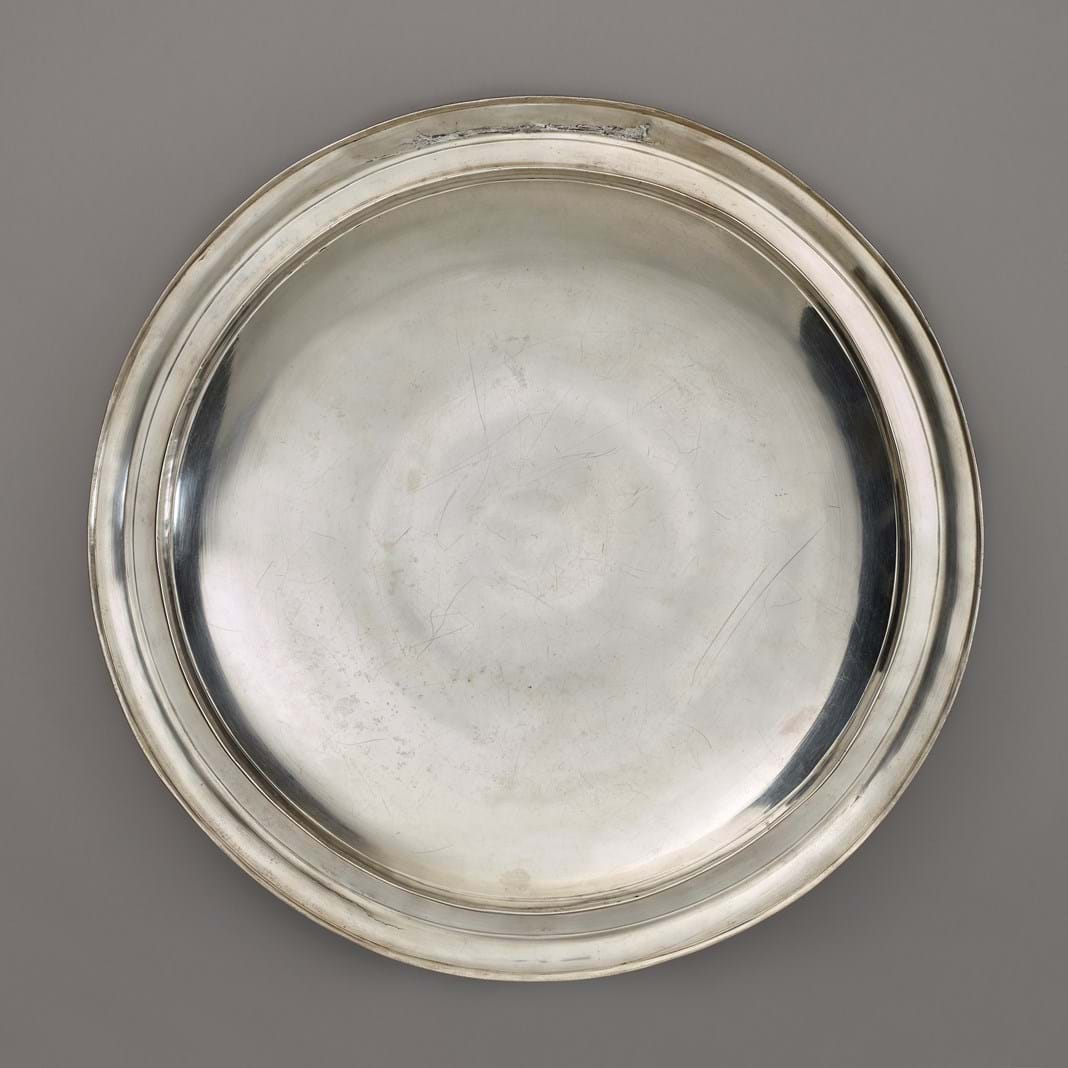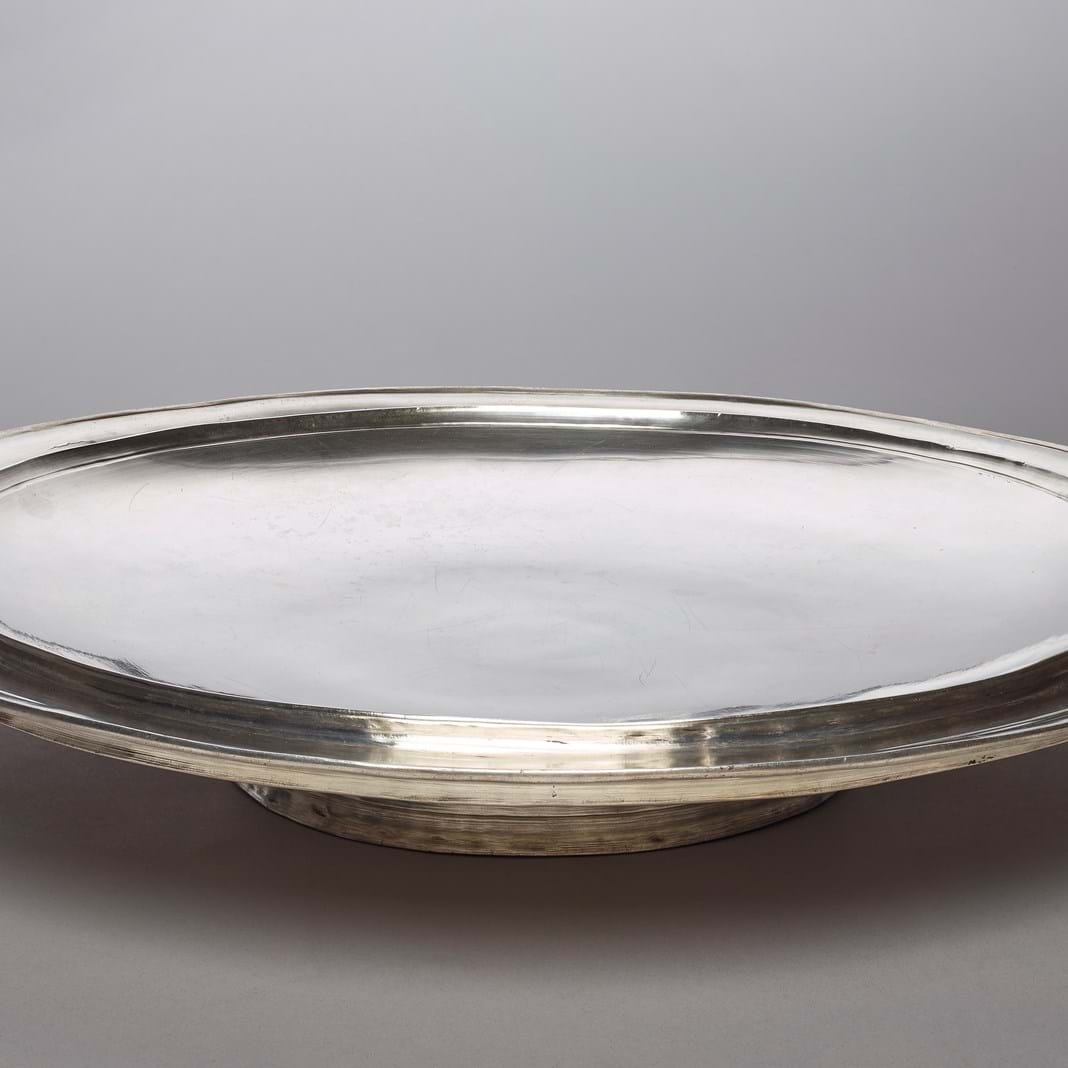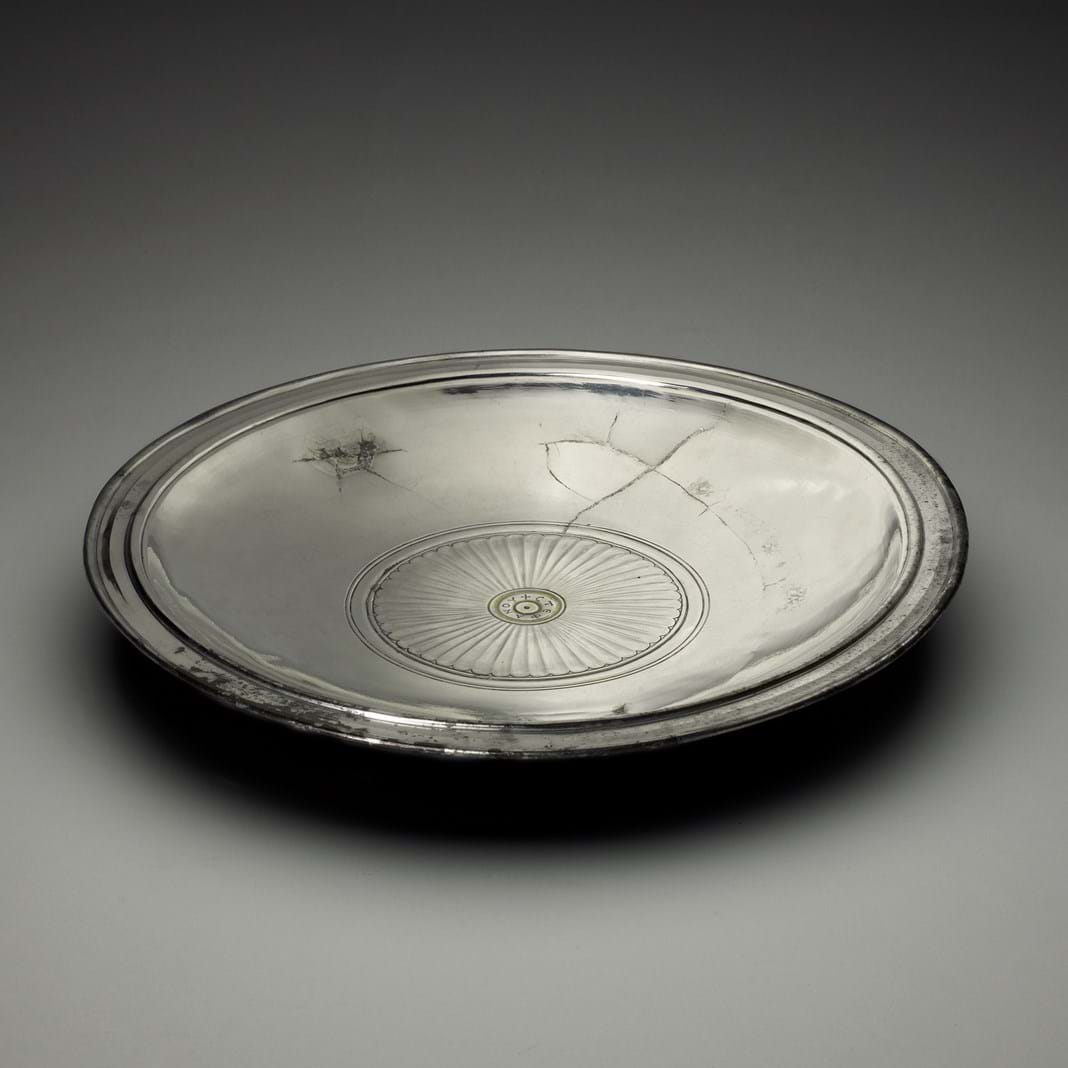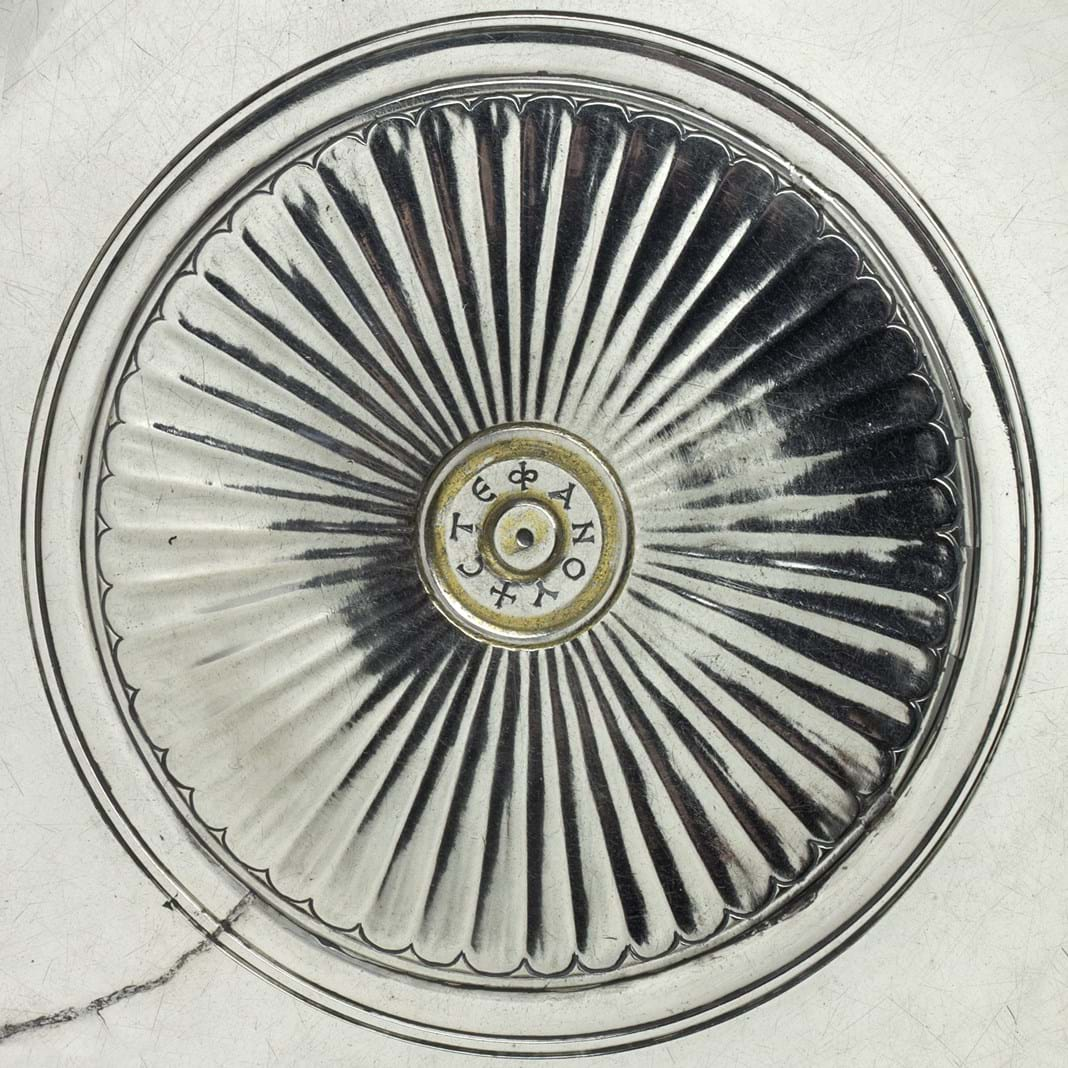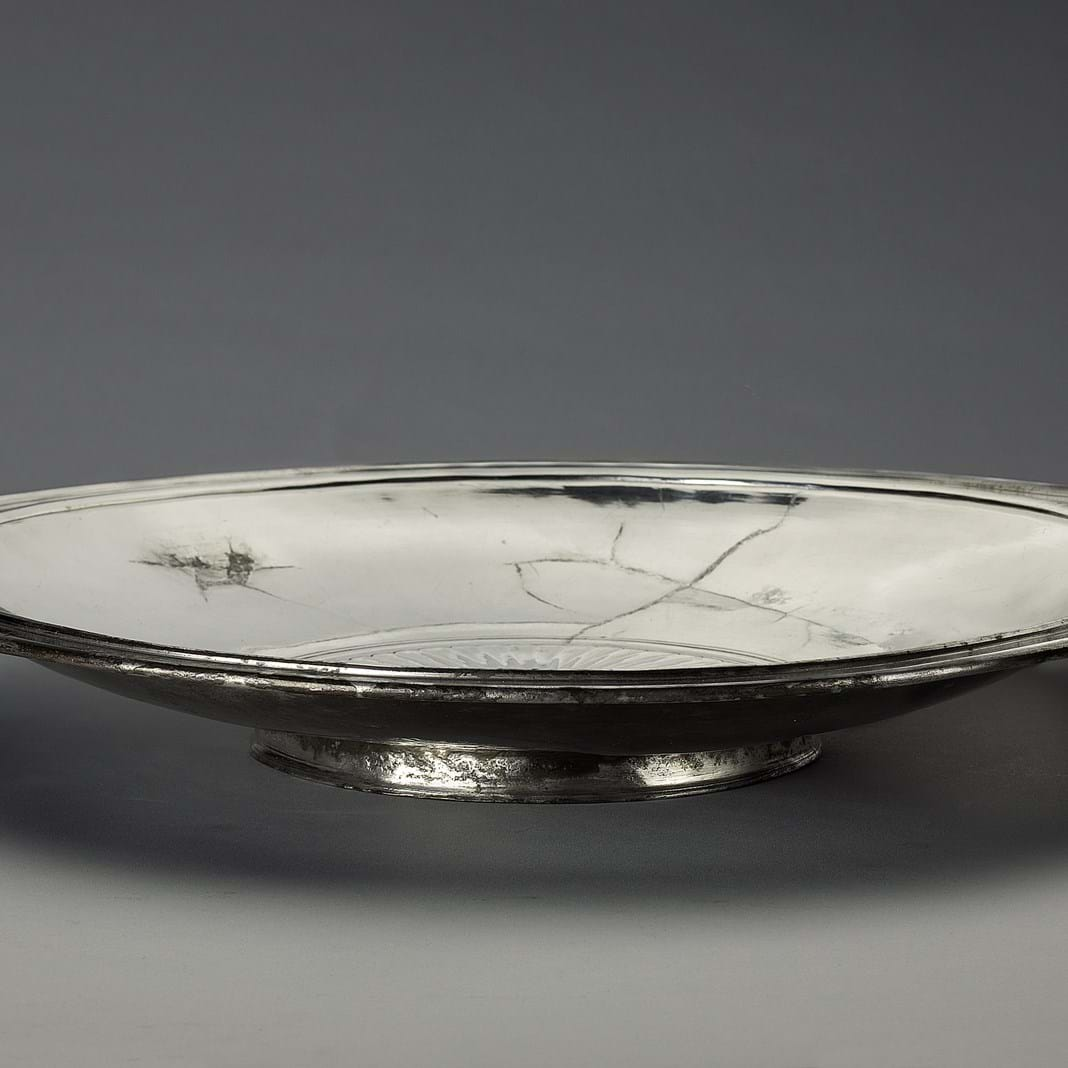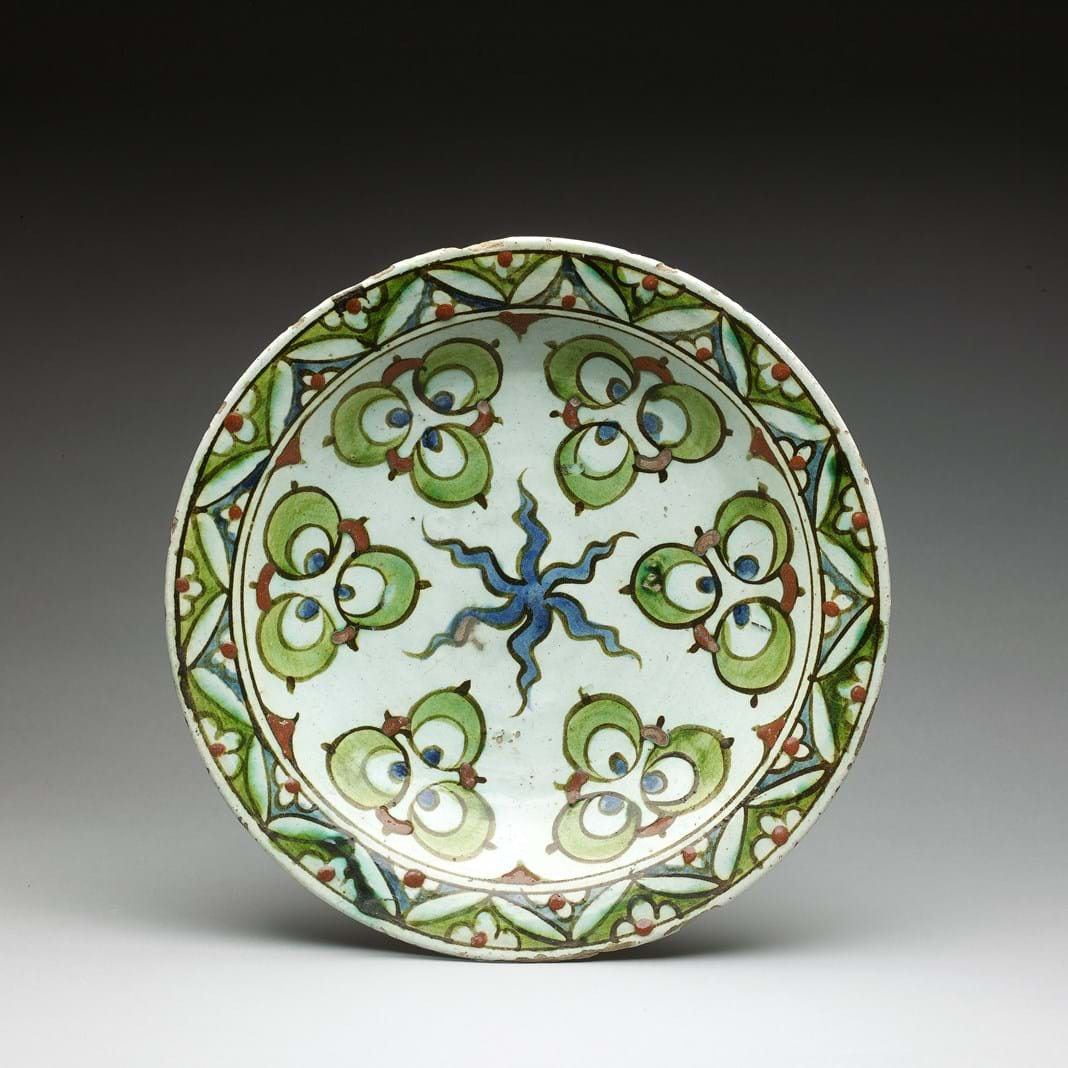Lapis lazuli cup
The convex wall of this magnificent cup is carved in relief with two busts between crosses with flaring arms. The figures, one bearded, the other beardless, are both nimbed and shown in officers’ regalia.
As to their identity, in the absence of inscriptions we cannot be absolutely certain, but they conform to the iconographic types associated with the famous military saints Theodore (bearded) and George (beardless). A laurel wreath, or ‘glory’ forms the footring which encloses a cross formed by four juxtaposed heart motifs.
Lapis lazuli, the material from which this cup was fashioned, was one of the most precious and sought-after hardstones in antiquity and the medieval world. The light parallel veining of the lapis and the presence of tiny gold flecks testify to its source being the fabled ancient mines of Afghanistan.
Origin
East Roman Empire, probably Constantinople
Date
5th - 6th century AD
Height: 5.1 cm
Diameter: 6.2 cm at rim
Provenance
Private Collection TA, U.K., by inheritance from her father (d. 1968-9)
Private Collection TG, London, 2010
Acquired by AXIA 2017
ALR Search report No. S00125977
Samanid Sari-type Nishapur slip-painted pottery bowl with central "knotted" medallionn
The "knot" consisting of two interlocking oval links, each consisting of a broad band of Kufic inscription edged with a row of pearls.
Date
9th-10th century
Diameter: 14 cm
Provenance
London Trade (D. Aaron)
Abbasid blue and white tin-glazed pottery bowl
Decorated in cobalt blue on a white ground with two lines of kufic inscription across the centre. Manijeh Bayani tentatively read the inscription: "His (God's) servant" repeated twice.
Origin
Mesopotamia
Date
9th century
Diameter: 20 cm
Provenance
Yacob's Gallery, 15/09/1999, via R. Ghavami
Exhibited / Published
Blue & White pottery from the age of Harun al-Rashid, at Axia 17 Nov. to 10 Dec. 1999, no. 5.
A deep conical pottery bowl
On a high cylindrical foot, the slip-painted white interior is decorated with a central cursive inscription in cobalt blue which reads, "May Glory be everlasting", around the rim, a meandering turquoise band. Repaired breaks; areas of light silvery iridescence.
Origin
Syria, Raqqa
Date
13th century
Height: 11.2 cm
Diameter: 23.7 cm
Provenance
Nicolier, Paris, 1960; ex-Coll. Theodor Sehmer (1885-1979)
Christie's, London, 27/04/2004, lot 304
Acquired there by AXIA
Cast silver plaque with a half-length figure of Christ in high relief
A fragment from what was once a larger object, perhaps a chalice, this cast and parcel-gilt image of Christ Pantokrator is one of the very earliest representations of the iconographic formula for the representation of the Saviour which eventually became the norm in Byzantine art.
Origin
Constantinople or Eastern Mediterranean
Date
Early Byzantine period, 6th-7th century
Height: 7.50 cm
Width: 4.60 cm
Weight: 14.46 g
Provenance
Private collection, UK
Oval medallion with the half-length figure of a martyr saint
Carved in cameo in high relief, the material of this plaque is fossilised or calcified hardwood, probably ebony. The coiffure of the saint is executed as a series of core-drilled roundels a feature characteristic of early Christian art. The same technique is used to model the coiffures of the two military saints on the lapis lazuli cup (R005116)
Origin
Constantinople or Eastern Mediterranean
Date
Late Roman, Early Byzantine period, ca. 6th century
Height: 4.50 cm
Width: 3.50 cm
Provenance
Haddad Brothers (importation document dated Jan 2001)
A pair of parcel gilt silver bracelets with coloured glass inlays
Each with a broad, flat wrist band with three openwork roundels contained within panels formed by a cable-work border. Hinges at both ends attach the curved wristband to a rectangular front panel. Of tray form, this panel is lightly engraved with a large gilded pattée cross and embellished with yellow glass inlays contained within silver cloisons; an oval one at the centre with four tear-shaped ones at the corners; between them smaller ones in red glass. Note the similarity in the shape of the cross with the one on the spoon R005057
Origin
Eastern Mediterranean
Date
6th-7th century
Size / Dimensions
Front panel: 5 x 4 cm. Width: 6 cm. Weight: 69.72 g
Provenance
Private collection, UK
Parcel gilt hanging oil lamp with suspension chains
In the shape of a waisted cup on a trumpet-shaped high foot thie lamp is worked in repoussé and partially gilded. In size and decoration this lamp is practically identical to a piece in a private collection suggesting the two were once a pair (see: Spier, J., Treasures of the Ferrell Collection, Wiesbaden, 2010, p.278, cat.198)
Origin
Constantinople or Eastern Mediterranean
Date
Late Roman-Early Christian period, 5th-7th century
Height: 11 cm (lamp); 32.9 cm (incl. susp. Chains)
Weight: 102 g
Provenance
Haddad Brothers (importation document dated Jan 1992)
Parcel gilt flask or finial
The shape is a miniature version of the large ceramic oil or wine containers with a pointed bottom for setting them in sand at the cargo hold of a ship. That would suggest a similar use for this object as a small flask. However, an almost identical object in a private collection is described as a furniture terminal (see: Spier, J., Treasures of the Ferrell Collection, Wiesbaden, 2010, p.292, cat.213)
Origin
Constantinople or Eastern Mediterranean
Date
Late Roman-Early Christian period, 6th-7th century
Height: 11 cm
Weight: 39 g
Provenance
Haddad Brothers
Opus sectile panel with a Musenna inscription reading ‘Muhammad’
Like the technically identical Ispenian panel (C001513), the origin and date of this piece is mysterious too. With bold blue letters in Thuluth script arranged in mirror image against a bright yellow ground, it is composed of ceramic tile elements with a red earthenware body covered with an opaque monochrome glaze.
On epigraphic grounds, and if it were not for its undeniable similarity to the Ispenian panel, one would be inclined to place this within the Ottoman world, where we find examples of calligraphy in mirror image (Musenna) as far back as 1500 in book illumination and from at least 1600 painted on tiles. But they all have one thing in common; they are associated with Sufi brotherhoods. Indeed, the rendering of the word Muhammad on this piece appears in a very similar fashion on a 19th-century Sufi drawing.
Origin
Central Islamic Lands
Date
18th century or possibly much earlier
Height: 28.5 cm
Width: 35.6 cm
Provenance
Sotheby's, London, 02/04/2009, lot 124
Acquired there by AXIA
Opus sectile panel with a Kufic inscription reading ‘God is my Master’
To this day, the origin and date of this dramatic ceramic panel in two strongly-contrasting colours remain a mystery. With bold yellow letters against a green ground, It is composed of ceramic tile elements with a red earthenware body covered with an opaque monochrome glaze. These have been cut and juxtaposed to form the pattern. Known as opus sectile, the technique harks back to Roman times. In the Islamic world it is usually associated with tile revetments of the Timurid period. There, however the body material is white, the colour palette is broader, the glazes more translucent and the aesthetic notably different.
In the absence of any recorded monuments with related mosaics, opinions as to the origin of this sui generis panel range from Morocco all the way to northern India, and from the 10th to the 18th century. In the hand-written 19th-century inventory of the Ispenian collection in Cairo, it was recorded as having been acquired from Mosul. Although a priori unlikely, this claim gains some credence by the arrangement of the kufic letters to form a circular medallion, a formula we find on Abbasid coinage and on an early Islamic fresco fragment in the Damascus Museum.
Origin
Central Islamic Lands
Date
18th century or possibly much earlier
Height: 57 cm
Width: 55 cm
Provenance
Ispenian Collection, Cairo, before 1900
Georges Antaki Collection, 1960s
Acquired by AXIA in 1990
Exhibited / Published
UNESCO greeting card in 1990-91
'Reflections of China in an Islamic Mirror' at AXIA for Asian Art in London, 19/11 to 4/12/98, no. 10
A marble water basin carved in high relief
Of bulbous form with a flat rim, the basin sits on a narrow circular foot. At the top, protruding in a cruciform arrangement, four substantial, everted and bulging flanges. The exterior surface is covered in its entirety in a complex arabesque consisting of a variety of split-leaf forms carved in high relief. The pattern divides the surface into four lobed arches, one of which is outlined by a band of calligraphy in kufic script. Further kufic inscriptions below the rim; intact.
Inscriptions:
On the body, the basmala; around the rim, “May it be wholesome” and “May recovery be tender”
The association of these inscription with health, suggests that this basin could have been made for a maristan, (a place of healing for physical and mental ailments run by a pious foundation), where, filled with water, it would have occupied a prominent position, probably on a pedestal at the centre of a courtyard.
Comments
We cannot be certain of the function of the basin. The absence of a hole at the bottom precludes its being a fountain. It is more likely to have been a container for drinking water. Coming to its bulbous form, it echoes the general shape and volume of Byzantine ‘basket’-type column capitals of the 6th century. At first sight, this would suggest it could have been a spolium, a piece from a disused earlier Christian building re-carved in the Islamic period. Closer examination of such capitals, however, shows that their overall form would not allow for the creation of the four prominent protrusions at the corners of our basin. Should it have been a spolium, therefore, the original is much more likely to have been a Late Roman or Early Christian Corinthian style capital, whose prominent acanthus-leaves at the corners could be re-carved into the present shape.
As for the decorative arrangement on the body and the treatment of the foot, we find echoes of these on a 13th-century Ayyubid marble basin from Hama in the Victoria and Albert Museum, London (museum number 335-1903). Closer to the date of our basin, however, are two marble corner posts with domed terminals in the David Collection, Copenhagen (Kjeld von Folsach, Art from the World of Islam in the David Collection, Copenhagen, 2001, p. 245, no. 392). They have similar kufic inscriptions and scrolling foliate decoration based on the split-leaf form. A direct comparison is also provided by the horizontal inscription and the interlacing arabesques on a marble mihrab panel attributed to the early-13th-century, Zangid dynasty that sold a few years ago at Sotheby’s (Arts of the Islamic World, 06/10/2010, lot 136).
For further comparisons, see: Ernst Herzfeld, “Damascus: Studies in Architecture, II. The Cruciform Plan. Syrian Architecture, Period of Nur-ad-Din”, Ars Islamica, X, Freer Gallery of Art, The Smithsonian Institution and Department of the History of Art, University of Michigan, 1943
Origin
Syria or Mesopotamia (Jazira)
Date
11th/12th century
Height: 40 cm
Width: 61.5 cm (max)
Diameter: 45.5 cm (rim)
Provenance
George Moro, Montreal Canada, 1982
Private collection, Montreal (acquired from GM's widow in 1992)
Bonhams, London, 23/04/2013, lot 22
A remarkable matching set of 12 early Byzantine silver serving spoons
The shape and construction of this exceptional set of spoons each consisting of a long slim handle, a pear-shaped bowl and a round disc which connects the handle to the bowl in a stepped joint, is of the standard Late Roman / Early Byzantine type known as a ligula. Their larger than normal size and the absence of a pointed tip to the handle for spearing food morsels, indicates that they were intended for serving rather than for eating.
The interior of the bowls is plain and lightly engraved with a parcel gilt cross (much of the gilding now lost). The exterior is chased and was inlaid with niello (much of it now also lost). It is decorated with two facing peacocks perched on scrolling vines flanking a cross and edged with a narrow border of stylised waves.
The thin long shafts of the handles are made of a single piece of solid silver, but are fashioned in two parts; a short length of hexagonal section at the bowl end, followed by a much longer part of round section which flares gently outwards towards the tip. The facets of the hexagonal part are chased with alternating bands of scrolls and stylised waves, while the surface of the round part is covered in its entirety by a finely-engraved honeycomb pattern, each hexagon of which contains a small cross.
The circular disc of tapering section which provides the stepped joint between handle and bowl is engraved on one side on all 12 spoons with the same monogram which reads IΩANNOV, ‘of John’ or ‘belonging to John’.
In Late Antiquity the control of production and distribution of all silver, including tableware, was under the authority of the emperor. Its use and possession, however, was not restricted to the highest imperial ranks, but could be purchased for personal use by wealthy private citizens. Thus fine tableware formed part of the contents of every aristocratic household. Indeed, the price of silver was not so exorbitant as to prohibit members of the upper-middle-class from affording single pieces. Although archaeological finds document the presence of late Roman luxury tableware across Europe and all the way to Scotland, it is generally accepted that the custom of using precious utensils for eating originated in the eastern parts of the Roman Empire.
As for this unique matching set, the presence of 12 identical serving spoons indicates it would without doubt have graced the banquets of a very grand household. Its survival provides poignant testimony to the cultural sophistication of the Eastern Mediterranean in the early Byzantine period. The delicate craftsmanship of the beautifully engraved bowls and the elegance of the handles, attests to their having been fashioned in a metropolitan workshop catering to an aristocratic clientele. The most likely place for the manufacture of this set therefore is likely to have been the Empire’s capital, Constantinople, although one cannot exclude some of the other great cities of the Roman East such as Alexandria, Antioch, or Nicomedia.
Coming to a dating of this set, the formula of the monogram with the letters in a cruciform arrangement first appears during the reign of Justinian in the mid-530s and become commonplace soon after. Another pointer is the similarity of the decoration on the bowls’ exterior with marble reliefs from Ravenna dating from the middle and the 2nd half of the 6th century. Taken together, a similar date seems appropriate for this set.
Origin
Constantinople (?)
Date
Early Byzantine period; 6th –7th century
Length: 23 cm
Size / Dimensions
Weight (each): ranges from 66.97 g to 76.58 g
Weight (all 12): 863.31 g
Provenance
Private collection
Rock crystal cosmetics bottle or container in the shape of a fish
Origin
Constantinople or Eastern Mediterranean
Date
Late Roman-Early Christian period, 3rd-5th century
Length: 8.5 cm
Provenance
Micheal O'Hara 1968
Private collection UK until 2002
NM, London (acquired 2002)
Gilt silver belt buckle in the form of a scallop shell
For a a similar set of buckles, see: Spier, J., Treasures of the Ferrell Collection, Wiesbaden, 2010, p.294, cat.214
Origin
Eastern Mediterranean
Date
Late Roman-Early Christian period, 6th-7th century
Height: 6.5 cm
Width: 8 cm
Weight: 673 g
Provenance
Haddad Brothers
Egg-shaped ceramic hanging ornament from a Mosque lamp
Origin
Ottoman Turkey, Iznik
Date
Ca. 1565-1575
Height: 17 cm
Provenance
Artcurial, Paris, 11/04/2013, lot 162
Acquired there by AXIA (and exported with French passport)
Deep hardstone bowl in shades of browns and reds in a marvered pattern
Date
Late Roman - Early Byzantine period; 4th-5th century
Height: 7.80 cm
Diameter: 31 cm
Timurid epigraphic cut-tile mosaic panel
Once part of a monumental inscription executed in opus sectile, a mosaic technique where the elements of design elements are cut to shape and fitted together to form the desired composition. The material from which the pieces of this mosaic were cut was provided by brilliantly-glazed monochrome tiles fired in deep cobalt blue, rich ochre-yellow, emerald green and light blue
A complete frieze in similar colours and style appears above the entryway to the foundation of Muhammad Sultan in the Gur-i Amir in Samarqand, Uzbekistan (illustrated in: Chuvin, P., and Degeorge, G., Samarkand, Bukhara, Khiva, Paris, 2001, pp.14-15)
Origin
Central Asia
Date
Timurid Period; late 14th - early 15th century
Height: 44 cm
Width: 52.5 cm
Size / Dimensions
Mount size: 53 x 63 cm
Provenance
Collection of Carl Johan Lamm (1902 – 1981), Sweden
Sotheby’s London, 29/04/1992, lot 93 (part of)
Acquired there by AXIA
Iznik plate
With a sloping rim on low foot, the unusually asymmetric, bold composition consists of a large saz leaf and floral sprays within a wide ‘wave and rock’ scalloped border. Condition: one clean break expertly restored.
Origin
Ottoman Turkey, Iznik
Date
Ca. 1575-1580
Diameter: 30 cm
Provenance
Artcurial, Paris, 11/04/2013, Islamic sale lot 140
Acquired there by AXIA (and exported with French passport)
Exhibited / Published
Couleurs d'Orient, Arts et arts de vivre dans l'Empire ottoman, Villa Empain, Fondation Boghossian, Brussels 18/11/2010 - 27/2/2011, (cat. p. 20)
Iznik plate
With a sloping rim on low foot, the ‘wave and rock’ border encloses a field bursting with tulips, roses, carnations and hyacinths on broken stems. This is an excellent example of the 'storm in a teacup' composition characteristic of some of the best Iznik plates in the ‘quatre fleurs’ style.
Origin
Ottoman Turkey, Iznik
Date
Ca. 1580-1585
Diameter: 31 cm
Provenance
Artcurial, Paris, 11/04/2013, Islamic sale lot 151
Acquired there by AXIA (and exported with French passport)
Iznik pottery tile with a ‘Rumi’ arabesque pattern
With lotus palmettes and split-leaf arabesques in a quatrefoil arrangement. Painted in cobalt blue, bole-red and turquoise outlined in black.
Origin
Ottoman Turkey, Iznik
Date
ca. 1570
Height: 24.5 cm
Width: 23.6 cm
Provenance
Bonham’s, Knightsbridge, 16/10/2003, lot 247
Acquired there by AXIA
A pair Iznik polychrome border tiles on a brushed cobalt blue ground
They are decorated in bole-red and green outlined in black with lotus-palmettes on arching stems with attached pairs of serrated saz leaves. The sharpness of the drawing, the absence of any bleeding of the colours into one another and the perfect hue and density of the relief red, mark these as belonging to the heyday of polychrome ceramic ware production in Iznik during the reign of Murad III.
Origin
Ottoman Turkey, Iznik
Date
ca. 1570-80
Width: 12 cm each
Length: 27 cm each
Provenance
UK private collection since at least 1896 (newspaper fragment of that date found by restorer inside old frame)
Sotheby's, London, 15/10/2003, lot 49
Acquired there by AXIA
Iznik pottery tile
Painted in cobalt blue, bole-red and green with lotus palmettes, saz leaves and an 'S'-spray of prunus blossoms on spiralling stems
Origin
Ottoman Turkey, Iznik
Date
ca. 1580-1585
Height: 24.7 cm
Width: 25.8 cm
Provenance
Collection of the great Islamic glass specialist, Carl Johan Lamm, Sweden
Sotheby’s, London,13/10/1982, lot 209
Acquired there by AXIA
Gold ring with enthroned Tyche - Fortuna
Origin
Rome or Constantinople
Date
5th century AD
Size / Dimensions
Diameter of bezel: 2.65 cm. Diameter of hoop: 2.72 cm. Weight: 14.99 g
Approx. ring size: UK O; USA 7½; EU 55¼; Japan 14
Provenance
Private collection, Alexandria 1930s-1956
Private collection Belgium 1956-1978
Acquired by AXIA in 1978
Gold pendant cross
It is in the form of a croix pattée (cross with paws) whose arms flare outwards from a central roundel with a pearl set in the middle and culminate in four similar discs framed by the eight round terminals of the arms of the cross (the paws of the croix pattée). The entire surface is executed in fine filigree, a technique which finds parallels in the contemporary jewellery of Fatimid Egypt and which continues in the Greek islands well into the Ottoman period.
Origin
Constantinople (?)
Date
Middle Byzantine period, 10th-12th century
Height: 4 cm
Width: 3.03 cm
Weight: 4.71 g
Provenance
Private collection, England
Acquired by AXIA from MN, London in 2017
A selection of gold and silver finger-rings with ‘box-shaped’ monograms
Origin
Eastern Mediterranean
Date
5th-6th century AD
A selection of gold and silver finger-rings with cruciform monograms
Origin
Eastern Mediterranean
Date
5th-6th century AD
A selection of gold marriage & betrothal rings
Origin
The late Roman World in East and West
Date
6th-7th century AD
Gold and cloisonné enamel miniature pendant cross
It is in the form of a croix pattée (cross with paws) with straight arms. In keeping with this type of middle-Byzantine cross, the arms spring from a central roundel and culminate in four discs of similar size framed by the eight round terminals of the arms (the paws of the croix pattée). in shape, size and decoration, this cross bears close resemblance to a piece in the Metropolitan Museum of Art, N.Y. (Acc. No. 1998.542)
Origin
Constantinople
Date
Middle Byzantine period, 10th-12th century
Height: 2.8 cm
Width: 2.2 cm
Weight: 3.84 g
Provenance
Private Collection TS, London
Miscellaneous Early Christian Rings from East and West
Origin
The Late Roman and early Byzantine world
Date
4th-7th century AD
Gilt bronze statuette of Tyche-Fortuna
Cast and mercury gilded, the figure stands on a separately cast pedestal.
Tyche is the Greek goddess of good fortune and abundance, known to the Romans as Fortuna. She is shown here in classical robes and wears a crown which combines cow horns, a sun-disk, and ears of corn. Her left arm supports a cornucopia, and the fingers of her right hand form an opening for what was probably a ship's rudder (missing). The central part of the crown is a symbol of the goddess Isis, while the cornucopia connects her to the goddess Tyche-Fortuna, and the ears of corn to Demeter. The rudder stresses the aspect of Isis as patron of navigation, which was known as Isis Pelagia.
From the Late classical world and into the early Byzantine period, Tyches-Fortunas were regarded as personifications of cities. The British Museum has a set of small gilt silver figurines with the Fortunas of Rome, Constantinople, Antioch and Alexandria. The identification of which city a particular Fortuna symbolises relies on their representations on coinage and is usually done on the basis of the headgear (Rome usually wears a helmet; Constantinople, usually a mural crown). But as many surviving examples show, this was not consistent. It is, therefore, not possible to identify with certainty of which city this statuette is the personification.
An unusual feature of this Tyche-Fortuna is the position of the phallic-looking device projecting over her right shoulder. Its tip is modelled exactly like the terminal of the handle of the rudder, or steering paddle which the goddess usually holds in her right hand. This would suggest that this Tyche carried the paddle on her back. But that brings into question what she would have held in the empty round opening between the fingers of her right hand, since this is how she would have held the paddle in the traditional manner. It may well be, therefore, that the purpose of this phallic-looking protrusion is simply symbolic of abundance, an association that would complement the elements of her crown and the cornucopia.
Origin
Eastern Mediterranean
Date
Late Roman period; 3rd-4th century AD
Height: 15.80 cm overall, 12 cm (statuette)
Provenance
Private collection, London
Parcel-gilt silver bowl on high foot inlaid with niello
The body of the bowl is softly fluted on the exterior, while the gilded surface of the interior is plain and smooth, a feature indicating that the body is double-skinned. The rim is decorated with a continuous wave pattern inlaid with niello as are the two concentric roundels at the bottom of the bowl. At the centre, an eight-pointed star containing a wreathed roundel with a partridge or pea hen. The outer roundel is engraved with a diaper pattern of small diamonds containing rosettes
Until recently considered Sassanian on account of its shape, the nielloed decoration on the rim and in the centre finds many direct parallels in Late Roman-Early Byzantine silver which directly contradict this attribution.
Origin
Eastern Mediterranean
Date
Late Roman-Early Byzantine period; late 4th – early 5th century
Height: 9 cm
Diameter: 18.40 cm
Weight: 582 g
Provenance
Collection of R H, New York, 1980s
Gorny & Mosch Auction sale, Munich, 16/06/ 2016, lot 369
The Denial of St Peter
Tempera and gold on gesso, on carved lime wood panel.
The subject illustrates an event described in all four gospels (Matthew 26:69–75; Mark 14:66–72; Luke 22:55–62; John 18:17–18, 25–27). When Christ was arrested, Peter followed him into the courtyard of the High Priest’s palace where servants and officers stood warming themselves against the cold around a coal fire. And Peter stood with them to warm himself. There he was confronted on three separate occasions and accused of being a disciple of Jesus. Peter denied each and in so doing fulfilled Christ's prophecy that before the cock crowed twice he would deny him thrice. And Peter remembering the words of the Lord, went out, and wept bitterly.
Despite the emphasis given to the event by all four evangelists, this appears to be the only recorded representation of this theme in icon painting.
Origin
Byzantine provincial work
Date
late 14th-early 15th century
Height: 24 cm
Width: 16.5 cm
Provenance
Private collection Bucharest (bears a Romanian export stamp on the back and is accompanied by an export document)
Acquired by AXIA in London in 2009
Signet ring of the Despot Manuel
Solid parcel-gilt and nielloed silver with a substantial D-section hoop and a circular bezel on a waisted stem. The bezel face is chased with a double-headed eagle surrounded by the legend ‘ΔΕΣΠΟΤ[ΟΥ] ΜΑΝΟΥΗΛ’ (of, or belonging to, the Despot Manuel) carved in mirror image as a seal.
Origin
Epirus work, Northern Greece
Date
2nd half 14th century
Height: 3.2 cm
Diameter: 1.71 cm (internal)
Weight: 62 g
Size / Dimensions
Approx. ring size: British N; USA 6 ½; Europe 13.72; Japan 13
Provenance
From an old European collection; acquired in Munich in the 1970s.
TimeLine Auctions, 23/05/2017, lot 295
Acquired there by AXIA
Byzantine parcel-gilt silver reliquary pendant and chain
In the form of a circular container with ribbed and beaded loop, beaded bands to each face, roundels to the edge and three lugs to seal the reliquary. On the obverse, executed in repoussé, facing bust of Christ with cross to the halo, holding the Gospel in the left hand; on the reverse, executed in a combination of repoussé and engraving, a ‘Latin’ cross pommée on steps flanked by the legend NH-KA, an abbreviation of IC XC NIKA, ‘Jesus Christ is victorious’. The silver chain with a swan-neck hook and eye wire closure.
Despite the archaic features of the decoration, especially the cross on steps on the reverse which is reminiscent of representations on 7th-century coinage, the workmanship of this reliquary is stylistically and technically in keeping with silverwork from the Palaeologan period in northern Greece. Its gilding displays the characteristics of the medieval and later tradition of silversmithing in Epirus. This was established in the late Byzantine period and has flourished there ever since, originally because of its relative proximity to the new silver mines of Srebrenica in modern Bosnia (srebro in Slavonic = silver), whose beginnings also hark back to the 14th century. Epirus silverware is often referred to as Yannina work after the name of Epirus’ principal city.
Origin
Northern Greece, probably Epirus
Date
Palaeologan period, ca. 1300-1400 AD
Height: 5 cm (reliquary)
Length: 55 cm (chain)
Diameter: 3.6 cm (reliquary)
Weight: 46 g
Provenance
From an old German collection; acquired in Munich in the 1970s.
TimeLine Auctions, 06/12/2016, lot 439
Acquired there by AXIA
Byzantine Processional Military Cross
Made of iron with gently flaring arms terminating in spear heads and decorated with a variety of appliqué motifs in copper alloy. At the base a funnel-like base to mount the cross on a wooden staff
Date
Middle Byzantine period, 10th-12th century
Height: 150 cm
Width: 78 cm
Thickness: 0.3 cm
Provenance
Property of Micheal Dennis O'Hara, 1967
Private Collection TS, London
Exhibited / Published
Museum of Kykkou Monastery, Cyprus, 2015
Saint Nicholas with Angels & Miracles
Tempera and gold on gesso, on carved limewood panel. This icon is the earliest known version of a very rare iconographic composition. It was sold by the Soviet government for hard currency in the late 1920s and is the subject of an in-depth study by Prof. Engelina Smirnova, reproduced here in the ‘extended entry’.
Origin
Russia, Novgorod
Date
ca. 1550
Height: 54 cm
Width: 42 cm
Provenance
Handwritten label on the back "Muzei izyashnykh isskustv" (the name of the Pushkin Museum before 1932). Most likely sold at Torgsin, the Soviet foreign currency shops that existed 1931-6.
Purchased in Russia in the 1930s by American Collector
Ken Farmer Auctions, 03/05/2009, Mixed sale, lot 290
Acquired there by AXIA
Exhibited / Published
Museum of Russian Icons Journal of Icon Studies: Saint Nicholas the Wonderworker with Angels and Miracles, January 2012
Gold-mounted rock crystal pendant with Saint Euphemia
The saint is shown standing on dais in the position of an oranta, her head flanked by Latin crosses with 'T-shaped' terminals. She is identified by an inscription in Greek + ‘ΑΓΙΑ ΥΦΗΜΙΑ’ , ’St Euphemia’.
The circular medallion is made of two rock crystal lenses with smooth outer faces. The back of the front lens is carved in intaglio and in reverse so it can be read correctly from the front. The lenses are held together by the gold rim.
The short length of the chain suggests this pendant was probably intended for a child.
Origin
Eastern Mediterranean
Date
Late Roman-early Byzantine period, ca. 6th century
Length: 38 (chain)
Diameter: 2.60 cm (pendant)
Weight: 12.76 g
Provenance
Private collection, Alexandria 1930s-1956
Private collection Geneva 1956 – 1978
Acquired by AXIA 1978
Early Byzantine silver spoon with inscription in Middle Persian
Of the characteristic early Byzantine type (see also No.13, R005075), the bowl of this spoon is double skinned; plain on the inside and ribbed in repoussé on the outside. It is strengthened on the underside with a fin. The presence of the latter confirms it was a serving spoon or ligula, rather than a cochlearion or eating spoon
The lower part of the handle is inlaid with niello and inscribed in Middle Persian. The disc joining the two is similarly niello-inlaid with a cross with pronounced ‘bracket’ terminals on both sides similar to Leo Heraclius coins.
The presence of the inscription in the form of Persian used by the Sassanians, the Byzantines’ regular adversaries testifies to the presence on a wealthy community of Christians between them. One one other related spoon is known to us. Indeed, it is so similar in all aspects that it was perhaps once part of the same set. (see, Spier, J., Treasures of the Ferrell Collection, Wiesbaden, 2010, p.304, cat.225).
Origin
Mesopotamia or Western Iran
Date
6th-7th century
Length: 22.5 cm
Weight: 64 g
Provenance
IR collection,1960-1980
IV collection,1980-2014
Acquired by AXIA in the London Trade (SS) 2016
Sasanian, two-tine silver fork
The tapering handle and the U-shaped forked element are of cylindrical section and longitudinally ribbed
Origin
Mesopotamia or Western Iran
Date
6th-7th century
Length: 18.3 cm
Weight: 51 g
Provenance
IR collection,1960-1980
IV collection,1980-2014
Acquired by AXIA in the London Trade (SS) 2016
Boxwood triptych with miniature carving in openwork
A veritable tour de force of woodcarving, the artist renders a multitude of Christian scenes in exquisite detail. The composition of the central panel is a variant of the Tree of Jesse. In its usual form on icons, the father of King David is shown resting on the ground having a vision of the ancestors of the Messiah appearing on the branches of a tree. Here the reclining man having a vision (indicated by the arm raised to his head) is shown wearing a monk’s cowl. His vision is altogether different from Jesse’s. The branches or roots his tree 'grow' like vines to form 16 intertwined round medallions illustrating events from the life and the passion of Christ. In the spaces between them are 15 smaller roundels with half-length figures of saints and/or Old Testament Prophets.
The scheme of large and small intertwined roundels is repeated on the wings—albeit on a larger scale—each with three Feast Days of the Orthodox Church calendar and seven small roundels with half-length figures between them. On the left, the Nativity, the Raising of the True Cross and the Visitation. On the right, the Transfiguration, the Ascension and the Dormition of the Mother of God. In the spandrels, split across the tip of the two wings, the artist placed the Annunciation; with the angel on the left wing (now missing) and the seated Virgin on the right.
The composition is without direct parallel in the iconographic canon, leading one to wonder who the reclining monk having the vision was. Perhaps he was none other than the Athonite master who created this masterpiece.
Origin
Mount Athos, Northern Greece
Date
ca 1700
Height: 12.20 cm
Width: 14.10 cm (all three panels)
Provenance
Dr Fischer Kunstauctionen, 08/11/2012, Icon sale, Lot 196
Acquired there by AXIA
Three gold-damascened steel trefoil finials
Each in the form of a trefoil with two attachment fittings on the bottom edge. Each inscribed with a name of God in Thuluth script against a scrolling floral vine; the lower section with a lotus flower and spinning blossoms among serrated saz leaves.
Origin
Ottoman Turkey, Istanbul
Date
ca. 1550
Height: 20.30 cm
Width: 12.30 cm
Provenance
Bonham's, Bond Street, Islamic sale, 07/10/2014, lot 108
Acquired there by AXIA
Exhibited / Published
Beauty and Belief, Crossing Bridges with the Arts of Islamic Culture, Bingham Young University Museum of Art, Provo, Utah, 24/4 to 29/9/2012
Large "Kubachi" blue & white pottery plate
The gently-sloping rim has a raised edge to hold a lid in place. The underglaze decoration is painted in shades of cobalt blue against a white background; the centre with a leafy floral spray; the cavetto with a frieze of rosettes & vines; the rim with a hatched wave and rock border.
Origin
Northern Persia (Azerbaijan)
Date
Early Safavid period, 16th century
Diameter: 35.5 cm
Provenance
Acquired by a Private Collector on the London market in the 1960s
Bonham's, Knightsbridge, 24/04/2002, lot 422
Acquired there by AXIA
Blue and white underglaze pottery tile with palm trees
Painted in cobalt blue against a white ground, the tile, of square shape, is decorated with a central cypress flanked by a pair of out-curving palm trees from which hang bunches of dates and a pair of confronting ewers.
In the minor details of the decoration one can find parallels to this piece in early pottery from Iznik thus providing a direct link between Mamluk and Ottoman pottery.
Origin
Mamluk Egypt or Syria
Date
1st half 15th century
Height: 25 cm
Width: 25 cm
Provenance
1970s Drouot auction, Paris (Boisgirard?)
Jacques Desenfans Collection, Brussels
Bonham's, Bond Street, 10/04/2008, lot 36
Acquired there by AXIA
Byzantine Bronze Polycandelon with Crosses and a Monogram
The suspension consists of an openwork roundel with a box-shaped monogram; below a cross pattée from which hang three long chains bisected with roundels cut out with cross motifs; the end of each chain is secured to a large disc cast in openwork in the form of a wheel with radiating spokes or a sun-burst with crosses to each arm. On the rim, nine receptacles for glass oil lamps (candelia).
When lit, these lamps cast beautiful shadows, magnifying the designs of this polycandelon on walls and floors. Much larger versions were used to light the great church of Hagia Sophia in Constantinople, which the poet and courtier Paul the Silentiary described in 563 AD: “Thus is everything clothed in beauty … no words are sufficient to describe the illumination in the evening: you might say that some nocturnal sun filled the majestic church with light.”
The box-shaped monogram in the roundel at the top probably gives the name of the polycandelon’s owner or perhaps of the church for which it was made. Resolving it depends on which letters one chooses to read in its stylised form. Among the possibilities:
A Γ Ε O C V (Euagous or Seauagou)
A Γ I Ε Λ O C V (Gelasiou or Oualagesou)
A Γ Γ Ε Λ O V (Angelou or Ageliou)
Origin
Eastern Mediterranean
Date
5th-7th century
Height: 73 cm
Weight: 2072 g
Provenance
From an old British private collection; formed between 1975 and 1985.
TimeLine Auctions, 23/05/2017, lot 368
Acquired there by AXIA
Plain silver charger with a stepped double-lipped rim
Of unprecedented form for which there are no parallels, the underside bears a single control stamp (as yet undeciphered).
Origin
Eastern Mediterranean
Date
Early Byzantine period; ca. 6th century
Height: 5.9 cm
Diameter: 37.5 cm
Weight: 1,904 g
Provenance
Private Collection, TS London
Acquired by AXIA 2016
The Stephanos Silver charger
The central, fluted roundel (‘print’) with a parcel-gilded inner ring inscribed in Greek + ΣΤΕΦΑΝΟΥ, ‘of Stephanos’, or ‘belonging to Stephanos’. Comparisons with other pieces suggest a 4th-century date for this large charger, a date which is indirectly corroborated by the absence of control stamps on it, a feature which first occurs during the reign of Emperor Zeno (r. 474 - 475 and 476 – 491)
FULL DESCRIPTION WITH ILLUSTRATION OF COMPARANDA FORTHCOMING
Date
Late Roman / Early Christian period; 4th-5th century
Diameter: 41 cm
Weight: 2,000 g
Provenance
Ex Private Collection KG, Wiesbaden, Germany
Acquired by AXIA 01/07/2014
Iznik plate with cintamani
Painted in cobalt blue, apple green and brownish red with a central wavy six-legged starfish surrounded by six clusters of bold cintamani, a quintessentially Ottoman motif of central Asian origin. It has a low foot and a sloping rim decorated with triangular motifs containing truncated prunus blossoms. This is an unusually well-executed piece from the last phase of Iznik production.
Origin
Ottoman Turkey, Iznik
Date
ca. 1620-40
Diameter: 30.4 cm
Provenance
The Estate of Louis Bowen, New York
Christie's, London, 15/10/2002, lot 310
Acquired there by AXIA
